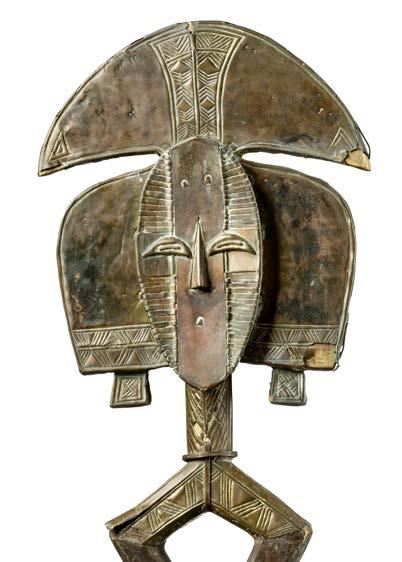Private Collections



(Auction 217)
Vol I Lots 1 – 155
From Private Collections
Vol II Lots 156 – 370 Africa, Oceania and Pre-Columbian Art
Würzburg, Auktionshaus
12 November 2022 – 14 Uhr

9 bis 11 November 2022 von 10 bis 17 Uhr und nach Vereinbarung
Wurzburg, Auction House
12 November 2022 – 2 pm
Preview
November 9 until 11, 2022 from 10 am to 5 pm and by appointment

Dr. David Zemanek Geschäftsführung Ethnologe / Auktionator Afrika / Ozeanien
Petra Felder M.A. Kunstgeschichte Redaktion / Marketing
Sabine Reis M.A.Kunstgeschichte Katalogbearbeitung
Kunstauktionshaus Zemanek-Münster 97070 Würzburg Hörleingasse 3 - 5 / Schildhof 2 Tel. +49 9 31 1 77 21 / Fax. +49 9 31 1 77 36 info@tribalart.de / www.tribalart.de
Dr. David Zemanek e.K. Öffentlich bestellter und vereidigter Kunstauktionator für außereuropäische Kunst

Redaktion / Editor: Petra Felder M.A.
Photos: Thomas Lother & Volker Thomas, Nürnberg
Layout: Beatrix Radke, design & art, Gerbrunn
Print: bonitasprint, Würzburg
Umschlag/cover: Lot 25 , Lot 34
Repräsentanten / Representatives Belgien & Niederlande Tel. 0032 (0)475 965 220 USA






Zemanek-Münster c/o Ancient Art – Art of Eternity 303 East 81st Street, New York City, NY 10028
Bankverbindung / Bank details IBAN DE06 7905 0000 0000 0366 99 SWIFT (BIC) BYLADEM1SWU
Hinweis: Objekte der Offerte stammen ausschließlich von ethnischen Volksgruppen und sind für die Verwendung inner halb der Ethnie gefertigt worden; Objekte der Colon sowie Auftragswerke sind in die frühe Zeit zu verorten.
Mit (*) gekennzeichnete Lose betreffen Objekte, die dem Kul turgüterschutzgesetz (KGS-Gesetz) unterliegen bzw. CITESpflichtig sind. Sie stehen im Einklang mit der CITES Resolution 10.10 (Rev.CoP18) und den Verordnungen (EU) Nr. 2021/2280 , 2021/C 528/03 sowie (EG) Nr. 865/2006 der Komission mit Durchführungsbestimmungen zur Verordnung (EG) Nr. 338/97 des Europäischen Rates vom 09.12.1996 über den Schutz von Exemplaren wildlebender Tier- und Pflanzenarten. Da diese hier gekennzeichneten Objekte unter die streng begrenzten Ausnahmen fallen, dürfen sie innerhalb der EU angeboten werden. Eine Ausfuhrgenehmigung in Drittländer kann für Objekte aus geschützten Materialien nur unter strengen Bedingungen erteilt werden.
Please note: All items have been made by the ethnic group and for use in the ethnic group. Figures of the Colon as well as commissened art works are classified as objects of the early period.
Some items of this offer can be marked with an asterisk (*). This objects are subject to the UNESCO Cultural Heritage Protection Act resp. to CITES. Objects liable to CITES fullfil the requirements of the CITES Resolution 10.10 (Rev.CoP18) and the european regulations (EC) No 2021/2280, 2021/C 528/03 as well as the Commission Regulation (EC) No 865/2006 of 4 May 2006 laying down detailed rules con cerning the implementation of Council Regulation (EC) No 338/97 of 9 December 1996 on the protection of species of wild fauna and flora by regulating trade therein. As the objects marked here fall under the strictly limited exceptions, they may be offered within the EU. Export licenses in third countries for objects containing or made of protected mate rials are only granted under stringent conditions.
 Lot 7, Photo: Andreas Achmann, Munich
Lot 7, Photo: Andreas Achmann, Munich
Knapp 40 Werke umfasst die vorliegende Sammlungsofferte außereuropäischer Kunst. Sie stammt aus dem Nachlass eines deutschen Kunsthändlers und wurde in den vergangenen fünfzig / sechzig Jahren mit viel Geschmack und Kunstverstand aufgebaut.
Es erfüllt uns mit Stolz, diese Werke hier nun in ihrer Gesamtheit präsentieren zu dürfen – Werke, die „unberührt“ als eine geschlossene Sammlung erhalten blieben, deren Charakter, Intention und Kunstge schmack ihres Sammlers so auf wunderbare Weise sichtbar wird.
Geschmackvoll, stilvoll, und von der Kunstästhetik der 1920er Jahre geleitet, beschreibt wohl am nähesten, was ihren Kern ausmacht – jedes einzelne Stück für sich ästhetisch ansprechend und vollendet in der Beherrschung der Form.
Ein Spiegel klassischer Werke Westafri kas, harmonisch stimmig und – wann immer möglich – in einem „makellosen“ Erhaltungsstand.
Nur wenige Male „wagt“ er sich – aber auch hier von der Ästhetik und Provenienz ge leitet – in den Kongo, nach Angola und Äthiopien.
Alte, mitunter lückenlose Provenienzanga ben finden sich bei einem Großteil seiner Sammlung, darunter Weltklassestücke wie die seltene Schreinfigur der Yoruba, die über Reverend Valentine Faulkner von der Church Missionary Society und dessen Yoruba-Aufenthaltszeit (1866 – 1883) in die James T. Hooper Collection gelangte (Los 25).
The present collection of non-European art includes almost 40 works. It comes from the estate of a German art dealer and was built up with a lot of taste and artistic under standing over the past fifty to sixty years. It fills us with pride to be able to present these works here in their entirety - works that have been preserved „untouched“ as a closed collection, whose character, intention and artistic taste of their collector is won derfully made visible.
Tasteful, stylish, and guided by the ar tistic aesthetic of the 1920s, this proba bly best describes what constitutes its core – each individual piece aestheti cally pleasing in its own right and ac complished in its mastery of form.
A mirror of classical works from West Af rica, harmoniously coherent and – when ever possible – in an „immaculate“ state of preservation.
Only a few times does he “dare” to go to the Congo, Angola and Ethiopia, guided by aesthetics and provenance.
Old, sometimes complete provenance infor mation can be found in a large part of his collection, including world-class pieces such as the rare Yoruba shrine figure, which came to the James T. Hooper Collection through Reverend Valentine Faulkner of the Church Missionary Society and his Yoruba period of residence (1866 – 1883) (Lot 25).
1 Stehende weibliche Figur

„sika blawa“
Diese vollständig mit Blattgold über zogenen Holzskulpturen „sika blawa“ galten als Prestigeobjekte, die bei wichtigen öffentlichen Zeremonien gezeigt wurden.
Sie waren Teil des heiligen Familien erbes „aja“, das in Truhen versteckt aufbewahrt wurde. Dazu gehörten auch massiv gegossene Goldorna mente, unbearbeitete Goldnuggets und Goldstaub, wie auch Bargeld, wertvolle Tücher und Ahnenhocker.
Bei großen Beerdigungen wurde der Reichtum der Familie des Verstor benen und anderer Familien zur Schau gestellt. Um „die Familie zu ehren und ihr Beileid auszudrücken“, wurden goldene Ornamente und Tü cher aus dem Familienschatz „aja“ um den aufgebahrten Verstorbenen herum ausgelegt. Bei der Auslage wurde nicht zwischen den Besitz tümern der verschiedenen Familien unterschieden und nach der Beerdi gung wurde alles seinem jeweiligen Besitzer zurückgegeben.
These wooden sculptures „sika bla wa“, completely covered with gold leaf, were considered prestigious ob jects, displayed at important public ceremonies.
They were part of the sacred family inheritance „aja“, which was kept hidden in chests. Besides the figu rines, solid cast gold ornaments, unworked gold nuggets and gold dust were part of the „aja“. But cash, valuable cloths and ancestor stools were also part of it.
Big funerals call for a display of the wealth of the family of the deceased, as well as of other families. To „give honor to your family, and to express condolences“, gold ornaments and cloths from the „aja“ are laid out around the deceased as he or she lies in state before burial. Possessions of different families are not distingu ished in the display, and after burial everything is returned to its owner.
Expertise Certificate, Karl-Ferdinand Schädler, Munich, 21 January 1993
German Private Collection

Vgl. Lit.: Vogel, Susan Mullin, Baule, African Art - Western Eyes, New York 1997, p. 197
€ 2.000 - 5.000

2 Stehende weibliche Figur „blolo bla“
Holz, Sammlungsetikett, Sockel
Standing female figure „blolo bla“ wood, collection label, base
H: 44,5 cm
Provenance
German Private Collection
€ 2.000 - 4.000
3 Stehende weibliche Figur „blolo bla“
Holz, Glasperlen, handschriftl. auf gebrachte Inventarnr. „B6“ (Basis Unterseite), Sockel
Standing female figure „blolo bla“ wood, glass beads, handwritten inventory no. „B6“ (bottom of the base), pedestal

H: 42,5 cm
Provenance
Hans Himmelheber (1908-2003), Hei delberg, Germany (coll. in situ, 1932) Lore (1901-1980) & Georg Kegel (1898-1974), Hamburg, Germany (Inv. no. B6)
Ludwig Bretschneider (1909-1987), Munich, Germany
German Private Collection
€ 4.500 - 12.000
Die Baule glauben, dass jeder Mensch vor seiner Geburt in einer „anderen“ Welt einen Ehepartner des jeweils anderen Geschlechts besitzt.
Diese „jenseitigen Partner“ mussten gut behandelt werden, da sie leicht eifersüchtig wurden und dann ihren menschlichen Partnern schaden konnten (Unfruchtbarkeit, Impotenz, Geldsorgen). Wenn solche Probleme auftraten, musste eine Figur aus Holz geschnitzt werden, um dem geistigen Partner ein Zuhause zu geben. Diese Figuren „blolo bla“ (weiblich) und „blolo bian“ (männlich) wurden gewöhnlich auf einem kleinen Altar im Schlafzimmer aufbewahrt, und es wurden ihnen Opfer wie Münzen oder Eier dargebracht.
Um die Hilfe der „jenseitigen Partner“ zu gewinnen, mussten die Figuren möglichst ansprechend sein, nach den gängigen Schön heitsidealen der Baule gestaltet und reich mit Skarifikationen verziert.
The Baule believe that every human being has a spouse of the opposite sex before birth in an „other“ world. These „otherworldly partners“ had to be treated well, as they easily became jealous and could then harm their human partners (infertility, impotence, money worries). If such problems occurred, a figure had to be carved out of wood to give the spiritual partner a home.
These characters „blolo bla“ (female) and „blolo bian“ (male) were usually kept on a small altar in the bedroom, and sacrifices such as coins or eggs were offered to them.
In order to gain the help of the „other worldly partners“, the figures had to be as appealing as possible, designed in accordance with the Baule‘s common ideals of beauty and richly decorated with scarification marks.


4 Stehende weibliche Figur „blolo bla“ Holz, Pigmente
Standing female figure „blolo bla“ wood, pigments
H: 37,5 cm
Provenance German Private Collection € 800 - 1.600
6 Hörnermaske „kpan pre“ Holz, polychrom gefasst, Label mit Inventarnr. „821-1“, Sockel
Der „kpan pre“ Maskentypus aus dem „goli“- Maskenzyklus repräsentiert ein junges Mädchen und wird zu Ehren des Büffelgottes „goli“ zumeist mit zwei Hörnern dargestellt.
Horned mask „kpan pre“ wood, polychrome painted, label with inventory no. „821-1“, base
The „kpan pre“ mask type from the „goli“ mask cycle represents a young girl and is usually depicted with two horns in honour of the buffalo god „goli“.
5 Stehende weibliche Figur „asie usu“ oder „blolo bla“ Holz, Pigmentreste, krustierte Patina, Sockel
Standing female figure „asie usu“ or „blolo bla“ wood, pigment residues, encrusted patina, base
H: 34 cm
Provenance German Private Collection
€ 800 - 1.500
H: 33 cm
Provenance
Henk (1920-2001) and Greet Kouw, Amsterdam, The Netherlands
Boris Kegel-Konietzko (1925-2020), Hamburg, Germany (1976) Ludwig Bretschneider (1909-1987), Munich, Germany
German Private Collection
Vgl. Lit.: Vogel, Susan Mullin, Baule, African Art - Western Eyes, New York 1997, p. 169 ff.
€ 2.000 - 4.000

In der ganzen Lagunenregion wird die figurale Skulptur mit einem Terminus bezeichnet, der mit „Menschen aus Holz“ übersetzt werden kann. Die südlichen Attie und Kyaman dagegen nennen ihre Figuren „nkpasopi“ - „Sopi aus Holz“, wobei „Sopi“ ein Frauennamen ist.
Blackmun Visonà vermutet, dass diese Figuren von traditionellen Heilern verwendet wurden, um Botschaften an die Geisterwelt zu übermitteln und den Geistern eine physische Form geben zu können. Möglich sei aber auch, dass sie bei Tanzaufführunen getragen oder ausgestellt wurden.
Whereas statues are known by terms translatable as „people of wood“ throughout the lagoons region, the southern Attie and Kyaman call them „nkpasopi“, „wooden sopi“ , the latter a woman‘s name.
Blackmun Visonà assumes, that although these examples were most likely used by traditional healers to convey messages to the spirit world and to provide spirits with physical forms, they could also have been used as prizes or portraits for dancers.

 Photo:s Andreas Achmann, Munich
Photo:s Andreas Achmann, Munich
 Photo:s Andreas Achmann, Munich
Photo:s Andreas Achmann, Munich
7 Stehende weibliche Figur Holz, Pigmentreste, Minia turglasperlen, Sockel Sehr schöne Figur mit markanter zweischöpfiger Frisur und fein gearbeiteten Details. Hals und Frisur sind mit feinen Rillen be schnitzt. Ein interessantes Detail sind die kleinen noppenförmigen Skarifikationen, die separat ge arbeitet, und in eigens dafür ge bohrte Löcher eingesteckt sind.
Standing female figure wood, pigment residues, minia ture glass beads, base

Strikingly beautiful figure with prominent two-lobed coiffure and finely worked details. Neck and coiffure are carved with fine grooves. An interesting detail are the small nubby scarifications, which are worked separately, and inserted into specially drilled holes.


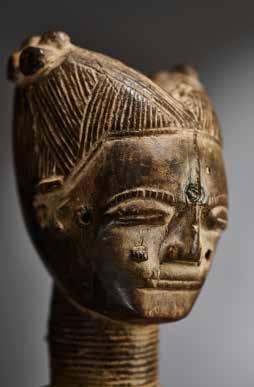
Ralf Lüders, Stuttgart, Germany
Alex Vömel (1897-1985), Düssel dorf, Germany
German Private Collection
Düsseldorf, Germany: „Afrika nische Kunst. Eine süddeutsche Sammlung“, Galerie Alex Vömel, 25 November 1983 - 25 January 1984
Publ. in Expo cat.: „Afrikanische Kunst. Eine süddeutsche Sammlung“, Galerie Alex Vömel, Düsseldorf, 1984
AHDRC: 0070995
Vgl. Lit.: Monica Blackmun Visonà in: Art of Côte d‘ Ivoire, Vol II, Genève 1993, p. 170 € 4.500 - 10.000
8 Anthropomorphe Gesichtsmaske „zakpai“ Holz, Pigmentreste, Sockel
Anthropomorphic face mask „zakpai“ wood, pigment residues, base

H: 22,5 cm
Provenance Ketterer, Munich, 5 November 1977, Lot 39 German Private Collection
AHDRC: 0178561
Vgl. Lit.: Fischer, Eberhard & Hans Himmelheber, Die Kunst der Dan, Zürich 1976, p. 74, ill. 108
€ 2.000 - 4.000

9 Anthropomorphe Gesichtsmaske „zakpai“ Holz, handschriftl. aufgebrachte In ventarnr. „H.1737“
Anthropomorphic face mask „zakpai“ wood, handwritten inventory no. „H.1737“

H: 23,5 cm
James T. Hooper (1897-1971), Arundel, Great Britain
Sold by the family in 1976 Christie‘s, London, 14 July 1976, Lot 6 German Private Collection
„Zakpai“ trat hauptsächlich im trockenen Sa vannengebiet der nördlichen Dan in Erschei nung. Die Maskengestalt hatte die Aufgabe die Kochfeuer im Dorf zu kontrollieren. Sie wurde vom schnellsten Läufer des Dorfes getragen, um zur Vorsicht zu mahnen und bei Feuerausbruch möglichst rasch Hilfe holen zu können. „Zakpai“ appeared mainly in the dry savannah region of the northern Dan. The masks function was to ensure that women extinguish cooking fires after use to prevent afternoon winds spreading fire through the village and bushes. It is worn by the fastest runner in the village sup posed to warn the inhabitants and to call for help in case of fire.
Publ. in Phelps, Steven, „Art and Artefacts of the Pacific, Africa and the Americas. The James Hooper Collection“, London 1976, p. 379, plate 222, no.1737
AHDRC: 0065714
€ 2.000 - 5.000
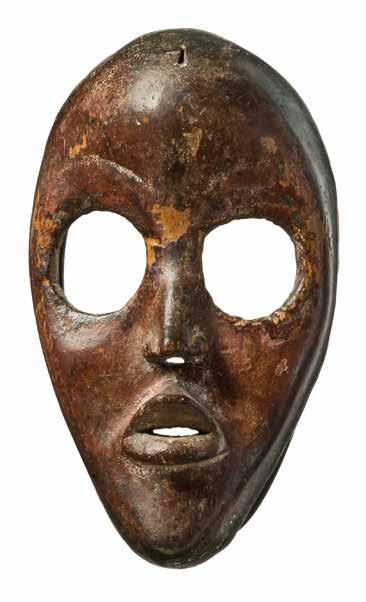

10 Webrollenhalter „kono“ mit anthropomorphem Kopf Holz, Nuß, komplett mit Querholz und Spule
Heddle pulley „kono“ with anthro pomorphic head wood, nut, complete with crossbar and bobbin
H: 19 cm
presumably Hans Himmelheber (1908-2003), Heidelberg, Germany, or Roger Bédiat (1897-1958), Abidjan, Ivory Coast Charles Ratton (1895-1986), Paris, France

Christie‘s, New York, 22 November 1996, Lot 128 German Private Collection
AHDRC: 0124555
€ 2.000 - 4.000

11 Maternité „katyéléô“ („Mutter des Dorfes / der Kinder des poro“) Holz, satte Patina, bewachst / beölt, rest., Sockel
Diese generalisierten Figuren sind Verkörperungen der Urmutter, die die Summe aller Kinder der Gemeinschaft leitet und beschützt.
„Katyéléô“ gilt insbesondere als Be schützerin der Initianten. Die Darstel lung der säugenden Mutter-mit-Kind bedeutet im übertragenen Sinne eine Speisung der Novizen mit dem Wissen des „poro“.
Maternité „katyéléô“ („mother of the village / the children of the poro“)
wood, rich patina, waxed / oiled, rest., base
These generalized figures are embodi ments of the primordial mother who guides and protects the sum of all the children of the community.

„Katyéléô“ was particularly regarded as the protector of the initiates. The representations of mother-and-child figuratively signify a feeding of the novices with the knowledge of the „poro“. H: 38 cm
Lean-Louis Picard, Paris, 8 October 1991, Lot 183 German Private Collection
AHDRC: 0071481
Vgl. Lit.: Burkhard, Gottschalk, Senufo - Unbekannte Schätze aus privaten Sammlungen, Düsseldorf 2009, p. 80 ff.
1.500 - 2.000

phuwe“ wood
Masken der Yaure gelten als Embleme der „yu“- Geister. Als solche sind sie sehr gefähr lich und müssen mit größter Vorsicht be handelt werden. Ihr Anblick ist Frauen strengstens untersagt.
Insbesondere ein Todesfall, der die gesell schaftliche Ordnung aufbricht, erfordert ihr Erscheinen. Dabei treten zwei Gruppen von Masken „je“ und „lo“ auf. Der Tanz der einen Gruppe reinigt das Dorf und hilft der Seele des Verstorbenen auf ihrem Weg zur letzten Ruhestätte. Die andere Gruppe tritt bei den eigentlichen Begräbniszeremonien „lo“auf.
Die Funktion der einzelnen Maskenarten ist jedoch nicht starr festgelegt, sie können bei beiden Zeremonien auftreten.
Yaure masks are considered emblems of the „yu“ spirits. As such, they are very danger ous and must be handled with extreme care. The sight of them is strictly forbidden to women.
In particular, a death that jeopardizes the social order requires their appearance. Two groups of masks „je“ and „lo“ appear. The dance of one group purifies the village and helps the soul of the deceased on its way into the ancestral realm. The other group appears during the actual funeral ceremo nies „lo“. However, the function of each type of mask is not rigidly fixed, which leads to their appearance during either ceremony.
12 Anthropomorphe Gesichtsmaske Holz, rotbraune Patina, Pigmente Maske mit äußerst fein modelliertem Gesicht, bekrönt von einem kleinen Aufsatz mit Janusköpfen, die ebenso feine Physiognomien zeigen. Typisch Yaure sind die in Mustern angelegten Augenbrauen. Der die Masken üblicherweise einrahmende gezackte Rand ist durch eine glatte Einfassung ersetzt. Die in drei Halb kreisen angelegte kunstvolle Frisur ist bei den Baule gleichermaßen zu finden.
Anthropomorphic face mask wood, dull reddish brown patina, pigments, Mask with extremely finely modeled face, crowned by a small attachment with Janus heads, which show equally fine physiognomies.
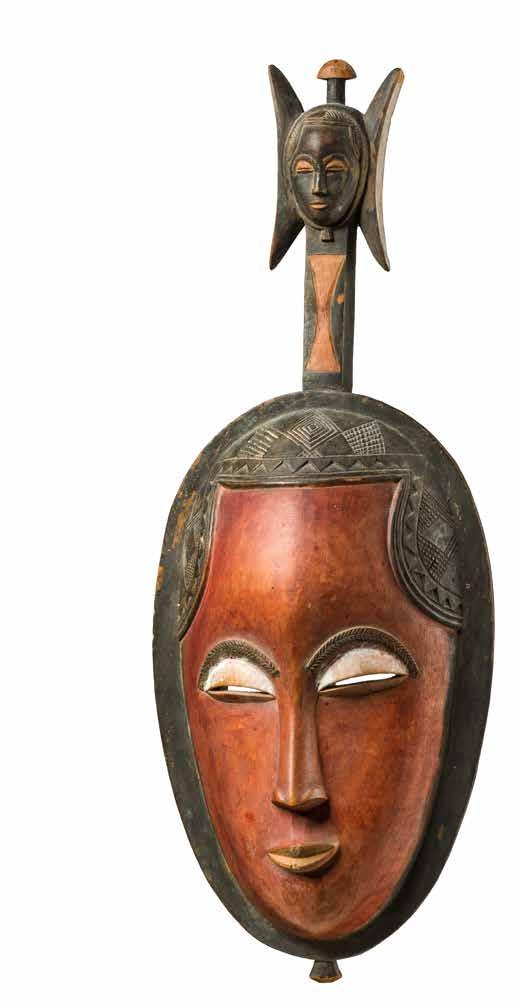
Typical Yaure are the patterned eyeb rows. The jagged border that usually frames the masks has been replaced by a smooth rim. The elaborate hair style, arranged in three semicircles, is equally found on the Baule.
H: 41 cm
Provenance German Private Collection
2.000 - 4.000
15 Stehende weibliche Schreinfigur / Puppe Holz, Kaolin, Miniaturglasperlen, mit Wachs behandelte Oberfläche, Beop ferungsspuren, Sockel
Standing female shrine figure / doll wood, kaolin, miniature glass beads, surface treated with wax, sacrificial traces, base
H: 25 cm Provenance German Private Collection
€ 250 - 500
16 Fruchtbarkeitspuppe „akua ‚ba“ Holz, Pigmente, Glasperlen, rest., Sockel
Fertility doll „akua ‚ba“ wood, pigments, glass beads, rest., base
H: 34,5 cm
Provenance German Private Collection
€ 500 - 1.000
14 Brustschmuck „akrafokonmu“ („Seelen-Wäscher-Scheibe“) Holz mit Blattgoldauflage, Sockel
Chest ornament „akrafokonmu“ („soul washer‘s disk“) gold leaf over wood, base
D: ca. 13 cm
Provenance German Private Collection
Vgl. Lit.: Ross, Doran H., Gold of the Akan from the Glassell Collection, Houston 2002, p. 114
€ 400 - 800
17 Fruchtbarkeitspuppe „akua ‚ba“ Holz, Sockel
Fertility doll „akua ‚ba“ wood, base
H: 24 cm
Provenance German Private Collection
€ 200 - 500
In der Vorstellung der Akan gilt Gold als irdisches Gegenstück zur Sonne und als physische Manifestation der Lebenskraft „kra“.
„Akrafokonmu“ werden von wichtigen Mitgliedern des Hofes, wie auch den königlichen Dienern, die als „akrafo“ oder „Seelenwäscher“ bekannt sind, als schützende Embleme getragen.
Als „akrafo“ werden besonders schöne junge Männer und Frauen ausge wählt, die am selben Wochentag wie der König geboren sind. Aufgrund ihrer Jugend und Vitalität sind sie würdig, dem König zu dienen. Sie rei nigen und erneuern rituell die Lebens kräfte des Königs und tragen so zur Stabilisierung und zum Schutz der Ge meinschaft bei.
In Akan thought, gold is considered an earthly counterpart to the sun and the physical manifestation of life‘s vital force, or „kra“.

„Akrafokonmu“ are worn as protec tive emblems by important members of the court, including royal attend ants known as „akrafo“, or „soul washers.“
Individuals selected for this title are beautiful young men and women born on the same day of the week as the king. Worthy of serving the king in light of their youth and vigor, they ritually purify and replenish the king‘s vital powers and, in doing so, help to stabilize and protect the community.

18 Fruchtbarkeitspuppe „akua ‚ba“ Holz, Miniaturglasperlen, Sockel
Fertility doll „akua ‚ba“ wood, miniature glass beads, base H: 28 cm
Provenance German Private Collection € 500 - 1.000
19 Fruchtbarkeitspuppe „akua ‚ba“ Holz, Kaolin, Miniaturglasperlen, Sockel
Fertility doll „akua ‚ba“ wood, kaolin, miniature glass beads, base
H: 26,5 cm
Provenance German Private Collection € 450 - 900
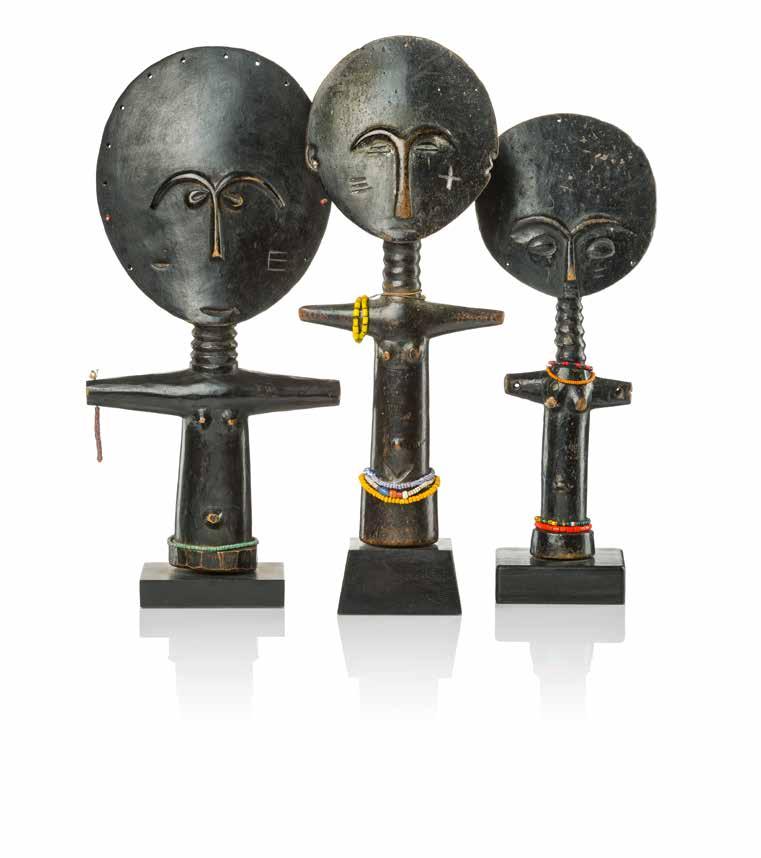
20 Fruchtbarkeitspuppe „akua ‚ba“ Holz, Miniaturglasperlen, Sockel
Fertility doll „akua ‚ba“ wood, miniature glass beads, base H: 24 cm
Provenance German Private Collection € 350 - 500

22
NIGERIA, YORUBA, IGBOMINA, ILA ORANGUN
22 Weibliches Zwillingsfigurenpaar „ere ibeji“ Holz, Verkrustungen mit Rotholzmehl „osun“, alte Reparaturstelle Zierliche Figuren mit schönen Ge sichtszügen und fein ausgeführten Details. Man betrachte das im Nacken verschlungene Band zur Befestigung der „tirah“ oder den feinen, um die Hüften gelegten Gürtel. Schöne alte Gebrauchspatina.
Sotheby‘s London, 26 March 1990, Lot 109 German Private Collection
Female pair of twin figures „ere ibeji“ wood, encrustations with camwood powder „osun“, old place of repair Dainty figurines with beautiful facial features and finely carved details. Con sider the ribbon entwined at the nape of the neck to fasten the „tirah“ or the fine strand around the waist. Fine old used patina.
H: 25,5 cm & 26 cm
AHDRC: 0107773
Vgl. Lit.: Polo, Fausto, Enzyklopädie der Ibeji, 2008, cat. 551
€ 1.500 - 2.500
23 Zwillingsfigurenpaar „ere ibeji“ Holz, Pigmentreste, Verkrustungen mit Rotholzmehl, Glasperlen, Kokos scheibchen, Gelbguss
Pair of twin figures „ere ibeji“ wood, pigment residues, encrusta tions with camwood powder, glass beads, coconut discs, brass

H: 28,5 cm & 29 cm
Ketterer, Munich, 30 April 1988, Lot 434
German Private Collection
Vgl. Lit.: Polo, Fausto, Enzyklopädie der Ibeji, 2008, cat. 377
€ 1.200 - 2.500
Lot 23
NIGERIA, YORUBA, KWARA STATE, ILORIN / SHAKI
24 Weibliche Zwillingsfigur „ere ibeji“ Holz, Farbe, Pigmentreste, Glasper len, Metall, Leder Eine ausnehmend schöne „ibeji“- Fi gur mit feiner, matt glänzender Pa tina, als Zeichen der Wertschätzung reich mit Schmuck behängt. Die Ge sichtszüge sind durch wiederholte Fütterungs- und Waschprozeduren stark berieben, die Nagelköpfe in den Augen noch vorhanden.
German Private Collection
Female twin figure „ere ibeji“ wood, paint, pigment residues, glass beads, metal, leather An exceptionally beautiful „ibeji“ fi gure with a fine, matt patina, richly hung with jewelry as a sign of ap preciation. The facial features are heavily rubbed by repeated feeding and washing procedures, the nail heads in the eyes are still present.

H: 29,5 cm
Vgl. Lit.: Stoll, Gert & Mareidi, Ibeji, Zwillingsfiguren der Yoruba, Mün chen 1980, p. 264, ill 150
€ 1.000 - 2.000

25 Seltene Schreinfigur „ogun“ Holz, stellenweise stark schwitzende Opferpatina, handschriftl. aufgebrach te Inventarnr. „H.1797“, altes Label mit stark verblasster Schrift: „This idol represents „Shango“, God of Thun der. Ogun, God of War. Lent by Rev. V. Faulkner“
„Ogun“ gilt als Gott des Eisens und als Schutzpatron der Krieger und Schmie de. Er ist verantwortlich für alle aus Ei sen hergestellten Objekte, für Gegen stände des alltäglichen Gebrauchs, für Waffen, ebenso wie für Würdestäbe „iwana ogun“, die für die Obersten der Schmiede, als Zeichen ihres Amtes, an gefertigt wurden.
Pemberton berichtet, dass an „ogun“Schreinen nur selten figurale Skulp turen Aufstellung fanden. Vielmehr würden mit Palmwedeln gebundene Metallinstrumente, die auf „okuru“Steinen ruhen, die Präsenz „oguns“ anzeigen. Nur bei den südwestli chen Yoruba fände man gelegentlich Schreinfiguren, die mit der Verehrung „oguns“ in Verbindung gebracht wer den und zwar an Schreinen der „orisha funfun“ - Gottheiten, die mit Leben und Gesundheit in Verbindung stehen.
Rare shrine sculpture „ogun“ wood, heavily sweating sacrificial pati na in places, handwritten inventory no. „H.1797“, old label with heavily faded writing: „This idol represents „Shango“, God of Thunder. Ogun, God of War. Lent by Rev. V. Faulkner“
„Ogun“ is considered the Yoruba god of iron and patron of warriors and blacks miths. He is in charge of all products made by them - all instruments of crea tivity and battle. Iron title staffs („iwana ogun“) for the chief of the blacksmiths are made in the name of „ogun“.

Pemberton reports that figural sculp tures were rarely placed at „ogun“ shrines. Rather, metal instruments tied with palm fronds, resting upon pieces of „okuru“ stone, mark „oguns“ presence. However, among the southwestern Yoruba, one will occasionally find sculp tured figures associated with „ogun“ worship on shrines for deities of white ness, „orisha funfun“ - deities associated with life and health.


H: 70 cm
Valentine Faulkner, Reverend of the Church Missionary Society (collected in situ, 1866-1883, when he worked among the Yoruba)
James T. Hooper (1897-1971), Arundel, Great Britain
Sold by the family in 1976
Christie‘s, London, 14 July 1976, Lot 27 German Private Collection
Publ. in Phelps, Steven, „Art and Artifacts of the Pacific, Africa and the Americas. The James Hooper Collection“, London 1976, p. 387, plate 230, no.1797
0108997

Ein nahezu identisches Werk, wohl desselben Meisters, wurde am 21. Mai 1980, als Lot 178 bei Ketterer, München verauktioniert (AHDRC 0104756).
An almost identical work, probably by the same master, was auctioned on May 21, 1980, as lot 178 at Ketterer, Munich (AHDRC 0104756).
26 Tanzstab „oshe shango“ Holz, matte rotbraune (Wasch-) Patina mit Pigmentresten, Sockel „Oshe shango“ in Gestalt einer knienden weiblichen Figur, eine Rassel „shere“ in der rechten und einen „oshe shango“Stab in der linken Hand haltend.
Dance wand „oshe shango“ wood, dull reddish-brown (washing) patina with pigment residues, base „Oshe shango“ in the form of a kneeling female figure, holding a rattle „shere“ in the right hand and an „oshe shango“ staff in the left.


H: 37 cm
Provenance
Ketterer, Munich, 20 April 1991, Lot 295 German Private Collection
Expertise Certificate of Authenticity, Karl-Ferdi nand Schädler, Munich, 5 July 1991 € 1.500 - 3.500
Gesichts maske Holz,
Anthropomorphic face mask wood,

Provenance
French Private Collection
New York, 20 November 1997, Lot 315 German Private Collection
AHDRC:

28 Weibliche Gesichtsmaske
„okuyi“ oder „mukudji“ Holz, Kaolin, Sockel
Diese schöne alte Maske mit dem ty pisch geweißten Gesichtsfeld, gehört zu den sogenannten „Weißen Masken vom Ogooué“.
Diese Masken stellen weibliche Ah nen aus dem Jenseits dar und traten in erster Linie bei Trauerfeierlich keiten auf. Sie waren Eigentum der „mwiri“- Männergesellschaft.
Female face mask „okuyi“ or „mukudji“ wood, kaolin, base
This beautiful old mask with the ty pical whitened face is one of the socalled „white-faced masks from the Ogooué“.
These masks represent female enti ties from the spirit world and espe cially performed during mourning rites. They belonged to the male „mwiri“ secret society.
Alfred L. Scheinberg, New York, USA
Maurice W. Shapiro (1928-1993), New York, USA
Christie‘s, New York, 11 November 1993, Lot 107
Christie‘s, New York, 20 November 1997, Lot 60
German Private Collection
Publ. in African Arts, 1985, vol. XVIII, no.3, p.12, Alfred Scheinberg H: 30 cm AHDRC: 0049249
€ 2.500 - 5.000
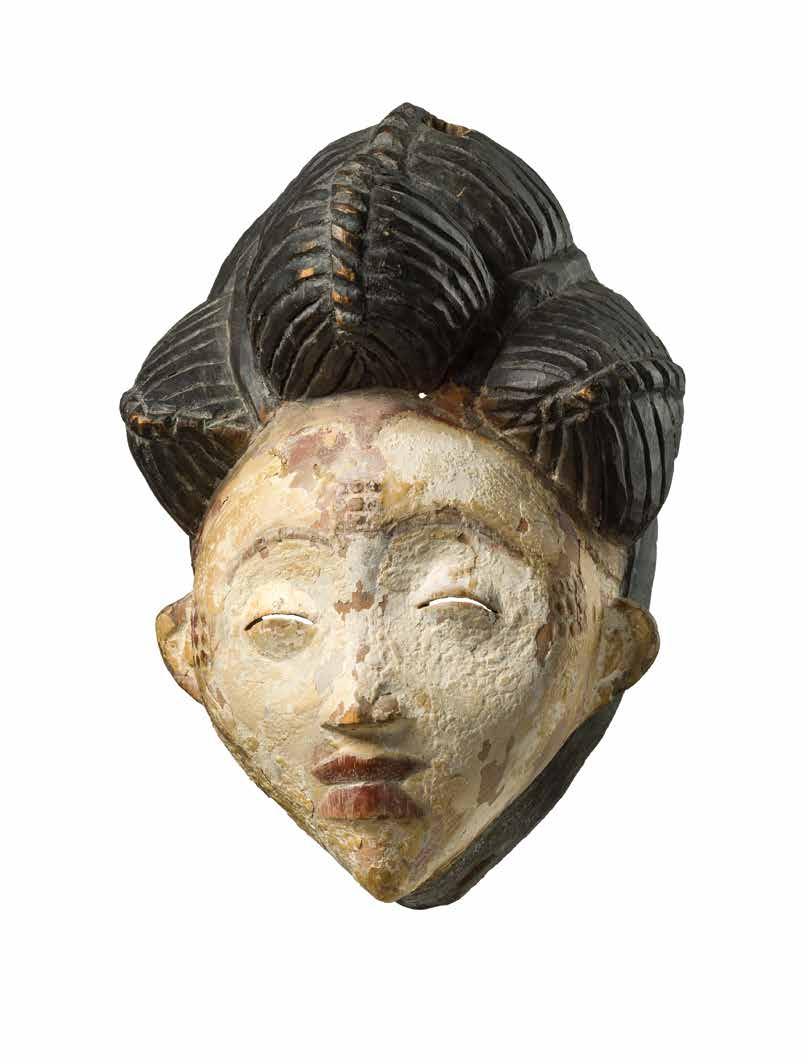 GABON, PUNU
GABON, PUNU
Vermutlich handelt es sich bei vor liegendem Exemplar um eine klas sische weiße Maske „okuyi“, bei der die typische Kaolinschicht verloren gegangen ist.
Es gibt jedoch auch von der Morpho logie her verwandte Masken bei den Punu, die schwarz bemalt sind und „ikwara“ genannt werden. Während die „okuyi“- Masken tagsüber auftre ten und positiv belegt sind, erschei nen die schwarzen Masken bei Nacht und stehen für einen negativen und gefährlichen spirituellen Hintergrund. Sie erscheinen nur bei besonderen nächtlichen Versammlungen, bei Ri tualen zur Rechtsprechung oder wenn die Punu-Gesellschaft von Unglück, Krankheit, Epidemien, Hexerei oder Kriminalität bedroht ist. Ikwara-Mas ken“ sollen das Böse ablenken.
H: 25,5 cm
Female face mask „okuyi“ or „mukudji“ wood, base
Presumably, the present specimen is a classic white mask „okuyi“ in which the typical kaolin layer has been lost. However, there are also morphologi cally related masks among the Punu, which are painted black and called „ikwara“. While the „okuyi“ masks appear during the day and represent a positive aspect, the black masks ap pear at night and represent a negative and dangerous spiritual background. They only appear at special night-time gatherings, at rituals for the administ ration of justice or if the Punu society is threatened by ill-fortune, illness, epidemics, witchcraft or criminality. „Ikwara“ masks should divert the evil.
Christie‘s, New York, 22 November 1996, Lot 158 German Private Collection
AHDRC: 0124572
€ 2.000 - 3.500

„mwana pwo“
Holz, rotbraune Farbe, Raffiabast
Die „mwana pwo“ - Maske stellt eine weibliche Urahne dar.
Young maiden mask „mwana pwo“ wood, reddish brown paint, raffia The „mwana pwo“ mask represents a primordial female ancerstor.
H: 23 cm
Ralf Lüders, Stuttgart, Germany Alex Vömel (1897-1985), Düsseldorf, Germany German Private Collection
Exhibited Düsseldorf, Germany: „Afrikanische Kunst. Eine süddeutsche Sammlung“, Galerie Alex Vömel, 25 November 1983 - 25 January 1984
Publ. in Expo cat.: „Afrikanische Kunst. Eine süddeutsche Sammlung“, Galerie Alex Vömel, Düsseldorf, 1984
AHDRC: 0001033
€ 400 - 800
D. R. CONGO, BEMBE (EASTERN) - GOMA
Holz, Kaolin, Rotholzmehl
Diese Masken sollen bei „eluba ya butende“ Beschneidungsriten oder den anschließenden Initiationsriten verwendet worden sein. Die Mas ke vereint Züge der Eule („cwec we“) mit menschlichen Zügen und Antilopenhörnern.
Anthropo-zoomorphic face mask wood, kaolin, camwood powder
These masks are said to have been used during „eluba ya butende“ cir cumcision rites or the subsequent initiation rites. The mask combines features of the owl („cwecwe“) with human features and antelope horns. H: 32 cm
Provenance Lempertz, Brussels, 25 March 1992, Lot 210
German Private Collection
AHDRC: 0014941
Vgl. Lit.: Marc Leo Felix (ed.), „Congo Masks“, New Haven, London, Hong Kong, 2018, p. 276 ff.
€ 2.500 - 5.000

Squatting figure wood H: 24 cm

Renée Marteaux (deceased 1988), Brussels, Belgium
Family by inheritance
Sotheby‘s, London, 26 March 1990, Lot 151 (attributed to the D. R. Congo, Holo)
German Private Collection
AHDRC: 0015399 (attributed to the D. R. Congo, Holo)
800 -
Holz, Pigmente, Insektenfrass, Sockel Janusfiguren „kabeja“ stellen stets eine männliche und eine weibliche Figur dar, die Rücken an Rücken ste hend, eine Eintiefung oder ein Gefäß zum Einfügen von magischer Masse auf dem Kopf tragen. Sie gelten als
bildliche Darstellung des Urpaares und somit als Gründer der Gemeinschaft („abeja“ = Frau, „makua“ = Mann).
Die „kabeja“ sind wichtiges Requisit bei allen Kulthandlungen der Hemba, als auch bei der Ahnenverehrung. Ob bei der Rechtsprechung oder bei der Darbringung von Opfergaben, „kabe ja“ waren stets präsent.
Sie waren persönlicher Besitz des Clanoberhaupts „fumu mwela“.
Janiform magical figure „kabeja“ wood, pigments, insect caused da mage, base
Janus figures „kabeja“ always repre sent a male and a female figure, joi ned back-to-back, and sharing a single cavity on top of their heads for inser tion of magical mass.
They are seen as visual icon of the pri mordial couple, the founders of the society („abeja“ = woman, „makua“ = man).
The „kabeja“ is the fundamental ob ject of the Hemba cult, including the cult of ancestors. Whether adminis tering justice or making an offering to the ancestors these Janus „kabeja“ were always present. They are owned by the clan head known as the „fumu mwela“.
H: 27 cm
Galerie Lemaire, Amsterdam, The Netherlands
Ludwig Bretschneider, Munich, Germany German Private Collection (1987)
AHDRC: 0029451
Vgl. Lit.: Neyt, Francois, La Grande Statuaire Hemba du Zaire, Louvainla-Neuve 1977, p. 486, ill. 82
€ 1.200 - 2.400


34 Kniende weibliche Figur Holz, satte Patina, mit Wachs oder Öl behandelte Oberfläche Meisterhafte Schnitzarbeit, Körper formen und Gesichtszüge sind wun derschön ausformuliert. Die Frisur zieren feine lineare Gravuren, Ohren und Augenbrauen sind ornamental angelegt.
Ihre linke Hand ist an die Brust gelegt, auf ihre Rolle als Frau hinweisend, die in der Lage ist, ein Kind zu näh ren. Durch einen rituellen Spezialis ten magisch aufgeladen, dürfte sie höchstwahrscheinlich in Zusammen hang mit Fruchtbarkeit verwendet worden sein.
H: 20 cm
AHDRC: 0017838
Kneeling female figure wood, rich patina, surface treated with wax or oil

Masterful carving, body forms and facial features are beautifully shaped. Her coiffure forms a point at the top and is decorated with incised geome tric motifs, ears and eyebrows are or namentally designed. Her left hand is holding her breast in a gesture demonstrating her nurturing faculties. After being magically acti vated by a ritual specialist, it would have been used by an individual to favorably manipulate forces and alter events, most probably relating to the enhancement of fertility.
Christie‘s, South Kensington, 22 No vember 1988, Lot 200 German Private Collection

 PAPUA NEW GUINEA - BISMARCK ARCHIPELAGO - NEW IRELAND
PAPUA NEW GUINEA - BISMARCK ARCHIPELAGO - NEW IRELAND
35 Fragment eines „malagan“Paneels Holz, Pigmente, Muscheleinlage, schwarze tonartige Masse, Sockel
Der Begriff „malagan“ bezeichnet ein komplexes System von Zeremonien als auch die visuellen Kunstformen, die damit in Verbindung stehen.
Die meisten dieser beeindrucken den Bildwerke werden für TotenGedenkfeiern in Auftrag gegeben. Diese beinhalten u. a. die Errichtung eines „malagan“- Hauses als Präsen tationsfläche für die hergestellten „malagan“- Objekte.
Vorliegende Skulptur zeigt eine Figur (Mann oder Frau), die von einem Fisch verschlungen wird. Ein Bild, das in vielen Regionen Neu Irlands den Tod symbolisiert und als Redewendung sogar Eingang in den Sprachgebrauch gefunden hat: „big-mouth got him“.
Ziel der „malagan“ Zeremonie ist es, „den Tod zu vollenden“. Dies ge schieht indem der Verstorbene und
seine zu Lebzeiten erworbenen Ver dienste noch einmal in Erinnerung ge rufen und gewürdigt werden - und er anschließend dem Vergessen anheim gegeben wird. „Malagan“ Schnitze reien wurden nach ihrem Gebrauch traditionell weggeworfen.
Fragment of a „malagan“ panel wood, pigments, shell inlay, black clay like mass, base
The term „malagan“ refers collectively to a complex series of ceremonies and the visual art forms associated with them.
Most of these impressive sculptures are commissioned for ceremonies commemorating the deceased. The celebrations include, among other things, the construction of a „ma lagan“ house for the presentation of the art objects.
This sculpture shows a figure (man or woman) being swallowed by a fish.
An image that symbolizes death in
many regions of New Ireland and has even found its way into everyday lan guage: „big-mouth got him“.
The aim of „malagan“ ceremonies is to „finish the dead“. This is done by remembering him with all his achie vements for one last time - and then forgetting him. „Malagan“ figures are traditionally discarded after use.
Johann F. Gustav Umlauff (1833-1889), Hamburg, Germany
Eduard von der Heydt (1882-1964), Ascona, Switzerland (1926)
Alfred Flechtheim (1887-1937), Berlin, Germany
Alex Vömel (1897-1985), Düsseldorf, Germany
German Private Collection
€ 2.500 - 5.000

Robert Lewitzki (73) ist Antiqui tätenhändler im besten klassi schen Sinn. Schon seit den 1970er Jahren führt er mit seiner Frau Ulrike den Kunsthandel in einem wunderschönen Historismus-Bau am Brandplatz inmitten der Celler Altstadt.
Zur traditionellen Kunst Afrikas gelangt er relativ spät. Erst 1995 beginnt er Werke Sub-Saharas zu sammeln – für sich, rein pri vat, „und ohne merkantiles Inte resse“, wie er es 2001 formulierte, als seine Privatsammlung im Al bert-König-Museum in Unterlüß erstmals öffentlich gezeigt wird:
Figuren und Masken aller „für ihn wichtigen Ethnien“ (Celler Zeitung, 30.06.2012), darunter die Antilopenmaske der Guru (Elfen beinküste) mit Provenienz Hans Himmelheber (Los 42).
Robert Lewitzki ist nicht fixiert auf bestimmte Gesellschaften und Kulturkreise. Zentrales Au genmerk sind für ihn Provenienz und ein im Laufe der Jahre und durch intensive Literaturstudien veränderter Blick hin zu einer – wie er es für sich bezeichnete – „an spruchsvolleren Formensprache“. Diese Werke findet er auf den grossen internationalen Messen

und Auktionen und in den Brüs seler und Pariser Galerien, wie die beeindruckende - Wächterfi gur: ikonographisch ein Klassiker der Fang-Kunst, zeichnet sie sich durch eine stilistisch kraftvolle Formensprache aus (Los 53).
Die Afrikasammlung Robert Le witzki zählt heute zu den künst lerisch erlesenen Sammlungen. Sie wurde – viele Jahre und Reisen zu den Kunstzentren später – 2012 im Museum Schloss Bomann in Celle noch einmal präsentiert. Ein Groß teil der Exponate von damals, sehr ausgewählte Stücke, gelangen nun in die Offerte.
Robert Lewitzki (73) is an antiques dealer in the best classic sense. Since the 1970s he and his wife Ulrike have been running the art trade in a beautiful historicism building on Brandplatz in the mid dle of Celle‘s old town. He came to traditional African art relatively late. It was not until 1995 that he began to collect sub-Saha ran works - for himself, purely pri vately, „and without commercial
interest“, as he put it in 2001 when his private collection was shown publicly for the first time in the Al bert König Museum in Unterlüß: figures and masks of all „the Eth nicities important to him“ (Celler Zeitung, 06/30/2012), including the antelope mask of the Guru (Ivory Coast) with provenance Hans Him melheber (Lot 42)
Robert Lewitzki is not fixated on specific societies and cultures.
For him, the central focus is on provenance and a view that has changed over the years and through intensive literature stud ies towards what he called a “more sophisticated formal language”. He finds these works at the major international fairs and auctions and in the Brussels and Paris galleries, such as the impressive guardian figure: iconographically a classic of Fang art, it is charac
terized by a stylistically powerful design language (Lot 53).
Today, the Robert Lewitzki Africa Collection is one of the most artis tically exquisite collections. Many years and trips to the art centres later, it was presented again in 2012 in the Museum Schloss Bomann in Celle. A large part of the exhibits from that time, very selected pieces, are now on offer.
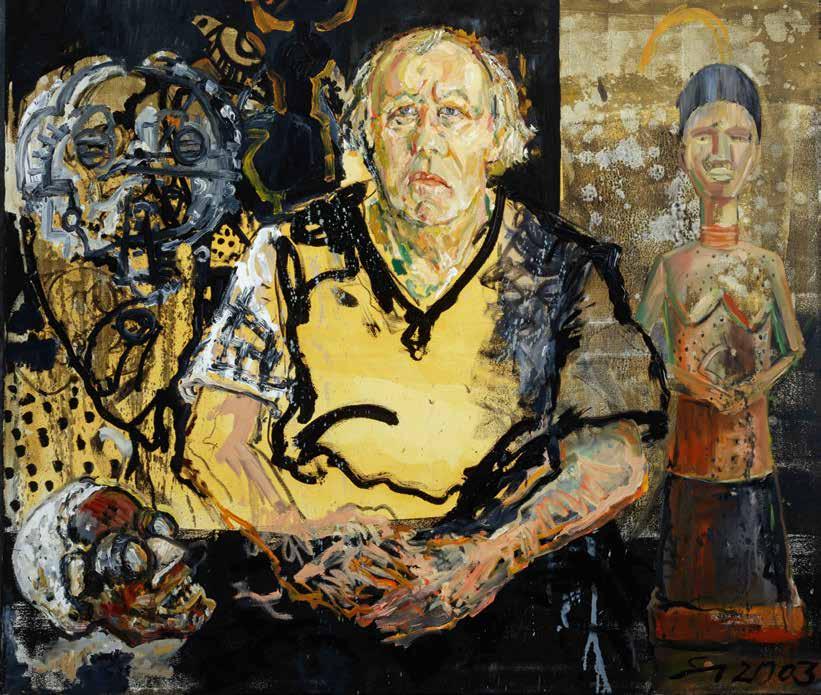
36 Große Affenskulptur,
1. Hälfte 19. Jahrhundert Holz, rest., Sockel
Beeindruckende Tierskulptur in ele gant geschwungenen reduzierten Formen, deren Expressivität durch die von Verwitterung und Windschliff ge zeichnete Oberflächenstruktur noch verstärkt wird.
Die Tierfigur zeigt anthropomorphe Gesichtszüge und war vermutlich auf einen Pfosten gearbeitet. Wohl ein Tiertotem, der an einem Ort po sitioniert wurde, wo er überwollende Geister abschrecken und damit den Menschen Schutz bieten sollte.
Francine Maurer (deceased 2006), Paris, France
Kim Redlich, Düsseldorf, Germany
Lempertz, Brussels, 30 March 2006, Lot 25
Robert Lewitzki, Celle, Germany
Large monkey sculpture, 1st half 19th century wood, rest., base
Impressive animal sculpture in ele gantly curved reduced forms, whose expressiveness is further enhanced by the surface structure marked by weathering and wind abrasion.
The animal figure shows anthropo morphic facial features and was pro bably worked on a post. Apparently an animal totem put in a place to frigh ten off rampant spirits and thus offer protection to humans.
H: 57 cm
C14 Certificate, ASA, Laboratoires d‘ Archéométrie, Paris, 26 November 2004
Vgl. Lit.: Murray, Thomas, C-14 Dating of Dayak Art, o.O. 2015, cat. 44
€ 4.000 - 8.000

38 Kleine weibliche Figur Holz
Die Figur zeigt eine stark klebrige, schwarz glänzende Opferpatina im Wechsel mit krustierten Partien. Sie wurde vermutlich als persönliche Schutzfigur verwendet.
The figure shows a strongly sticky, shiny black sacrificial patina alter nating with encrusted areas. It was probably used as a personal protec tive figure.

H: 19 cm
Robert Lewitzki, Celle, Germany
€ 400 - 800
37 Seltener anthropomorpher Kopfaufsatz „klé-dyiba“
Holz, Pigmente, menschliches Haar, Metall, Etikett: „H 53 / Liberia - Village: Kaweke Half-Grebo Bowo“, Sockel Sehr seltener Typus, dessen Verwen dung nicht dokumentiert ist.
Lot 38
Ein formal vergleichbares Exemplar (ex Bohumil Holas) befindet sich in den Sammlungen des Musée du quai Branly - Jacques Chirac, Paris (AHDRC 0183886). Laut Aufschrift auf der Rückseite stammt es von den GreboBôvo, aus dem Dorf Kaouyéké (Kawe
ke), wurde von einer Vereinigung der jungen Männer verwendet und „klédyiba“ genannt.
Rare anthropomorphic headdress „klé-dyiba“ wood, pigments, human hair, metal, label: „H 53 / Liberia - Village: Kaweke Half-Grebo Bowo“, base
Very rare type whose use is not documented.
A formally comparable specimen (ex Bohumil Holas) is in the collections of the Musée du quai Branly - Jacques Chirac, Paris (AHDRC 0183886). Accor ding to the inscription on the back, it comes from the Grebo-Bôvo, from the village of Kaouyéké (Kaweke), was used by an association of the young men and was called „klé-dyiba“.
H: 33 cm
Edith Hafter (1911-2001), Solothurn, Switzerland
Christie‘s, Paris, 12 June 2003, Lot 311
Cornette de Saint Cyr, Paris-Drouot, 10 April 2010, Lot 37
Bernard Dulon, Paris, France
Stella Loebarth, Paris, France (Bruneaf 2012)
Zemanek-Münster, 86th Tribal Art Auction, Vol. II, Würzburg, 27 May 2017, Lot 167
Robert Lewitzki, Celle, Germany

Photo: AHDRC 0005139, Christie‘s 1978
Für Figuren derselben Werkstatt siehe Katsouros, 2002, S. 38, ill. 54 b, c, d - sowie AHDRC 0005133 & 0005139.

Alle Figuren zeigen größte Überein stimmungen in der Physiognomie, vor allem bezüglich Form und auf fallend asymmetrischer Anord nung der Augen, als auch bezüglich der besonders markanten Nasen.
For figures of the same workshop see Katsouros, 2002, p. 38, ill. 54 b, c, d - as well as AHDRC 0005133 & 0005139.
All figures show great similarities in physiognomy, especially with re gard to the shape and strikingly asymmetrical arrangement of the eyes, as well as with regard to the particularly prominent noses.
39 Stehende männliche „bateba“Figur mit Pfeife Holz, Pigmente, Sockel
Standing male „bateba“ figure with pipe wood, pigments, base
H: 59 cm
Provenance
Petra und Stephan Herkenhoff, Osna brück, Germany
Floros Katsouros, Hannover, Germany
Olaf Pfennig, Hannover, Germany Zemanek-Münster, 86. Tribal Art Auc tion, Vol. II, Würzburg, 27 May 2017, Lot 214
Robert Lewitzki, Celle, Germany
AHDRC: 0142124
€ 1.500 - 3.000
Publ. in Katsouros, Floros, „Lobi Skulptu ren aus der Kollektion Katsouros“, Hannover 2002, p. 38, ill. 54 a


40 Helmmaske „ndoli jowei“
Holz, dreitlg., handschriftl. aufge brachte Inventarnr. „34/74/v. P.“
Das Leben der Mende wird durch eine Reihe von Initiationsgesellschaften geregelt. Die wichtigsten sind der „poro“- Bund der Männer und die „sande“- Gesellschaft der Frauen. Hauptziel von „sande“ ist es, die Mäd chen auf Heirat und Mutterschaft vorzubereiten.
Bei den abschließenden Initiations feiern werden die neu Initiierten von
einer Maskengestalt namens „ndoli jowei“ („die sowei, die tanzt“) durch das Dorf geführt. Von dieser Mas kengestalt glaubt man, dass sie den Schutzgeist des „sande“ - Bundes, „ngafa“, verkörpert.
Helmet mask „ndoli jowei“ wood, three-part, handwritten inven tory no. „34/74/v. P.“

The life of the Mende is regulated by a number of initiation societies. The most important are the „poro“ socie
ty of men and the „sande“ society of women. The main aim of the „sande“ is to prepare girls for marriage and motherhood.
At the final initiation ceremonies, the newly initiated are led through the vil lage by a masked figure called „ndoli jowei“ („the sowei who dances“). This masked figure is believed to embody the guardian spirit of the „sande“- so ciety, called „ngafa“. H: 38 cm
Provenance Robert Lewitzki, Celle, Germany
Celler Schloß, Gotische Halle: „Afri kanische Kunst, Sammlung Robert Lewitzki“, 10. Juli - 31 August 2012
Publ. in Expo cat.: „Afrikanische Kunst, Samm lung Robert Lewitzki“, Bomann-Muse um (Hg.), Celle 2012, p. 28
AHDRC: 0150705
€ 1.000 - 2.000

„Dye“ ist ein Ensemble von men schen- und tiergesichtigen Masken mit mächtigen Raffiakostümen, das bei den südlichen und westli chen (zentralen) Guro zu finden ist.
Die Tiermasken erscheinen bei den „dye“- Maskenauftritten als eine Art Vorhut der „höheren“ anthropo morphen Masken. Man sagt „sie bereiten den Tanzplatz vor“. Sie stellen neben Hund, Elephant, Flußpferd, Ziege und Büffel eine er staunliche Vielfalt an unterschiedli chen Antilopenarten dar, die nach Länge und Form der Hörner unter schieden werden können.
Die Tiermasken im Allgemeinen
und die Antilopen im Besonderen wurden mit Spannung erwartet, vor allem, wenn der Träger als geschick ter Tänzer bekannt war; ihre Kostü me aus wirbelnden Fasern machten ihren Tanz noch spektakulärer.
„Dye“ is an ensemble of animal- and human-faced masks with impres sive raffia costumes found among the southern and western (central) Guro.
In a „dye“ mask performance ani mal masks appear first. Acting as a kind of vanguard for the anthropo morphic masks, they are said to „prepare the dancing area“. In addition to the dog, hippopota mus, goat and buffalo the animal masks represent an astonishing va riety of different types of antelopes, which can be distinguished accord ing to the length and shape of their horns.
The animal masks, in general, and the antelopes, in particular, were keenly awaited, especially when the wearer was known to be a skilled dancer; their costumes of swirling fibres made their dance even more spectacular.
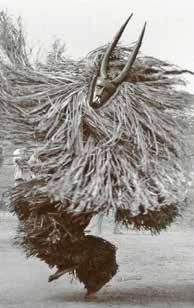
42 Antilopenmaske „glo“ (Bongo Antilope) des „dye“- Maskenensembles
Holz, Pigmentreste, altes Etikett: „Maske der Guro - von Jugendlichen bei Feldbestellungszerem. getragenpubliz. Himmelheber Negerkunst und Negerkünstler“; von Hand beschriftet: „Geschenk von Dr. Dr. H. Himmelhe ber Heidelberg 19.6.50“; Inv.nr. „45“ in Graphit
Himmelheber berichtet in Zusam menhang mit dieser Maske, dass die Guro-Burschen in der Umgebung von Vavoua über ganze Sätze von Tiermasken, „meist mit meterlangen Antilopenhörnern“ verfügt hätten, mit denen sie bei der Feldbestellung auftraten (Himmelheber, 1960, S. 207 f.).
Antelope mask „glo“ (Bongo ante lope) of the „dye“ mask ensemble wood, pigment residues, old label: „Mask of the Guro - worn by youths at field ceremonies“ - publ. Himmelhe ber Negerkunst und Negerkünstler“; inscribed by hand: „Gift from Dr. Dr. H. Himmelheber Heidelberg 19.6.50“ ; inv.no.“45“ in graphite
In connection with this mask, Him melheber reports that the Guro boys in the vicinity of Vavoua had whole sets of animal masks, „mostly with meter-long antelope horns“ at their disposal, with which they appeared when tilling the fields (Himmelheber, 1960, p. 207 f. ). H: 75 cm
Hans Himmelheber, Heidelberg, Germany
Ernst Heinrich, Stuttgart, Germany (1950)
Robert Lewitzki, Celle, Germany
Unterlüß, Albert-König-Museum: „Afrikanische Kunst, Sammlung Ro bert Lewitzki“, 11. März - 16. April 2001; Celler Schloß, Gotische Halle: „Afri kanische Kunst, Sammlung Robert Lewitzki“, 10. Juli - 31 August 2012


Himmelheber, Hans, Negerkunst und Ne gerkünstler, Würzburg 1960, p. 207, ill. 155; Expo cat.: „Afrikanische Kunst, Sammlung Robert Lewitzki“, AlbertKönig-Museum (Hg.), Unterlüß, 2001, p. 30, cat. 43; Expo cat.: „Afrikanische Kunst, Sammlung Robert Lewitzki“, Bo mann-Museum (Hg.), Celle 2012, p. 43
Vgl. Lit.: Fischer, Eberhard, Guro, Masks, Munich, Berlin, London, New York 2008, 85 ff.
3.000 - 6.000

These figures appeared during the complex funerary celebrations of the „tyekpa“ association, that also included music, song and dance. The figures were carried by the women in front of their bodies or raised high above their heads. The „tyekpa“ association is part of the female „sando(go)“ society, whose male counterpart is the „poro“ socie ty. The performances of the women are intended to evoke the myth of creation, the mother figure of the „katyéléô“ and the importance of women for the continued existence of the community.
Diese Figuren traten bei den komple xen Begräbnisfeierlichkeiten des „tyekpa“- Bundes auf, zu denen auch Musik, Gesang und Tanz gehörten.
Die Figuren wurden von den Frauen vor dem Körper oder hoch über dem Kopf getragen. Die „tyekpa“ Vereini gung ist Teil der weiblichen „sando(go)“- Gesellschaft, deren männliches Pendant der „poro“Bund darstellt.
Die Auftrtitte der Frauen sollen an den Schöpfungsmythos erinnern, an die Muttergestalt der „katyéléô“ und die Bedeutung der Frau für den Fort bestand der Gemeinschaft.

43 Sitzende weibliche Figur des „tyekpa“- Bundes Holz, Farbreste, Pigmente
Die Figur zeigt eine jungen Frau in der Blüte ihrer Jahre als Symbol für weibliche Fruchtbarkeit, als auch für die Fruchtbarkeit des Bodens. Beides sind wichtige Voraussetzungen für eine Agrargesellschaft wie die der Senufo.
Seated female figure of the „tyekpa“ association wood, paint residues, pigments The figure shows a young woman in her prime as a symbol for female fer tility, as well as for the fertility of the soil. Both are important prerequisites for an agrarian society like that of the Senufo.
Provenance: Lorenz Eckert (ca.1920-1960), Basel, Switzerland Robert Lewitzki, Celle, Germany
Celler Schloß, Gotische Halle: „Afri kanische Kunst, Sammlung Robert Lewitzki“, 10. Juli - 31 August 2012
Publ. in Expo cat.: „Afrikanische Kunst, Samm lung Robert Lewitzki“, Bomann-Muse um (Hg.), Celle 2012, p. 37
Vgl. Lit.: Burkhard Gottschalk, Senufo - Unbekannte Schätze aus privaten Sammlungen, Düsseldorf 2009, p. 100 ff.
€ 4.000 - 9.000
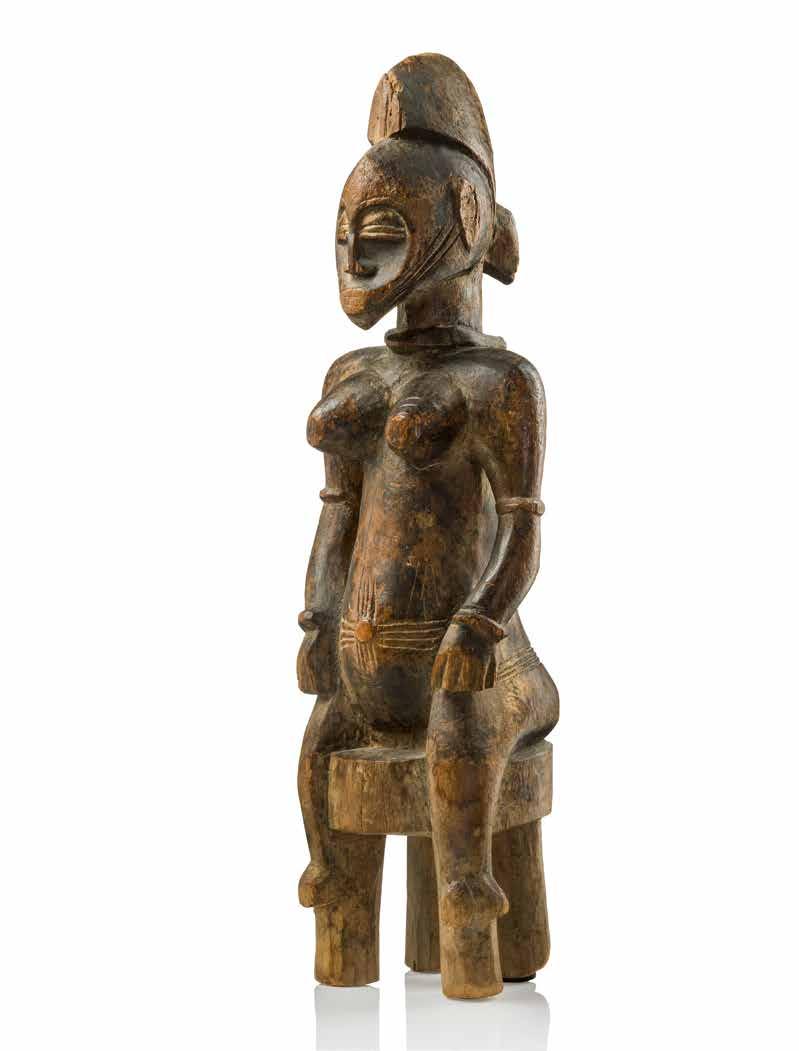
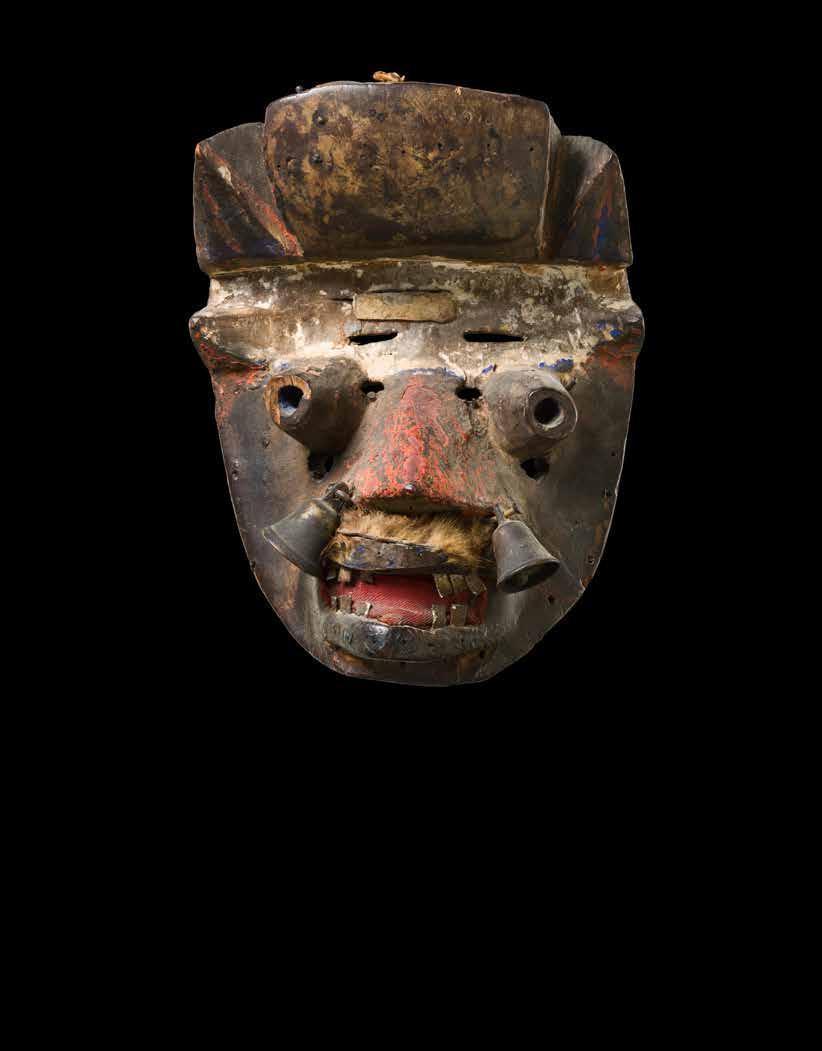
45 Anthropo-zoomorphe Maske Holz, Farb- und Pigmentreste
Anthropo-zoomorphic mask wood, residues of paint and pigment

Provenance Robert Lewitzki, Celle, Germany
Exhibited Unterlüß, Albert-König-Museum: „Afrikanische Kunst, Sammlung Ro bert Lewitzki“, 11. März - 16. April 2001
Publ. in Expo cat.: „Afrikanische Kunst, Samm lung Robert Lewitzki“, Albert-KönigMuseum (Hg.), Unterlüß, 2001, p. 57, cat. 84
H: 18 cm
€ 2.000 - 4.000
Anthropomorphic figure „jagana“ wood, base H: 57,5 cm

Provenance Robert Lewitzki, Celle, Germany
Exhibited Celler Schloß, Gotische Halle: „Afri kanische Kunst, Sammlung Robert Lewitzki“, 10. Juli - 31 August 2012
Publ. in Expo cat.: „Afrikanische Kunst, Samm lung Robert Lewitzki“, Bomann-Muse um (Hg.), Celle 2012, p. 51
€ 2.000 - 4.000
Holz, Diese gehörnte Maske ver körpert eine Antilope „karikpo“, die Fruchtbarkeit, Kraft und Anmut symbolisiert.
Der „karikpo“- Tanz findet in erstern Linie anlässlich von Agrarzeremonien aber auch bei wichtigen sozialen Er eignissen statt.
This horned mask embodies an an telope „karikpo“, which symbolizes fertility, strength and grace.

The „karikpo“ dance takes place pri marily on the occasion of agricultu ral ceremonies, but also at important social events.
H: 19,5 cm
Max Itzikovitz, Paris, France
Robert Lewitzki, Celle, Germany
Celler Schloß, Gotische Halle: „Afri kanische Kunst, Sammlung Robert Lewitzki“, 10. Juli - 31 August 2012
Publ. in Expo cat.: „Afrikanische Kunst, Samm lung Robert Lewitzki“, Bomann-Muse um (Hg.), Celle 2012, p. 39
€ 2.500 - 5.000
49 Zauberfigur „mu‘ po“ Holz, Sockel
Power figure „mu‘ po“ wood, base
48 Tanzstab „oshe shango“ Holz, Sockel
Mit diesen Stäben in der Hand nah men die Anhänger des mächtigen Donner-Gottes „shango“ an Tänzen, Prozessionen und Riten zu Ehren ihres Gottes teil. Wenn nicht in Gebrauch, dienten die Tanzstäbe zur Dekoration von Schreinen, die „shango“ geweiht waren.
Die Doppelaxt symbolisiert die neoli thischen Steinbeile („edun ara“), von denen die Yoruba glauben, dass es sich um Donnerkeile handelt, die von „shango“ durch Blitze vom Himmel geschleudert wurden. Die Doppelaxt ist daher Symbol für die Präsenz und Allmacht der Gottheit „shango“.
Dance wand „oshe shango“ wood, base
With such wands in their hands, the followers of the mighty thunder god „shango“ participated in dances, pro cessions, and rites in honor of their deity. When not being used, the staffs are used to decorate shrines dedica ted to „shango“.
The double ax is a representation of neolithic stone celts („edun ara“) that

the Yoruba believe to be thunderbolts hurled from the sky through lightning by „shango“. The double axe is there fore a primary symbol for the pre sence and omnipotence of „shango“. H: 40 cm
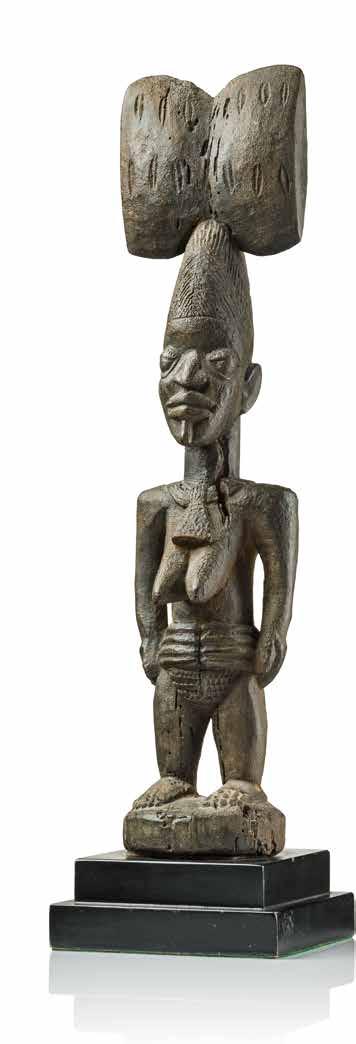
Manfred Sackmann, Berlin, Germany Robert Lewitzki, Celle, Germany
Unterlüß, Albert-König-Museum: „Afrikanische Kunst, Sammlung Ro bert Lewitzki“, 11. März - 16. April 2001; Celler Schloß, Gotische Halle: „Afri kanische Kunst, Sammlung Robert Lewitzki“, 10. Juli - 31 August 2012
Publ. in Expo cat.: „Afrikanische Kunst, Samm lung Robert Lewitzki“, Albert-KönigMuseum (Hg.), Unterlüß, 2001, p. 45, cat. 68; Expo cat.: „Afrikanische Kunst, Sammlung Robert Lewitzki“, Bomann-Museum (Hg.), Celle 2012, p. 46 € 2.000 - 4.000
Holz, Pigmentreste, rest., Sockel
Dem Büffel wird Stärke, Mut und Macht zugesprochen. Nach dem Leo parden und dem Elefanten, zählt auch er zu den königlichen Symbolen des Graslandgebietes.
Büffelmasken wurden von Palastauf sehern in ihrer Rolle als Marktpolizei, zur Verhaftung von Übeltätern und als Richter getragen.
wood, pigment residues, rest., base
The buffalo is said to have strength, courage and power. After the leopard and the elephant, it is also one of the royal symbols of the grasslands.
Buffalo masks were worn by palace regulators in their roles as market police, apprehenders of wrongdoers, and court judges.
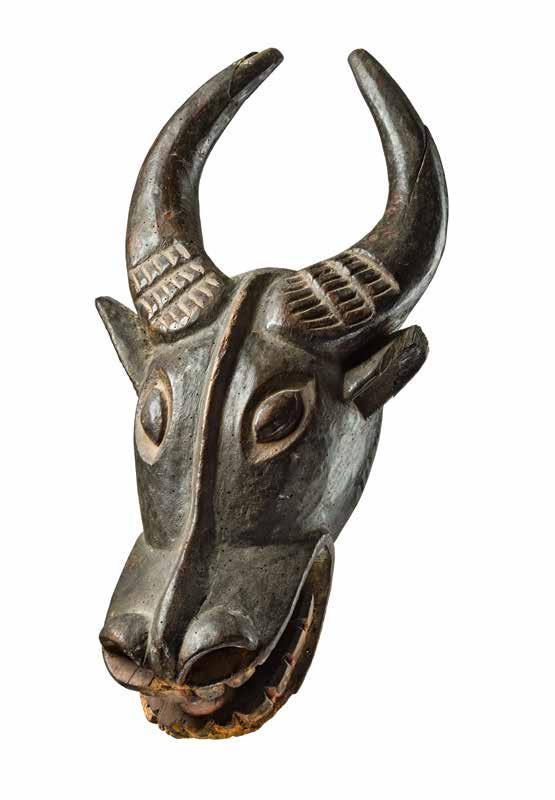
Robert Lewitzki, Celle, Germany
Unterlüß, Albert-König-Museum: „Afrikanische Kunst, Sammlung Ro bert Lewitzki“, 11. März - 16. April 2001; Celler Schloß, Gotische Halle: „Afri kanische Kunst, Sammlung Robert Lewitzki“, 10. Juli - 31 August 2012
Publ. in Expo cat.: „Afrikanische Kunst, Samm lung Robert Lewitzki“, Albert-KönigMuseum (Hg.), Unterlüß, 2001, p. 17, cat. 15; Expo cat.: „Afrikanische Kunst, Sammlung Robert Lewitzki“, BomannMuseum (Hg.), Celle 2012, p. 45
57 cm
800 - 1.600
Diese Maske repräsentiert einen Würdenträger mit typischer Prestige-Kappe. Der Tänzer ist oft in ein traditionelles Gewand aus königlichem Stoff gehüllt und trägt einen Fliegenwedel in Händen.
This mask represents a title holder with typical prestige cap. The mask often dances with a flywhisk and a traditional vest ment of royal cloth.

51 Männliche Maske Holz, krustierte Patina, Kaolin, rest.
Male mask wood, encrusted patina, kaolin, rest. H: 36 cm
Thomas Schulze, Berlin, Germany
Robert Lewitzki, Celle, Germany
Vgl. Lit.: Northern, Tamara, The Art of Cameroon, Washington D.C. 1984, p. 147
€ 2.500 - 5.000

SOUTHERN CAMEROON, FANG - BULU
52 Weibliche Reliquiar-Wächterfigur „éyéma-o-byéri“ (Bild des Ahnen)
Holz, Sockel
Meist stellen die Figuren für den „byéri“- Kult männliche Ahnen dar. Aber auch Frauen, die sich besonders verdient gemacht hatten, beispiels weise durch die Geburt vieler Kinder, konnten in den Rang eines verehrten Ahnen erhoben werden
Female reliquary guardian figure

„éyéma-o-byéri“ (Image of the ancestor)
wood, base
Most of the figures for the „byéri“ cult represent male ancestors, but also women who had made special contributions, especially through the birth of many children, could be eleva ted to the rank of revered ancestors.
46 cm
Manfred Sackmann, Berlin, Germany Robert Lewitzki, Celle, Germany
Celler Schloß, Gotische Halle: „Afri kanische Kunst, Sammlung Robert Lewitzki“, 10. Juli - 31 August 2012
Publ. in Werner Fischer, Kamerun und seine Kunst, Düsseldorf 1988, p. 108 (left); Expo cat.: „Afrikanische Kunst, Samm lung Robert Lewitzki“, Bomann-Muse um (Hg.), Celle 2012, p. 32 (left)
€ 10.000 - 20.000
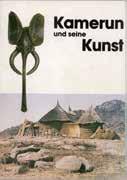

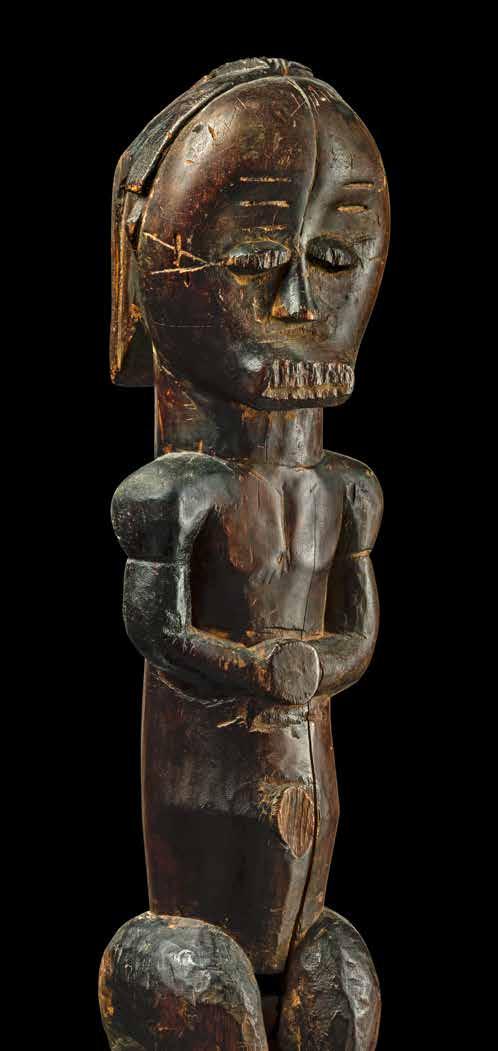
Als Wandervolk haben die Fang den Brauch, die Knochen und Schädel ver storbener Häuptlinge und wichtiger Gemeinschaftsmitglieder (zusammen mit magischen Substanzen) in zylind rischen Rindenbehältern zu sammeln, anstatt sie in Gräbern zu bestatten.
Die Behältnisse werden von figuralen Holzskulpturen bekrönt, von denen man glaubt, dass sie die Schutzgeis ter der Ahnen verkörpern, die in den Behältern aufbewahrt werden,“die physische Verkörperung der Lebens kraft ihrer Ahnen“.
Diese Ahnenschreine (Behältnis plus Figur) sind als „nsek byéri“ bekannt, und die Wächterfiguren, die die Schreine beschützen, werden „éyé ma-o-byéri“ genannt.
Es wird angenommen, dass die Leben den durch Opfergaben an die „nsekbyéri“- Schreine die Möglichkeit er hielten mit den Ahnen im Geisterreich zu kommunizieren. „Byéri“- Figuren werden konsultiert, bevor wichtige Aufgaben in Angriff genommen wer den, und diese Figuren werden auch bei der Einweihung junger Männer in den „byéri“- Kult verwendet. Bei jeder Kulthandlung wurden sie mit Öl oder Blut bestrichen und mit Nahrung versorgt.

Reliquary guardian figure „éyémao-byéri“ (Image of the ancestor) wood, base

As a migratory people, the Fang have the custom of gathering the bones and skulls of deceased chiefs and important community members (to gether with magical substances) into cylindrical bark containers, instead of burying them in graves.
Crowning the containers are figural sculptures, made from wood, belie ved to embody the guardian spirits of family ancestors held within the containers, „the physical embodiment of their ancestor’s vital force“.
These ancestor shrines (container and figure) are known as „nsek byéri“ and the guardian figures protecting the shrines are known as „éyéma-o-byéri“.
It is believed that these shrines al low the living to communicate with ancestors in the spirit realm through offerings made to the „nsek-byéri“ shrines. „Byéri“ figures are consulted before important tasks are underta ken and these figures are also used during the initiation of young men into the „byéri“ cult. At each ritual act they were smeared with oil or blood and provided with food.
Photo: Hans
Provenance Coll. Borsi, Luxembourg Galerie Flak, Paris, France (2002) Robert Lewitzki, Celle, Germany
Exhibited
Celler Schloß, Gotische Halle: „Afri kanische Kunst, Sammlung Robert Lewitzki“, 10. Juli - 31 August 2012
Publ. in Expo cat.: „Afrikanische Kunst, Samm lung Robert Lewitzki“, Bomann-Muse um (Hg.), Celle 2012, p.

AHDRC:

Die Vorderseite der Figur zeigt vor al lem am Körper eine dick verkrustete Opferpatina. Am Kopf befindet sich eine schalenförmige Vertiefung zum Einfügen von magischer Masse. Die Figur wurde ursprünglich in Ka merun (Duala) verortet. Coppens hielt eine Herkunft aus Gabun, möglicher weise von den Kande (Okandé) aus der Region des mittleren Ogowe für wahrscheinlicher.
Eine eindeutige geographisch / eth nische Zuordnung der Figur erscheint uns schwer möglich.
The front of the figure shows a thickly encrusted sacrificial patina, especially on the body. There is a cup-shaped hole in the crown for insertion of ma gical mass.
The figure was originally located in Cameroon (Duala). Coppens conside red an origin from Gabon, possibly from the Kande (Okandé) of the midd le Ogowe region more likely.




A clear geographic / ethnic assignment of the figure seems difficult to us.
H: 47 cm
Martien Coppens, Eindhoven, The Netherlands
Robert Lewitzki, Celle, Germany
Celler Schloß, Gotische Halle: „Afri kanische Kunst, Sammlung Robert Lewitzki“, 10. Juli - 31 August 2012
Coppens, Martien, „Negro sculpture“, Eindhoven, 1975, ill. 215-216-217; Expo cat.: „Afrikanische Kunst, Sammlung Robert Lewitzki“, Bomann-Museum (Hg.), Celle 2012, p. 27
€ 5.000 - 10.000
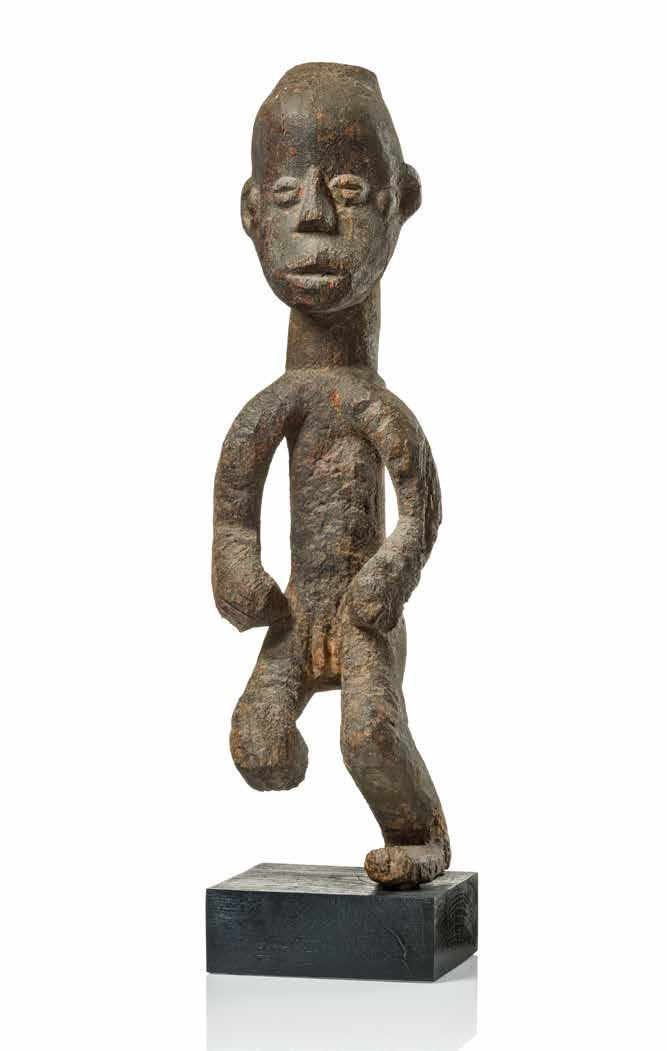
„kalengula“ mit „kifwebe“- Maske Holz, Farbpigmente, alte Beschriftung „BN...825r“ und handschriftl. aufge brachte Inventarnr.“1457“, Sockel Mestach berichtet in seiner Abhand lung über Songe-Plastik von einem Paneel mit aufgeschnitzter „kifwebe“ Maske aus der Kabalo-Region im Mu seum von Kinshasa. Es ist als Wächter des Maskenhauses („kiobo“) ausge wiesen und trägt die Bezeichnung „kalengula“ - „Maske, die nicht tanzt“. Meistens als „kalengula“ bezeichnet, wird manchmal auch der Name „nga bo“ („gabo“) für die schildförmigen Paneele angegeben. Maurer berichtet, dass sie bei verschiedenen Zeremoni en verwendet wurden und oft bei tra ditionellen Tänzen der „bwadi ka bif webe“- Gesellschaft aufgetreten sei en. Laut Barbier & Benitez-Johannot wurden sie als Symbol für politische und militärische Allianzen an fremde Stammesoberhäupter verliehen. Die Maskenpaneele zeigen unter schiedlichste Erscheinungsformen, kleinformatig, wie das vorliegende Ex emplar oder groß (bis zu 95 cm Höhe) und dabei brettartig flach (vgl. Me stach, fig. 14) oder eher schildförmig. Daneben gibt es auch runde Platten, die kleine „kifwebe“ Masken tragen. Die Bedeutung der Maskenpaneele in ihren unterschiedlichen Erschei nungsformen ist bis heute nicht ein deutig geklärt. In jedem Falle deutet die aufgeschnitzte kleine „kifwebe“Maske auf eine spirituelle Funktion hin, denn diese Masken verkörpern übernatürliche Kräfte, die angerufen werden, um Bedrohungen für die Ge meinschaft abzuwehren.
Shield-shaped panel „kalengula“ with „kifwebe“ mask wood, colour pigments, old inscrip tion „BN...825r“ and handwritten in ventory no. „1457“, base
In his treatise on Songe sculpture, Me stach reports on a panel with a carved „kifwebe“ mask from the Kabalo regi on in the Kinshasa museum. It is designated as the guardian of the mask house („kiobo“) and bears the inscription „kalengula“ - „mask that does not dance“.
Usually referred to as „kalengula“, the name „ngabo“ („gabo“) is sometimes given for the shield-shaped panels. Maurer reports that they were used in various ceremonies and often ap peared in traditional dances of the „bwadi ka bifwebe“ society. According to Barbier & Benitez-Johannot, they were also awarded to foreign tribal chiefs as a symbol of political and military alliances.
The mask panels show a wide variety of appearances, small-formatted, like the present specimen, or large (up to 95 cm high) and thereby board-like flat (cf. Mestach, fig. 14) or rather shield-shaped. There are also round plates bearing small „kifwebe“ masks.
The meaning of the mask panels in their various manifestations has not been clarified to this day. In any case, the carved small „kifwebe“ mask in dicates a spiritual function, for these masks embody supernatural powers that are invoked to ward off threats to the community.
H: 38 cm AHDRC: 0133674
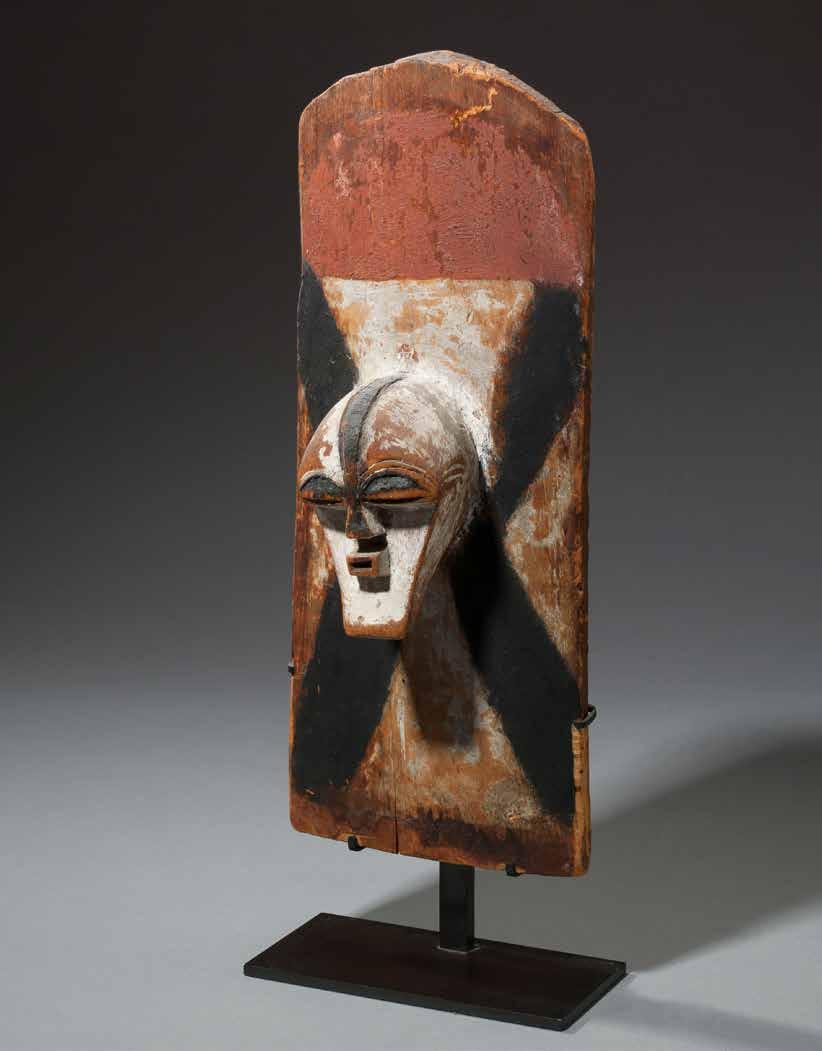 Photos: Ulrich Loeper
Photos: Ulrich Loeper
Ana Ricart, Barcelona, Spain
David Serra, Barcelona, Spain
Robert Lewitzki, Celle, Germany
Certificate of Authenticity, David Ser ra, Barcelona, May 2012
Exhibited
Brussels, Belgium: „BRUNEAF, Brus sels Non European Art Fair XXII“, 6-10 June 2012
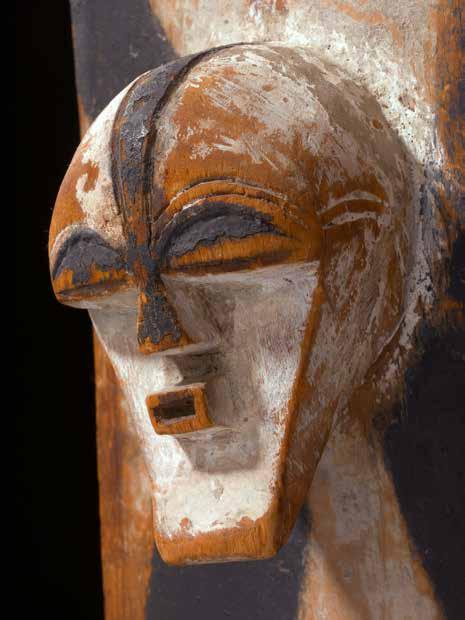
Publ. in Expo cat.: „BRUNEAF, Brussels Non European Art Fair XXII“, Brussels, 2012, p.123 (adv. David Serra)
Vgl. Lit.: Mestach, Jean Willy, Songye Studien, München 1985, p. 63
Maurer, Evan, The Intelligence of Forms, Minneapolis 1991, p. 63, ill. 32
Barbier, Jean Paul, Benitez-Johannot, P., „Shields“, Munich, London, New York 2000, p. 88 f.
€ 8.000 - 15.000
56 Zauberfigur „buti“ Holz, Tierhörner, Terrakotta, Opfer masse, Sockel
Power figure „buti“ wood, animal horns, terracotta, sacrificial mass, base H: 22,5 cm

Craig de Lora, New Jersey, USA Olaf Pfennig, Hannover, Germany
Zemanek-Münster, Würzburg, 10 March 2018, Lot 470 Robert Lewitzki, Celle, Germany
Celler Schloß, Gotische Halle: „Afri kanische Kunst, Sammlung Robert Lewitzki“, 10. Juli - 31 August 2012
Publ. in Expo cat.: „Afrikanische Kunst, Sammlung Robert Lewitzki“, Bo mann-Museum (Hg.), Celle 2012, p. 46
€ 800 - 1.500
D. R. CONGO, TEKE„Buti“ - Figuren sind nach be stimmten männlichen Vorfahren benannt und werden in einem Schrein für verstorbene Familien mitglieder aufgestellt. Sie sollen bei einer Vielzahl von Problemen helfend eingreifen.
Durch die Zugabe von „bonga“ (magische Ladung) wird die leb lose skulpturale Hülle der Figur (Figuren ohne „bonga“ werden „tege“ genannt) in einen Ahnen verwandelt.
Um eine Ahnenfigur zu entsak ralisieren, müssen die darin ent haltenen magischen Substanzen entfernt werden. Nach dem Tod des Besitzers einer Figur werden die „buti“ zusammen mit seinem Körper und seinen anderen Hab seligkeiten begraben.

„Buti“ figures are named after and identified as specific male ancestors and located in a shrine to one’s deceased family mem
bers. They are designed to help with a variety of problems.
The addition of „bonga“ (magical charge) transforms the inanimate sculptural shell of the figure (figu res devoid of „bonga“ are called „tege“) into an ancestor.
To desacralise an ancestral figure, the mystical substances located within must be removed. Upon the death of a figure’s owner, „buti“ are buried along with his body and other belongings.
Robert Lewitzki, Celle, Germany
Celler Schloß, Gotische Halle: „Afri kanische Kunst, Sammlung Robert Lewitzki“, 10. Juli - 31 August 2012
Publ. in Expo cat.: „Afrikanische Kunst, Sammlung Robert Lewitzki“, Bo mann-Museum (Hg.), Celle 2012, p. 24 (left)
€ 2.000 - 4.000
58 Anthropomorphe Janusfigur „khosi“
Holz, Pigmente, pflanzliche Materi alien, Sockel
Eine Figur der Leoparden-Gesellschaft „khosi“, die durch ihre rot-weiße Be malung charakterisiert sind.
Anthropomorphic janus figure „khosi“ wood, pigments, plant materials, base A figure of the leopard society „khosi“, which are characterized by their red and white painting.

Robert Lewitzki, Celle, Germany
Unterlüß, Albert-König-Museum: „Afrikanische Kunst, Sammlung Ro bert Lewitzki“, 11. März - 16. April 2001; Celler Schloß, Gotische Halle: „Afri kanische Kunst, Sammlung Robert Lewitzki“, 10. Juli - 31 August 2012
Publ. in Expo cat.: „Afrikanische Kunst, Samm lung Robert Lewitzki“, Albert-KönigMuseum (Hg.), Unterlüß, 2001, p. 65, cat. 93; Expo cat.: „Afrikanische Kunst, Sammlung Robert Lewitzki“, BomannMuseum (Hg.), Celle 2012, p. 11 (right)
Vgl. Lit.: Bourgeois, Arthur P., Art of the Yaka and Suku, Paris 1984, p. 107 € 1.500 - 3.000
59 Vier Zauberfiguren
„m-mbwoolu“
Holz, jeweils gesockelt Diese Figuren werden von der „m-mb woolu-tsyo“-Gesellschaft verwendet. Sie zeigen unterschiedlichste Formen, oftmals Figuren ohne Gliedmaßen oder in Janus-Form, wie vorliegend. Sie wurden vom Zauberpriester „nganga“ zur Heilung von Krankhei ten eingesetzt.
Four power figures „m-mbwoolu“ wood, each mounted on base These figures are used by the „mmbwoolu-tsyo“ ritual institution. They show most different forms, often fi gures with missing limbs or jani-form, as the present. They were used by the magic priest „nganga“ to cure diseases.
H: 12,5 cm - 17,5 cm
Robert Lewitzki, Celle, Germany
€ 800 - 1.500
60 Kniende weibliche Gedenkfigur
leichtes Holz, Farbe, rest.
Bei diesen realistischen Menschen darstellungen handelt es sich um Gedenkfiguren, die an besonders ver diente Verstorbene erinnern sollen, ohne dabei jedoch Porträt-Ähnlichkeit anzustreben.
Kneeling female memorial figure light wood, paint, rest. These realistic representations are memorial figures intended to com memorate particularly deserving de ceased persons, without aiming at portrait resemblance.
H: 50,5 cm
Colonial Collection, Liège, Belgium
Paul Gilman, Liège, Belgium
Alain Guisson, Brussels, Belgium (1990)
Robert Lewitzki, Celle, Germany
Kecskési berichtet, dass sie im Haus des Familienoberhauptes aufbe wahrt wurden, während vergleich bare, mit weißem Kaolin bestrichene Totenfiguren auf Grab stätten unter einem Schutzdach aufgestellt wurden.
In der Publikation „Kongo Kingdom Art“ von Marc Leo Felix sind ge weisste Totenfiguren fotografisch dokumentiert (Felix, 2003, S. 278, ill. 8,13). Ihm zufolge wurden die Figu ren zuerst über den Gräbern aufge stellt und gelangten nach dem Zerfall der Grabhäuser ins Haus der Familie.
Kecskési reports that they were kept in the house of the head of the fam ily, while comparable figures of the dead painted with white kaolin were placed on gravesites under a shelter.
In the publication „Kongo Kingdom Art“ by Marc Leo Felix, whitened figures of the dead are photographically documented (Felix, 2003, p. 278, ill. 8,13). According to him, the figures were first placed over the graves and after the decay of the grave houses, they were brought into the family home.

Celler Schloß, Gotische Halle: „Afri kanische Kunst, Sammlung Robert Lewitzki“, 10. Juli - 31 August 2012
Publ. in Expo cat.: „Afrikanische Kunst, Sammlung Robert Lewitzki“, Bo mann-Museum (Hg.), Celle 2012, p. 23
AHDRC: 0017881
Vgl. Lit.: Kecskési, Maria, Kunst aus Afrika, München, London, New York 1999, p. 28
Felix, Marc L. (ed.), Kongo Kingdom Art, China 2003, p. 278 f.
€ 5.000 - 12.000
 D. R. CONGO, ZOMBO
D. R. CONGO, ZOMBO
Holz, Pigmente, Raffiafasern, Rattan, rest., Sockel
Nach Felix wurden diese Masken bei Beschneidungsriten verwendet (Felix, 1987, S. 208).
Anthropomorphic face mask wood, pigments, raffia fibre, rattan, rest., base

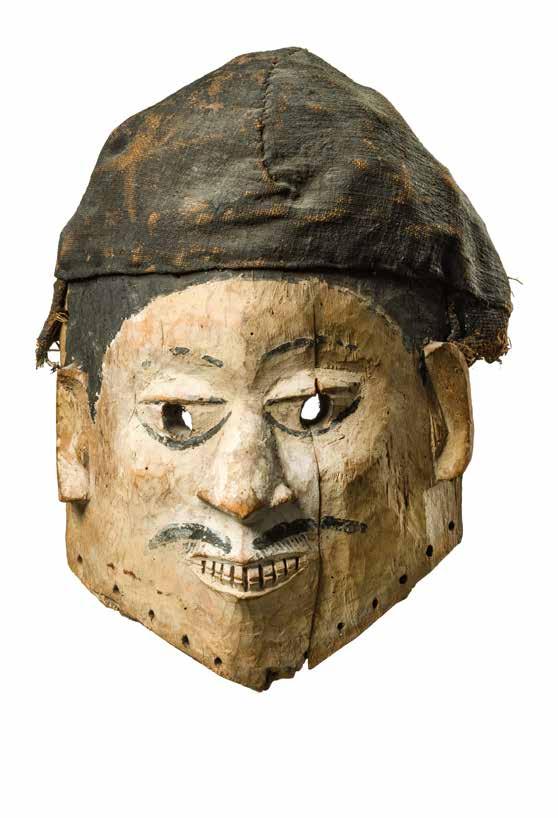
According to Felix, these masks were used in circumcision rites (Felix, 1987, p. 208).
Robert Lewitzki, Celle, Germany
Celler Schloß, Gotische Halle: „Afri kanische Kunst, Sammlung Robert Lewitzki“, 10. Juli - 31 August 2012
Publ. in Expo cat.: „Afrikanische Kunst, Samm lung Robert Lewitzki“, Bomann-Muse um (Hg.), Celle 2012, p. 22 H: 35 cm
Für vergleichbare Masken siehe AHDRC 0016300 und 0156257. For comparable masks, see AHDRC 0016300 and 0156257. AHDRC 0156257
Photo: Titus van Rijn
Vgl. Lit.: Felix, Marc L., 100 Peoples of Zaire and their Sculpture, Brussels 1987, p. 208 f.
€ 1.500 - 3.000
62 Anthropomorphe Helmmaske „tshibangabanga“
Holz, Abrussamen, Tierhaut, Federn, Rattan, Sockel
Laut Felix werden diese Masken bei In itiationsritualen der Binji verwendet, wo sie vom Meister des Initiationsla gers getragen wurden. Sie sind furchteinflössend, mit all dem magischen Beiwerk wie Federn und roten Abrussamen und gelten als sehr mächtig.
Anthropomorphic helmet mask „ts hibangabanga“
wood, abrus seeds, hide, feathers, rattan, base
According to Felix, these masks are used in Binji initiation rituals, where they are worn by the master of the initiation camp. They look fearsome, with all the ma gical accessories like feathers and red abrus seeds, and are considered very powerful.
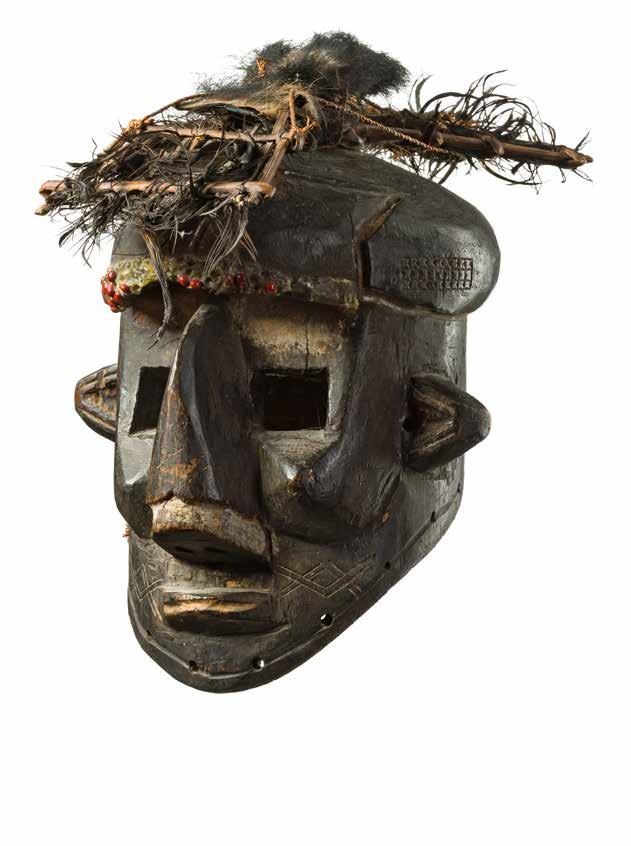
H: 30 cm
Robert Lewitzki, Celle, Germany
Vgl. Lit.: Felix, Marc L., 100 Peoples of Zaire and their Sculpture, Brussels 1987, p. 13, ill. 4
€ 2.000 - 4.000
63 Würdestab, Schnupftabaksbehälter und Axt a) Nguni, Würdestab, Holz, L: 88 cm; b) Zulu, Schnupftabaksbehälter „is hungu“, Kürbis, Messing- und Kupfer draht, H: 5,5 cm, D: 6 cm Dazu:
c) Tansania, Luguru, Axt, Holz, Mes sing, Eisen, L: 54 cm / 22 cm (Schaft/ Klinge)
Dignitary staff, snuff box and axe a) Nguni, dignitary staff, wood, l: 88 cm; b) Zulu, snuff container „ishungu“, gourd, brass and copper wire, h: 5,5 cm, d: 6 cm comes with: c) Tanzania, Luguru, axe, wood, brass, iron, l: 54 cm / 22 cm (shaft / blade)
Robert Lewitzki, Celle, Germany
€ 1.000 - 2.000
64 Stehende anthropomorphe Figur, um 1900 Holz, rest., Sockel
Laut Conru diente diese Figur höchst wahrscheinlich als didaktisches Inst rument bei der Erziehung junger Men schen zu erwachsenen, vollwertigen Mitgliedern der Gemeinschaft. Solche Figuren wurden beispielsweise bei den Venda im Rahmen von Initia tionszeremonien verwendet.
Standing anthropomorphic figure, around 1900 wood, rest., base
According to Conru, this statue would have been most likely used as a di dactic tool for a young individual‘s education into the workings of adulthood.
Amongst the Venda for instance, such statuary would be used on specific oaccasions in initation ceremonies leading out of puberty.


H: 69 cm
Provenance Christie‘s, London, 1980
Fernando Moncada, Lisbon, Portugal
Kevin Conru, London / Brussels, Belgium
Robert Lewitzki, Celle, Germany
Exhibited
Celler Schloß, Gotische Halle: „Afri kanische Kunst, Sammlung Robert Lewitzki“, 10. Juli - 31 August 2012
Publ. in Conru, Kevin, Southeast African and Oceanic Art, Brussels, 2005, cat. 12; Expo cat.: „Afrikanische Kunst, Samm lung Robert Lewitzki“, Bomann-Muse um (Hg.), Celle 2012, p. 11 (left)

AHDRC: 0115992
€ 6.000 - 12.000

Weltweite Auslandseinsätze für internationale Unternehmen –eine lebenslange Männerfreund schaft – die Hinwendung zur Kunst und Kultur Afrikas: es sind genau diese Bausteine, auf denen die Sammlung Kolberg aufbaut.
Mit ihr auf’s engste verbunden ist der Name Siegfried Wolfram, Sammler, Publizist und großer Freund Liberias, vor allem aber engster Freund, Geschäftspart ner und Hausnachbar der Kolberg Familie.
Beide kennen sich schon einige Jahre aus der Zeit in Indien, als Wolfram, seit Mitte der 1960er als Expatriate in Monrovia tätig, Heinrich Kolberg nach Liberia holt und sie 1967 gemeinsam das Bauunternehmen „GCI General Construction Inc.“, gründen. Er folgversprechend, denn Liberia zählt zu dieser Zeit unter der pro amerikanischen Präsidentschaft William Tubmans (1944 bis 1971) und dessen ‚Politik der offenen Tür‘ zu den wirtschaftlich am stärksten prosperierenden Staa ten Afrikas; mit der Hafenstadt Monrovia als internationaler Hub profitiert zeitgleich auch der Han del mit afrikanischer Kunst.


1975 dann das unumgängliche Aus für ihr Unternehmen: zuneh mende soziale Spannungen, wirt schaftliche Fragilität, Verstaatli
chungen und Einschränkungen für ausländische Unternehmen unter dem Nachfolgepräsidenten William Tolbert führen zu innen politischer Instabilität.

Ab 1974 trifft die Familie Vorbe reitungen für die Rückkehr nach Deutschland, nach FeldkirchenWesterham in Süddeutschland. Gut dokumentiert ist die Verschif fung und Versendung seiner bis dahin gewachsenen umfangrei chen Sammlung; Werke, die er in den Jahren von 1970 bis 1973 vor Ort erworben hatte, darunter die seltene weibliche Halbfigur der Sherbro-Mende [Los 72].
Zurück in Deutschland werden im Laufe der Jahre einige Werke veräußert, andere im Rahmen der Liberia-Ausstellungen im Über see-Museum Bremen (1989-1990, „Liberia – Leben wo der Pfeffer wächst“) und 2014 im Haus der Völker in Schwaz, Tirol (initiiert von Siegfried Wolfram) gezeigt.
Mit Liberia bleiben er und Sieg fried Wolfram über das Forum der Liberia Working Group zeitlebens eng verbunden. Siegfried Wolfram stirbt 2019, Heinrich Kolberg 2014.

Worldwide foreign assignments for international companies – a lifelong male friendship – turning to the art and culture of Africa, it is precisely these building blocks on which the the Kolberg collec tion is built.
The name Siegfried Wolfram is closely associated with it. The col lector, publicist and great „friend of Liberia“ was above all a close friend, business partner and neighbour of the Kolberg family.
Both had known each other for a number of years from their time in India, as Wolfram, since the mid-1960s as expatriate working in Monrovia, brought Heinrich Kolberg to Liberia and they es tablished a construction company „GCI General Construction Inc.“ in 1967. It was promising because Liberia counted at that time un der the pro-American presidency of William Tubman (1944 to 1971) and its ‚open door‘ policy as one of Africa‘s most economically pros perous states. With its port city of Monrovia as an international hub, trade also benefited and at the same time the trade in Afri can art.
Then in 1975 the inevitable hap pened with their company. In creasing social tensions, economic fragility, nationalizations and re strictions on foreign companies under the successor President Wil liam Tolbert led to domestic and political instability.
From 1974 the family made prepa rations to return to Feldkirch en-Westerham in southern Germa ny. The shipping and dispatch of his collection is well documented. Works that he had collected in Libe ria between 1970 and 1973 includ ing a rare female half-length figure of the Sherbro-Mende [Lot 72].
Back in Germany, some works were sold over the years, others were part of the Liberia exhibi tions in the Übersee-Museum Bre men (1989-1990, „Liberia - Leben wo der Pfeffer wächst“) or shown in 2014 in the Haus der Völker in Schwaz, Tyrol (initiated by Sieg fried Wolfram).
He and Siegfried Wolfram re mained closely connected to Libe ria for the rest of their lives through the forum of the „Liberia Working Group“. Siegfried Wolfram died in 2019, Heinrich Kolberg in 2014.
65 Fünf Miniaturmasken „ma go“ (kleiner Kopf) Holz, Pigmente
Five miniature masks „ma go“ (small head) wood, pigments


H: 4,2 cm - 8,5 cm
Heinrich Kolberg, Feldkirchen-Wester ham, Germany (coll. 1970/71)
€ 500 - 1.000
66 Fünf Miniaturmasken „ma go“ und ein Januskopf Holz, „ma go“ in diversen Größen, H: 4,8 cm - 8 cm; Januskopf: H: 7 cm
Five miniature masks „ma go“ and a janiform head wood, „ma go“ in various sizes, h: 4,8 cm - 8 cm; Janus head: h: 7 cm.

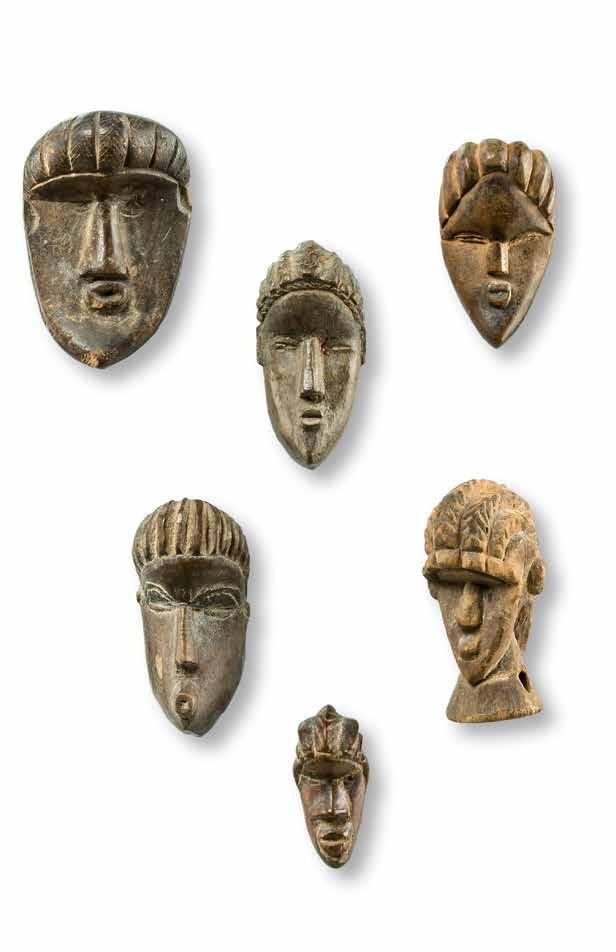
Heinrich Kolberg, Feldkirchen-Wester ham, Germany (coll. 1970/71)
Vgl. Lit.: Meneghini, Mario, Collecting African Art in Liberia and Neighboring Countries 1963 - 1989, o.O. 2006, p. 115 f.
€ 600 - 1.200
67 Drei Miniaturmasken „ma go“ (kleiner Kopf) Holz, Pigmente
Three miniature masks „ma go“ (small head) wood, pigments



H: 7,5 cm; 10 cm; 11,5 cm
Heinrich Kolberg, Feldkirchen-Wester ham, Germany (coll. 1970/71)
€ 450 - 900
68
Holz
Miniaturmasken waren Besitz ein zelner Individuen und sollten bei der Kommunikation mit den Ahnen be hilflich sein, von denen Schutz und Hilfe erhofft wurde.
Auch das janusförmige Köpfchen diente dem Schutz einer einzelnen Person. Seine Aufgabe war es Gefah ren abzuwehren. So sollte es beispiels weise vor Schlangenbissen schützen, wenn sein Besitzer sich zur Arbeit auf die Felder begab.
Janiform miniature mask „ma go“ (small head)
wood
Miniature masks belonged to single individuals and were meant to help in
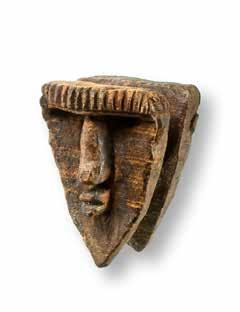
communicating with the ancestors, from whom help and protection was hoped for.
The janiform head also served to pro tect a single person. Its task was to ward off danger. For example, when venturing into the fields for protec tion against snake bites.
H: 4,2 cm
Heinrich Kolberg, Feldkirchen-Wester ham, Germany (coll. 1970/71)
Vgl. Lit.: compare AHDRC 0075699
€ 450 - 900
69 Weibliche Figur „nomoli“ oder „pomdo“ Speckstein, im Bast-Etui
Female figure „nomoli“ or „pomdo“ soapstone, in raffia case
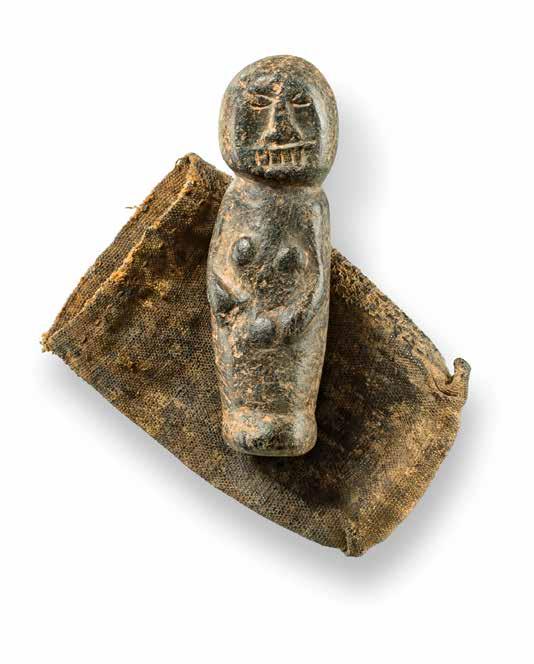
H: 16 cm
Provenance Heinrich Kolberg, Feldkirchen-Wester ham, Germany (coll. 1970/71)
€ 250 - 500
70 Helmmaske „ndoli jowei“ Holz
Helmet mask „ndoli jowei“ wood
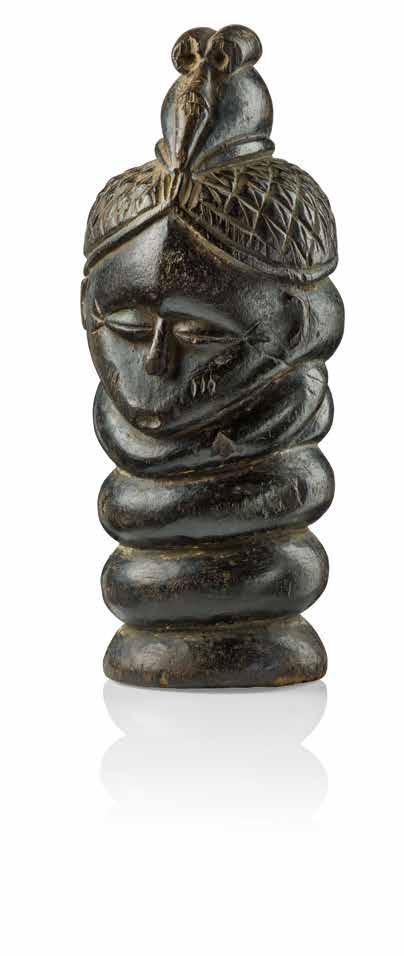
H: 30 cm
Provenance
Heinrich Kolberg, Feldkirchen-Wester ham, Germany (coll. 1970/71)
€ 450 - 900
71 Medizin Kopf des „sande“Bundes Holz
„Sande“ medicine head wood H: 26,5 cm
Lot 71
Heinrich Kolberg, Feldkirchen-Wester ham, Germany (coll. 1970/71)
Vgl. Lit.: Hommel, William, Art of the Men de, University of Maryland 1974, ill. 26
€ 250 - 500
72 Seltene weibliche Halbfigur in schalenförmiger Basis Holz, Metall

Eine dieser seltenen Figuren publiziert bei LaGamma (New York 2000, S. 28/ AHDRC 0112955). Für eine weitere sie he AHDRC 0112959.
Diese Figuren befanden sich im Besitz der „yassi“-Gesellschaft der Sherbro. Hall berichtet, dass sie als Wächter der Medizinen im „yassi“- Versammlungs haus aufbewahrt wurden. Bei Feiern anläßlich der Aufnahme neuer Mitglieder oder zum Tode eines Bundmitgliedes, sollen sie in öffentlichen Prozessionen vorangetragen worden sein. In erster Linie wurden die Figuren bei Wahrsageriten zur Heilung körperlicher und geistiger Krankheiten eingesetzt, die meist Folge von Verstößen ge gen die von den Geheimgesellschaf ten festgelegten Verhaltenscodices / Gesetze waren.
Das Pendant zur „yassi“- Gesellschaft der Sherbro ist die „njayei“- Gesell schaft der Mende. H:
Rare female half figure in bowlshaped base wood, metal One of these rare figures published by LaGamma (New York 2000, page 28 / AHDRC 0112955). For another, see AHDRC 0112959.
These figurines were owned by the „yassi“ society of the Sherbro.
Hall reports that they were kept as guardians of the medicines in the „yassi“ meeting house. Such works were carried aloft in public proces sions to celebrate the initiation of new members and to commemorate a member‘s death.
First and foremost, the figures were used in divination rites to cure phy sical and mental illnesses, which were usually the result of violat ions of the codes of conduct / laws established by the secret societies.
The counterpart to the „yassi“ society of the Sherbro is the „njayei“ society of the Mende.
Heinrich Kolberg, Feldkirchen-Wester ham, Germany (coll. 1970/71)
Vgl. Lit.: LaGamma, Alisa, Art and Oracle, New York 2000, p. 28 Hommel, William, Art of the Mende, University of Maryland 1974, ill. 46
€ 2.000 - 5.000
SIERRA LEONE, SOUTHERN BULLOM (SHERBRO) / MENDE COMPLEX
74 Sieben Armreifen
Kupferlegierung (Bronze, Messing), anthrazitgraues Gestein, diverse Formen und Größen, H: 7 cm - 9 cm; ein Reif der Baule, H: 14 cm, D: 8 cm (innen), B: 4,5 cm
Seven bracelets / armlets copper alloy (bronze, brass), anthra cite gray stone, various shapes and sizes, h: 7 cm - 9 cm; one bracelet of the Baule, h: 14 cm, d: 8 cm (inside), w: 4,5 cm
Heinrich Kolberg, Feldkirchen-Wester ham, Germany (coll. 1970/71)
75 Acht Goldgewichte, Ring und Anhänger
10 Stk., Gelbguss, vier Goldgewichte von geometrischer Form, Querhorn/ Trompete, Vögel an einem Baum, Hahn, menschl. Figur, diverse Größen, H: 0,7 cm - 7 cm
Dazu: Ring mit Reiterfigur (D: 2 cm) und ornamental durchbrochener Schmuckanhänger (H: 8,5 cm)
Eight gold weights, ring and pen dant
10 pcs., brass, four gold weights of geometric shape, horn / trumpet, birds on a tree, rooster, human figure, various sizes, h: 0,7 cm - 7 cm
Comes with: ring with equestrian fi gure (d: 2 cm) and ornamental open work pendant (h: 8,5 cm)
Heinrich Kolberg, Feldkirchen-Wester ham, Germany (coll. 1970/71)
€ 300 - 600
NIGERIA, CROSS RIVER, BOKI (EKOI COMPLEX)
76 Anthropo-zoomorpher Tanzaufsatz
Holz, Metall, Kaurischnecken, Tier haut, Korbgeflecht
Anthropo-zoomorphic dance crest wood, metal, cowries, animal skin, wickerwork
H: 27 cm
Heinrich Kolberg, Feldkirchen-Wester ham, Germany (coll. 1970/71)
Vgl. Lit.: compare AHDRC 0091037
€ 450 - 900
73 Zoomorphe Klappkiefermaske „glewa“ („gle va“) Holz, Pigmente, Stoff, Tierhaut, Fe dern, stark krustierte Opferpatina
Zoomorphic mask with hinged jaw „glewa“ („gle va“)
wood, pigments, fabric, animal skin, feathers, strongly encrusted sacrificial patina
H: 34 cm
Heinrich Kolberg, Feldkirchen-Wester ham, Germany (coll. 1970/71)
€ 400 - 800

77 Weibliches Zwillingsfigurenpaar „ere ibeji“ Holz, Metall, Glasperlen
Female pair of twin figures „ere ibeji“ wood, metal, glass beads H: 23 cm (both)
Heinrich Kolberg, Feldkirchen-Wester ham, Germany (coll. 1970/71)
Vgl. Lit.: Polo, Fausto, Enzyklopädie der Ibeji, 2008, cat. 127
€ 400 - 800
78 Zwillingsfigurenpaar „ere ibeji“ Holz, Rotholzmehl, Glasperlen, Kokosnußscheibchen Sehr ansprechendes, reich geschmück tes Figurenpaar mit schöner Ge brauchspatina, die von einer langen Nutzung im Kult zeugt.
Pair of twin figures „ere ibeji“ wood, camwood powder, glass beads, coconut discs Richly adorned beautiful figures with a fine used patina, indicating a long time of usage in the cult.
H: 28 cm & 28,7 cm
Heinrich Kolberg, Feldkirchen-Wester ham, Germany (coll. 1970/71)
Vgl. Lit.: Polo, Fausto, Enzyklopädie der Ibeji, 2008, cat. 578
€ 1.500 - 3.500

Sie ist 82, als sie 2014 ein beeindru ckend persönliches Interview gibt: zu ihrer Geschichte, ihren Erleb nissen und Erkenntnissen, zu ihrer außergewöhnlich großen YorubaPrivatsammlung; aber auch ihre Sicht auf den damaligen Kunstmarkt.

Ursula Heijs-Voorhuis – nichts scheint sie verloren zu haben von ihrer Ener gie und dem Enthusiasmus einer leidenschaftlichen Sammlerin. Dass sie eine der ersten, vielleicht sogar die erste Galeristin der Niederlande ist, die Anfang der 1970er ihre eige ne Galerie für non-European Art in einem männerdominierten Tribal Kunstmarkt eröffnete, scheint für sie nicht erwähnenswert. Viel mehr zählt für sie ihr reich bewegtes und erfülltes Leben als Sammlerin und Galeristin.
„Du kannst das!“ – Weil Vertraute und Freunde ihr zusprachen, doch eine Galerie zu eröffnen, entschied sie sich – anfangs noch etwas zöger lich – für diesen Schritt. Ohne große Vorkenntnisse „Ich wusste nichts! Ich war, was den Wert von Werken betrifft, so etwas von unschuldig. Ich kannte den Handel nicht und ich wusste nicht zu verhandeln und auszuhandeln. Aber ich konnte und wollte lernen!“
Und das tat sie. Rückhalt gaben ihr die Familie und die Zusage der Universität Nijmegen, wo sie in den 1950ern als eine von wenigen Frauen Soziologie studiert hatte, dort auch weiterhin Studenten und Gymnasi asten unterrichten zu können – quasi für alle Fälle….
Jahrzehnte später blickt sie erfüllt und zu Recht mit Stolz zurück „Ich bin nicht Bankrott gegangen. Ich bin auch nicht reich geworden. Aber ich habe viele, sehr viele Menschen ken nen gelernt und bei mir zu Besuch gehabt. Und ich habe sehr viel ge lernt. Und – ich lerne noch jeden Tag dazu!“. Sie genießt ihr offenes Haus, das von außen kaum wahrnehmbar mit Kunst überquillt, ein Haus, das sie nach ihrer Auslandszeit nach dem Tod ihres Mannes (1978), und nach ihrer Rückkehr in die Heimat (1983) unter viel Mühen erbaut. Ein offenes Haus in Berg en Dal, in das jeder gerne kam, in dem Erwachse ne ihren Kindern und Enkeln Kunst näherbrachten, darunter zahlreiche Werke, die sie veräußert und nach ihrer Rückkehr wieder mühsam zu rückgekauft hatte.
Lernen, zeitlebens, war ihr Mantra – durch Zuhören und „viel, sehr viel nachfragen“, wie sie gerne immer wieder betont.
Den Zugang zur Kunst und Volks kunst findet sie als junges Mädchen über ihren Vater, selbst Antiquitäten
sammler. „Von ihm lernte ich Kunst zu sehen und die Unterschiede zwi schen echt und unecht zu erkennen.“
Den Grundstock und erste Erfahrun gen für ihren Galeriebetrieb aber legte das Afrika Museum in Berg en Dal (eröffnet 1954), das zu jener Zeit noch von den Missionaren der Kongregation des Heiligen Geistes geführt wurde, und für das sie drei, vier Jahre arbeitete – bereitwillig un tergeordnete Aufgaben übernahm aber auch an Ausstellungsvorberei tungen mitwirken durfte. „Ich wollte unbedingt dort arbeiten, um jeden Preis, auch umsonst, denn all das, was ich dort lernen durfte und konn te war für mich Bezahlung genug.“
Da hatte sie auch schon erste AfrikaExponate, Ethnographica-Objekte, erworben; ihr erstes bewahrt sie in ihrer Sammlung: eine Dose der Kuba, Kongo, völlig überteuert „dumm ge kauft“, wie sie es mit leichtem Hu mor in der Rückschau nennt.
Aus vielen Gesprächen mit den Pa tern, die in Afrika gearbeitet hatten, erfuhr sie viel über die Lebenswelten, die Kunstwerke, ihren Ursprung und ihre Verwendung, lernte die Werke zu bestimmen und ihre Qualitäten zu beurteilen.
Im Fokus ihrer Galerie in der Smid straat 7 in Nijmegen (später dann in Berg en Dal, Bosweg 14), standen Werke aus Nigeria, an die sie über deutsche Sammlungen und Händler aus Afrika gelangte, „Nigeria, weil dies damals, auf dem internationa len Kunstmarkt noch nicht den Stel
lenwert besaß, eher als Volkskunst galt, und gerade anfangs für mich erschwinglich war“.
Zu den Werken der Yoruba entwickel te sie eine ganz besondere Beziehung: Die Vielfalt der unterschiedlichsten Stile, die sich in den verschiedenen Königreichen herausgebildet hatte, die gegenseitige künstlerische Be einflussung, und die so offen sicht bare kultische Verwendung vor al lem bei den Ibeji-Zwillingsfiguren, all das mündete in eine – wie sie es nennt „emotionale Bindung“ an diese Werke.
Mit Hans A. Witte (1928-2006), neben William Fagg der ausgewiesene Ex perte für Yoruba-Gesellschaften, Do zent für westafrikanische Religionen und Ikonographie an der Universität von Groningen, Forschungsreisender und Kurator des Afrika-Museums in Berg en Dal, stand sie in engem Kontakt. Er war spezialisiert auf die Yoruba-Kultur und besuchte sie oft in ihrer Galerie. Er interessierte sich für ihre Ibeji-Zwillingsfiguren, von denen sie inzwischen mehr gesam melt hatte als das Afrika Museum in Berg en Dal besaß. Gemeinsam iden tifizierten sie die gesammelten Zwil lingsfiguren auf Herkunft, Gebiet, Werkstatt oder Holzschnitzer. Durch stilistische Vergleiche konnten so –gerade bei den Yoruba – überaus viele Schnitzer aus der Anonymisierung geholt werden. Beide arbeiteten an einer gemeinsamen Publikation
ihrer Yoruba Privatsammlung als Hans Witte starb; die Werke sind im AHDRC (African Heritage & Do cumentation Research Center) un ter den Hans-Witte-Files dennoch bestens dokumentiert, so auch die vorliegende Offerte, die als Essenz ihrer Yoruba-Sammlung bezeichnet werden kann.

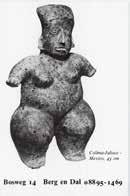
She was 82 when she gave an impres sively personal interview in 2014: about her story, her experiences and insights, about her extraordinarily large private Yoruba collection; but also about her view of the art market at the time.
Ursula Heijs-Voorhuis - she seems to have lost none of her energy and enthusiasm as a passionate collector. The fact that she is one of the first, maybe even the first gallery owner in the Netherlands to open her own gallery for non-European art in a male-dominated tribal art market in the early 1970s does not seem worth mentioning. Her eventful and ful filling life as a collector and gallery owner is much more important to her.
All ihre in 60 Jahren unter teilweise abenteuerlichen Umständen zusam mengetragene Yoruba-Sammlung umfasste zuletzt mehr als 4.500 Werke eines insgesamt zigtausende zählenden Nachlasses, und dürfte somit einzigartig und unvergleich bar gewesen sein. Dessen sind sich die Museen in Europa, Sammler und Händler bewusst. Überzeugt vom Konzept des modernisierten Stadt museums in Zory (Polen), das nach seinem Neustart 2013/2014 bereits für den European Museum of the Year Award (EMYA) des Jahres 2020 nominiert war, und auf Initiative ihres guten Freundes und Afrika sammlers Gustav Wilhelms, soll ein Teil ihres Nachlasses nun dort gezeigt werden. Ursula Heijs-Voor huis verstarb 2021 in St. Agatha, wo sie zuletzt wohnte – kurz nach ihrem 89. Geburtstag.
„You can do it!“ - Because friends and confidants encouraged her to open a gallery after all, she decided – some what hesitantly at first – to take this step. Without much prior knowledge “I didn‘t know anything! I was kind of innocent about the value of works. I didn‘t know the trade and I didn‘t know how to bargain and negotiate. But I could and wanted to learn!”
And she did. She was supported by her family and the promise of the University of Nijmegen, where she was one of the few women to study sociology in the 1950s, to continue teaching students and high school students there – just in case….
Decades later, she looks back with satisfaction and rightly so: “I didn‘t go bankrupt. I didn‘t get rich ei ther. But I got to know many, many people and had them visit me. And I‘ve learned a lot. And – I‘m still learning every day!”. She enjoys
„Man muss schon verrückt sein, so viel afrikanische Kunst zu sammeln“
[Ursula Heijs-Voorhuis]
her open house, almost impercep tibly overflowing with art, a house she built with great effort after her time abroad after the death of her husband (1978) and after her return home (1983). An open house in Berg en Dal, where everyone likes to come, where adults bring art closer to their children and grandchildren, including numerous works that she had sold and bought back with great difficulty after her return.
Learning throughout her life, was her mantra – by listening and “asking a lot, an awful lot of questions”, as she likes to emphasize again and again.
As a young girl, she found access to art and folk art through her father, himself an antique collector. „From him I learned to see art and to rec ognize the differences between real and fake.“
However, the Africa Museum in Berg en Dal (opened in 1954), which at that time was still being run by the missionaries of the Congregation of the Holy Spirit, laid the foundation and initial experience for her gallery business, and for which she worked for three or four years - willingly subordinate tasks took over but she was also allowed to participate in exhibition preparations. „I definitely wanted to work there, at any price, even for free, because everything I was able to learn there was pay enough for me.“
By then she had already acquired her first Africa exhibits, ethnographi ca objects; she keeps her first in her collection: a container from the Kuba, Congo, completely overpriced “bought stupidly”, as she puts it with a light humour in retrospect.
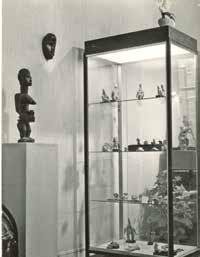
From many conversations with the fathers who had worked in Afri ca, she learned a lot about the liv ing environment, the works of art, their origin and their use, learned to identify the works and to judge their qualities.
The focus of her gallery at Smidstraat 7 in Nijmegen (later then in Berg en Dal, Bosweg 14) was on works from Nigeria, which she obtained through German collections and dealers from Africa, “Nigeria, because at that time, on the international art market, it hadn’t really much status, it was considered more a folk art, and was affordable for me, especially in the beginning“.

She developed a very special rela tionship with the works of the Yoru ba: the diversity of the most diverse styles that had developed in the dif ferent kingdoms, the mutual artistic influence, and the so openly visible cult use, especially with the Ibeji twin figures, all of this culminated into what she calls an “emotional connection” to these works.
She was in close contact with Hans A. Witte (1928-2006), alongside Wil liam Fagg the recognized expert on Yoruba societies, lecturer in West
African religions and iconography at the University of Groningen, ex plorer and curator of the Africa Mu seum in Berg en Dal. He specialized in Yoruba culture and often visited in her gallery. He was interested in her ibeji twin figures, of which she had now collected more than the Afrika Museum in Berg en Dal owned. Together they identified the collected twin figures by origin, area, workshop or woodcarver. Through stylistic comparisons, it was possible – especially among the Yoruba – to remove a large number of carvers from anonymity. Both were working on a joint publication of their Yoruba private collection when Hans Witte died; the works are nevertheless well documented in the AHDRC (African Heritage & Documentation Research Centre) under the Hans Witte files, as is the present offer, which can be described as the essence of their Yoruba collection.
„One must be crazy to collect so much African art“
[Ursula Heijs-Voorhuis]Photos: Private Archive
All of her Yoruba collection, which was assembled over a period of 60 years under sometimes adventurous circumstances, most recently com prised more than 4,500 works from a legacy totaling tens of thousands, and must therefore have been unique and incomparable. Museums in Eu rope, collectors and dealers are aware of this. Convinced by the concept of the modernized city museum in Zory (Poland), which after its restart in 2013/2014 was already nominated for the European Museum of the Year Award (EMYA) in 2020, and on the initiative of her good friend and Africa collector Gustav Wilhelms, a part of her estate can now be shown there. Ursula Heijs-Voorhuis passed away in 2021, shortly after her 89th birthday.
Quelle / Source: Interview U. Heijs.-Voorhuis (geführt und aufgezeichnet / conducted and recorded by Zbigniew Szendera, 2014) (https://vimeo.com/118421341)
2000 Tussen hemel en aarde, leven met de doden in Afrika, Van Reekmuseum Apeldoorn (NL), Kurator / curated by Frits Bless.
2001 Wereld in beweging, Af rikamuseum, Berg en Dal (NL), Kurator/ curated by Hans Witte
2002 Beelden aan Zee, Scheve ningen (NL), Kurator / curated by Erik Vos
2012 Gelede Masks, TOPIC Mu seum, Tolosa (ES), Kurator / curated by Damiet van Dalsum
79 Glocke „okpogo ilo“ („Igala bell“) Kupferlegierung (Bronze, Messing), Diese Glocken werden vor allem mit dem Königreich Igala in Ver bindung gebracht.
Sie wurden an Ahnenschreinen hochrangiger Clanchefs aufbe wahrt, wo sie dazu verwendet wurden die Ahnen zu „rufen“ und ihre Hilfe zu erbitten. Noch heute finden sich im Schatz des Königs („Ata“) von Idah ähnliche Glocken.
Bell „okpogo ilo“ („Igala bell“) copper alloy (bronze, brass), These bells are mainly associated with the Igala Kingdom.
They were kept in ancestor shrines belonging to titled clan leaders, whe re they could be used to „call“ the ancestors and petition their aid. Even today, similar bells can be found in the treasure of the Ata (king) of Idah.

H: 22 cm
Ursula Heijs-Voorhuis, Sint Agatha, The Netherlands
Vgl. Lit.: Berns, Marla C. et. al., Arts of the Benue River Valley, Los Angeles 2011, p. 202 ff. € 800 - 1.500
80 Kopfglocke mit Krone Kuperlegierung (Bronze, Messing)
Da ein Exemplar dieser Kopfglocke mit Krone 1905 am Forcados River ge funden wurde, wird der Typus oftmals als „Forcados-Glocke“ bezeichnet. Nach Peek (2021, p. 142) waren ähnli
che Glocken jedoch auch im südlichen Nigeria weit verbreitet. Die kronenför mige Kopfbedeckung läßt sowohl an Yoruba Könige, als auch an Priester der Igbo und Isoko denken.
Auch wenn man ihre genaue Herkunft und Bedeutung nicht kennt, so war diese Glockenform doch so beliebt,
dass sie im späten 19. Jahrhundert nach Gußformen im Vereinigten Kö nigreich hergestellt und im Nigerdelta gehandelt wurde. Diese Glocken, die sogenannten „Brimingham bells“ sind jedoch an einer Naht zu erkennen, an der beide Hälften zusammengefügt wurden und die bei vorliegendem Objekt nicht vorliegt.
Crown bell head copper alloy (bronze, brass) Since a specimen of this crown bell head was found on the Forcados River in 1905, the type is often referred to as the „Forcados bell.“
According to Peek (2021, p. 142), how ever, similar bells were also wides pread in southern Nigeria. The crownshaped headgear suggests Yoruba kings as well as Igbo and Isoko priests. Although their exact origin and me aning are not known, this bell shape was so popular that in the late 19th century they were made from molds in the United Kingdom and traded in the Niger Delta. However, these bells, the so-called „Brimingham bells“ can be recognized by a seam, where the two halves have been attached and which is not present at this object.

H: 16 cm
Ursula Heijs-Voorhuis, Sint Agatha, The Netherlands
Vgl. Lit.: Peek, Philip M., The Lower Ni ger Bronzes, New York, London 2021, p. 141 ff.
€ 500 - 1.000
NIGERIA / REPUBLIC OF BENIN (EX DAHOMEY)
81 Kniendes weibliches Figuren paar, vor 1920 Holz, Farbpigmente
Eigentümliche Darstellung zweier weiblicher Figuren, die jeweils durch einen gewaltigen Kropf („struma“) verunstaltet sind.
Vermutlich handelt es sich um Arbei ten, die bereits für den Verkauf an ein westliches Publikum gemacht wur den („transitionale Kunst“).
Kneeling female pair of figures, before 1920 wood, colour pigments

Peculiar depiction of two female figu res, each disfigured by a huge goiter („struma“).
Presumably, these are works that have already been made for sale to a Western audience („transitional art“).
H: 29,5 cm
Ursula Heijs-Voorhuis, Sint Agatha, The Netherlands
500 - 1.000
Schreinfigur Maternité
Farbpigmente,
Shrine figure maternité

Heijs-Voorhuis,
83 Kniende weibliche Figur mit Schale „olumeye“
Holz, Pigmentreste, Glasperlen, Me tall, altes Sammlungsetikett „Joruba 2-012-045“, Bruchstelle
Kniende weibliche Figuren mit Scha le finden sich vor allem im Ekiti- und Igbomina-Gebiet. Sie werden „olu meye“ genannt, was so viel bedeu tet wie „eine, die Ehre und Respekt bringt/ kennt“.
Als Anbietschale für Kolanüsse und anderer Köstlichkeiten zierten sie die Empfangshallen vieler Könige. Sie wurden manchmal auch als Behälter für Opfergaben an Yoruba-Gottheiten verwendet und sollen bisweilen als Ersatz für „agere ifa“ - Schalen, zur Aufbewahrung der heiligen Palmnüs se für das „ifa“-Orakel, gedient haben
Kneeling female figure with bowl „olumeye“ wood, pigment remains, glass beads, metal, old collection label „Joruba 2-012-045“, breakage Kneeling female figures with bowl are found mainly in the Ekiti and Igbomi na area. They are called „olumeye“, which means „one who brings/ knows honor and respect“.

As offering bowls for kola nuts and other delicacies, they adorned the re ception halls of many kings.They were also sometimes used as containers for offerings to Yoruba deities and are sometimes said to have served
as substitutes for „agere ifa“ bowls to hold the sacred palm nuts for the „ifa“ oracle.
H: 37,5 cm
Possibly Loed van Bussel (1935-2018), The Hague, The Netherlands
Cornelis Pieter Meulendijk (1912-1979), Rotterdam, The Netherlands
Ursula Heijs-Voorhuis, Sint Agatha, The Netherlands
AHDRC: 0109409
€ 900 - 1.800
84 Figuraler Hauspfosten „opo ile“ Holz, rotes Pigment, Bruch- / Repara turstelle, Sockel
Yoruba-Paläste enthalten zahlreiche Innenhöfe, die jeweils für bestimmte religiöse oder gesellschaftliche Hof zeremonien genutzt werden. Traditio nell haben sie überhängende Dächer, die von Pfosten getragen werden und Regenwasser in ein zentrales Becken ableiten.
Die Pfosten sind reich mit Skulptu ren beschnitzt, wobei bestimmte Themen immer wiederkehren, insbe sondere der Krieger mit Pferd oder die Mutter, die ihr Kind stillt.
In diesem Falle ist eine große Figur dargestellt, deren Körper von einer Schlange umwunden ist, eine zweite lagert auf dem Kopf der Figur.
Die Schlange symbolisiert „oshuma re“, der bei den Yoruba als „orisha“ (Gottheit) des Regenbogens gilt. „Os humare“ beherrscht die Jahreszeiten, den Regen und die Trockenheit, und ist für Hunger und Wohlstand zustän dig. Er gilt auch als Bote / Diener des Donnergottes „shango“.
Figural house post „opo ile“ wood, red pigment, breakage / place of repair, base Yoruba palaces contain numerous courtyards, each of which are used for certain religious or social court ceremonies. Traditionally they have overhanging roofs which are suppor ted by pillars and discharge rainwater into a central basin.
The posts are richly carved with sculp tures, in which certain themes cons tantly recur - especially the warrior on horseback and the mother breastfeeding her baby.
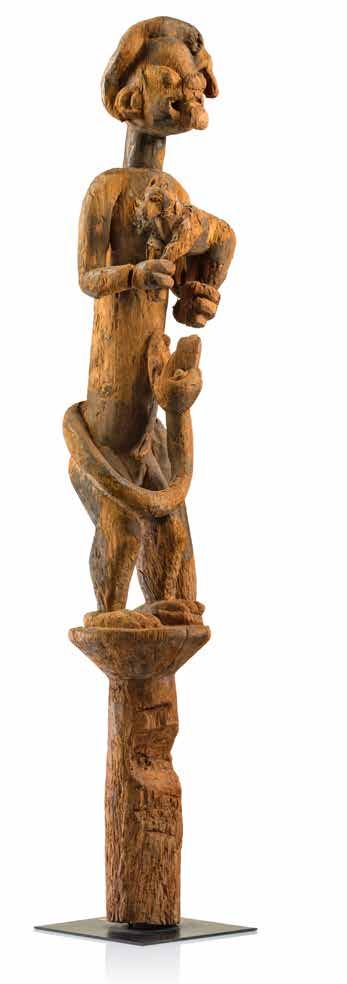
In this case, a large figure is depicted with a snake entwined around its body and a second one resting on the figure‘s head.
The snake symbolizes „oshumare“, who is considered by the Yoruba as the „orisha“ (deity) of the rainbow.
„Oshumare“ rules the seasons, rain and drought, and is responsible for hunger and prosperity. He is also con sidered a messenger / servant of the thunder god „shango“.
85 Ungewöhnlicher masken hafter Kopfaufsatz
Holz, mit Öl oder Wachs behandelte Oberfläche
Unusual mask-like headdress wood, surface treated with oil or wax H: 45 cm
Ursula Heijs-Voorhuis, Sint Agatha, The Netherlands
Vgl. Lit.: Drewal, Henry John, African Artistry, Atlanta 1980, p. 86, ill. 152 € 450 - 900

Holz, Farbpigmente, alte Reparaturstelle Faszinierendes Objekt mit ausgrei fendem Kopfputz. Zu dem figuralen Aufbau bemerkte Hans Witte: „der Aufbau scheint an die Krönung eines englischen Königs zu erinnern. Die von heraldischen Leoparden gehal tene Krone imitiert ein europäisches Wappen“.
Meko (Imeko), eine kleine Stadt in Ni geria nahe der Grenze zu Benin, war ein wichtiges Zentrum der Holzschnit zerei. Zu den bekanntesten Meistern von Meko gehören der berühmte Duga (ca. 1880-1960) und sein Rivale Mosudi Olatunji. Ein weiterer bekann ter Bildhauer aus Meko ist Samuel La roye, dem der vorliegende Kopfaufsatz zugeschrieben werden kann. Ein wei teres Werk des Künstlers publiziert bei Lawal,1996, S. 277, ill. 8.5.
Headdress „gelede“ wood, colour pigments, old place of repair
Fascinating object with sweeping headdress. Regarding the figural su perstructure, Hans Witte remarked: „the superstructure seems to com memorate the coronation of an Eng
lish king. The crown held by heraldic leopards imitates a european coat of arms“.
Meko (Imeko), a small town in Nigeria near the border with Benin, was an important center of woodcarving.
Among the best known masters of Meko are the famous Duga (ca. 18801960) and his rival Mosudi Olatunji. Another well-known sculptor from Meko is Samuel Laroye, to whom the present headdress can be attributed. Another work by the artist published in Lawal,1996, p. 277, ill. 8.5.

Ursula Heijs-Voorhuis, Sint Agatha, The Netherlands
AHDRC: 0110384 H: 46 cm
Vgl. Lit.: Lawal, Babatunde, The Gè lèdé Spectacle, Seattle, London 1996, p. 277, ill. 8.5
600 - 1.200


87 Kopfaufsatz „gelede“ mit Hahn und drei Schlangen Holz, Pigmentreste, Für einen weiteren, dem berühmten Meko-Schnitzer Mosudi Olatunji zu geschriebenen „gelede“- Kopfaufsatz, siehe Lawal, 1996, pl. 19.
Headdress „gelede“ with cock and three snakes wood, pigment remains, For another „gelede“ headdress attri buted to the famous Meko carver Mo sudi Olatunji see Lawal, 1996, pl. 19. H: 36 cm
Ursula Heijs-Voorhuis, Sint Aga tha, The Netherlands
AHDRC: 0110165
Vgl. Lit.: Lawal, Babatunde, The Gèlèdé Spectacle, Seattle, Lon don 1996, pl. 19
450 - 900
88 Kopfaufsatz „gelede“
Holz, Fehlstellen, Sockel
Dieser Aufsatz ist von einer besonders dicken Schicht Opfermasse überzo gen. Es sind Federn, vegetabile Be standteile und Spuren von Flüssig keiten erkennbar.
Schlangen spielen in der Ikonogra phie der Yoruba eine große Rolle. Sie stehen in Zusammenhang mit über natürlichen Mächten, wie „shango“, dem Donnergott oder „ogun“, dem Gott des Krieges.
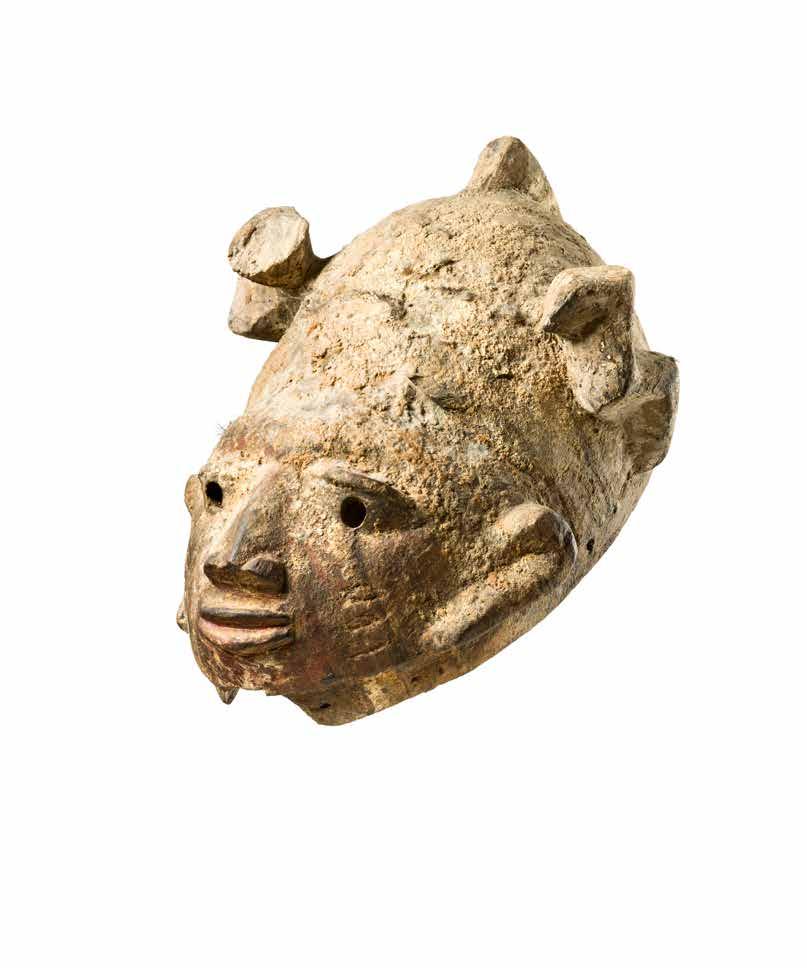
Headdress „gelede“ wood, missing parts, base
This headdress is covered by a parti cularly thick layer of sacrificial mass. Feathers, vegetal components and traces of liquids are visible.
Snakes play a major role in Yoruba ico nography. They are associated with supernatural powers, such as „shan go,“ the god of thunder, or „ogun,“ the god of iron and war.
H: 34 cm
Ursula Heijs-Voorhuis, Sint Agatha, The Netherlands
Vgl. Lit.: Lawal, Babatunde, The Gè lèdé Spectacle, Seattle, London 1996, p. 136, pl. 21
€ 450 - 900
89 Kopfaufsatz „egungung“ Holz, Nägel, rest. Beispiel für den Variantenreichtum der „egungun“- Masken. Eine große scheibenförmige Basis, beschnitzt mit zwei Menschen- und zwei Affenköp fen, dazwischen geheimnisvolle, tlw. separat gearbeitete, beulenförmige Ausbuchtungen, die besonders dick mit krustierter Opferpatina überzo gen sind.
Headdress „egungun“ wood, nails, rest.
Example for the rich variety of „egun gun“ masks. A large disc-shaped base carved with two human and two monkey heads with mysterious bul ges inbetween, which are particularly thickly covered with encrusted sacri ficial patina.

L: 60 cm; B: 55 cm
Gerbrand Luttik, Soest, The Nether lands (before 1997)
Ursula Heijs-Voorhuis, Sint Agatha, The Netherlands
AHDRC: 0109761
€ 1.500 - 3.000
Dieser Maskentypus mit großen Ohren und der Darstellung eines Hasen am Hinterkopf ist bei den Yoruba als „egungun eleti“ oder „egungun, der Ohren hat“ bekannt. Die Maskenfigur in ihrer Gesamt heit, mit Federschmuck und Kos tüm, wird „egungun erin“ („Elefant“) genannt.
Diese Bezeichnung soll sich von der großen Macht der Maskengestalt ableiten, Wünsche von Bittstellern zu erfüllen oder Unrecht zu bestra fen, als auch von ihrem groß und üppig angelegten Erscheinungsibld und nicht zuletzt von den hohen Kosten für ihren Unterhalt.
This mask type with large ears and the representation of a hare at the back of the head is known among the Yoruba as „egungun eleti“ or „egungun who has ears“. However, the mask figure in its entirety, with feather adornment and costume, is called „egungun erin“ („elephant“). This name is said to derive from the great power of the masked figure to fulfill the wishes of supplicants or to punish injustice, as well as from her large and lavish appearance, and not least from the high costs to maintain them.

90 Kopfaufsatz „egungun eleti“ Holz, Farbpigmente
Headdress „egungun eleti“ wood, colour pigments
H: 29,5 cm
Ursula Heijs-Voorhuis, Sint Agatha, The Netherlands
Vgl. Lit.: Drewal, Henry John, African Artistry, Atlanta 1980, p. 80, Fig. 6
€ 450 - 900

NIGERIA, YORUBA, EGBADO, AKINOLA FROM JOGA ORILE
Holz, indigoblaues Pigment, Stoffe divers
Aufgrund neuerer Forschungen schrieb Witte diesen Kopfaufsatz dem Egbado Künstler Akinola von Joga Orile zu.
Im Vergleich mit anderen Werken Aki nolas zeigen sich grosse Übereinstim mungen bezüglich der Physiognomie, von der Gestaltung der Augen, bis hin zu Nase und Mund mit markanten Lippenkerben, als auch bezüglich von Skarifikationen und Frisur (vgl. AHDRC 0109810 / 0106525).
Die „egungun“- Gesellschaft reguliert die Beziehungen zwischen den Ahnen und den Lebenden. In Krisenzeiten, etwa nach einem Todesfall oder bei Totengedenkfeiern, finden Auftritte einzelner „egungun“- Maskengestal ten statt.
Im Rahmen des mehrwöchigen „odun egungun“- Festes, das jährlich oder alle zwei Jahre zu Ehren der Ahnen stattfindet, erscheint ein grosses Aufgebot an „egungun“- Masken. Sie gehören den verschiedenen Verwand
schaftsverbänden und repräsentieren deren Vorfahren. Sie sind sehr varian tenreich gestaltet und werden stets durch besonders üppige und auf wändige Stoffkostüme ergänzt. Ihre Macht wird durch Medizinen „oogun“ noch gesteigert, die am Kostüm an gebracht sind.
Headdress „egungun“ wood, indigo blue pigment, diverse fabrics
Based on recent research, Witte attri buted this headdress to the Egbado artist Akinola of Joga Orile.
Comparisons with other works by Aki nola reveal great similarities in terms of physiognomy, from the design of the eyes to the nose and mouth with prominent lip notches, as well as in terms of scarification and hairstyle (cf. AHDRC 0109810 / 0106525).
The „egungun“ society regulates the relations between the ancestors and the living. In times of crisis, for examp le after a death or at memorial servi ces for the dead, individual „egungun“ mask figures appear.
During the „odun egungun“ festival, which takes place every year or every two years in honour of the ancestors, a large number of „egungun“ masks appear. They belong to different kin ship associations and represent their ancestors. They are varied in design and are always complemented by particularly lavish and elaborate cloth costumes. Their power is further in creased by medicines „oogun“ at tached to the costume.
H: 37 cm
Ursula Heijs-Voorhuis, Sint Agatha, The Netherlands
AHDRC: 0109868
Vgl. Lit.: Eisenhofer, Stefan (Hg.), Kulte, Künstler, Könige in Afrika, Linz 1997, p. 266 € 800 - 1.500
 NIGERIA, YORUBA, ONIYIDE ADUGBOLOGE OF ABEOKUTA
NIGERIA, YORUBA, ONIYIDE ADUGBOLOGE OF ABEOKUTA
92 Figuraler Aufbau mit Reiterfigur und Begleitfiguren Holz, polychrome Farben, Hut separat gearbeitet, rest.
Dieser prachtvolle Figurenaufsatz be fand sich seit den 1970er Jahren im Besitz von Ursula Voorhuis.
Zentrales Motiv ist eine Reiterfigur mit Hut und Lanze. Damit könnte es sich um den Aufsatz einer „epa“- Mas ke handeln, die den Krieger „jagunjagun“ zeigt, der auch als berittener Jäger und / oder König dargestellt wird. Die Gruppe erhebt sich auf einer scheibenförmigen Basis. Eine ursprüngliche Befestigung auf dem für „epa“- Masken typischen helmför migen Unterbau („ikoko“) ist durchaus denkbar.
Ursula Heijs-Voorhuis, Sint Agatha, The Netherlands (since the 1970s)
Der Figurenaufsatz kann stilistisch dem Meisterschnitzer Oniyide (ca.1875 - ca.1947) aus der berühm ten Bildhauerfamilie Adugbologe aus Abeokuta zugeschrieben werden.
Als Beleg kann eine Figurengruppe dienen, die Hans Witte als Arbeit Oniyides einordnete (vgl. Witte, 2004, S. 68). Die Physiognomien zei gen größte Übereinstimmungen,
von der Behandlung von Augen, Nase, Mund und Ohren bis hin zu Gesichtsskarifikationen und Körperformen.
This figural object can be stylisti cally attributed to the master carv er Oniyide (ca.1875 - ca.1947) from the famous sculptor family Adug bologe of Abeokuta. A group of figures, which Hans Witte classified as Oniyide‘s work, can serve as proof (cf. Witte, 2004, p. 68). The physiognomies show greatest similarities, from the treat ment of eyes, nose, mouth and ears to facial scarification and body shapes.

Figural structure with equestrian figure and accompanying figures wood, polychrome paint, hat worked separately, rest.
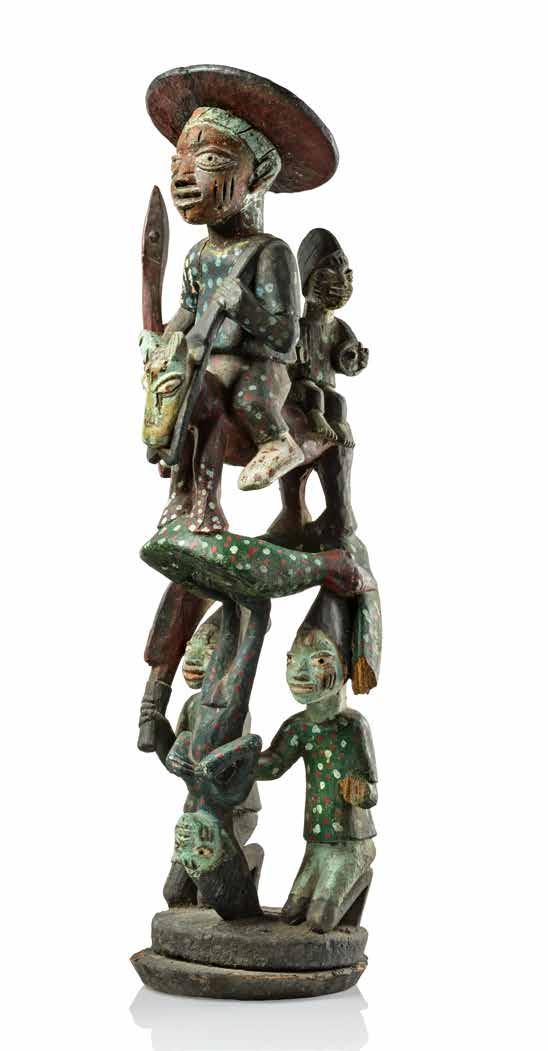
This magnificent figural object has been in the possession of Ursula Voor huis since the 1970s.
The central motif is an equestrian figure with hat and lance. Thus, it could be the top of an „epa“ mask representing the warrior „jagun-jagun“, who is also depic ted as a mounted hunter and / or king.
The group rises from a disc-shaped base. An original attachment on a helmetshaped base „ikoko“, typical for „epa“ masks, is quite conceivable.
103 cm
Vgl. Lit.: Witte, Hans, A Closer Look, Berg en Dal 2004, p. 68 f.
Es wird angenommen, dass diese Mas ketten an die Kleidung von Würdenträ gern angenäht wurden Vergleichbare Stücke wurden außerdem an einer „bata“- Trommel für den „shango“- Kult entdeckt (Thompson, 1971, Ch 1, Ill. 18).
It is assumed that these maskettes were sewn onto the clothing of digni taries. Comparable pieces have also been discovered on a „bata“ drum for the „shango“ cult (Thompson, 1971, Ch 1, Ill. 18).
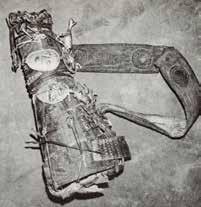
93 Anthropomorphe Maskette Gelbguss
Anthropomorphic maskette brass H: 9 cm

Provenance Ursula Heijs-Voorhuis, Sint Agatha, The Netherlands
AHDRC: 0169586
Vgl. Lit.: Thompson, Robert Farris, Black Gods and Kings, Los Angeles 1971, Ch 1, Ill. 18 € 300 - 600
NIGERIA, YORUBA, IGBOMINA, ILA ORANGUN, WORKSHOP OF THE „MASTER OF THE SMILING FACE“ („MASTER OF THE ARCHAIC SMILE“)
94 Schreinfigur Holz Shrine figure wood H: 29 cm
Provenance Ursula Heijs-Voorhuis, Sint Agatha, The Netherlands € 300 - 600

95 „Shango“- Schrein Figur mit „bata“ - Trommel Holz, Farbe, Pigmente, rest. Vermutlich gehört diese Figur in den Kontext des „shango“- Kultes und stellt den Spieler einer „bata“- Trommel dar. Diese Trommeln waren beidseitig be spielbar und wurden daher laut Pem berton meist quer vor dem Körper getragen.
wood, colour, pigments, rest. Presumably, this figure belongs to the context of the „shango“ cult and re presents the player of a „bata“ drum. These drums could be played on both sides and were therefore, according to Pemberton, usually worn crosswise in front of the body.

H: 65,5 cm
Guy van Rijn, Brussels, Belgium
Gerbrand Luttik, Soest, The Netherlands
Paul Beelen (1943-1994), The Hague, The Netherlands
Ursula Heijs-Voorhuis, Sint Agatha, The Netherlands
AHDRC: 0109052
€ 1.000 - 2.000
Diese Figur besticht durch ihr wunder schönes Gesicht. Seine volle Schönheit entfaltet der Kopf vor allem im Profil betrachtet, in Zusammenwirken mit der weit nach hinten ausladenden Frisur.
Auch Ursula Voorhuis berührte die Schönheit dieser Figur in besonderem Maße, sie war ihr erklärtes Lieblingsstück.

wood, pigment residues, missing parts, insect caused damage
This figure captivates with its beau tiful face with pleasing round shapes and large eyes. The head unfolds its full beauty especially when viewed in profile, in conjunction with the hairdo that sweeps far back.
Ursula Voorhuis was also particularly touched by the beauty of this figure, it was her declared favorite.
Possibly from an American Museum Collection
Ursula Heijs-Voorhuis, Sint Agatha, The Netherlands
AHDRC: 0169593
500 -
97 Kniende weibliche Schrein figur mit zwei Begleitfiguren Holz, Farbpigmente Wohl ein Werk des Schnitzers Agbonbiofe (gest. ca.1945) von Efon-Alaye (Adesina Werkstatt).

Diese prachtvolle Figur zeigt ei nen besonders schönen Kopf mit edlen Gesichtszügen, der auf ei nem auffallend massiven Körper mit akzentuierten Brüsten sitzt.
Bei der männlichen Begleitfigur handelt es sich um eine Darstel lung „eshus“.
69 cm
NIGERIA, YORUBA, EKITI, PROBABLY AGBONBIOFE OF EFON-ALAYE
Kneeling female shrine figure with two accompanying figures wood, colour pigments Probably a work of the carver Agbonbiofe (deceased ca.1945) of Efon-Alaye (Adesina workshop). This magnificent figure shows a particularly beautiful head with noble facial features rising from a strikingly massive body with ac centuated breasts. The male com panion figure represents „eshu“.

Ursula Heijs-Voorhuis, Sint Aga tha, The Netherlands € 2.500 - 5.000
NIGERIA, YORUBA, EGBADO, IMALA
98 Stehende weibliche Figur Holz, Pigmente, Kokoscheibchen, rest., Sockel
Standing female figure wood, pigments, coconut discs, rest., base
H: 31 cm
Ursula Heijs-Voorhuis, Sint Agatha, The Netherlands
€ 450 - 900
NIGERIA, YORUBA, NORTHERN EKITI, BAMGBOYE OF ODO OWA
99 Figur „eshu“
Holz
Ein Werk des Meisterschnitzers Bamgboye (ca. 1885-1978) aus Odo Owa, wo er das Amt des obersten Ifa-Priesters bekleidete. Für andere Arbeiten Bamgboyes siehe AHDRC 0101614 und 0101648.
Im Pantheon der Yoruba stellt „eshu“ eine der angesehensten Gottheiten („orisha“) dar. Er gilt als Mittler zwischen den Menschen und den Göttern.
Lot 98
„Eshu“ ist ein widersprüchlicher Cha rakter, der gut und böse, vertrauens voll und schelmisch sein kann. Er kann Glück und Wohlstand schenken aber auch Elend und Leid herbeiführen.
H: 22 cm
A work of the master carver Bamgboye (ca. 1885-1978) from Odo Owa, where he held the office of the chief Ifa priest. For other works of Bamgboye see AH DRC 0101614 and 0101648.

In the Yoruba pantheon, „eshu“ re presents one of the most respected deities („orisha“). He is considered to be a mediator between the people and the gods
„Eshu“ is a trickster phenomenon able to be good and bad, trustful and mi schievous. He can bestow prosperity or cause misery.
Ursula Heijs-Voorhuis, Sint Agatha, The Netherlands
Vgl. Lit.: Fagg, William, Yoruba, Sculp ture of West Africa, New York 1982, p.21 ff.
€ 400 - 800
100 Handgelenkschmuck „ogo elegba“ für den „eshu“- Kult Holz, Tierhaut, Kaurischnecken, zwei Münzen
Die Anhänger „eshus“ sammelten Münzen und tanzten mit diesen klei nen Statuetten, die mit einem Leder band am Handgelenk befestigt waren.
Wrist pendant „ogo elegba“ for the „eshu“ cult wood, animal skin, cowries, two coins, Worshippers of „eshu“ collect coins, dancing with these small statuettes attached to their wrist by a leather thong. H: 9,5 cm


Ursula Heijs-Voorhuis, Sint Agatha, The Netherlands
Vgl. Lit.: Witte, Hans, Ifa and Esu, Soest-Holland 1984, p. 107, pl. 72 € 450 - 900
Der Ifa Priester und Meisterschnitzer Bamgboye, Chief Alage of Oda-Owa, im Jahr 1950

The Ifa priest and master carver
Bamgboye, Chief Alage of Oda-Owa, in 1950
Photo: William Fagg,101 Kniende Schreinfigur „onile“ Kupferlegierung (Bronze, Messing), Patina
„Onile“ - Figuren symbolisieren die ursprünglichen Gründer der Ge meinschaft. Sie sind Eigentum der „ogboni“- Gesellschaft und werden im Allerheiligsten des „ogboni“Hauses aufbewahrt.
Drewal berichtet, dass aufwendige Rituale durchgeführt werden, um ihnen spirituelle Kraft zu verleihen. Die „onile“ werden mit so starken Substanzen präpariert, dass man bei ihrem Anblick Blindheit oder sogar den Tod riskiert.
H: 21,4 cm
Kneeling shrine figure „onile“ copper alloy (bronze, brass), patina Figures „onile“ symbolize the ori ginal founders of the community. They are owned by the the „ogbo ni“ society and are kept in the inner sanctum of the „ogboni“ house. Drewal reports that elaborate rites are conducted to infuse spiritual power into them. The „onile“ is pre pared with such powerful substan ces that to see it is to risk blindness or even death.

Provenance Ursula Heijs-Voorhuis, Sint Agatha, The Netherlands
450 - 900
NIGERIA, YORUBA, AWORI, IGBESA
102 Weibliches Zwillingsfiguren paar „ere ibeji“ im KaurimuschelMantel Holz, Pigmente, Stoff, Kaurischnecken, rest.
Female pair of twin figures „ere ibeji“ in cowrie-shell coat wood, pigments, fabric, rest.

Ursula Heijs-Voorhuis, Sint Agatha, The Netherlands
H: 20,5 cm
Vgl. Lit.: Polo, Fausto, Enzyklopädie der Ibeji, 2008, ill. 243 ff. € 1.500 - 3.000
103 Männliches Zwillingsfiguren paar „ere ibeji“ Holz, Glasperlen, Metall
Ursula Heijs-Voorhuis, Sint Agatha, The Netherlands
H: 24 cm
Male pair of twin figures „ere ibeji“ wood, glass beads, metal

AHDRC: 0106328
Vgl. Lit.: Polo, Fausto, Enzyklopädie der Ibeji, 2008, cat. 209 € 800 - 1.600
104 Männliche Zwillingsfigur „ere ibeji“ Holz, geschwärzt, Kokosscheibchen
Male twin figure „ere ibeji“ wood, blackened, coconut discs
H: 21,5 cm
Ursula Heijs-Voorhuis, Sint Agatha, The Netherlands € 450 - 900
105 Weibliche Zwillingsfigur „ere ibeji“ Holz
Nach Hans Witte lassen die Position der Hände, die mit gestreckten Fin gern an die Oberschenkel gelegt sind und die Gesichtsskarifikationen an Wangen und Stirn auf eine Herkunft aus dem zentralen oder nordöstlichen Egbado-Gebiet schließen.
Female twin figure „ere ibeji“ wood
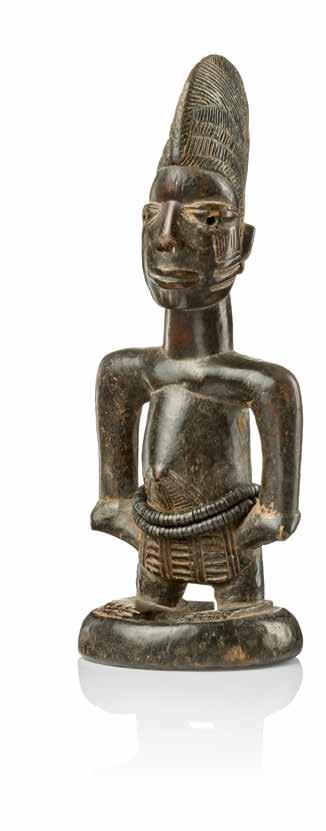

According to Hans Witte the position of the hands with four fingers tou ching the thighs and the face with scarifications on the cheeks and the forehead suggest a provenance from Central or Northeastern Egbado. H: 23 cm
Ursula Heijs-Voorhuis, Sint Agatha, The Netherlands
AHDRC: 0106333
Vgl. Lit.: Polo, Fausto, Enzyklopädie der Ibeji, 2008, cat. 170 € 450 - 900
NIGERIA, YORUBA, OYO, IFON
107 Männliche Zwillingsfigur
„ere ibeji“
Holz, Pigmente, Kokosscheibchen, Glasperlen, alte Reparaturstelle
Male twin figure „ere ibeji“ wood, pigments, coconut discs, glass beads, old place of repair

H: 26,5 cm
Ursula Heijs-Voorhuis, Sint Agatha, The Netherlands
Vgl. Lit.: Polo, Fausto, Enzyklopädie der Ibeji, 2008, ill. 406
€ 450 - 900
NIGERIA, YORUBA, OYO, IGBUKE WORKSHOP
108 Weibliche Zwillingsfigur
„ere ibeji“ Holz, Glasperlen
Female twin figure „ere ibeji“ wood, glass beads

H: 31 cm
Ursula Heijs-Voorhuis, Sint Agatha, The Netherlands
Vgl. Lit.: Polo, Fausto, Enzyklopädie der Ibeji, 2008, ill. 360 f.
€ 450 - 900
NIGERIA, YORUBA, OYO, IGBUKE WORKSHOP
109 Weibliche Zwillingsfigur
„ere ibeji“
Holz, Rotholzmehl, Glasperlen
Female twin figure „ere ibeji“ wood, camwood powder, glass beads
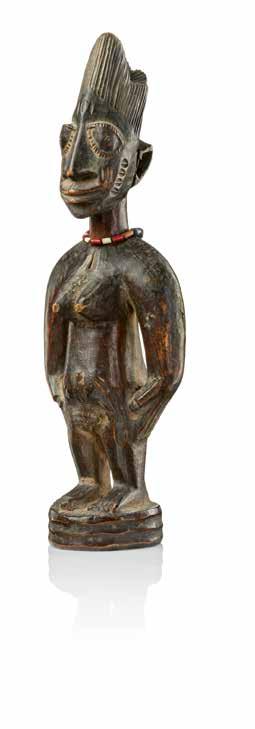
H: 30,5 cm
Ursula Heijs-Voorhuis, Sint Agatha, The Netherlands
Vgl. Lit.: Polo, Fausto, Enzyklopädie der Ibeji, 2008, ill. 362
€ 800 - 1.600
NIGERIA, YORUBA, IGBOMINA, ILA ORANGUN, WORKSHOP OF THE „MASTER OF THE SMILING FACE“ („MASTER OF THE ARCHAIC SMILE“)
106 Männliche Zwillingsfigur „ere ibeji“ Holz, Pigmente, Metall Schöne Figur mit ansprechenden Ge sichtszügen, die durch wiederholte Fütterungsprozeduren stark berieben sind.
Male twin figure „ere ibeji“ wood, pigments, metal Beautiful figure with attractive facial features, which are heavily rubbed due to repeated feeding procedures.

H: 28 cm
Ursula Heijs-Voorhuis, Sint Agatha, The Netherlands
Vgl. Lit.: Polo, Fausto, Enzyklopädie der Ibeji, 2008, ill. 559 f.
€ 1.500 - 3.500
NIGERIA, YORUBA, OYO, ILORIN
110 Männliche Zwillingsfigur „ere ibeji“
Holz, Kokosscheibchen, Pigmente, stark verkrustete Opferpatina
Male twin figure „ere ibeji“ wood, coconut discs, pigments, stron gly encrusted sacrificial patina



H: 26,5 cm
Ursula Heijs-Voorhuis, Sint Agatha, The Netherlands
Vgl. Lit.: Polo, Fausto, Enzyklopädie der Ibeji, 2008, ill. 519 f.
€ 500 - 1.000
111 Weibliches Zwillingsfiguren paar „ere ibeji“ Holz, Pigmente, Metall, Glasperlen, Kokosnußscheibchen
Female pair of twin figures „ere ibeji“ wood, pigments, metal, glass beads, coconut discs
H: 26 cm & 27 cm
Ursula Heijs-Voorhuis, Sint Agatha, The Netherlands
AHDRC: 0179711
Vgl. Lit.: Polo, Fausto, Enzyklopädie der Ibeji, 2008, ill. 469
€ 1.500 - 3.000
„ere ibeji“
Holz, Pigmente, Glasperlen Stoll vermutete bei einem sehr ähnli chen Figurenpaar eine Herkunft aus Kwara-State und ordnete sie dem „Meister der verdrehten Figuren“ zu (vgl. Stoll, 1980, p. 270, ill. 159).
Die neuere Forschung verortet ein stilistisch vergleichbares Figurenpaar zu den Oyo in der Region um Iseyin und verweist auf den Schnitzer Olu mole (vgl. Polo, 2008, ill. 419).
Female twin figure „ere ibeji“ wood, pigments, glass beads Stoll assumed a very similar pair of figures to originate from Kwara State and assigned them to the „Master of the twisted figures“ (cf. Stoll, 1980, p. 270, ill. 159).

More recent research locates a styli stically comparable pair of figures to the Oyo in the region around Iseyin and refers to the carver Olumole (cf. Polo, 2008, ill. 419).
H: 28 cm
Ursula Heijs-Voorhuis, Sint Agatha, The Netherlands
Vgl. Lit.: Stoll, Gert & Mareidi, Ibeji, Zwillingsfiguren der Yoruba, Mün chen 1980, p. 270, ill. 159
Polo, Fausto, Enzyklopädie der Ibeji, 2008, ill. 419
€ 450 - 900
„ere ibeji“
Holz, Pigmente, Glasperlen, Kokosscheibchen
Female twin figure „ere ibeji“ wood, pigments, glass beads, coco nut discs

Provenance Ursula Heijs-Voorhuis, Sint Agatha, The Netherlands
H: 24 cm
Vgl. Lit.: Polo, Fausto, Enzyklopädie der Ibeji, 2008, ill. 427
€ 450 - 900
Lot 114
NIGERIA, YORUBA, OWU, IBADAN
114 Weibliche Zwillingsfigur
„ere ibeji“ Holz, Pigmente, Glasperlen, Kokos scheibchen, Nägel
Female twin figure „ere ibeji“ wood, pigments, glass beads, coconut discs, nails

Ursula Heijs-Voorhuis, Sint Agatha, The Netherlands
H: 26 cm
Vgl. Lit.: Polo, Fausto, Enzyklopädie der Ibeji, 2008, ill. 296
€ 450 - 900
NIGERIA, YORUBA, EGBADO
115 Tanzstab „oshe shango“ mit Büffelkopf Holz, Sockel
Dance staff „oshe shango“ with buffalo head wood, base
H: 37 cm
Ursula Heijs-Voorhuis, Sint Agatha, The Netherlands
AHDRC: 0104892
€ 650 - 1.000

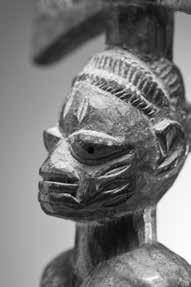

116 Janusköpfiger Tanzstab „oshe shango“ Holz, Sockel
Sehr schönes Objekt, dessen stark beriebene Oberfläche eine lange Nutzung im Kult belegt.
Janus-faced dance staff „oshe shango“ wood, base


Very nice object, whose heavily rub bed surface proves a long use in cult. H: 35 cm
Ursula Heijs-Voorhuis, Sint Agatha, The Netherlands
Vgl. Lit.: Richer, Xavier, Hélène Joubert, Dance with Shango, Paris 2018, p. 151 € 450 - 900
NIGERIA, YORUBA, OWU, IBADAN, AMOS LAFIA OF IDI ARO (BORN CA. 1892)
117 Tanzstab „oshe shango“ Holz, Insektenfraß, Sockel Zwei vergleichbare Stäbe, die 1912 von Frobenius gesammelt wurden, publiziert bei Krieger (Bd. I, 1978, Pl. 52 & 53 b).
Sie zeigen mit vorliegendem Stab Übereinstimmungen in formalem Aufbau, geometrischem Dekor und vor allem bei der Gestaltung der Köp fe (Physiognomie, Skarifikationen und Frisur).
Dieser Stil wurde von der frühen Forschung mit dem Ibadan Künstler Amos Lafia von Idi Aro (geb. ca.1892) in Verbindung gebracht.
Dance staff „oshe shango“ wood, insect caused damage, base Two comparable staffs collected by Frobenius in 1912, illustrated by Krieger (Vol. I, 1978, pl. 52 & 53 b).
Ein Werk desselben Künstlers A work of the same artist
They show similarities with the pre sent staff in formal structure, geome tric decoration and especially in the design of the heads (physiognomy, scarification and hairstyle).
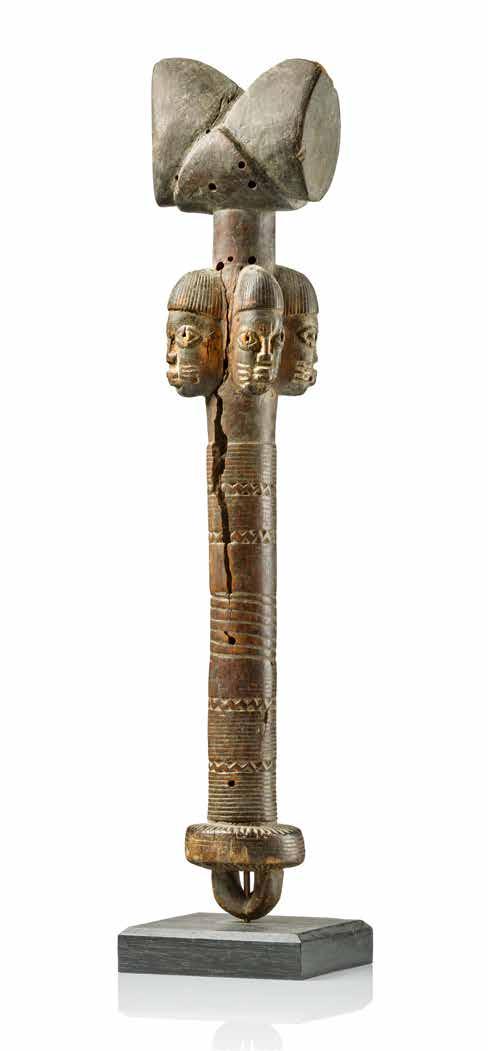
This style was associated by early re search with the Ibadan artist Amos Lafia of Idi Aro (b. ca.1892).

H: 39,5 cm
Ursula Heijs-Voorhuis, Sint Agatha, The Netherlands
Vgl. Lit.: Krieger, Kurt, Westafri kanische Plastik, Bd. I, Berlin 1978, plate 52 & 53 b
Drewal, Henry John, African Ar tistry, Atlanta 1980, p. 30 € 300 - 600
NIGERIA, YORUBA, OWU, IBADAN, AMOS LAFIA OF IDI ARO
118 Janusköpfiger Tanzstab
„oshe shango“ Holz, Sockel
Janus-faced dance staff „oshe shango“ wood, base
H: 52 cm
Ursula Heijs-Voorhuis, Sint Agatha, The Netherlands
Vgl. Lit.: Drewal, Henry John, African Artistry, Atlanta 1980, p. 30, ill. 15, 16 € 450 - 900


Lot 118
Ein Werk desselben Künstlers A work of the same artist
NIGERIA, YORUBA, NORTH EAST OF IBADAN
119 Janusköpfiger Tanzstab „oshe shango“
Holz, Sockel
Für formal und stilistisch vergleich bare Arbeiten desselben Künstlers / derselben Werkstatt siehe AHDRC 0104990 und AHDRC 0104994.
Janus-faced dance staff „oshe shango“ wood, base
For formally and stylistically com parable works by the same artist / workshop, see AHDRC 0104990 and AHDRC 0104994.
H: 36 cm
Ursula Heijs-Voorhuis, Sint Agatha, The Netherlands
€ 500 - 1.000
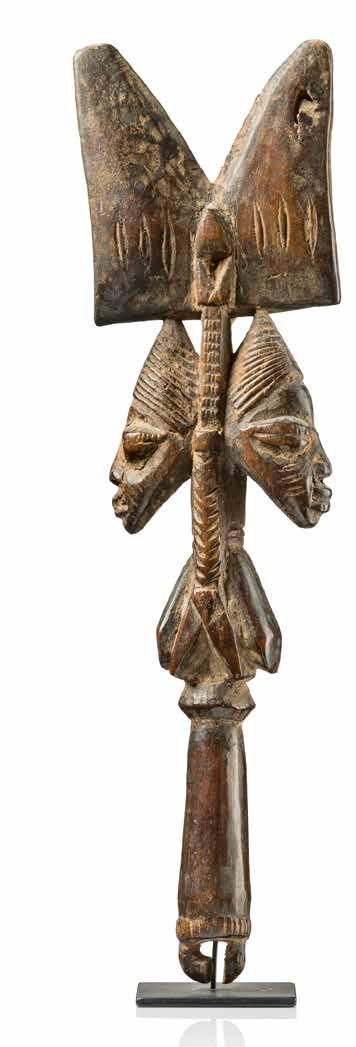



120 Tanzstab „oshe shango“ Holz, Pigmente, Sockel
In Zusammenarbeit mit William Fagg und anderen Gelehrten der YorubaKunst konnten Deborah & Jeffrey Stokes Hammer den Stil eines Künst lers identifizieren, der ihrer Meinung nach zu den besten Schnitzmeistern der afrikanischen Kunst gezählt wer den kann.
Nach einem ungewöhnlich konzipier ten „shango“ Stab, der auf einem Foto John Pictons von 1964 dokumentiert ist, das an einem Schrein in dem klei nen Igbomina Dorf Owu aufgenom men wurde, nannten sie den Schnitzer „Meister des Owu Shango Schreins“ (vgl. AHDRC 0105025) .
William Fagg vermutet, dass dieser Künstler zwischen ca. 1850 und ca. 1925 in der Igbomina-Yoruba-Region lebte.
Vorliegender Stab zeigt große Ge meinsamkeiten mit dem Stab aus Owu sowohl formal als auch stilis tisch, vor allem in der Physiognomie der Figuren mit den stark aufgewölb ten Augen. Die Doppelaxt zeigt eine ungewöhnliche Halbmondform und ist an beiden Enden mit Gesichtern beschnitzt. Sie wird von einem kni enden Figurenpaar bekrönt.
In der Zwischenzeit sind zahlreiche weitere Werke dieser Hand, vor allem „ibeji“-Figuren, aufgetaucht (vgl. Af rican Arts, 1986, XIX-2, S. 71).
Dance staff „oshe shango“ wood, pigments, base Working with William Fagg and other scholars of Yoruba art, Deborah & Jeffrey Stokes Hammer were able to identify the style of an artist who they believe can be counted among the finest carving masters in African art.
After an unusually conceived „shan go“ staff of excellent quality docu mented in a 1964 photograph by John Picton taken at a shrine in the small Igbomina village of Owu, they named the carver „Master of the Owu Shan go Shrine“ (cf. AHDRC 0105025).
William Fagg has speculated that this artist lived sometime in the 1850s to circa 1925 in the Igbomina Yoruba region.
The present staff shows great simila rities with the staff from Owu, both formally and stylistically, especially in the physiognomy of the figures with their strongly bulging eyes. The dou ble axe shows an unusual crescent shape and is carved with faces at both ends. It is crowned by a kneeling pair of figures.
In the meantime many other works by this hand, mainly „ibeji“ figures, have appeared (cf. African Arts,1986, XIX-2, p. 71).

H: 73 cm
Gerbrand Luttik, Soest, The Netherlands
Ursula Heijs-Voorhuis, Sint Agatha, The Netherlands
AHDRC: 0104697
Vgl. Lit.: African Arts, Vol.XIX, Nr.2, February 1986, p.70-73
2.500 - 5.000
A work of the same artist

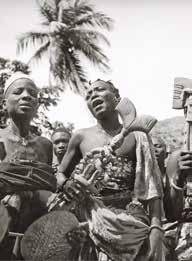
121 Tanzstab „oshe shango“, um 1850 / 60
Holz, Pigmente, stark verkrustete Opf erpatina, Fehlstellen, Sockel Meisterhaft ausgeführter Tanzstab mit stehender weiblicher Figur.
Sie ist reich geschmückt, trägt Gür tel und Halskette. Letztere mit zwei Amulettanhängern, von denen der im Rücken herabhängende originel lerweise ein Gesicht (möglicherweise „eshu“) zeigt. Sie ist von einer Schicht dick verkrusteter Opferpatina über zogen, was auf eine lange Nutzung im Kult hinweist. Ihre Frisur war vermutlich ursprünglich in einem geschwungenen Zopf nach hinten fortgesetzt. Sie trägt ein besonders massiv ausgebildetes Doppelaxtsym bol auf dem Kopf.
Dance wand „oshe shango“, around 1850 / 60 wood, pigments, heavily encrusted sacrificial patina, missing parts, base Masterfully executed dance staff with standing female figure.

She is richly decorated, wearing belt and necklace. The latter with two amulet pendants, of which the one hanging down on the back originally shows a face (possibly „eshu“). She is covered with a layer of thickly en

crusted sacrificial patina, indicating a long use in the cult. Her hairstyle probably originally swang backwards in a curved plait. She wears a parti cularly massive double-axe symbol on her head.
H: 64,5 cm
Provenance Ursula Heijs-Voorhuis, Sint Agatha, The Netherlands
4.000 - 8.000

NIGERIA, YORUBA, OYO, SHAKI
122 Tanzstab „oshe shango“ Holz, Sockel
Die Priesterin ist hier als Mutter dar gestellt, die ein Kind säugt. Das Sym bol der Doppelaxt ist auffallend klein.
Dance staff „oshe shango“ wood, base
The priestess is depicted here as a mother suckling a child. The symbol of the double axe is strikingly small.

H: 48 cm
Abdoulaye Ousmane, Lomé-Togo
Ursula Heijs-Voorhuis, Sint Agatha, The Netherlands
AHDRC: 0105054
€ 600 - 1.200
NIGERIA, YORUBA, OSHOGBO
123 Tanzstab für den „eshu“- Kult „ogo elegba“ Holz, rest., Sockel
Dance staff for the „eshu“ cult „ogo elegba“ wood, rest., base
H: 50 cm
Ursula Heijs-Voorhuis, Sint Agatha, The Netherlands
€ 500 - 1.000
124 Stab mit anthropo-zoomor phem Kopf Holz, dunkelrote stellenweise ver krustete Patina, Kaolin, Sockel Möglicherweise ein Werk des Schnit zers Ogunremi von Ijomu (verst. 1933).
Staff with anthropo-zoomorphic head wood, dark red patina encrusted in places, kaolin, base Presumably a work of the carver Ogunremi of Ijomu (deceased 1933). H: 48,5 cm


Ursula Heijs-Voorhuis, Sint Agatha, The Netherlands
-
Schönes rechteckiges Brett, verziert mit dem Maskengesicht „eshus“ und zwei Schlammfischen. Interessantes Motiv in den Ecken, wohl Donnerkeile für „shango“ darstellend.
Divination tray „opon ifa“ wood
Beautiful rectangular board decora ted with mask face „eshus“ and two mud fish. Interesting motif in the cor ners, probably representing thunder bolts for „shango“.

Vgl. Lit.: Witte, Hans, Ifa and Esu, Soest-Holland 1984, p. 54, pl. 29
Ursula Heijs-Voorhuis, Sint Agatha, The Netherlands
M: 39 cm x 26 cm
€ 450 - 900
Holz, alte Reparaturstelle
Diese Schalen dienten zur Aufbewah rung der sechzehn heiligen Palmnüsse
(„ikin“), die bei der Orakelbefragung verwendet wurden. Wenn nicht in Gebrauch, wurde die „agere ifa“ an einem Schrein aufbewahrt.
Oracle bowl „agere ifa“ wood, old place of repair These bowls were used to store the sixteen sacred palm nuts („ikin“) used in divination rituals. When not in use the „agere ifa“ was kept on an altar.
H: 22,5 cm
Ursula Heijs-Voorhuis, Sint Agatha, The Netherlands
AHDRC: 0169574
€ 400 - 800
Dieses Gefäß ist aus äußerst schwe rem Holz gearbeitet. Seine Funktion ist nicht eindeutig verifizierbar.
Eine Verwendung im „shango“- Kult ist denkbar („shango“- typische Farben blau und weiß, Doppelaxt-Symbol).
Im AHDRC Archiv wird bei vergleich baren Gefässen auf eine mögliche Verwendung im Rahmen des „ifa“Kultes verwiesen. Die drei Figuren könnten den Wahrsager „babalawo“ und zwei Assistenten repräsentieren.
Damit könnte es ähnlich der „agere ifa“- Schalen, zur Aufbewahrung von Orakelutensilien verwendet worden sein.
Vessel with lid wood, pigment residues
This vessel is made of extremely hea vy wood. Its function is not clearly verifiable.
A use in the „shango“ cult is concei vable („shango“ typical colours blue and white, double axe symbol).
In the AHDRC archive, similar vessels are referred to as possibly being used in the context of the „ifa“ cult. The three figures could represent the di viner „babalawo“ and two assistants.
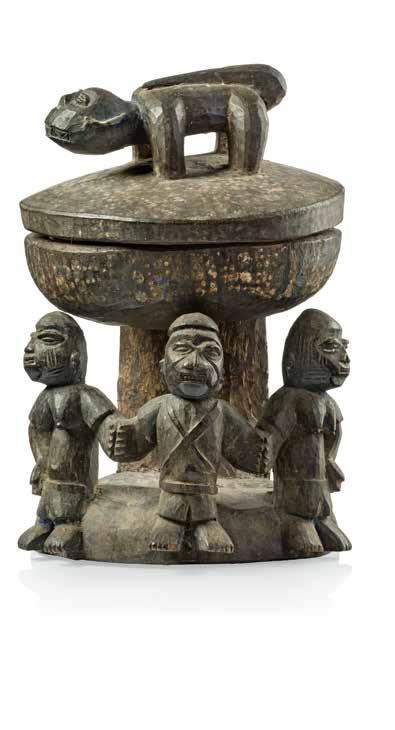
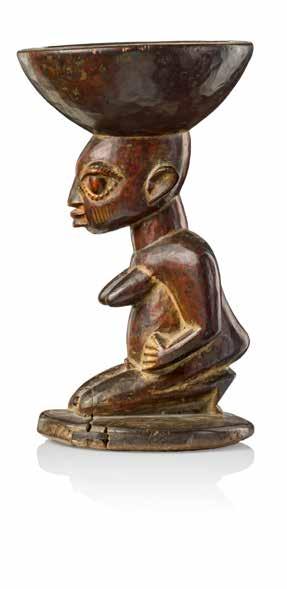
Thus, similar to the „agere ifa“ bowls, it could have been used to store oracle utensils.
42 cm
Heijs-Voorhuis, Sint Agatha, The Netherlands
NIGERIA, YORUBA - IJEBU
128 Deckeldose Holz
Reliefierter Dekor am Deckel, unter anderem zwei stilisierte menschliche Figuren mit kunstvoll verschlungenen Beinen („mudfish legs“).
Lidded box wood
Decorations in relief on the lid, inclu ding two stylised human figures with artfully intertwined legs („mudfish legs“).

L: 36 cm; B: 19 cm / 28 cm
Ursula Heijs-Voorhuis, Sint Agatha, The Netherlands Vgl. Lit.: Witte, Hans, A Closer Look, Berg en Dal 2004, p. 142, fig. 128
€ 250 - 500
128
129 Deckelschale mit anthropo morphen Motiven Holz, dunkles Pigment, rest.
Lidded bowl with anthropomorphic motifs wood, dark pigment, rest.
L: 67,5 cm; H: 13 cm
Ursula Heijs-Voorhuis, Sint Agatha, The Netherlands
Vgl. Lit.: For a formally and stylisti cally very similar object see AHDRC 0161400.
€ 600 - 1.200
129
Zum Zeichen ihrer Gastfreundschaft boten die Yoruba ihren Gästen in solch schön gestalteten Gefäßen Kolanüsse an. Überwiegend sind sie in Form von Hasen und Hühnervögeln gestaltet. Aber es finden sich auch An bietschalen in Form von Chamäleon, Pangolin oder Ziege.
Lidded bowl „igbobi ehoro“ in shape of a goat wood
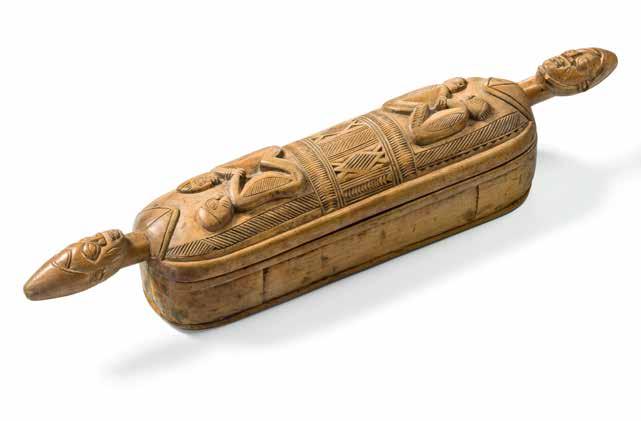
As a sign of their hospitality, the Yoru ba offered their guests kola nuts in such beautifully designed vessels. Mostly they are designed in the shape of hare and chicken. But there are also offering bowls in the form of chame leon, pangolin or goat.
L: 49 cm; H: 19,5 cm
Ursula Heijs-Voorhuis, Sint Agatha, The Netherlands
€ 500 - 1.000
131 Deckel eines Zeremonialge fäßes „awo ota eyinle“ Terrakotta, schwarz eingefärbt, rest. Dieser Gefäßdeckel ist das Werk ei ner Töpferin des 19. Jahrhunderts, die die „Rivalin von Abatan“ genannt wird (AHDRC 0105199). Der etwas eigentümliche Titel wurde ihr verlie hen, um sie von dem Egbado-Meis tertöpfer „Abatan“ zu unterscheiden. Es handelt sich um den Deckel eines Zeremonialgefäßes, das als „woota eyinle“, „Gefäß für die Steine von eyinle“ bekannt ist. Der Gott „eyin le“ oder „erinle“ wird mit der Jagd, Flüssen und heilenden Blättern in Verbindung gebracht.
Lid of a ceremonial vessel „awo ota eyinle“ terracotta, blackened, rest. This is a 19th century work of a female potter called the „rival of Abatan“ (AHDRC 0105199). The so mewhat peculiar title was awarded to distinguish her from the Egbado master potter „Abatan“.
It is a lid of a ceremonial vessel known as „woota eyinle“, „vessel for the stones of eyinle“. The god „ey inle“ or „erinle“ is associated with hunting, rivers and healing leaves.


Ursula Heijs-Voorhuis, Sint Agatha, The Netherlands
AHDRC: 0105199
Vgl. Lit.: Drewal, Henry John & John Pemberton, Yoruba, New York 1989, p. 228, ill. 271
-
Die Unterseite des Altaraufsatzes ist wie ein Mörser ausgehöhlt, die Wandung reliefplastisch verziert mit „shango“- typischen Symbolen, wie der Doppelaxt, dem Hund „shangos“, der sogar beidseitig zu finden ist, so wie der Schlange auf der Rückseite, deren zickzack-förmiger Körper an den Blitz gemahnen soll, mit dem „shango“ seine Macht offenbart. Nach Witte sitzen „shango“ Priester auf diesen hockerartigen Objekten, wenn sie von der Gottheit besessen sind. Vor allem aber dienen sie als Sockel / Unterlage für Utensilien, die im Kult des Donnergottes verwen det werden. Dazu zählen Behälter, in denen neolithische Steinbeile „edun ara“ aufbewahrt werden, die „shan go“ als Donnerkeile durch die Luft
schleudert, sowie Tanzstäbe und Kalebassenrasseln. „Shango“ soll in diesen Gegenständen gegenwärtig sein, und so wird der Mörser zu einem Thron für „shango“.
Jährlich wird ein Fest zur Verehrung von „shango“ abgehalten. Vor dem Fest werden der „odo shango“ und andere Schreinobjekte gewaschen und in den Farben „shangos“ (rot, weiß und blau) neu bemalt. Am Tag des Festes wird ein Tier geopfert und sein Blut über die gesammelten „edun ara“ gegossen, die in Gefäßen auf dem „odo shango“ aufbewahrt werden.
The bottom of the altarpiece is hollo wed like a mortar, the wall decorated in relief with symbols typical of „shan
go“, such as the double axe, „shangos“ dog, which can even be found on both sides, as well as the snake on the back, whose zigzag-shaped body is suppo sed to recall the lightning with which „shango“ reveals its power.
According to Witte, „shango“ priests sit on these stool-like objects when they are possessed by the deity. Above all, however, they serve as pedestals / bases for utensils used in the cult of the thunder god. These include con tainers in which Neolithic stone axes „edun ara“ are kept, which „shango“ hurls through the air as thunderbolts, as well as dance wands and calabash rattles. „Shango“ is said to be present in these objects, and so the mortar becomes a throne for „shango“. A festival is held annually for the wor ship of „shango“. Before the festival takes place, the „odo shango“ and other shrine objects are prepared by being washed and re-painted in „shango’s“ colours (red, white and blue). On the day of the festival, an animal sacrifice is made and it’s blood is poured over the collected „edun ara“ placed in vessels stored on the „odo shango“.

H: 35 cm; D: 31 cm
Gert Stoll, Berchtesgaden, Germany
Ursula Heijs-Voorhuis, Sint Agatha, The Netherlands
Vgl. Lit.: Homberger, Lorenz (Hg.), Yoruba, Zürich 1991, p. 70, fig. 83 € 500 - 1.000
Fliegenwedel sind bei den Yoruba At tribute von Königen, Würdenträgern und Jägern. Auch die Anhänger des Flussgottes „erinle“, der einst ein Jäger war, tragen solche Fliegenwedel über der linken Schulter, so dass die Figur kopfüber hängt.
Among the Yoruba, fly whisks are attributes of kings, dignitaries and hunters. Devotees of the river god „erinle“, who once was a hunter, also wear fly whisks like this over their left shoulders, so that the figure hangs upside down.

H: 23 cm (figure); L: 78 cm (whole length)
Vgl. Lit.: Witte, Hans, A Closer Look, Berg en Dal 2004, p. 197
400 - 800
Diese Messingfächer mit eingravier ten Symbolen und Zeichen wurden zu Ehren der Flußgöttin „oshun“ ge schaffen, die für Fruchtbarkeit und Kindersegen zuständig ist. Priesterin nen des Kultes trugen sie bei jährlich stattfindenden Festen in feierlichen Prozesssionen am Ufer des „Oshun“Flusses entlang.
Die Metapher des Fächers besagt, dass „oshun“ in der Lage ist, ihre Verehrer zu beruhigen (ihr Gemüt zu kühlen) und ihre Ängste zu vertreiben, auf glei che Weise wie ein Fächer den Körper kühlt.
Das Beängstigende an „oshun“ jedoch ist, dass sie ihre Fächer nicht nur im positiven Sinne einzusetzen vermag, sondern auch als Wurfgeschosse, die sie auf diejenigen schleudert, die ihren Zorn erregen.
These brass fans with engraved sym bols and signs were created in honor of the river goddess „oshun“, respon sible for fertility and child blessing. Priestesses of the cult carried them along the banks of the „Oshun“ river in ceremonial processions during annual festivals.

The metaphor of the fan is that „os hun“ is able to calm her worshippers (cool their minds) and dispel their fears, in the same way that a fan cools the body.
The frightening thing about „oshun“, however, is that she is able to use her fans not only in a positive sense, but also as throwing knives that she flings at those who arouse her anger.
Publ. in Verger, Pierre, „Dieux d‘Afrique. Cultes des Orishas et Vodouns à l‘ancienne Côte des Esclaves en Afrique et à Ba hia, la Baie de tous les Saints au Brésil“, Paris: Paul Hartmann, 1954: fig.110

Ursula Heijs-Voorhuis, Sint Agatha, The Netherlands
H: 45 cm; D: 31 cm
AHDRC: 0169582
Vgl. Lit.: Witte, Hans, A Closer Look, Berg en Dal 2004, ill. 257
€ 450 - 900
NIGERIA, YORUBA, OYO, IGBUKE OR IBUJE WORK SHOP
135 Kleiner Fächer mit figuralem Griff Holz, Tierhaut, Sockel Sehr schöne Schnitzarbeit mit fein ausgeführten Details.
Small fan with figural handle wood, animal skin, base Very beautiful carving with finely carved details.

H: 30 cm
Ursula Heijs-Voorhuis, Sint Agatha, The Netherlands
€ 400 - 800
135
136 Perlenbestickte Haube
„orikogbofo“ Stoff, weiße Miniaturglasperlen
Die Form dieser Haube ist den Perü cken englischer Justizbeamter nach empfunden, wie sie an den britischen Gerichten in Nigeria während der Ko lonialzeit üblich waren.
Der König trug eine „orikogbofo“Haube, um seine Autorität bei der Beurteilung von Zivil- und Strafsachen und bei der Verhängung von Strafen zu demonstrieren.
Beaded cap „orikogbofo“ cloth, white miniature glass beads
This headgear is in the form of a barrister‘s wig that would have been seen in the British courts established in Nigeria during the colonial era.
The king wore an „orikogbofo“ hood to assert his authority to judge civil and criminal matters and to decide punishments.

Ursula Heijs-Voorhuis, Sint Agatha, The Netherlands
Vgl. Lit.: Drewal, Henry John & John Mason, Beads, Body and Soul, Los An geles 1998, p. 209
€ 400 - 800
137 Perlen-Halskette „odigba ifa“ Stoff, polychrome Glasperlen, Schnurmaterial
Die „odigba ifa“, eine kunstvolle mehr reihige Perlenkette mit zwei Perlen beuteln, kennzeichnet die Wahrsager („babalawo“) als wichtige Führer, die mit Herrschern vergleichbar sind.
Die Verwendung bunter Glasperlen verleiht der Wahrsagesitzung Glanz und unterstreicht den hohen Status, den Wahrsager in der Yoruba-Gesell schaft genießen.
In die perlenbestickten Täschchen „apo“ an beiden Enden sind be stimmte Substanzen eingenäht, die dem „babalawo“ Schutz und Kraft verleihen sollen.
Beaded necklace „odigba ifa“ fabric, polychrome glass beads, cord material
The „odigba ifa“, an elaborate mul tistrand beaded necklace with two beaded pouches, marks the diviners „babalawo“ as important leaders who are comparable to rulers.
The use of colorful glass beads adds luster to the divination session and underlines the high status diviners enjoy in Yoruba society.
In the beaded pouches „apo“ at both ends are sewn certain substances for the protection and power of the „babalawo“.
99 cm
Ursula Heijs-Voorhuis, Sint Agatha, The Netherlands
Vgl. Lit.: Drewal, Henry John & John Mason, Beads, Body and Soul, Los An geles 1998, p. 234
€ 500 - 1.000
138 Perlen-Halskette „odigba ifa“ bunte Glasperlen, Holz, Metall, Stoff, Karton, Schnurmaterial
In dieses Ensemble sind „gbekude“ integriert, zylinderförmige Stücke aus dem Holz eines heiligen Baumes, das dem Wahrsager ein langes und erfolg reiches Leben sichern sollte.
Beaded necklace „odigba ifa“ colorful glass beads, wood, metal, fabric, cardboard, cord material Incorporated into the ensemble is the „gbekude“, cylindrical pieces of wood from a sacred tree that works to ensure a long and prosperous life for the diviner.
L: 105 cm; H: 18 cm (bag)
Ursula Heijs-Voorhuis, Sint Agatha, The Netherlands
€ 300 - 600
Lot 140
NIGERIA, YORUBA, OWU, IBADAN
139 Webrollenhalter mit Reiterfigur

Holz
Heddle pulley with equestrian figure wood
H: 13 cm
Provenance
Ursula Heijs-Voorhuis, Sint Agatha, The Netherlands
€ 400 - 800
140 Seltene Brettchenpuppe „omolangidi“ („Kind aus Holz“) Holz, Sockel
Diese traditionellen Puppen werden von den Mädchen in einem Tuch auf dem Rücken getragen, liebevoll ver sorgt, gefüttert und geschmückt.
Rare slat doll „omolangidi“ („child from wood“) wood, base
These traditional dolls are carried by the girls in a cloth on their backs, lo vingly cared for, fed and decorated.
H: 34 cm
Alain Dufour, Paris/Saint-Maur, France
Guy van Rijn, Antwerp, Belgium
Jos Beck, The Netherlands
Ursula Heijs-Voorhuis, Sint Agatha, The Netherlands (1998)
AHDRC: 0106111
€ 450 - 900
141 Janusförmige Helmmaske der „troh“ - Geheimgesellschaft Holz, dick verkrustete Opferpatina, durch Rauch und Ruß geschwärzt, Sammlungsnr. Afrika Museum Berg en Dal „222-4“, beschriftet „Nacht masker Bamum“
Der „troh“- Bund wird von den Bami leke auch als „Nacht“- oder PolizeiGesellschaft bezeichnet.
Er ist in verschiedene Abteilungen / Zuständigkeitsbereiche unterteilt. Eine Gruppe übt exekutive Funkti onen aus, wie z. B. das Eintreiben von Bußgeldern, die Bestrafung von Verbrechern oder die Regelung von Grenzstreitigkeiten. Eine andere küm mert sich um politische Angelegen heiten. Eine der wichtigsten Aufgaben der Bundmitglieder ist es, die Nach folge des Königs zu bestimmen und in der Übergangsphase für Recht und Ordnung zu sorgen.
Außerdem wird der „troh“- Gesell schaft eine direkte Beziehung zum Übernatürlichen nachgesagt. Es wird berichtet, dass ihre Mitglieder mit Rotholzpulver und weißer Krei de beschmiert zu nächtlichen Treffen erscheinen, um Hexerei auszuüben. Das furchteinflößende abstoßende Aussehen der sogenannten „Nacht“Masken verleiht ihrer aggressiven regulatorischen Funktion angemes senen Ausdruck. Wegen ihres ge
fährlichen Potentials, das im Laufe der Jahre durch wiederholte Beopfe rungen verstärkt wurde, werden sie auf den Schultern und nicht auf dem Kopf getragen.
Janus-shaped helmet mask of the „troh“ secret society wood, thickly encrusted sacrificial pa tina, blackened by smoke and soot, collection no. Afrika Museum Berg en Dal „222-4“, labeled „Nachtmas ker Bamum“
The „troh“ covenant is also called the „night“ or military / police society by the Bamileke.

It is divided into different sections / areas of responsibility. One group performs executive functions, such as collecting fines, punishing criminals or settling border disputes. Another
takes care of political affairs. One of the most important tasks of the so ciety members is to determine the succession of the king and to ensure law and order during the transition period.
In addition, the secret society is said to have a direct relationship with the supernatural. Its members are repor ted appearing at nightly meetings smeared with camwood powder and white chalk to practice witchcraft. The awesome and fear-inspiring fea tures of the so-called „night“ masks gives adequate expression to their ag gressive policing function. Because of their dangerous potential, reinforced over the years by libations, their ow ners carry them on their shoulders and not on their heads.
Afrika Museum, Berg en Dal, The Netherlands
Ursula Heijs-Voorhuis, Sint Agatha, The Netherlands
Vgl. Lit.: Lintig, B. von, Cameroun, Paris 2006, p. 98 f. Homberger, Lorenz (Hg.), Kamerun, Kunst der Könige, Zürich 2008, p. 184
€ 2.500 - 5.000

Mit 17 Objekten ist sie die kleins te der fünf Privatsammlungen dieser Auktionsofferte. Ausge wählte Werke aus dem Nachlass des 2021 verstorbenen Frankfur ter Sammlers Horst Hornstadt, mit dem das Haus über viele Jahre verbunden war.
Unverkennbar seine Präferenz für das Elementare, nur wenig Bearbeitete, das vor allem bei den großformatigen Skulptu ren, wie dem Grabpfosten der Koso (Äthiopien), und den Figu ren aus Tansania sichtbar wird.
Unter den präsentierten Werken ist die 89 cm messende Sukuma Figur, eine Marionette [Los 153], die 1994 auf der wegweisenden Tansania-Ausstellung in Mün chen publiziert wurde.
With 17 objects, it is the smallest of the five private collections in this auction. Selected works from the estate of the Frankfurt collector Horst Hornstadt, who died in 2021, and with whom the House was connected for many years.
Unmistakable his preference for the elementary, only slightly processed. This becomes really visible in the large-scale sculp tures, such as the Koso grave post (Ethiopia), and the figures of Tanzania. Among the works presented is the published 89 cm Sukuma puppet [lot 153] displayed at the landmark 1994 Tanzania exhibition in Munich.
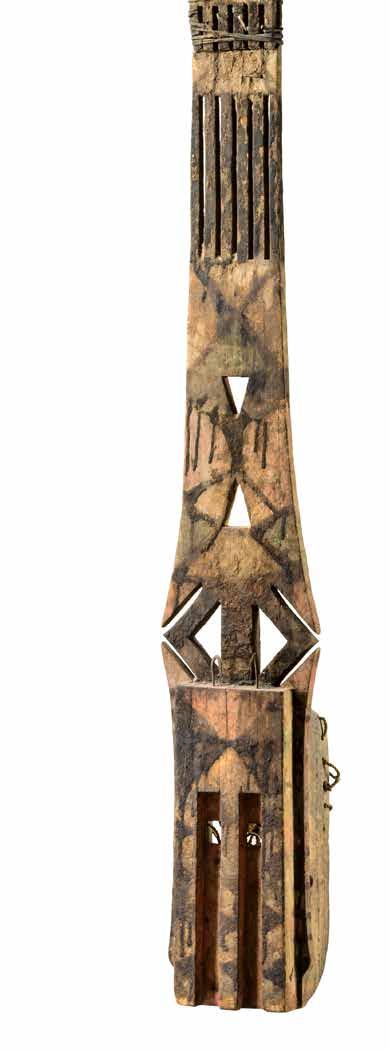
Der „sirige“-Maskentanz auf dem Dorf platz stellt nach dem Glauben der Dogon die Erschaffung der Erde und des Lebens dar. Der athletische und ge schickte Tänzer schwingt die Maske in kreisenden Bewegungen und berührt mit der Spitze der Maske den Boden, um die Sonne und ihre lebensspendenden Eigenschaften darzustellen. Sie wird mit einem hölzernen Stab, den die Tänzer zwischen den Zähnen halten, in Positi on gehalten.

142 Gesichts- / Brettmaske
„sirige“
Holz, dreitlg., Pigmente, Masse, Tier haut, Metall, Sockel
Die „sirige“- Maske misst mehrere Me ter in der Länge. Sie symbolisiert die „ginna“ (das „Haus der Großfamilie“).
Ihre langgestreckte Struktur reprä sentiert eine vertikale Aneinander reihung von Generationen.
Face / plank mask „sirige“ wood, three-part, pigments, mass, animal skin, metal, base
The „sirige“ mask measures several metres in length. It symbolizes the „ginna“ („the house of the extended family“). Its elongated structure is a vertical juxtaposition of generations.
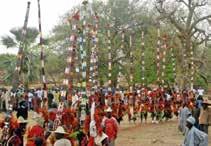

H: 145 cm - 109 cm - 73,5 cm (full height: 327,5 cm)
The „sirige“ masquerade dances in the village square, reenact what the Dogon believe to be the creation of earth and life. The athletic and skilled dancer swings the mask in circular motions, touching the tip of the mask to the ground to represent the sun and its life giving properties. The mask stays in po sition by means of a wooden bit that dancers hold between their teeth.
Horst Hornstadt, Frankfurt, Germany
Vgl. Lit.: Imperato, Pascal James, Dogon cliff dwellers, New York 1978, ill. 22 https://www.imodara.com/discover/ mali-dogon-sirige-storied-housemask/
€ 1.000 - 2.000
143 Zoomorphe Maske Holz
Seltener Maskentypus. Ein vergleich bares Objekt wurde am 7. Juli 2018 als Lot 217 bei Zemanek-Münster verauk tioniert (vgl. AHDRC 0153586).
Provenance Horst Hornstadt, Frankfurt, Germany
Rare mask type. A similar object was auctioned as lot 217 at ZemanekMünster on July 7, 2018 (cf. AHDRC 0153586).

H: 41 cm
€ 1.200 - 3.000
144 Weibliche Schreinfigur Holz, Sockel
Female shrine figure wood, base H: 88 cm
Provenance Horst Hornstadt, Frankfurt, Germany
€ 250 - 500

146 Auf Stab gearbeitete Rumpffigur „kundul“ Holz, Pigmente, Metall, Sockel
Trunk figure „kundul“ on metal stick wood, pigments, metal, base H: 43 cm
Provenance Horst Hornstadt, Frankfurt, Germany € 500 - 1.000


148
Holz, Eisen
a) Prunkaxt und Würdezeichen, der Schaft mit Echsenhaut ummantelt, fünffach durchbrochene Klinge mit geschmiedetem Dekor, L: 38 cm / 26 cm (Schaft / Klinge); b) Prestigeaxt mit kupferummanteltem Griff, L: 37,5 cm / 18 cm (Schaft / Klinge)
dazu: c) Kuba Kingdom, Lele, Axt, L: 43 cm / 17 cm (Schaft / Klinge); d) Tan sania, Luguru, Axt, L: 50 cm / 31 cm (Schaft / Klinge)
148 Helmmaske „agwe chaka“ Holz, Tierhaut, Pigmente, schwarze Masse
Nach Nicklin wurde diese Maske bei Begräbnisritualen für Mitglieder der „nchibbe“ („nchibi“ / „nchebi“) - Ge sellschaft der Krieger (und Jäger) ge tragen. Sie stellt eine Art Trickster geist dar, der sowohl Gutes, als auch Böses bewirken kann.
Vgl. Lit.: Fagaly, William, Ancestors of Congo Square, New Orleans 2011, p. 224 f.
Helmet mask „agwe chaka“ wood, animal skin, pigments, blackish mass
According to Nicklin, this mask was worn during funerary rituals dedica ted to members of the warrior society known as „nchibbe“ („nchibi“ / „nche bi“). It depicts a kind of trickster spirit, who can cause good as well as evil.

H: 46 cm
August Flick, Cologne, Germany
Zemanek-Münster, 4 Sept. 2010, Lot 398 Horst Hornstadt, Frankfurt, Germany
€ 450 - 900
a) prestige axe and sign of dignity, the shaft sheathed with lizard skin, fivefold openwork blade with forged decoration, l: 38 cm / 26 cm (shaft / blade); b) prestige axe with copper sheathed handle, l: 37,5 cm / 18 cm (shaft / blade)
additionally: c) Kuba Kingdom, Lele, axe, l: 43 cm / 17 cm (shaft / blade); d) Tanzania, Luguru, axe, l: 50 cm / 31 cm (shaft / blade)
Horst Hornstadt, Frankfurt, Germany
€ 450 - 900
D. R. CONGO, BWAKA (NGBAKA)
149 Anthropomorphe Bogenharfe (Cordophon)
Holz, Tierhaut, Messingnägel, rest., Sockel
Anthropomorphic bow harp (chordo phone)

wood, animal skin, brass tags, rest., base
Horst Hornstadt, Frankfurt, Germany
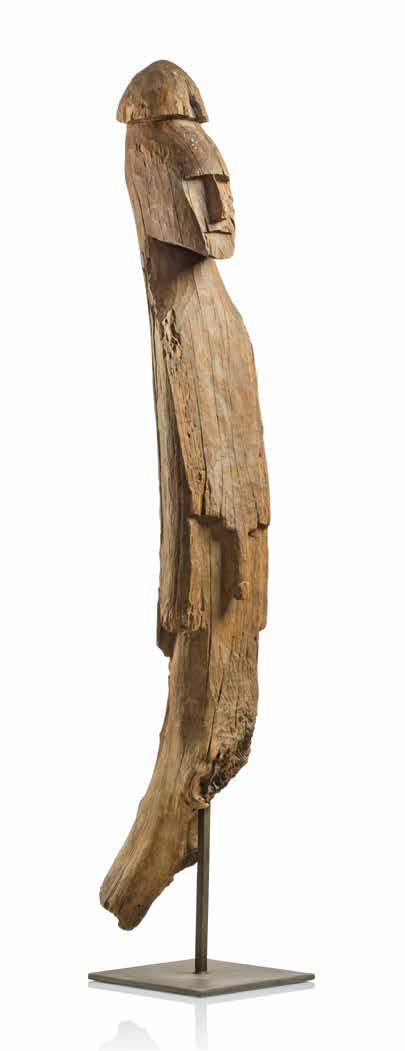
Holz, Windschliff, Spuren von Verwit terung und Insektenfraß, Sockel
Die Konso schnitzten diese Pfostenfi guren um das Andenken an besonders bedeutende Männer zu ehren. Die „waka“ wurden ursprünglich mit anderen Skulpturen zusammen in Gruppen präsentiert. In der Mitte stand der Pfahl des Verstorbenen, umgeben von Skulpturen, die die von ihm getöteten Feinde und seine bei Aufstellung des Pfahles bereits ver storbenen Frauen darstellten. Biswei len waren sogar die Tiere, die der Ver storbene zu Lebzeiten erbeutet hatte, durch kleine Tierskulpturen vertreten.
Vgl. Lit.: Greve, Anna/Volker-Saad, Kerstin (Hg.), Äthiopien und Deutsch land, München/Berlin 2006, p. 226 f.
Ein ebenfalls aus der Sammlung Sachau stammender weiblicher „waka“, wurde am 4. März 2017 als Lot 479 bei Zemanek-Münster ver auktioniert (vgl. AHDRC 0139949).
Er zeigt große stilistische Gemein samkeiten mit vorliegendem Objekt und könnte von der Hand desselben Künstlers stammen.
A female „waka“, also from the Sa chau Collection, was auctioned at Zemanek-Münster, 4 March 2017 as lot 479 (cf. AHDRC 0139949). It shows great stylistic similarities with the present object and could be by the hand of the same artist.
Male grave post „waka“ wood, wind abrasion, traces of wea thering and insect caused damage, base
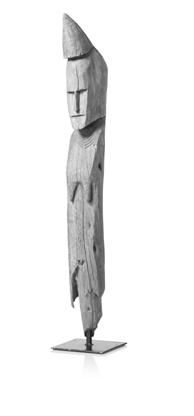
The Konso carve these post figures to honor the memory of prominent men. Originally, the „waka“ were always united in groups. In the centre stood the post of the deceased, surroun ded by sculptures representing the enemies he had killed and his wives who had already died when the post was erected. Sometimes even the ani mals that the deceased had captured during his lifetime were represented by small animal sculptures.
Klaus Sachau, Wittlich, Germany
Zemanek-Münster, 5 December 1998, Lot 24
Horst Hornstadt, Frankfurt, Germany
€ 1.500 - 3.500
152 Stehende männliche Figur / Marionette
Holz, Brandzier, Pigmentreste, die separat gearbeiteten, einst mittels von Nägeln befestigten Arme fehlen, Sockel
Standing male figure / puppet wood, pokerwork, pigment residues, the separately worked movable arms, formerly fastened by means of nails, are missing, base H: 102,5 cm

Horst Hornstadt, Frankfurt, Germany
Vgl. Lit.: Jahn, Jens (Hg.), Tanzania, München 1994, p. 225
Aimée Bessire: „At a Safe Distance: Su kuma Dance Figures and the Arousal of Spectacle“, in: African Arts, Spring 2005
€ 500 - 1.000
Diese Figuren wurden von Tänzern getragen und ihre Gliedmaßen den vorhandenen Vorrichtungen ent sprechend bewegt.
Meurant berichtete (Jahn, 1994, S. 225), dass Figuren mit beweglichen Gliedmaßen oder Geschlechtsteilen „(a)maleba“ genannt werden. Ein „ileba“ ist ein Gegenstand, der dazu dient, die Aufmerksamkeit des Pub likums zu erregen. Bessire (2005) berichtet, daß die Figuren bei Tanz wettbewerben auftraten, bei denen diejenigen gewannen, die die größ te Zuschauermenge anzulocken vermochten.
These figures were carried by danc ers and their limbs moved according to the corresponding devices. Meurant (Jahn,1994, p. 225) already assumed that figures with movable limbs or genitals were called „(a) maleba“. An „ileba“ is an object used to attract the attention of the audience. Bessire (2005) reports that the figures appeared in dance competitions, where the winners were those who could attract the largest crowd.
153 Stehende weibliche Figur / Marionette Holz, 2-tlg., Metall, rotes Pigment

Standing female figure / puppet wood, two-part, metal, red pigment

H: 89 cm
Provenance Horst Hornstadt, Frankfurt, Germany
TANZANIA, ZARAMO / KWERE
154 Stehende weibliche Figur Holz, Sockel
In zwei Schöpfen angelegte Haar tracht, wie sie sich typischerweise bei den „mwana hiti“ - Puppen findet.
Standing female figure wood, base Hairstyle created in two scoops, as typically found on the „mwana hiti“ dolls.

H: 63,5 cm
Provenance Horst Hornstadt, Frankfurt, Germany
€ 500 - 800
Photo: George Meister
Publ. in Jahn, Jens (Hg.), Tanzania, München 1994, p. 225, ill. V/10
€ 1.000 - 2.500
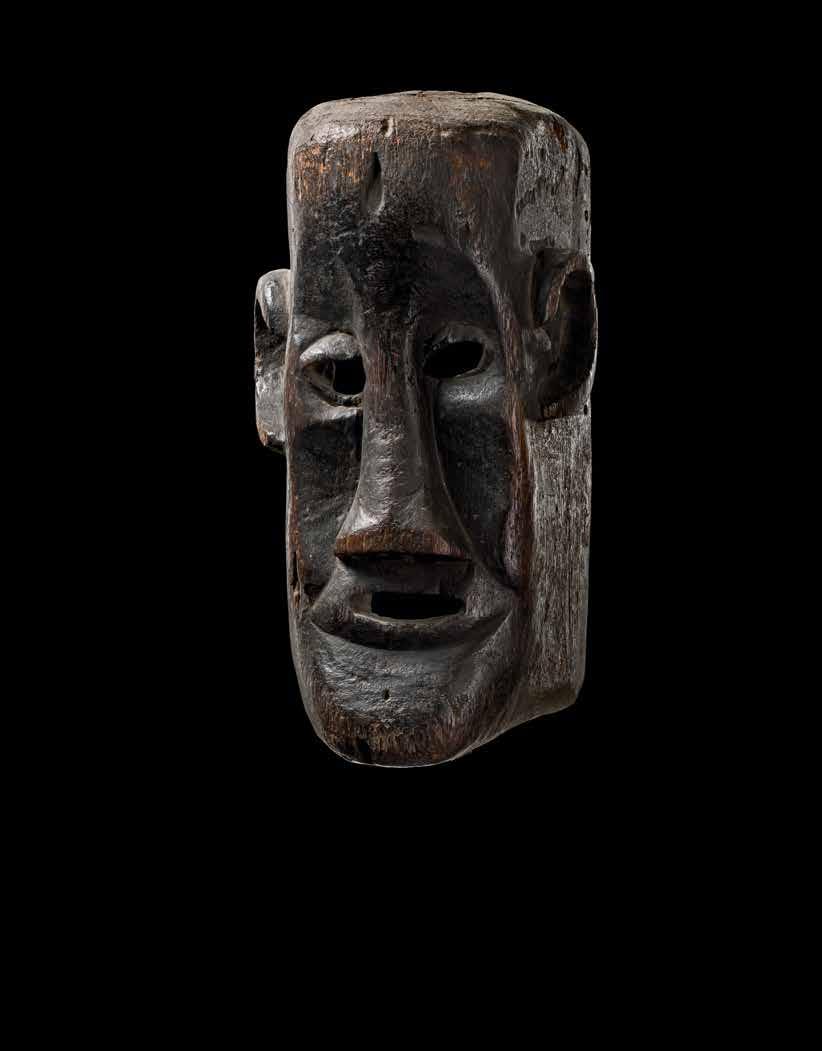


Mit der Teilnahme an der Versteigerung werden folgende Bedingungen anerkannt (Stand 10/2022):
1. Das Auktionshaus handelt als Kommissionär im eigenen Namen und für Rechnung seiner Auftraggeber (Kommittenten), die unbe nannt bleiben. Die Versteigerung ist öffentlich i.S.d. §§ 383 Abs. 3 und 474 Abs. 1 BGB.
2. Der Auktionator kann Nummern vereinigen, trennen, außerhalb der Reihenfolge ausbieten und zurückziehen.
3. Das Versteigerungsgut kann vor der Auktion besichtigt werden. Die Objekte sind gebraucht, sie können daher entsprechend ihres Alters und ihrer Nutzung Gebrauchsspuren und Abnutzungser scheinungen, ggf. auch Restaurierungen, aufweisen, ohne dabei die Wahrnehmung, Wertschätzung und das Verständnis für das Objekt zu schmälern. Authentizität und Echtheit eines Objektes bleiben davon ebenfalls unberührt. Der Erhaltungszustand wird im Katalog nicht durchgängig erwähnt, so dass fehlende Angaben keine Beschaffenheitsvereinbarung begründen.
4. Der Versteigerer behält sich vor, Katalogangaben zu berichtigen. Berichtigungen werden schriftlich resp. mündlich bekannt gegeben und treten anstelle der Katalogbeschreibung. Objekte werden in dem Zustand verkauft, in dem sie sich zum Zeitpunkt des Zuschlags befinden. Nach bestem Wissen und Gewissen vorgenommenen Katalog- und Maßangaben sind keine vertraglichen Beschaffenheits angaben oder Garantien im kaufrechtlichen Sinne. Auf Wunsch der Interessenten abgegebene Zustandsberichte (Condition Reports) enthalten keine vertraglich vereinbarten Beschaffenheitsangaben, sondern dienen nur der näheren Orientierung über den äußeren Zustand des Objekts nach Einschätzung des Versteigerers. Die im Katalog und auf der Homepage befindlichen Abbildungen dienen dem Zweck, dem Interessenten eine Vorstellung von dem Kunstwerk zu geben; sie sind weder Bestandteil der Beschaffenheitsvereinba rung noch eine Garantie für die Beschaffenheit.
5. Die Vorschriften des Verbrauchsgüterkaufes gelten nicht in einer öffentlich zugänglichen Versteigerung (§ 474 Absatz 2 BGB).
5.a. Der Versteigerer übernimmt keine Haftung für Mängel, soweit er die ihm obliegenden Sorgfaltspflichten erfüllt hat. Er verpflichtet sich jedoch, wegen rechtzeitig vorgetragener, begründeter Mängel rügen seine Gewährleistungsansprüche gegenüber dem Einlieferer geltend zu machen; dabei beträgt die Verjährungsfrist zwölf Monate vom Zeitpunkt des Zuschlags an. Im Falle erfolgreicher Inanspruch nahme des Einlieferers erstattet der Versteigerer dem Käufer den gezahlten Kaufpreis (einschließlich Aufgeld) zurück; ein darüber hinaus gehender Anspruch ist ausgeschlossen. Eine Rücknahme des ersteigerten Gegenstandes setzt aber jedenfalls voraus, dass dieser sich in unverändertem Zustand seit der Versteigerung befindet. Der Versteigerer übernimmt keine Haftung für fehlerhafte Über setzungen der Katalogtexte vom Deutschen in andere Sprachen.
6. Der Versteigerer übernimmt keine Gewähr für das Zustandekommen oder die Aufrechterhaltung von Telekommunikations-Verbindungen.
7. Der Versteigerer übernimmt keine Garantie für die technische Möglichkeit des Aufbaus einer Internetverbindung oder der recht zeitigen Übermittlung von Geboten über das Internet-Live-Mit bieten-System während einer Auktion. Um sicher in der Auktion berücksichtigt zu werden empfiehlt sich daher eine frühzeitige schriftliche Gebotsabgabe.
8. Gemäß Geldwäschegesetz (GwG) ist der Versteigerer verpflichtet, den Erwerber bzw. den an einem Erwerb Interessierten sowie ggf. einen für diese auftretenden Vertreter und den „wirtschaftlich Berechtigten“ i.S.v. § 3 GwG zum Zwecke der Auftragsdurchführung zu identifizieren sowie die erhobenen Angaben und eingeholten
Informationen aufzuzeichnen und aufzubewahren. Der Erwerber ist hierbei zur Mitwirkung verpflichtet, insbesondere zur Vorlage der erforderlichen Legitimationspapiere, insbesondere anhand ei nes inländischen oder nach ausländerrechtlichen Bestimmungen anerkannten oder zugelassenen Passes, Personalausweises oder Pass- oder Ausweisersatzes. Der Versteigerer ist berechtigt, sich hiervon eine Kopie unter Beachtung der datenschutzrechtlichen Bestimmungen zu fertigen. Bei juristischen Personen oder Perso nengesellschaften ist der Auszug aus dem Handels- oder Genossen schaftsregister oder einem vergleichbaren amtlichen Register oder Verzeichnis anzufordern. Der Erwerber versichert, dass die von ihm zu diesem Zweck vorgelegten Legitimationspapiere und erteilten Auskünfte zutreffend sind und er, bzw. der von ihm Vertretene „wirtschaftlich Berechtigter“ nach § 3 GwG ist.
9. Nicht genauer bekannte Bieter werden gebeten, bis zum Beginn der Auktion eine ausreichende Sicherheit zu leisten, da sonst die Ausführung des Auftrages unterbleiben kann. Als Sicherheitsleis tung ist eine auf den Namen des Bieters ausgestellte Bankgarantie vorzulegen oder eine gültige Kreditkarte anzugeben. Bitte beachten Sie deren Deckungssumme.
10. Schriftliche Bieteraufträge werden auf das Gewissenhafteste er ledigt. Hierfür ist das entsprechende Gebotsformular zu verwenden. Es muss genaue Angaben enthalten und spätestens drei Arbeitstage vor Versteigerungstermin in schriftlicher Form (Brief, Fax, E-Mail, Scan) vorliegen. Schriftliche Gebote werden vom Versteigerer nur in dem Umfang ausgeschöpft, der erforderlich ist, um anderweitige Gebote zu überbieten.
Schriftliche Gebote, die mehr als 10 % unter dem Aufrufpreis liegen, können nicht berücksichtigt werden. Für die Berücksichtigung von Geboten per e-Mail kann aufgrund der Unsicherheiten keine Haftung übernommen werden.
Bei schriftlichen Bieteraufträgen ist telefonisches Mitbieten nur bei Losen mit einem Aufrufpreis ab 300 Euro möglich. Für Telefonbie ter ist der Aufrufpreis das Mindestgebot. Bieter, welche über das Telefon Gebote abgeben, werden darauf hingewiesen, dass diese Telefongespräche aufgezeichnet und mitgehört werden. Jeder Bieter erklärt sich hiermit ausdrücklich einverstanden. Sollten Einwände bestehen, so sind diese durch den Bieter im Vorfeld schriftlich zu erheben. Das Auktionshaus behält sich vor, solche Bieter von der Teilnahme auszuschließen. Nach Abschluss der Transaktion werden die Aufnahmen umgehend gelöscht.
11. Die im Katalog aufgeführten Preise sind Aufruf- und Schätzpreise. Gesteigert wird um ca. 10 % (Für Internetbieter gelten die gelis teten Gebotsschritte auf der jeweiligen Plattform). Der Zuschlag wird erteilt, wenn nach dreimaliger Wiederholung des höchsten Gebotes ein Übergebot nicht gegeben ist, und der vom Einlieferer vorgeschriebene Mindestzuschlagspreis erreicht ist.
12. Bei einem Zuschlag unter Vorbehalt ist ein Bieter drei Wochen an sein Gebot gebunden. Wird ein Vorbehalt ausgerufen, kann die Katalognummer ohne Rückfrage an einen Limitbieter abgegeben werden. Lehnt der Auktionator ein Gebot ab, so bleibt das vorher gehende weiterhin verbindlich. Bei gleichen Geboten entscheidet das Los. Der Versteigerer kann den Zuschlag zurücknehmen und den Gegenstand erneut ausbieten, wenn irrtümlich ein rechtzeitig abgegebenes höheres Gebot übersehen worden ist, oder wenn der Höchstbietende sein Gebot nicht gelten lassen will, oder sonst Zweifel über den Zuschlag bestehen.
13. Der Versteigerer darf für den Einlieferer bis zum vereinbarten Mindestverkaufspreis (Limit) auf das Los bieten ohne dies anzuzeigen und unabhängig davon, ob andere Gebote abgegeben werden oder
nicht. Zum Schutz des eingelieferten Objekts kann der Versteigerer den Zuschlag unterhalb des Limits an den Einlieferer erteilen; in diesem Fall handelt es sich um einen Rückgang.
14. Jeder Bieter kauft in eigenem Namen und auf seine eigene Rechnung. Der Vertrag kommt erst durch Zuschlag zustande. Das zugeschlagene Höchstgebot ist der Nettopreis.
15. Auf den Zuschlag wird ein Aufgeld von 21 % (andere InternetAuktionsplattformen können davon abweichen), plus der aus dem Aufgeld resultierenden Mehrwertsteuer erhoben. Im Nachverkauf wird ein Aufgeld von 23 % erhoben, plus der aus dem Aufgeld re sultierenden Mehrwertsteuer.
16. Das Widerrufsrecht findet keine Anwendung. Fernabsatzverträge, die in Form von Versteigerungen (§ 156 BGB) geschlossen werden, finden auf Internet-Gebote im Rahmen des Internet-Live-MitbietenSystems (Ziff. 7) und auf Telefon-Gebote (Ziff. 9) keine Anwendung.
17. Besteht die Notwendigkeit zur Einholung von CITES-Beschei nigungen zwecks Erteilung von Ausnahmegenehmigungen vom Vermarktungsverbot von Gegenständen, die dem Artenschutzab kommen unterliegen, so gehen hierfür anfallende Kosten zu Lasten des Käufers (100 Euro je CITES). Gleiches gilt für Genehmigungen zur Ausfuhr von Kulturgut (100 Euro je Genehmigung).
18. Zahlungen erfolgen in EURO (€) und sind unverzüglich nach Rechnungsstellung zu leisten. Zahlungen des Käufers sind grund sätzlich nur durch Überweisung an den Versteigerer auf das von ihm angegebene Konto zu leisten. Die Erfüllungswirkung der Zahlung tritt erst mit endgültiger Gutschrift auf dem Konto des Versteigerers ein. Zahlungen per Kreditkarte (Visa, Master, Amex) sind nur bis zu einem Betrag in Höhe von 1.000 Euro möglich. Alle Kosten und Gebühren der Überweisung (inkl. der dem Versteigerer abgezoge nen Bankspesen) gehen zu Lasten des Käufers, soweit gesetzlich zulässig und nicht unter das Verbot des § 270a BGB fallend. Das Eigentum geht erst nach erfolgter Zahlung auf den Käufer über, und das Auktionsgut wird erst danach ausgeliefert bzw. übergeben. Für rechtzeitige Vorlegung, Protestierung, Benachrichtigung oder Zurückleitung nicht eingelöster Zahlungen / Zahlungsmittel haftet der Versteigerer nicht.
19. Bei Zahlungsverzug werden Verzugszinsen in Höhe des bank üblichen Zinssatzes, mindestens jedoch in Höhe des gesetzlichen Verzugszinses nach §§ 288, 247 berechnet. Außerdem kann der Ver steigerer den Käufer auf Schadensersatz wegen schuldhafter Pflicht verletzung in Anspruch nehmen. Dazu kann er nach der zweiten Mahnung als Schadenspauschale einen Säumniszuschlag von 3% der Gesamtforderung erheben, es sei denn der Käufer weist nach, dass ein Schaden nicht oder in wesentlich geringerer Höhe entstanden ist. Statt der Schadenspauschale kann der Versteigerer Ersatz des konkret entstandenen Schadens verlangen. Dieser ist hierbei auch so zu berechnen, dass der Gegenstand in einer weiteren Auktion mit einem nach pflichtgemäßem Ermessen des Versteigerers be stimmten Limit erneut versteigert wird und der säumige Käufer für einen Mindererlös gegenüber der vorangegangenen Versteigerung und für die Kosten der wiederholten Versteigerung einschließlich Provision und Auslagen des Versteigerers aufzukommen hat; auf einen Mehrerlös hat er in diesem Falle keinen Anspruch, und seine Rechte aus dem ihm vorher erteilten Zuschlag erlöschen mit dem neuen Zuschlag. Der säumige Käufer wird zu künftigen Geboten nicht zugelassen Mit Eintritt des Verzuges werden sämtliche For derungen des Versteigerers gegen den Käufer sofort fällig.
20. Der Ersteigerer ist verpflichtet, die Sachen sofort nach der Auk tion in Empfang zu nehmen. Mit der Übergabe geht die Gefahr für nicht zu vertretende Verluste und Beschädigungen auf den Käufer
über. Gegenstände, die nicht abgeholt werden, können ohne Mah nung im Namen sowie auf Kosten und Gefahr des Käufers bei einer Spedition eingelagert werden.
21. Ansprüche auf Schadensersatz aufgrund eines Mangels, eines Verlustes oder einer Beschädigung des versteigerten Objektes, gleich aus welchem Rechtsgrund, oder wegen Abweichungen von Katalo gangaben oder anderweitig erteilten Auskünften sind ausgeschlos sen, sofern Zemanek-Münster oder seine Erfüllungsgehilfen nicht vorsätzlich oder grob fahrlässig gehandelt oder vertragswesentliche Pflichten verletzt hat; die Haftung für Schäden aus der Verletzung des Lebens, des Körpers oder der Gesundheit bleibt unberührt. Im Übrigen gilt Ziffer 4. 22.a. Verpackung und Versand Verpackung und Versand Ihrer Objekte sind ein unverbindlicher Service unseres Hauses, und betragen innerhalb Deutschlands pauschal 50 Euro / europaweit 80 Euro bei Standardformaten. Für alle übrigen Länder erheben wir eine Pauschale von 50 Euro zuzügl. gewichts- und volumenabhängigen Versandkosten. Gesonderte Speditionsaufträge sowie Sperrgut und internationale Transporte richten sich nach dem wirtschaftlichsten Anbieter und werden extra berechnet. Für gerahmte Bilder, Möbelstücke und Keramiken kontaktieren Sie bitte Mail Boxes Etc. Aschaffenburg (mbe0020@ mbe.de Tel: +49 (0)6021 625 9090). Die Versendung ersteigerter Sachen auf Wunsch des Käufers geschieht auf dessen Kosten und Gefahr. Bei CITES-pflichtigen Objekten bitten wir Sie zu beachten, dass ein uneingeschränkter Handel nur innerhalb der Europäischen Gemeinschaft erlaubt ist. Ein Versand in Drittländer ist zur Zeit nicht möglich.
22.b. Transportversicherung
Eine obligatorische Transportversicherung deckt Risiken, die mit dem regulären Transport verbunden sind. Die Kosten für die Trans portversicherung und Schadensregulierung trägt der Käufer. Nach Anlieferung hat der Käufer die Sachen unverzüglich auf Schäden zu untersuchen und diese dem Transportunternehmen anzuzei gen; spätere Reklamationen wegen nicht verdeckter Schäden sind ausgeschlossen.
22.c. Zollerklärung
Den Service einer Zollerklärung bieten wir ab einem Warenwert von mehr als 1.000 Euro für nur 100 Euro an, bei geringeren Beträgen ist eine Voranmeldung nicht notwendig.
23. Bei der Besichtigung ist größte Vorsicht zu empfehlen, da jeder Besucher für den von ihm verursachten Schaden in vollem Umfang haftet.
24. Die vorstehenden Bedingungen gelten sinngemäß auch für den Nachverkauf oder Freiverkauf von Auktionsgut.
25. Erfüllungsort und Gerichtsstand für beide Teile ist, soweit ge setzlich zulässig, Würzburg.
26. Die Rechtsbeziehungen richten sich nach deutschem Recht; das UN-Abkommen über Verträge des internationalen Warenkaufs (CISG) findet keine Anwendung.
27. Sollte eine Bestimmung dieser Bedingungen unwirksam sein, so bleiben die übrigen Bestimmungen gültig. Es gilt § 306 Abs. 2 BGB.
28. Diese Allgemeinen Geschäftsbedingungen sind auf Deutsch, Englisch und Französisch verfügbar. Maßgebend ist stets die deut sche Fassung, wobei es für Bedeutung und Auslegung der in diesen Geschäftsbedingungen verwendeten Begriffe ausschließlich auf deutsches Recht ankommt.
The following conditions apply (updated 10/2022):
1. Auctions are held by the auctioneer as commissioning agent on behalf of third parties, whose names are not disclosed. They are arranged at public in accordance with §§ 383 (3) and 474 (1) of the German Civil Code (BGB).
2. The auctioneer has the right to combine and separate items or auction them in a different order or withdraw them altogether.
3. All items lots to be put up for sale may be viewed and inspected prior to the auction. They are second hand and according to their age and their use they can therefore show traces of usage and wear marks and, if necessary, they also can have restorations without detracting from the perception, the value and the meaning of these objects. Their authenticity and originality also remain untouched of this.The state of preservation is not continuously mentioned in the catalogue so that any missing information shall also not constitute an agreement as to quality.
4. The auctioneer reserves the right to make corrections to catalogue information. These corrections take the form of written notices resp. verbal notifications made by the auctioneer. The corrected infor mation takes the place of the catalogue descriptions. Objects will be sold in the condition they are in at the point in time of the knock down. The information (incl. measures) is shown in the catalogue to the best of one’s knowledge and does not represent any contractual information regarding characteristics or warranties within the sense of commercial law. Any condition reports submitted at the request of the interested parties do not contain any contractually agreed information regarding characteristics; they serve solely as an aid to more exact orientation regarding the external condition of the item in the auctioneer’s estimation. All reproductions contained in the catalogue and on the website is to give potential buyers an idea of the work of art; they are neither an integral part of the agreement on the condition nor a guarantee with regards to the condition.
5. The provisions of the purchase of consumer goods do not apply in a public auction (§ 474 Paragraph 2 BGB).
5.a. The auctioneer does not assume any liability for defects, provi ded that he has exercised the due diligence required of him. However, he undertakes to assert his warranty claims against the consignor in the event of legitimate complaints of defects which are raised in good time; the limitation period for such complaints is twelve months from the point in time of the knock down. In the event that the assertion of the complaint against the consignor is successful, the auctioneer will reimburse the paid purchase price (including any premium) to the buyer; any more extensive claims are excluded. However, the acceptance of the return of the auctioned item is subject to the condition that its condition has not changed since the auction. The auctioneer assumes no liability for faulty translations of the catalogue texts from German into other languages.
6. For all kinds of telecommunication no guarantee can be given. 7. The auctioneer does not guarantee an internet connection or the timely transmission of bids via the internet live bidding system during an auction. To ensure that your bid is validated it is advisable that you submit an early written bid.
8. In accordance with the GwG (Money Laundering Act) the auc tioneer is obliged to identify the purchaser and those interested in making a purchase as well as, if necessary, one acting as represen tative for them and the beneficial owner within the meaning of § 3 GwG (Money Laundering Act) for the purpose of the execution of the order. The auctioneer is also obliged to register and retain compiled data and obtained information. In this connection the purchaser is
obliged to cooperate, in particular to submit required identification papers, in particular in form of a passport, identification card or respective replacement document recognized and authorized by domestic authorities or in line with laws concerning aliens. The auctioneer is authorized to make a copy there of by observing data protection regulations. Legal persons or private companies must provide the respective extract from the Commercial Register or from the Register of Cooperatives or an extract from a comparable official register. The purchaser assures that all identification papers and information provided for this purpose are correct and that he or the one represented by him is the beneficial owner within the meaning of § 3 GwG (Money Laundering Act).
9. Unknown bidders are required to provide proof of adequate secu rity before the start of the auction. Otherwise the commission might not be carried out. At the time competitive bid an authorisation is obtained on your credit card based on the reserve. There must be sufficient credit on your card to cover all charges.
10. Written bids are handled with the utmost care; for this purpose the corresponding bid form should be used. It should contain precise instructions, communicated in writing (letter, fax, e-mail, scan) and should arrive least three business days before the auction. They will be utilised by the auctioneer solely in the scope and to the extent that is required to surpass any other bids. Written bids more than 10 % under the starting price will not be considered. On account of the legal uncertainty no liability shall be assumed with regard to e-mail bids.
Telephone bidding is only possible for lots with a starting price in excess of 300 Euro. It will be only accepted on condition that the start price is the minimum bid. Those, who bid by phone are reminded that these phone conversations are recorded and listened. Everybody bidders expressly declare to agree with it. If there are objections, these are to collect by the bidder in advance in writing. The auction house reserves the right to exclude such bidders from participation. Upon completion of the transaction the records will be deleted immediately.
11. The prices listed in the catalogue shall be start prices and estima ted prices. During bidding items are increased by approximately 10 % (for internet bidders see listed bid increments at their respective platforms). A lot is knocked down if no higher bid is made after three calls and the vendor’s minimum specified price has been reached.
12. In the event of a knock down under reserve, the bidder will be held to his or her bid for three weeks. Once a reserve is declared, the catalogue item may be sold to a limit bidder without further consultation. Where the auctioneer rejects a bid, the previous bid will remain binding. Where there are two bids at the same amount, lots shall be drawn. The auctioneer may revoke the knock down and offer the item again if and when a higher bid submitted in good time has mistakenly been overlooked or if and when the highest bidder does not wish for his or her bid to stand or if and when there is otherwise doubt regarding the knock down.
13. The auctioneer may bid on the lot on behalf of the consignor up to the agreed minimum specified price (reserve) without giving notice that he is doing so and independently of whether other bids are submitted or not. The auction may knock the item down to the consignor if the bid is below the limit as protection for the consigned item; such a case is a return.
14. All bidders are to purchase under their own name and on their own account. The hammer price (purchase price) is the net price. The legal provisions regarding revocation and return for distance selling contracts do not apply to telephone and Internet bids.
15. An additional premium of 21 % (other internet auction platforms may vary) will be added to the knock down, as well as VAT resulting from the premium. During the aftersale a surcharge of 23 % will be added, as well as VAT resulting from the premium.
16. The right of revocation does not apply. Distance contracts con cluded in the form of auctions (section 156 of the German Civil Code) do not apply to internet bids within the framework of the internet live bidding system (see point 7) and to telephone bids (see point 9).
17. If it should be necessary to obtain CITES certificates for the purpo se of granting special exemption from the prohibition of marketing objects covered by this Convention, then the cost thereof shall be borne by the purchaser (100 Euro each). This also extends to certi ficates to export cultural property (100 Euro each).
18. Payments shall be made in EUR (€) immediately after invoicing. Payments by the buyer are generally only made by transfer to the auctioneer to an account specified by him. The fulfillment effect of the payment only occurs with the final credit to the auctioneer‘s account. Payments by credit card (Visa, Master, Amex) are only possible up to an amount of EUR 1,000. All costs and fees for the transfer (including the bank charges deducted from the auctioneer) are borne by the buyer, insofar as this is legally permissible and does not fall under the prohibition of § 270a BGB. Ownership only passes to the Purchaser once payment has been made. The auction item will be delivered once this has been arranged.
The auctioneer is not liable for due presentation, protestations, notifications or return of uncashed payments / means of payment.
19. Default interest is charged in the event of payment delay, with the amount of interest rate usually charged by banks, but in any case no lower than the amount of the statutory default interest in accordance with §§ 288 und 247 of the German Civil Code (BGB).
The Auctioneer is also entitled to lodge claims against the buyer for culpable neglect of duties. After the second formal reminder, the Auctioneer is entitled to levy a default surcharge equivalent to 3 % of its total claim as compensation for damages incurred unless the buyer is able to prove that no damage or a much lower level of damages has been incurred. Instead of the flat-rate damage com pensation amount, the Auctioneer may demand reimbursement of its specific damages incurred. These damages may also be calculated in such a way that the property item in question will be re-auctioned in another auction with a limit determined at the dutiful discretion of the Auctioneer and the defaulting buyer will be liable for any reduced proceeds in comparison with the previous auction and also for the costs of the repeat auction and including the commission and disbursements of the Auctioneer; the defaulting buyer will not be entitled to any additional proceeds in this case and his rights in connection with the previous knockdown will lapse concurrently with the new knockdown. The defaulting buyer will not be permitted to place further bids. All claims of the Auctioneer against the buyer will be due immediately in the event of delay.
20. The buyer is obligated to accept surrender of the items imme diately after the auction. The risk of accidental loss and damage transfers to the buyer upon the surrender of the items. Items that have not been collected may be stored by a freight forwarding company without reminder in the name of and at the expense of the Purchaser.
21. Claims for compensation as the result of a fault or defect in the object auctioned or damage to it or its loss, regardless of the legal grounds, or as the result of variances from the catalogue descrip tion or statements made elsewhere are excluded unless ZemanekMünster acted with wilful intent or gross negligence; the liability for
bodily injury or damages caused to health or life remains unaffected. In other regards, point 4 applies.
22.a. Packing and transportation
Packing and shipping of your objects is a non-binding service we offer for a lump-sum of 50 Euro within Germany / 80 Euro with standard formats throughout Europe. Delivery to all other countries and overseas includes handling (50 Euro) plus shipping depending on weight or volume. Any bulky goods and international transports will be calculated on request and charged separately. For framed paintings, furniture and ceramics please contact Mail Boxes Etc. Aschaffenburg (mbe0020@mbe.de Tel: +49 (0)6021 625 9090). The transport of any items purchased at the auction will be carried out at the buyer’s request, expense and risk. Please note that all objects that are subject to CITES can only be sent within the European Com munity. At the present time export in third countries is prohibited.
An obligatory insurance covers risks associated with transportation. The buyer shall bear the expenses for transportation insurance and claims regulation. A buyer shall inspect the items for damage immediately after delivery and notify the freight forwarding com pany of any damage; later complaints based on damage which is not hidden are excluded.
We offer a customs declaration for only 100 Euro for all amounts abo ve 1,000 Euro. For all smaller amounts, we don’t need any declaration.
23. Bidders should take care when inspecting items, as all they will be fully liable for any damages.
24. These terms and conditions apply correspondingly to the post auction sale or open sales of auction items at the auctioneer’s own discretion.
25. Place of performance and jurisdiction for both is Wurzburg.
26. These terms and conditions are governed by German law. The UN Convention on the International Sale of Goods (CISG) shall not apply.
27. Should any clause in these terms and conditions prove to be void, the other clauses will remain in force.
28. These general terms and conditions are available in German, English and French. The German version always takes preference, whereby only German law is valid for the meaning and interpretation of the terms used in these terms and conditions.
According to the German Auction Law we inform about measures:
L = length, H = height, B = width, D = diameter, M = measure 1 cm = 0,39 inch
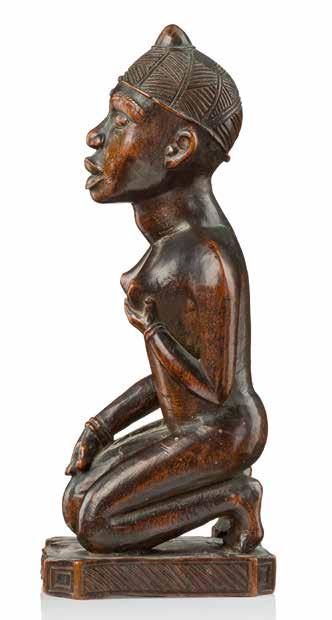
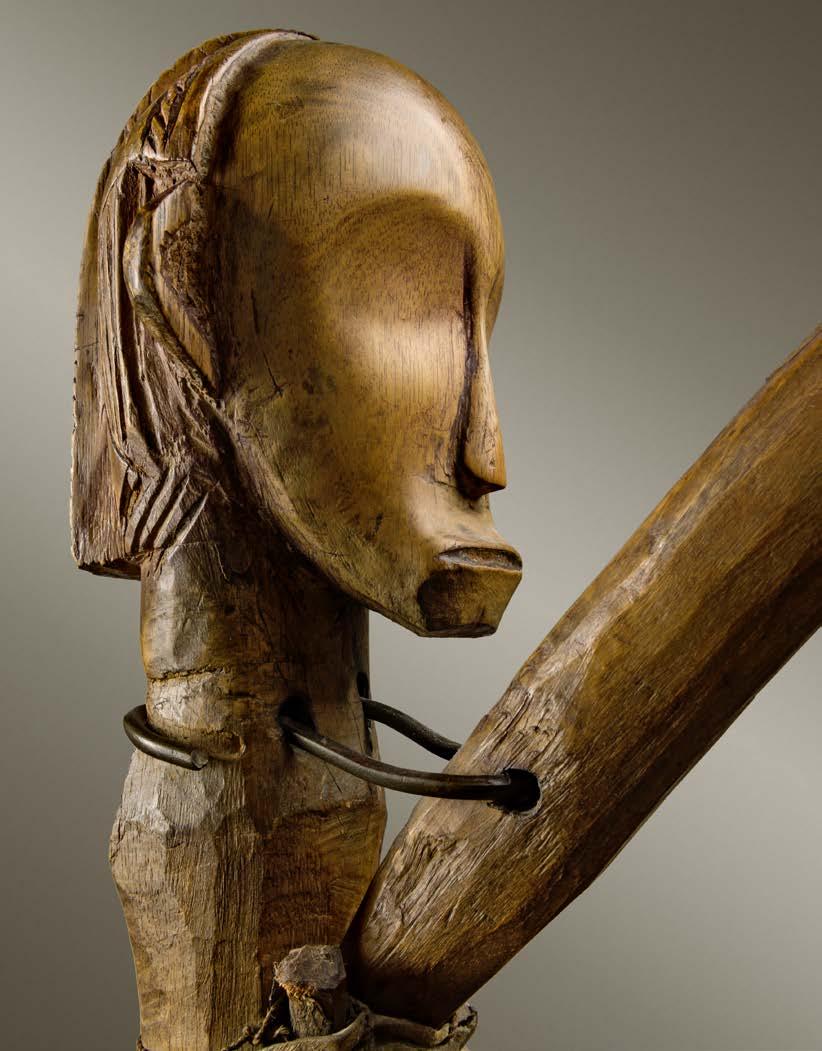
(Auction 217)
Vol I Lots 1 – 155
From Private Collections
Vol II Lots 156 – 370 Africa, Oceania and Pre-Columbian Art
Würzburg, Auktionshaus
12 November 2022 – 14 Uhr

9 bis 11 November 2022 von 10 bis 17 Uhr und nach Vereinbarung
Wurzburg, Auction House
12 November 2022 – 2 pm
Preview
November 9 until 11, 2022 from 10 am to 5 pm and by appointment

Dr. David Zemanek Geschäftsführung Ethnologe / Auktionator Afrika / Ozeanien
Petra Felder M.A. Kunstgeschichte Redaktion / Marketing
Sabine Reis M.A.Kunstgeschichte Katalogbearbeitung
Kunstauktionshaus Zemanek-Münster 97070 Würzburg Hörleingasse 3 - 5 / Schildhof 2 Tel. +49 9 31 1 77 21 / Fax. +49 9 31 1 77 36 info@tribalart.de / www.tribalart.de
Dr. David Zemanek e.K. Öffentlich bestellter und vereidigter Kunstauktionator für außereuropäische Kunst
Redaktion / Editor: Petra Felder M.A.
Photos: Thomas Lother & Volker Thomas, Nürnberg
Layout: Beatrix Radke, design & art, Gerbrunn

Print: bonitasprint, Würzburg Umschlag/cover: Lot 291 , Lot 293
Repräsentanten / Representatives Belgien & Niederlande Tel. 0032 (0)475 965 220 USA






Zemanek-Münster c/o Ancient Art – Art of Eternity 303 East 81st Street, New York City, NY 10028
Bankverbindung / Bank details IBAN DE06 7905 0000 0000 0366 99 SWIFT (BIC) BYLADEM1SWU
158-170
172-180
181-185
Papua New Guinea 186-192 New Caledonia 193-194
Islands
195
196-197
198-199 Mexico 200-203
204
205
206-212
213-214 Liberia 215-218 Sierra Leone 219-223 Mali 224-231 Burkina Faso
232-234
Côte d‘Ivoire 235-252 Ghana
253-255 Togo 256-257
Benin............................................. 258 Nigeria 259-280
Hinweis: Objekte der Offerte stammen ausschließlich von ethnischen Volksgruppen und sind für die Verwendung inner halb der Ethnie gefertigt worden; Objekte der Colon sowie Auftragswerke sind in die frühe Zeit zu verorten.
Mit (*) gekennzeichnete Lose betreffen Objekte, die dem Kul turgüterschutzgesetz (KGS-Gesetz) unterliegen bzw. CITESpflichtig sind. Sie stehen im Einklang mit der CITES Resolution 10.10 (Rev.CoP18) und den Verordnungen (EU) Nr. 2021/2280 , 2021/C 528/03 sowie (EG) Nr. 865/2006 der Komission mit Durchführungsbestimmungen zur Verordnung (EG) Nr. 338/97 des Europäischen Rates vom 09.12.1996 über den Schutz von Exemplaren wildlebender Tier- und Pflanzenarten. Da diese hier gekennzeichneten Objekte unter die streng begrenzten Ausnahmen fallen, dürfen sie innerhalb der EU angeboten werden. Eine Ausfuhrgenehmigung in Drittländer kann für Objekte aus geschützten Materialien nur unter strengen Bedingungen erteilt werden.
Cameroon Grassfields
281-283 Cameroon 284-290 Gabon
291-296 D.R. Congo 297-354 Angola
355-358 Chad 359 East Africa
360 Kenya 361 Ruanda 362 Tanzania 363-364 Malawi 365-366 Zambia 367 Mozambique 368-369 Namibia
370
Please note: All items have been made by the ethnic group and for use in the ethnic group. Figures of the Colon as well as commissened art works are classified as objects of the early period.
Some items of this offer can be marked with an asterisk (*). This objects are subject to the UNESCO Cultural Heritage Protection Act resp. to CITES. Objects liable to CITES fullfil the requirements of the CITES Resolution 10.10 (Rev.CoP18) and the european regulations (EC) No 2021/2280, 2021/C 528/03 as well as the Commission Regulation (EC) No 865/2006 of 4 May 2006 laying down detailed rules con cerning the implementation of Council Regulation (EC) No 338/97 of 9 December 1996 on the protection of species of wild fauna and flora by regulating trade therein. As the objects marked here fall under the strictly limited exceptions, they may be offered within the EU. Export licenses in third countries for objects containing or made of protected mate rials are only granted under stringent conditions.
RUSSIA, SIBERIA, NANAI / NIVKH
156 Schamanenfigur Holz, Tierhaut, Metall
Shamanic figure wood, animal skin, metal H: 32 cm

Provenance German Collection € 1.000 - 2.500
157 Halbmaske der „nuo“- Oper Holz, Farbreste, Sockel
Semi mask of the „nuo“ opera wood, paint residues, base H: 35 cm
Provenance Belgian Private Collection € 1.400 - 2.500

158 Hut „jingasa“, späte Edo-Zeit, Mitte 19. Jahrhundert Holz, Lack
Hut eines Fußsoldaten mit Fami lienwappen „mon“ in Gold- und Schwarzlack auf einem Grund aus zerkleinerten Muschelschalen („ao gai“). Die Unterseite rot lackiert mit Polstervorrichtung und Riemen

Hat „jingasa“, late Edo period, Mid 19th century wood, lacquer Hat of a foot soldier with family „mon“ on a ground of crushed mussel shells („aogai“). The underside lacquered in red with upholstery device and straps
D: 42 cm
Provenance Herbert Hamak, Hammelburg, Germany € 450 - 900
159 Samurai Helm „kabuto“, Edo-Zeit (1603-1868)
Eisen, Holz, Lack, Schnürung, Stoff, Grathelm aus zweiunddreißig Eisen platten, Schutzelemente an den Sei ten („fukigaeshi“) mit Familienwappen („mon“) und fünfteiligem Nacken schutz („shikoro“)
Samurai helmet „kabuto“, Edo period (1603-1868)
iron, wood, lacquer, lacing, fabric, Twenty-three-plate helmet, protective elements on the sides („fukigaeshi“) with family „mon“ and four-part neck guard („shikoro“)


H: 28,5 cm
Herbert Hamak, Hammelburg, Germany € 800 - 1.500
160 Nõ - Theatermaske einer schönen jungen Frau „zõ“ oder „zõ onna“
Holz, Farbe, handschriftl. aufgebrach te Schriftzeichen „kanji“: „Nõ-Maske einer edlen Dame“ und zwei Label mit Schriftzeichen „kanji“: „sitzen“ oder „Sitz“ und „zwei“ oder „zweites“
Das „nõ“- Spiel entwickelte sich im 14. Jahrhundert aus einer antiken Tradition reli
giöser Tänze und burlesker Spiele, die in Tempeln aufgeführt wurden. Im Laufe der Zeit prägten sich zwei eng miteinander verbundene eigenständi ge Formen heraus: das ernste „nõ“Drama und die humorvolle „kyõgen“-Posse. Das Hauptan liegen der „nõ“- Kunst besteht in der Vermittlung von „yugen“, was etwa soviel bedeutet wie „Schönheit“, „Tiefe der Emp findung“, „Anmut“, „Eleganz“.
Es kommt darauf an, dem Zuschauer Charakter und Geschehen durch nur geringe Andeutung in Geste und Be wegung nahe zu bringen, nicht etwa darauf, realistisch zu spielen.
Nõ theater mask of a beautiful young woman „zõ“ or „zõ onna“ wood, paint, handwritten characters „kanji“: „Nõ-mask of a noble lady“ and two labels with characters „kanji“: „sit ting“ or „seat“ and „two“ or „second“.
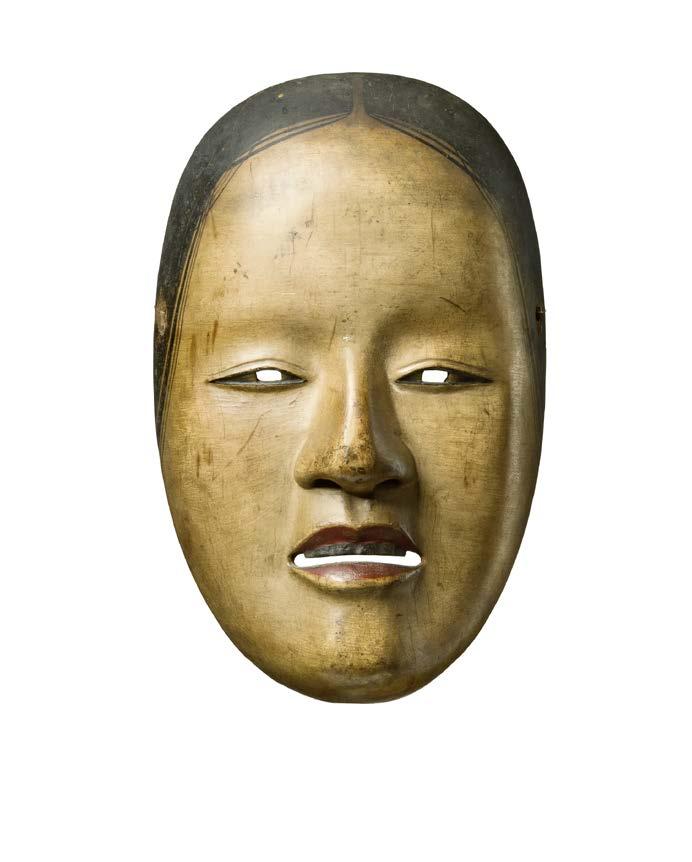
The „nõ“- theatre evolved in the 14th century from the antique tradition of religious dances and burlesque plays, which used to be performed in temples.
In the course of the time two inde pendant forms developed: the severe „nõ“ drama and the humorous „kyõ gen“ burlesque. The primary concern of the „nõ“ art is to convey „yugen“ to the audience, which means as much as „beauty“, „depth of sentiment“, „gra
cefulness“, „elegance“. It is essential to convey characters and events through minimal gestures and movements, but not to play in a realistic manner.
H: 21,3 cm
Vgl. Lit.: Perzynski, Friedrich, Japani sche Masken, Zweiter Band, Berlin, Leipzig 1925, p. 206
900 - 1.800
161 Dämonenmaske „tobide“ des „nõ“ - Theaters
Holz, Farbe, Metall, handschriftl. auf gebrachte Schriftzeichen „kanji“: „Nõ - Maske eines Monsters mit einem Affenkopf, einem Schlangenschwanz und Händen und Füßen eines Tigers“ und Label mit Schriftzeichen „kanji“: „drei“ oder „dritter“
Kennzeichen der „tobide“- Masken sind die großen runden Metallaugen.
Demon mask „tobide“ of the „nõ“ theater wood, paint, metal, handwritten cha racters „kanji“: „Noh mask of a mons ter with a head of monkey, a tail of
162 Maske eines alten Mannes Holz, Gips, Farbpigmente, Sockel Vermutlich handelt es sich bei die sem faltigen Gesicht mit asymmetri schen Gesichtszügen und zugespitz ten Lippen um eine Maske aus dem „kyõgen“- Theater. Im Gegensatz zum ernsten „nõ“- Drama ist das „kyõgen“ eine Art Komödie, bei der Masken verwendet werden, die das Publikum zum Lachen bringen sollen. Daher ha ben die meisten „kyõgen“- Masken einen fröhlichen Ausdruck oder sind extrem verzerrt.


Mask of an old man wood, gypsum, color pigments, base Presumably, this wrinkled face with asymmetrical features and pointed lips is a mask from the „kyõgen“ thea ter. In contrast to the serious „nõ“ dra ma, the „kyõgen“ is a type of comedy theater that uses masks designed to make the audience laugh. Thus, most „kyõgen“ masks have a happy expres sion or are extremely distorted.
H: 19 cm
Provenance Belgian Private Collection
€ 900 - 1.500
snake and hands and feet of tiger“ and label with characters „kanji“: „three“ or „third“ Characteristic of the „tobide“ masks are the large round metal eyes.
H: 20,5 cm
Vgl. Lit.: Perzynski, Friedrich, Japani sche Masken, Zweiter Band, Berlin, Leipzig 1925, p. 188 ff.
€ 800 - 1.500
163 Maske „tengu“ („Langnase“) Holz, rote Pigmentreste, rest., Sockel
Mask „tengu“ („Long nose“) wood, red pigment residues, rest., base
H: 18,5 cm
Provenance Belgian Private Collection € 1.000 - 2.000
164 Maske „tengu“ („Langnase“)
Holz, 2-tlg., Reste von roter und goldfarbener Bemalung, Tierhaar, beschriftet „18.3“, rest.
Mask „tengu“ („Long nose“) wood, two-part, remains of red and gold painting, animal hair, inscribed „18.3“, rest.

H: 27,5 cm
Provenance Luciano Lanfranchi, Milan, Italy
€ 700 - 1.200
JAPAN
165 Deformationsmaske
Holz, Tierhaar, Pigmentreste, Sockel
Deformation mask wood, animal hair, pigment remains, base H: 22 cm
Provenance Belgian Private Collection € 900 - 1.500
Herbert Hamak, Hammelburg, Germany
JAPAN
166 Weiblicher Dämon mit Kind
Pinselzeichnung auf Papier, koloriert, im Passepartout, vergl. / ger.
Female demon with child brush drawing on paper, colored, in passepartout and glazed frame
M: 36 cm x 23,5 cm/61,5 cm x 49 cm (frame)
€ 400 - 1.000
JAPAN
167 Schildkröten und Fische im Wasser
Pinselzeichnung auf Papier, koloriert, Schriftzeichen, rot gestempelte Sig natur, im Passepartout, vergl. / ger.
Turtles and fish in water brush drawing on paper, colored, cha racters, signature stamped in red, in passepartout and glazed frame
M: 25 cm x 53 cm / 50 cm x 73 cm (frame)
Herbert Hamak, Hammelburg, Germany
€ 250 - 500
Holz (Zypresse / Zelkove „keyaki“), „Jizai kagi“ vom sogenannten „daikoku“-Typus, mit dachförmiger Kappe und j-förmig gebogenem Haken, aus einem Block geschnitzt und mit seitlichen Aufhängezapfen versehen. Die Patina ist dunkelbraun bis schwarz und hat tiefe Rillen in der Kralle, die von der Abnutzung durch das Seil herrühren.
Dieser Haken, mit dem einst der Kes sel über dem Herd eines japanischen Hauses aufgehängt wurde, ist ein schönes Beispiel für Handwerkskunst im „Mingei“- Stil.
Das Konzept des „Mingei“, das mit „Volkshandwerk“ oder „Volkskunst“ übersetzt werden kann, wurde ab Mitte der 1920er Jahre von dem Phi
losophen und Ästheten Yanagi Setsu (1889-1961) entwickelt. „Mingei“ ist das „Handwerk der einfachen Leu te“. Yanagi vertrat die These, dass die Schönheit in gewöhnlichen und alltäglichen Gebrauchsgegenstän den zu finden sei, die von namenlo sen und unbekannten Handwerkern hergestellt werden - im Gegensatz zu höheren Kunstformen, die von nam haften Künstlern geschaffen werden.
Kettle hanger „jizai kagi“ („jizaikake“) wood (cypress / zelkova „keyaki“), „Jizai kagi“ of the so-called „daikoku“ type, with roof-shaped cap and curled hook, carved from a single block and fitted with side suspension pegs. The patina dark brown to black and with deep grooves in the crook from rope

wear.
This hook, once used to hang the kettle over the hearth of a Japanese home, is a fine example of „Mingei“ craftsmenship.
The concept of „Mingei“, which can be translated as „folk craft“ or „popular art“, was developed from the mid1920s in Japan by the philosopher and aesthete, Yanagi Setsu (1889-1961).
„Mingei“ is the „crafts of the ordinary people“. Yanagi argued that beauty was to be found in ordinary and uti litarian everyday objects made by nameless and unknown craftsmen, as opposed to higher forms of art created by renowned artists.
23 cm; B: 22,5 cm; T: 6 cm
700 - 1.400
168 Affenskulptur „okimono“, Taishõ - Shõwa Zeit , ca. 1912-1940 Holz, Schnitzerzeichen des Künstlers auf der Unterseite der Basis: „Mu“ (unbekannt)
Schöne Darstellung eines japani schen Makaken („Macaca fusca ta“) oder Schnee-Affen. Eine Arbeit von kraftvoller skulpturaler Form mit klaren Konturen und schöner Rundumansicht.
Monkey sculpture „okimono“, Taishõ - Shõwa period, ca. 1912-1940 wood, carver‘s mark on the underside of the base: „Mu“ (unknown)
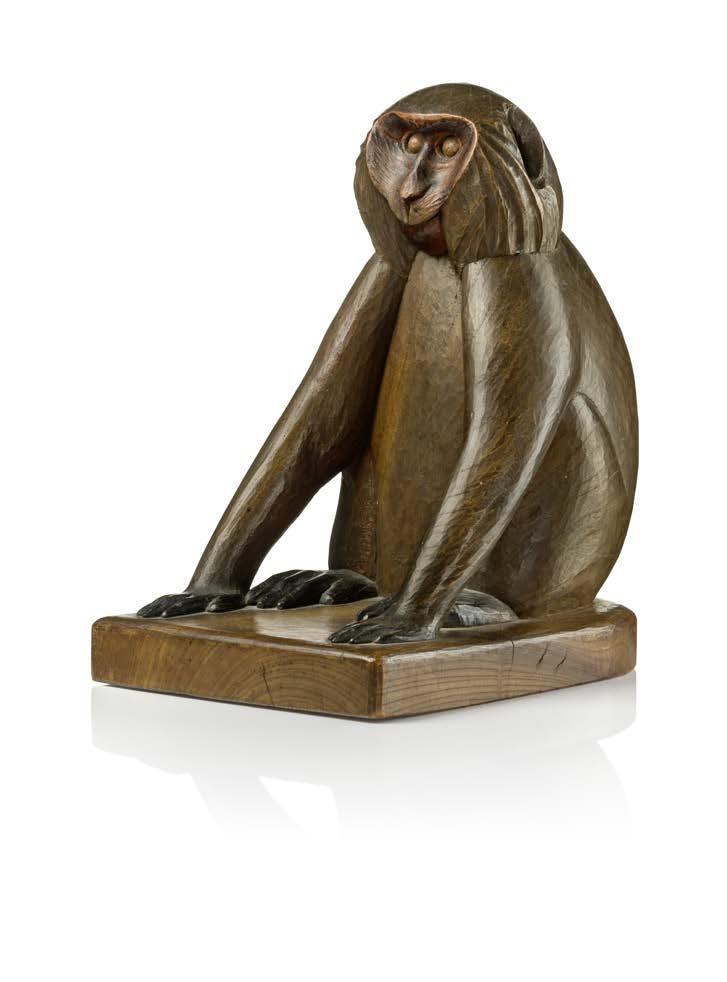
Beautiful depiction of a Japanese macaque („Macaca fuscata“) or snow monkey. A work of powerful sculp tural form with clear contours and beautiful all-round view.
H: 27,5 cm; T: 26,5 cm
Provenance Galerie Mingei, Paris, France
3.500 - 8.000
„isho dansu“, ca. 1930-40
Fronten: Kastanie („kuri“), innen: Zeder („sugi“), handgeschmiedete Griffe und Beschläge aus Gußeisen mit Schwarzlack Finish, Front mit vier großen und fünf kleinen Schubläden, Transportgriffe
„Tansu“ sind traditionelle japanisches Möbelstücke aus leichtgewichtigen Holzarten, die meist transportabel waren, entweder getragen auf Schul terstangen, mit Handgriffen oder gerollt auf eingebauten Holzrädern.
Im Falle der stets drohenden Gefahr eines Erdbebens oder Feuers konnten die „tansu“ mit ihrem wertvollem In halt schnell gerettet werden. „Tansu“ wurden zur Aufbewahrung verschiedenster Gegenstände ver wendet, von Teeutensilien, medizi nischen Kräutern und Küchenuten silien bis hin zu Geschäftsbüchern und Schwertklingen. „Isho dansu“ dienten zur Lagerung der speziellen ausladenden zeremoniellen Kleidung („Kimonos“).
Clothing chest „isho dansu“, ca. 1930-40 fronts: chestnut („kuri“), interior: cedar („sugi“), cast iron mounts and handles finished in blackened burned lacquer, front with four large and five small front drawers, transport handles
„Tansu“ are traditional Japanese pie ces of furniture made of lightweight woods, which were usually transpor table, either carried on shoulder po les, with handles or rolled on built-in wooden wheels. In case of the ever-

present danger of an earthquake or fire, the „tansu“ and their valuable contents could be quickly rescued. „Tansu“ were used to store a wide variety of items, from tea utensils, medicinal herbs and kitchen utensils to account books and sword blades. „Isho dansu“ were used to store the special expansive ceremonial clothing („kimonos“).
H: 91 cm; B: 106 cm; T: 41 cm
Herbert Hamak, Hammelburg, Germany
€ 450 - 900
Diese kleinen Kopfskulpturen wurden von Kopfjägern an ihren Trophäenkör ben befestigt. Ihre Anzahl soll über die Menge der erbeuteten Köpfe Aufschluss gegeben haben. Sie wur den auch als Anhänger um den Hals getragen.

This small wooden heads were used as chest ornaments by head-takers or attached to head-takers baskets.
Along with monkey skulls and boar‘s tusks they were often used as a tally of the number of heads taken.
H: 10 cm
Vgl. Lit.: Jacobs, Julian, The Nagas, London 1990, p. 186 ff.
€ 1.000 - 2.000
Small seated figure wood
H: 17 cm
€ 600 - 1.200

„Hampatong“ können als Abbilder namentlich bekannter Vorfahren angesehen werden. Bei Totenfesten wurde für jeden Verstorbenen ein „hampatong“ errichtet.
Zum anderen fungierten sie als Wäch terfiguren, die überall dort aufgestellt wurden, wo sich möglicherweise übelwollende Geister einschleichen könnten: vor den Eingängen von Langhäusern oder auf Dorfplätzen in „pataho“- Heiligtümern usw.

„Hampatong“ can be seen as effigies of ancestors known by name. At mor tuary feasts a „hampatong“ is set up for each dead person.
On the other hand, they function as guardian figures, which are erected wherever malevolent spirits are like ly to appear: in front of longhouse entrances, or in village squares in „pataho“ sanctuaries etc.
H: 61 cm
Provenance Private Collection, Baden-Württem berg, Germany
Vgl. Lit.: Feldman, Jerome, The elo quent dead, Los Angeles 1985, p. 118 f.
177 Westenförmige Rüstung eines Nias-Kriegers „baru oröba“ Leder, geschwärzt, Rattan Traditionell aus elf Stücken gefer tigt. Das schmale Mittelstück am Rücken in einer Verzierung aus zwei runden Ornamenten endend, die den Hals schützen sollen.
Vest-shaped armor of a Nias warrior „baru oröba“ leather, blackened, rattan Traditionally made of eleven pie ces. The narrow central sheet at the back ending in a decoration of two

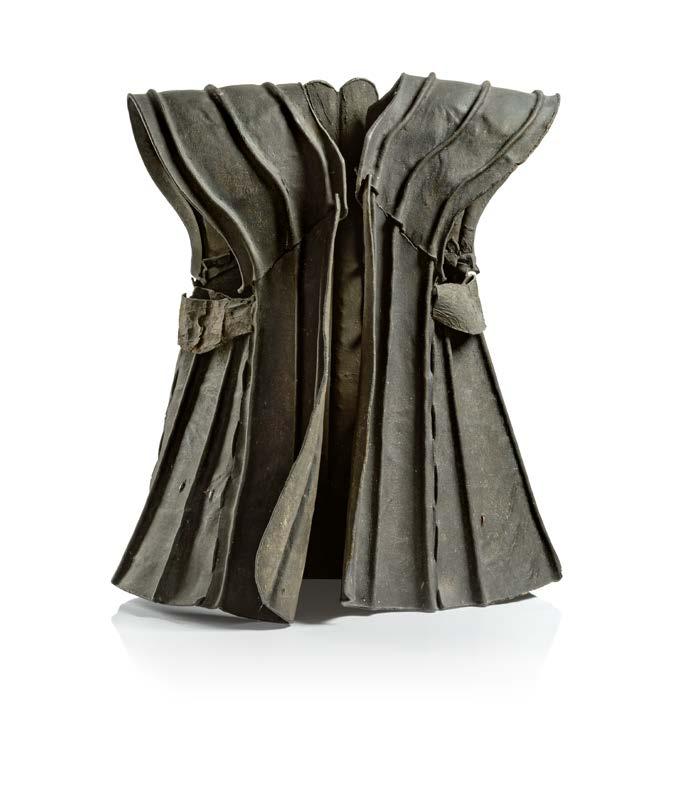
circular ornaments, meant to protect the neck.
Private Collection, BadenWürttemberg, Germany
H: 60 cm; B: 50 cm (shoulders)
Vgl. Lit.: Nias, Tribal Treasu res, Cosmic reflections in stone, wood and gold, Delft 1990, p. 288, ill. 212
€ 1.200 - 2.500
175 Ahnenfigur „adu zatua“ Holz, Sockel
Ancestor figure „adu zatua“ wood, base
H: 26,5 cm
Provenance German Collection
€ 600 - 1.200
176 Ahnenfigur „adu zatua“ Holz, Sockel
Ancestor figure „adu zatua“ wood, base


H: 31,5 cm
Provenance Herbert Hamak, Hammelburg, Germany
€ 1.000 - 2.500

178 Türflügel mit Echsen-Motiv „ilik“ Holz
Tür von der Fassade eines Toba Hauses „sopo“. Der obere Teil dieses Gebäude typs diente als Getreidespeicher für den Reis der Familie.
Das Echsenmotiv „ilik“ sollte bewirken, dass die Gottheit „Boraspati ni Tano“ der Ernte im Speicher ihren wohlwollenden Schutz gewährte.
M: 98 cm x 62 cm
South German Private Collection
Door panel with lizard motif „ilik“ wood

Door from the facade of a Toba „sopo“. The upper section of this type of building served as a granary for the family rice.
The lizard motif „ilik“ was destined to bring the harvest under the benevo lent protection of the deity „Boraspati ni Tano“.
Vgl. Lit.: Barbier, Jean Paul & Douglas Newton (ed.), Islands and Ancestors, Munich 1988, p. 220, Plate 14
€ 800 - 1.500
Photos: Tropenmuseum Amsterdam (l); J. Winkler, Die Toba-Batak auf Sumatra, Stuttgart 1925 (r)
Der „singa“ wird mit dem Unterwelt drachen „Naga Padoha“ gleichgesetzt und steht in engem Zusammenhang mit dem Urzeitgeschehen, was auch in den zahlreichen Anspielungen auf den Welten- und Lebensbaum in der Ornamentik deutlich wird.
Der „singa“ findet sich als Schmuck ornament und magisch wirksame Darstellung in nahezu allen Bereichen der Toba-Kultur, vor allem an Hausfas saden, wo er Unheil, Krankheiten und sonstige böse Einflüsse vom Haus und seinen Bewohnern fernhalten soll.
Facade ornament „singa head“ wood, polychrome paint residues
The „singa“ is equated with the un derworld dragon „Naga Padoha“ and is closely related to prehistoric events, which is also evident in the numerous allusions to the world tree and tree of life in the ornamentation.
The „singa“ is found as a decorative ornament and magically effective re presentation in almost all areas of Toba culture, especially on house facades, where it is supposed to keep away mi schief, diseases and other evil influen ces from the house and its inhabitants.

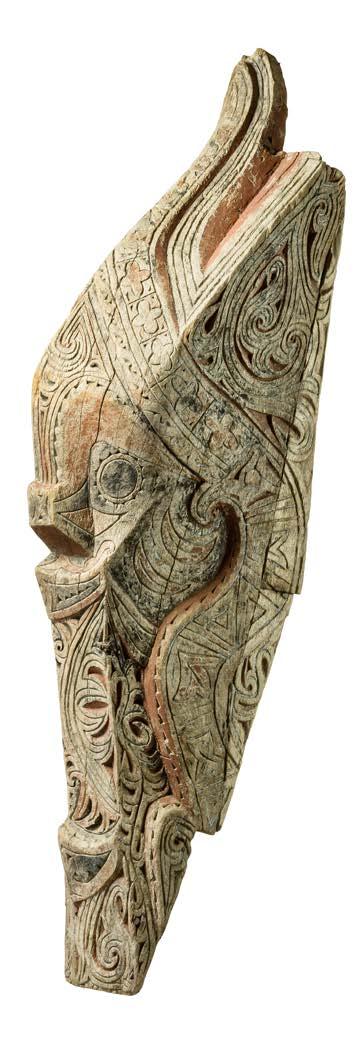
Stoffers, Kiel,
Vgl. Lit.: Sibeth, Achim, Mit den Ahnen leben, Stuttgart 1990, 119 ff.
180 Kopfstück eines Zauber stabes
Gelbguss, Echthaar Kopfstück eines Zauberstabes „tung kot malehat“ oder „tunggal pana luan“, die zu den wichtigsten Utensi lien der „datu“ Priester gehören. In geheimen Ritualen mit magischen Substanzen „pupuk“ aufgeladen, werden sie zu Objekten von großer Macht, die zum Wohlergehen der Ge meinschaft eingesetzt werden.
Headpiece of a magic staff brass, real hair
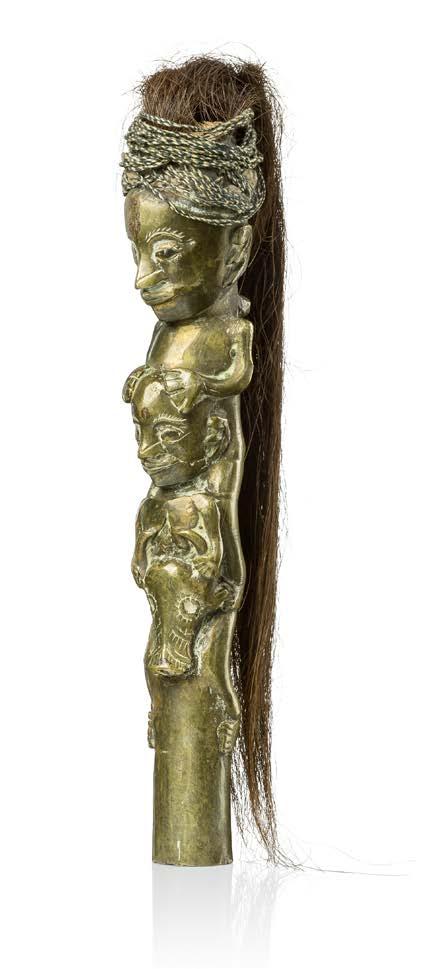
Head piece of a magic staff „tung kot malehat“ or „tunggal panaluan“, which belong to the most important utensils of the „datu“ priests.
Charged with magical substances „pupuk“ in secret rituals, they become objects of great power used for the well-being of the community.
H: 19 cm € 450 - 900
181 Figural beschnitzter Löffel Horn Gesichtszüge und Körper dieser Fi gur sind auffallend detailliert ausge arbeitet, naturalistische Tendenzen (Schlüsselbein, Hände, Zehen) erkenn bar. Besondere Sorgfalt wurde auch auf die Rückseite von Figur / Löffel verwandt.
Diese kunstfertige Arbeit stammt von einem Meister der Schnitzkunst, mög licherweise aus dem Umkreis / Werk statt des Tagiling von Kababuyan.
The facial features and body of this figure are worked out in striking detail, naturalistic tendencies (collar bone, hands, toes) are recognizable. Particular care was also taken on the back of the figurine / spoon.
This skillful work comes from a master carver, possibly from the circle / work shop of Tagiling from Kababuyan.
Vgl. Lit.: Casino, Eric S., The people and art of the Philippines, Los Ange les 1981, ill. 184
€ 1.500 - 3.000
beschnitzter Löffel
Die Löffel der Ifugao („pakko“, „idu“) werden in speziellen Körben (ayud“) aufbewahrt. Auf Reisen tra gen die Männer sie in ihren Hüftta schen bei sich.
Die meisten Löffel sind mit sitzen den oder stehenden menschlichen Figuren beschnitzt, die bisweilen als Ahnenfiguren oder Gottheiten be zeichnet werden.
Ifugao spoons („pakko“, „idu“) are stored in special baskets („ayud“) when not in use and males carry them in their hip bags while away from home.
The majority of spoons depict ei ther seated or standing human fig ures, sometimes referred to as an cestor figures or deities.

183 Figural beschnitzter Löffel (fig. s. Seite / page 21) Holz, geschwärzt, stellenweise kleb rige Patina
Figurally carved spoon wood, blackened, sticky patina in places
H: 22,5 cm
Provenance American Private Collection € 800 - 1.500
Lot 184 Lot 185
184 Figural beschnitzter Löffel Holz
Figurally carved spoon wood
H: 15,5 cm
Provenance
American Private Collection Vgl. Lit.: Casino, Eric S., The people and art of the Philippines, Los Ange les 1981, ill. 209
€ 500 - 1.000
185 Figural beschnitzter Löffel Holz
Figurally carved spoon wood H: 17,5 cm
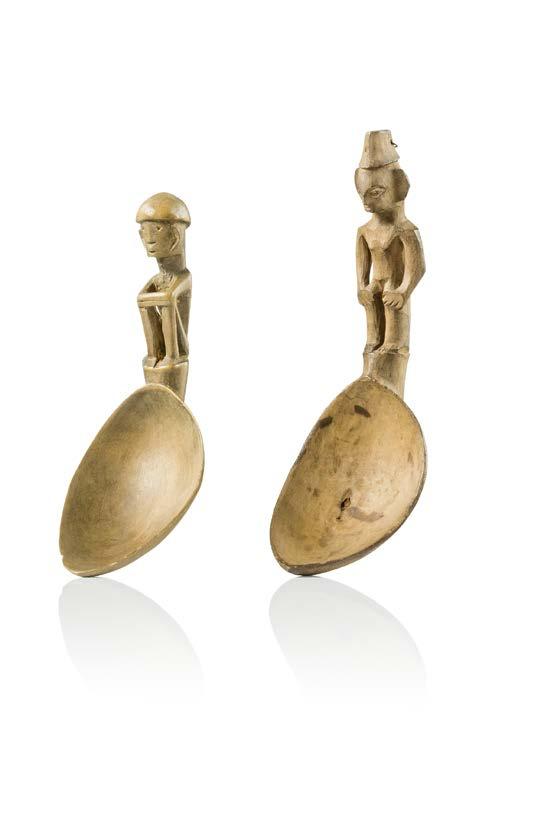
American Private Collection € 600 - 1.200
187
PAPUA NEW GUINEA
186 Besonders schöner Keulen kopf schweres hellgraues Gestein
Particularly beautiful club head heavy light grey stone H: 6,5 cm; D: 10,5 cm
Provenance John & Marcia Friede, Rye, USA € 600 - 1.200
PAPUA NEW GUINEA, ABELAM
187 Männliche Kultfigur Holz, Pigmente, Sockel

Male cult figure wood, pigments, base H: 103,5 cm
Private Collection, Baden-Württem berg, Germany
€ 1.200 - 2.500
Der Besitz solch großer Spatel war be deutenden Häuptlingen vorbehalten.
This large spatula was certainly the prerogative of a leading chief.

Frank Reiter, Berlin, Germany
Vgl. Lit.: Hamson, Michael, Art of the Massim & Collingwood Bay, Los An geles 2009, p. 204, ill. 125
1.000
Geistertafeln wurden in den Männer häusern aufbewahrt, in denen jeder Familienklan eine eigene Nische besitzt.
Durch rituelle Bemalung mit rotem Ocker wurden die Bretter mit magschen Kräften „imunu“ aufgeladen, durch das Beiseitestellen von Ahnen schädeln wurden diese Kräfte noch verstärkt.
Die ihnen innewohnenden Geister wurden angerufen und sollten die in die Schlacht ziehenden Männer schützen und die Feinde verwirren. Sie sollen auch für das Jagdglück eine Rolle gespielt haben.
Spirit boards were kept in the mens houses, where each family clan has its own niche.
The painting of the carved boards with red ochre confered „heat“, menace, or dangerous power „imunu“ on these objects, and the addition of skulls, and age itself, increased „imunu“.
It was told that spirits of such boards would go into battle with men who whorshipped it - both protecting them and causing confusion amongst the enemy. Furtheron the magical powers still had relevance to successful hunting.
PAPUA NEW GUINEAGULF
Geistertafel „gope“ Holz, Pigmente
board

190 Zwei Kanu-Bugverzierungen Holz, rest.
Frühe Beispiele für kunstvoll ge schnitzte Bugverzierungen, wie sie für Fischerkanus von Walamo angefertigt wurden.
Traditionell sind sie mit den Köpfen von „Friar birds“ („Lederköpfe“) be schnitzt, die von den Einheimischen als Boten ihrer Vorfahren und als
Wächter über die Fischer auf dem Meer angesehen werden.
Two canoe prow ornaments wood, rest.
Early examples of intricately carved prow ornaments as made for Walamo fishing canoes.


Traditionally, they are carved with the head of the „Friar bird“ („leather
head“), which is believed by the lo cal people to be a messenger from their ancestors, as well as guardians watching over the fishermen at sea.
L: 55 cm & 57,5 cm
American Private Collection € 2.000 - 4.000
191 Zeremonielle Schale Holz, 2-tlg., Kalk, handschriftl. aufge brachte Inventarnr. „MI98“, rest. Sehr schöne und originelle MassimSchale mit klassischer anthropomor pher Figur und typischem ornamen talem Dekor.
Ceremonial bowl wood, 2-piece, lime, handwritten in ventory no. „MI98“, rest. Very beautiful and original Massim
bowl with classical anthropomor phic figure and typical ornamental decoration.

H: 26 cm; T: 36 cm; D: 17,5 cm / 18,5 cm (bowl)
Christie‘s New York, 13 October 1978, Lot 281
€ 2.500 - 5.000
192 Bildnis eines Geisterkopfes Balsaholz, Kalk, roter und gelber Ocker
Portrait of a spirit head balsawood, lime, red and yellow ochre
H: 26 cm € 1.000 - 2.000
Canarium-Nußschale, mit schwarzer tonartiger Masse übermodelliert und mit Nautilusmuschel-Einlagen ver ziert, je vier Stränge mit aufgezogenen Muschelscheibchen und (menschl.) Zähnen an den Enden (einer fehlt), Spangen zur Befestigung (Horn)
Pair of ear ornaments
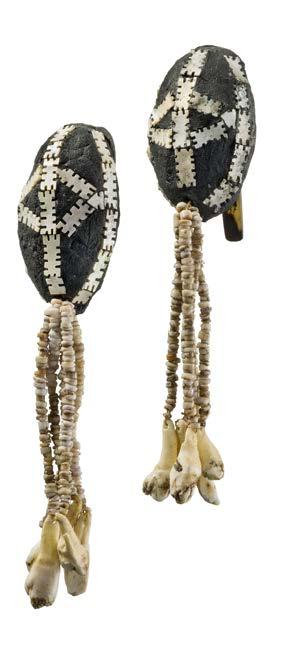
canarium nut shell, overmodeled with black clay-like mass and deco rated with nautilus shell inlays, four strings each with applied shell discs and (human) teeth at the ends (one missing), clasps for attachment (horn)
L: 14 cm / 15 cm
Abe and Paula Rossman, New York, USA
Vgl. Lit.: Roger Neich & Fuli Pereira, Pacific Jewelry and Adornment, o.O. 2004, p. 109
€ 1.500 - 3.000
Holz, Keule mit feinen Zickzack-Gra vuren, durch Kalk akzentuiert, L: 91,5 cm; zwei schmucklose Exemplare, L: 88,5 cm & 78,5 cm
Lot 195
Holz, Sammlungsetikett: „Collection D‘Armes De V. Coupard Haiphong - Tonkin“
War club hardwood, collection plaque: „Collec tion D‘Armes De V. Coupard Haiphong - Tonkin“
L: 87 cm
hardwood, club with fine zigzag en gravings accentuated by lime, l: 91,5 cm; two unadorned specimens, l: 88,5 cm & 78,5 cm
Private Collection, Baden-Württem berg, Germany
€ 800 - 1.500
Provenance V. Coupard, Haiphong / Tonkin, Vietnam
Private Collection, Baden-Württem berg, Germany
Vgl. Lit.: Newton, Douglas (ed.), Arts of the South Seas, New York 1999, p. 305, ill. 13
€ 500 - 1.000
Das Schwirrholz ist ein uraltes rituel les Musikinstrument und ein Gerät, das zur Kommunikation über große Entfernungen verwendet wurde.
Läßt man Schwirrhölzer an einer Schnur schnell rotieren, erzeugen sie - je nach Größe, Geschwindigkeit und Fadenlänge - Töne in unterschiedli chen Frequenzen. Sie wurden im Kult verwendet und wurden als Stimmen von Ahnen und Geistern interpretiert.
Bullroarer wood, red ochre
The bullroarer is an ancient ritual mu sical instrument and a device histo rically used for communicating over greatly extended distances.
Attached to cord and swirled around very fast they produce a tone in va rious frequences. They were used in the cult and were interpreted as the voices of ancestors and spirits.
76 cm
Evan Maurer Collection, Minneapolis, USA
2.500 - 5.000
Holz, roter Ocker, handschriftl. aufge brachte Inventarnr. „2048“
Messenger stick wood, red ochre, handwritten inven tory no. „2048“
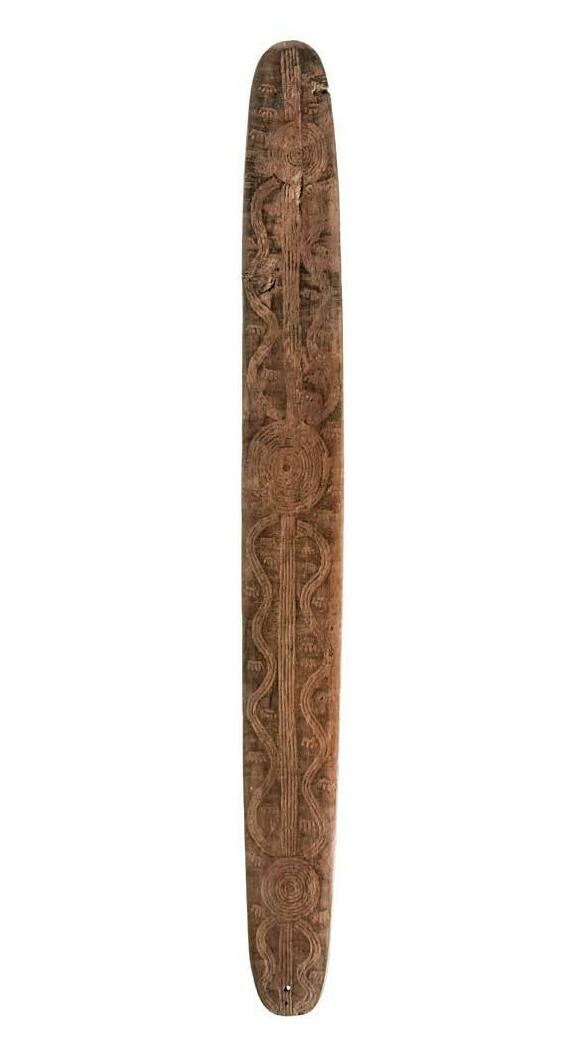
32 cm
800 - 1.600

Lot 200
198 Keule mit Flechtwerk
„kô kam´yr“ Holz, Pflanzenfaser, Baumwollfaden, Flechtwerk „kam´yr“ aus schmalen, dunkelbraunen Streifen von der Rin de eines Aronstab-Gewächses und feinen, länglichen Palmblattstreifen. Das Flechtwerk ist tlw. dunkel einge färbt mit Bienenwachs, das auch als Klebstoff dient.
Club with weave „kô kam´yr“ wood, plant fibre, cotton string, Wickerwork „kam´yr“ made of narrow, dark brown strips from the bark of an arum plant and fine, elongated palm leaf strips. The wickerwork is partly dyed dark with beeswax, which also serves as an adhesive.
L: 128 cm
Provenance Peter Stoffers, Kiel, Germany
€ 200 - 500
199 Lanze / Speer Holz, Eisen, Streifen von Palmblattrip pen, kittartige schwarze Masse
Lance / spear wood, iron, strips of ribs of palm lea ves, putty-like black mass
L: 163 cm
Provenance Peter Stoffers, Kiel, Germany
€ 200 - 500
MEXICO, CENTRAL HIGH LANDS, TLATILCO
200 Zwei weibliche Figurinen, Mittlere Vorklassik, ca. 1200 bis 500 v. Chr.
Keramik, Pigmentreste, Sockel Tlatilco ist ein archäologischer Fund
Lot 201
ort im Tal von Mexiko, der ab ungefähr 1500 v. Chr. besiedelt war. Berühmt und namensgebend wurde der Ort für seine typischen Tonstatuetten, die vor allem Frauen mit unterschiedlichen Trachten und Frisuren darstellen. Die se wurden wahrscheinlich bei Frucht barkeitskulten verwendet.
Two female figurines, Middle Pre classic, ca. 1200 to 500 BC ceramic, pigment residues, base Tlatilco is an archaeological site in the Valley of Mexico that was inha bited from around 1500 BC. The site became famous and gave its name to its typical clay statuettes, which mainly depict women with different costumes and hairstyles. These were probably used in fertility cults.
H: 7 cm & 8 cm
Jean Roudillon, Paris, France
Private Collection, Baden-Württem berg, Germany (ca. 1976)
€ 700 - 1.400
201 Drei weibliche Figurinen Keramik, weißes Pigment, jeweils gesockelt
a) Tlatilco, weibliche Figur, Mittlere Vorklassik, ca. 1200 bis 500 v. Chr.
b) Chupicuro „Pretty Lady“, Mittlere Vorklassik, ca. 1200 bis 500 v. Chr.
c) Michoacan, stehende weibliche Fi gur, Vorklassik, ca. 800 bis 500 v. Chr.
Three female figurines ceramic, pigments, each mounted on base

a) Tlatilco pottery female figure, Middle Preclassic, ca. 1200 to 500 BC
b) Chupicuro „Pretty Lady“, Middle Preclassic, ca. 1200 to 500 BC
c) Michoacan pottery standing fema le, Preclassic, ca. 800 to 500 BC
H: 13 cm - 13,5 cm - 14 cm
Private Collection, Baden-Württem berg, Germany (1970-1980)
€ 800 - 1.500
202
203 Zwei Figuren von Würdenträ gern, Frühe bis Mittlere Periode, 200 - 600 n. Chr. Keramik, weiße Pigmentreste, reich mit Schmuck versehen, jeweils gesockelt
Two figures of dignitaries, Early to Middle Period, 200 - 600 AD ceramic, white pigment residues, rich ly adorned, each mounted on base
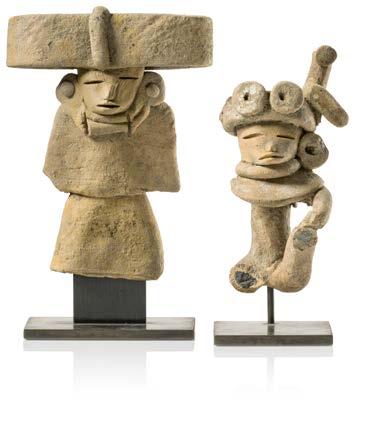

H: 10 cm & 11 cm
Private Collection, Baden-Württem berg, Germany (1970-1980)
€ 600 - 1.200
202 Zwei weibliche Colima-Flach figuren, Protoklassisch, ca. 100 v.Chr. - 250 n. Chr. Keramik, Reste von Bemalung, jeweils gesockelt
Two female Colima Flats, Protoclassic, ca. 100 BC - 250 AD ceramic, remains of painting, each mounted on base
H: 20,5 cm & 24 cm
Private Collection, Baden-Württem berg, Germany (1970-1980)
€ 600 - 1.200
a) Chorrera, Übergangsphase, Aus gussgefäß mit sitzendem Krieger, ca. 500 v. Chr. bis 500 n. Chr., Pigmentreste
b) Tumaco-La Tolita-Kultur, ca. 300 v. Chr. / n. Chr., weibliche Figur mit üppigem Schmuck, Sockel

Figural spout vessel and figure fragment ceramic
a) Chorrera transitional warrior vessel, ca. 500 BC to 500 AD, good remains of applied pigments
b) Tumaco-La Tolita culture, ca. 300 BC / AD, female figure with luxuriant jewellery, base

H: 21 cm (each)
Private Collection, Baden-Württem berg, Germany (1970-1980)
€ 1.000 - 2.000
204 Figurengefäß in Form einer sitzenden Frau, ca. 1250 n. Chr. Keramik
Figural vessel in the form of a sea ted woman, ca. 1250 AD ceramic
H: 15,5 cm
Private Collection, Baden-Württem berg, Germany (1970-1980)
€ 300 - 600
207
206 Figural verzierter Griff Bronze
Darstellung eines Jaguars auf liegender menschlicher Gestalt.
Figurally decorated handle bronze Representation of a jaguar on lying human figure.
H: 10 cm
Provenance Ketterer, Munich, 21 May 1980, Lot 469
€ 450 - 900
207 Figurales Steigbügelgefäß mit Ausguß, Moche III, ca. 400 bis 600 n. Chr. Keramik, bemalt mit hellrotem und cremefarbenem Pigment, ei nen lebenden Toten („carcancha“) mit erlegtem Reh auf dem Rücken darstellend

Figural stirrup spouted vessel, Moche III, ca. 400 to 600 AD ceramic, painted with tan red and cream pigment, depicting a living dead („carcancha“) with a slain deer on the back
Private Collection, BadenWürttemberg, Germany (1970-1980)
H: 20 cm / 22 cm (spout)
€ 900 - 1.800
208 Steigbügelgefäß in Form eines Lastenträgers, Moche II, ca. 300 n. Chr. Keramik, Schlickerfarbe
Stirrup vessel in the form of a load car rier, Moche II, ca. 300 AD ceramic, slip paint
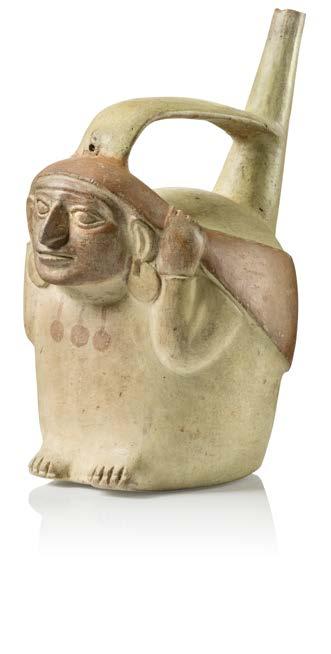
Provenance Private Collection, Baden-Würt temberg, Germany (1970-1980)
H: 20 cm
€ 800 - 1.600
210 Bandhenkelgefäß mit Dop pelausguss, um 200 v. Chr. / n. Chr. Keramik, Schlickerfarbe, bemalt mit mythischen Katzenwesen
Double-spout-and-bridge vessel, ca. 200 BC / AD ceramic, slip paint, painted with mythical feline creatures
H: 16 cm
Private Collection, Baden-Württem berg, Germany (1970-1980)
€ 800 - 1.500
209 Figurales Doppelgefäß, Moche III-IV, ca. 200 bis 400 n. Chr. Keramik, Schlickerfarbe, mit Bandhenkel und einem Ausguss
Double chamber figural vessel, Moche III-IV, ca. 200 to 400 AD ceramic, slip paint, with bridged handle and one spout


H: 16 cm; L: 18 cm
Private Collection, Baden-Württem berg, Germany (1970-1980)
€ 800 - 1.500
Lot 209212 Steigbügel-Doppelgefäß in Form eines Papageis, ca. 200 n. Chr. cremefarbene Keramik, Pfeifgefäß
Stirrup-spouted double vessel in shape of a parrot, ca. 200 AD creamware pottery, whistling jar

H: 18 cm; L: 22,5 cm
Private Collection, Baden-Württem berg, Germany (1970-1980)
€ 900 - 1.800
211 Schale mit Wal - Motiv, ca. 400 n. Chr.
Keramik, polychrom bemalt mit hellrotem und cremefarbenem Pig ment, verziert mit anthropomorpher Wal-Gottheit
Whale bowl, ca. 400 AD ceramic, polychrome painted with tan red and cream pigment, decorated with anthropomorphic whale deity
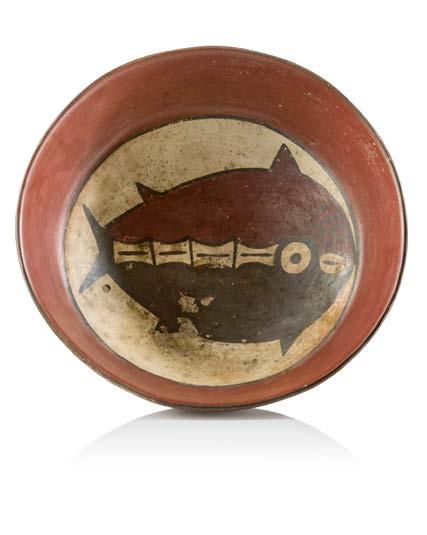
H: 6 cm; D: 18 cm
Provenance Private Collection, Baden-Württem berg, Germany (1970-1980)
€ 300 - 600
213 Zwei bemalte Kartonagen, Ptolemäische Periode, ca. 300 v. Chr. Leinen (in mehreren Lagen) auf Holz kern, Gesso und Pigmente, a) Fragment eines Mumien-Kartona gengehäuses, mit hieroglyphischer Inschrift, M: 101 cm x 19 cm, vergl., ger. (M: 120 cm x 33,5 cm) b) dünnes, tlw. durchbrochen gearbei tetes Fragment eines Mumien- Kar tonagengehäuses, mit Horus-Termini, geflügeltem Skarabäus und Lotus knospen, M: 24 cm x 14 cm, vergl., ger. (M: 37 cm x 27 cm)
Two painted cartonnages, Ptolemaic Period, ca. 300 BC linen (in several layers) on wooden core, gesso and pigments, a) fragment of a mummy cartonnage case, with hieroglyphic inscription, m: 101 cm x 19 cm, glazed and framed (m: 120 cm x 33,5 cm)


b) thin, partly open worked fragment of a mummy cardboard box, with Ho rus termini, winged scarab and lotus buds, m: 24 cm x 14 cm, glazed and framed (m: 37 cm x 27 cm)
Provenance Private Collection, Baden-Württem berg, Germany (1970-1980)
€ 1.000 - 2.000
214 Sarkophagfragment, Spätdynastische Zeit, ca. 700 - 320 v. Chr. Zedernholz mit Gesso und Pigmenten, bemalt mit mäanderartig gewunde nem Schlangenleib
Sarcophagus fragment, Late Dynastic Period, ca. 700 - 320 BC cedar wood with gesso and pigments, painted with meandering serpentine body
H: 121 cm; B: 10 cm
Private Collection, Baden-Württem berg, Germany (1970-1980)
€ 800 - 1.500
215, 216, 217 s. Seite/page 41
218 Anthropo-zoomorphe Maske Holz, rotes und weißes Pigment, Pflanzenfaser, Tierhaut, rest.
Anthropo-zoomorphic mask wood, red and white pigment, plant fibre, animal skin, rest.
H: 70 cm
Provenance Vittorio Mangio, Monza, Italy
AHDRC: 0181818
€ 4.500 - 9.000

Ldamie wurde in Zonleh, im Nord osten Liberias geboren und zog als Kind mit seiner Familie in die nahe gelegene Stadt Gaple, wo er den Rest seines Lebens verbrachte. Seine genauen Lebens- und Schaf fensdaten sind nicht bekannt. Laut Angaben seines Sohnes Ya nemie (geb. ca. 1953/54) wird ange nommen, dass Ldamie hauptsäch lich in den 1920er/1930er Jahren, eventuell früher, auf keinen Fall aber später als in den 1950er Jah ren tätig war.
Die Technik des Messinggießens erlernte Ldamie von Meister Mun mie, einem älteren Verwandten. Seine künstlerischen Inspiratio nen und Ausdrucksformen soll er jedoch aus Träumen bezogen haben. Denn nach dem traditi onellen Glauben der Dan ist das Träumen der Mechanismus, durch den das „dü“, die spirituelle Kraft, die für das Erreichen von Größe in jedem Bereich unerlässlich ist, mit dem Einzelnen kommuniziert. Phantastische Geschichten ran ken sich um das Leben Ldamies. Nach Angaben seines Sohnes kam der große Durchbruch, als ein Regierungsbeamter eines Tages Gaple mit einer kaputten Schreibmaschine besuchte. Ob wohl Ldamie weder lesen noch schreiben konnte, bewies er dem Beamten seine metallurgischen Fähigkeiten, indem er die kaputte Schreibmaschine reparierte. Da nach begann er, Messingfiguren
für Beamte zu gießen, die sie mit nach Hause in die Hauptstadt Monrovia nehmen konnten. Sein Name verbreitete sich und er wur de berühmt. Schließlich habe die Regierung eine Werkstatt für Ldamie einrichten lassen, und er sei so reich und berühmt gewor den, dass er in einer Hängematte überallhin getragen wurde und nie mehr zu Fuß gehen musste (Johnson,1987, S. 53).
Ldamie beobachtete das dörfliche Leben um ihn herum und stellte viele alltägliche Aktivitäten in Genrefiguren dar. Die Figuren galten als Statussymbole, die von ihrem Besitzer voller Stolz in der Öffentlichkeit präsentiert wurden.
Ldamie was born in Zonleh, in northeastern Liberia. As a child he migrated with his family to the nearby town of Gaple, where he lived the rest of his life. The dates that Ldamie lived and cast are not definitely known. According to his son Yanemie (b. ca. 1953/54), Ldamie is believed to have been

active mainly in the 1920s/1930s, possibly earlier, but in no case later than the 1950s.
The technique of brass casting Ldamie learned from an older male relative, the master brass-cast er Munmie. His artistic ability and inspirations however were obtained through dreams. For according to traditional Dan be lief, dreaming is the mechanism through which „dü“, the spritual power essential to becoming great in any area, communicates with individuals.
Fantastic stories entwine around the life of Ldamie. According to his son, Ldamie‘s big break came one day when a government official visited Gaple with a broken type writer. Although Ldamie could not read or write, he proved his met allurgical skill to the official by repairing the broken typewriter. After that he began casting brass figures for officials to take home with them to the national capital, Monrovia. His name spread and he became famous. Eventually the government had a workshop built for Ldamie, and he became so rich and famous that he was carried everywhere in a hammock, and never again had to walk (Johnson, 1987, p. 53).
Ldamie observed village life around him and portrayed in genre figures many daily activ ities. The figurines were consid ered status symbols, proudly dis played in public by their owner.
LIBERIA, DAN, LDAMIE OF GAPLE
215 Figur eines Elefanten Gelbguss
Figure of an elephant brass

H: 9 cm; L: 21 cm
Provenance Christopher Steiner, Lyme, USA
Vgl. Lit.: Johnson, Barbara C., Four Dan Sculptors, San Francisco 1987, p. 100, ill. 45
€ 1.000 - 2.000
LIBERIA, DAN, LDAMIE OF GAPLE
216 Zwei ringende Männer Gelbguss
Two wrestling men brass

H: 8 cm; L: 14 cm
Provenance Christopher Steiner, Lyme, USA
€ 2.000 - 4.000
218 s. Seite/page 38
LIBERIA, DAN, LDAMIE OF GAPLE
217 Figur eines männlichen Gefangenen Gelbguss
Figure of a male prisoner brass

H: 14 cm
Provenance Christopher Steiner, Lyme, USA
Vgl. Lit.: Johnson, Barbara C., Four Dan Sculptors, San Francisco 1987, p. 53 ff
€ 2.000 - 4.000
219 Anthropomorphe Kopfskulp tur „mahen yafe“ schweres Gestein, braune Farbe, Sockel
In Sierra Leone und Westliberia, meist im heutigen Siedlungsgebiet der Mende und Kono, wurden bei Erdar beiten immer wieder Kopfskulpturen „mahen yafe“ zutage gefördert. Sie wurden von Bauern bei der Rodung ihrer Felder, beim Brunnenbau oder beim Schürfen nach Diamanten gefunden.
Es wird angenommen, dass die „ma hen yafe“ von dem verschwundenen Volk der Sapi, oder deren Vorfahren (Schädler, 2009, S. 532) hergestellt wurden, die diese Gebiete einst besiedelten. Ihr genauer Verwendungszweck ist unbekannt. Es wird vermutet, dass sie als Bildnisköpfe oder Porträts ver wendet wurden, die zum Gedenken an verstorbene Sapi-Häuptlinge auf dem Boden oder auf niedrigen Altä ren aufgestellt wurden. „Mahen yafe“ bedeutet „Kopf des Häuptlings“. Neben den Steinköpfen „mahen yafe“ finden sich auch immer wieder klei nere Skulpturen. Die mit dem Men de-Begriff „nomoli“ bezeichneten Figuren finden sich größtenteils im südöstlichen Sierra Leone. Eine an dere Gruppe von Schnitzereien, die weiter im Landesinneren zu finden ist, wird mit dem Kissi-Begriff „pomdo“ bezeichnet.
„mahen yafe“
heavy stone, brown paint, base
In a wide area of Sierra Leone and western Liberia, mostly on the pre sent-day settlement area of the Men de and Kono, head sculptures „mahen yafe“ were repeatedly unearthed du ring earthworks. Almost all objects were found by farmers when clearing their fields, digging wells or digging for diamonds.
It is beliefed that the „mahen yafe“ were made by the disappeared Sapi people or their ancestors (Schädler, 2009, p. 532) who once inhabited these areas.
Their exact use is unknown. It is spe culated that they might have been used as effigy heads or portraits set on the ground or on low altars in commemoration of deceased Sapi chiefs. „Mahen yafe“ means „head of the chief“.
Besides the stone heads „mahen yafe“, smaller sculptures are also found again and again. Sculptures generally referred to by the Mende term „nomoli“ are for the most part found in south-esatern Sierra Leone.
Another group of carvings, found further inland, is nowadays referred to by the Kissi term „pomdo“.
H: 30 cm
Jacques Kerchache, Paris, France (1966)
Merton Simpson, New York, USA (1996)
Private Collection, Lowell, USA
Paris, France: Galerie Jacques Kercha che, „La Tête“, May-June 1966
Publ. in Fouchet, Max-Pol, Jacques Kerchache, „La Tête“, Galerie Jacques Kerchache, Paris 1966, ill. 25; Tribal Arts, No. III, 2 August 1996, p. 53 (adv. Merton Sim pson); Bolz, Franziska, „African Art“, Köln 2016, p. 22 (as Sapi)
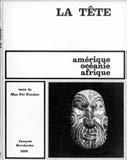
AHDRC: 0115012
Vgl. Lit.: Schädler, Karl-Ferdinand, En cyclopedia of African Art and Culture, Munich 2009, p. 532
Tagliaferri, Aldo, Pomdo, Mahen Yafe and Nomoli, Paris 2003, p. 23 ff.
€ 12.000 - 20.000

Die Metall-Gesichter wurden schräg über der Stirn getragen. Gesicht und Körper des Tänzers waren durch ein üppiges Kostüm aus Raf fia und Stoff vollständig verborgen. Ein Tänzer mit „aron arabai“ Maske und Kostüm ist bei Hahner-Herzog abgebildet. Sie stammt aus dem Häuptlingstum Kolifa und trug den Namen „nemankera“.
SIERRA LEONE, TEMNE223 Seltene anthropomorphe Metallmaske „aron arabai“ Kupferblech mit getriebenem / ge hämmertem Dekor („Repoussé“), ein-Cent- u. zwanzig-Cent-Münzen (1960er Jahre), rest., Sockel Von den Temne sind zahlreiche Holz masken bekannt, die Eigentum von Geheimgesellschaften waren. Ihre Metallmasken aber sind weitgehend unbekannt. Dieses Stück gehört zu den wenigen Exemplaren, die in west liche Sammlungen gelangt sind. Blechmasken „aron arabai“ repräsen tieren noch heute in vielen TemneHäuptlingstümern den Schutzgeist „karfi“ des regierenden Häuptlings und seines Clans. Die Masken tragen spezifische Namen, die sich auf die jeweilige Dynastie beziehen. Für jeden Herrscherclan gibt es nur eine Maske, die während der zeremoniellen Inhro nisation des Regenten auftritt.
Rare anthropomorphic face mask „aron arabai“ copper sheet with hammered decor („repoussé“), one-cent and twentycent coins (from the 1960s), rest., base Numerous wooden masks are known from the Temne, which were the pro perty of secret societies. Their metal masks, however, are largely unknown. This piece is one of the few examples that have found their way into Wes tern collections.
Even today, metal masks „aron arabai“ represent the guardian spirit „karfi“ of the ruling chief and his clan in many Temne chiefdoms. The masks bear specific names that refer to the respective dynasty. There is only one mask for each ruling clan, which ap peared during the ceremonial enthro nement of the regent.
H: 33,5 cm; B: 26 cm
The metal faces were worn diago nally across the forehead. The dancer‘s face and body were com pletely hidden by a lush costume of raffia and fabric.

A dancer wearing an „aron arabai“ mask and costume is illustrated by Hahner-Herzog. It originated from the chiefdom of Kolifa and bore the name „nemankera“.
Mary Sue & Peter Paul Rosen, USA
Publ. in Rosen, Paul Peter & Mary Sue Rosen, „Masks from West and Central Afri ca: A Celebration of Color and Form“, Schiffer Publishing, Ltd. 2014, p. 32, Fig. 32
Vgl. Lit.: Hahner-Herzog, Iris, Das Zweite Gesicht, Genf, München, New York 1997, ill. 27
€ 2.500 - 5.000

221
SIERRA LEONE, KISSI 220 Anthropomorphe Figur „pomdo“ Steatit (Speckstein)
Anthropomorphic figure „pomdo“ steatit (soapstone)
15 cm
250 - 500
SIERRA LEONE / LIBERIA, MENDE - VAI
221 Helmmaske „ndoli jowei“ Holz, rest., Fehlstellle
Helmet mask „ndoli jowei wood, rest., missing part

31,5 cm
Provenance American Private Collection
1.000 - 2.000
SIERRA LEONE, MENDE
Sitzende weibliche Figur Holz, schwarze Glanzpatina, rest.
Seated female figure wood, glossy black patina, rest. H: 49,5 cm

Provenance acquired in Freetown, Sierra Leone (1935)
500 - 1.000
224 Hyänenmaske „suruku“ des „korè“- Bundes Holz, rest.
Die Initianten des „korè“ werden in verschiedene Gruppen eingeteilt, von denen eine jede ein bestimmtes Tier als Totem erhält. Diese werden durch entsprechende Masken verkörpert. Neben der Hyänenmaske „suruku“ treten u. a. Löwenmasken „jaraw“ und Affenmasken „sulaw“ auf.
Hyaena mask „suruku“ of the „korè“ society wood, rest.
The initiates of the „korè“ are divided into different groups, each of which receives a certain animal as a totem. These are represented by appropriate masks. Aside of the hyaena mask „su ruku“, lion masks „jaraw“ and monkey masks „sulaw“ appear. H: 49 cm
German Private Collection € 800 - 1.500
225 Antilopentanzaufsatz „sogoni koun“ oder „chiwara“ Holz
Wie der „chiwara“- Bund ist auch „so goni koun“ eine Altersklassenverbin dung der Jugend, die bei Hackwettbe werben in den Dörfern oder auf den Feldern auftritt.
Dieser „chiwara“ zeigt markante, nach vorne abgeknickte Hörner. Weitere
Tanzaufsätze dieser Art unter AHDRC 0180283 und 0079059 bis 0079065.
Antelope dance crest „sogoni koun“ or „chiwara“ wood

Like the „chiwara“ society, „sogoni koun“ is is an association of different age groups of juveniles, performing on agrarian competitions in the vil lages or fields.
This „chiwara“ shows distinctive horns bent forward. For more dance crests of this type see AHDRC 0180283 and 0079059 to 0079065.
H: 40 cm
Provenance American Collection
€ 800 - 1.500
226 Zoomorpher Tanzaufsatz „mishi koun“ oder „kamalen sogo koun“
Holz, zweitlg. (Vogelaufsatz), Metall, Sockel
Bei Colleyn wird eine vergleichbare Maske „mishi koun“ genannt (Colleyn, Zürich 2001, S. 195).
An anderer Stelle (Davis, New Orleans 1981, S. 56) wird sie als Antilopen-Mas ke „kamalen sogo koun“ bezeichnet„kamalen“ (junge Männer) und „sogo“ (Tier) - die von jungen Männern der „ton“- Jugendvereinigung getanzt wird. Die Antilope ist bei den Bamana untrennbar mit der Landwirtschaft verbunden. Der Vogel steht für Regen.
Zoomorphic dance crest „mishi koun“ or „kamalen sogo koun“ wood, two parts (bird attachment), metal, base
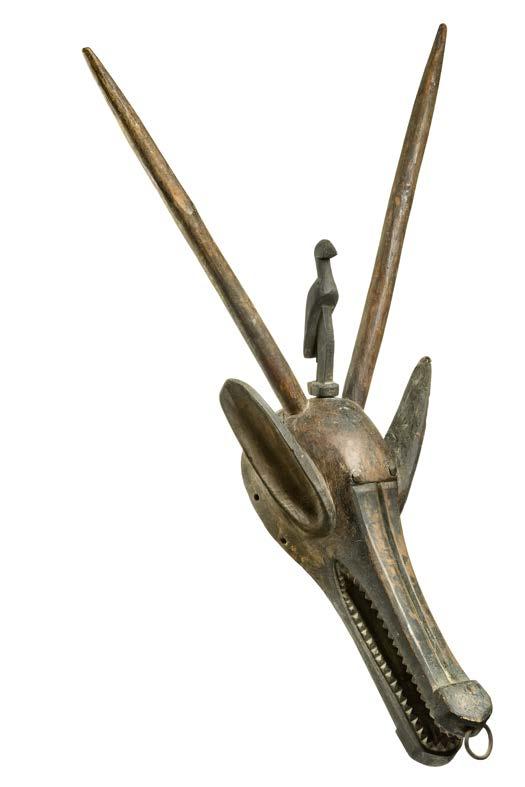
In Colleyn, a comparable mask is called „mishi koun“ (Colleyn, Zurich 2001, p. 195).
Elsewhere (Davis, New Orleans 1981, p. 56) it is called antelope headdress „ka malen sogo koun“ - „kamalen“ (young men) and „sogo“ (animal) - which is danced by young men of the „ton“ youth association. The antelope is in extricably linked to agriculture among the Bamana. The bird represents rain.
H: 103 cm
Vgl. Lit.: Colleyn, Jean Paul (Hg.), Ba mana, Zürich 2001, p. 195 Davis, Charles B., The Animal Motif in Bamana Art, New Orleans 1981, p. 56 f.
€ 2.000 - 4.000
Holz, dreitlg., Metall, Sockel
Diese Tür diente einst zum Verschlie ßen eines Getreidespeichers und seines wertvollen Inhalts. Die auf geschnitzten Figurenreihen, die laut Leloup patrilineare Vorfahren darstel len, sollten wohl zusätzlichen Schutz gewähren.
Jede Familie besaß mehrere Getreide speicher, einen für jede Frau und einen für das Familienoberhaupt.
Figurally carved door leaf „dégé tan“ wood, three parts, metal, base This door once served to close a granary and its valuable contents. The carved rows of figures, which ac cording to Leloup represent patrilineal ancestors, were probably intended to provide additional protection.

Every family has several granaries, one for each of the wives and the rest for the head of the family.
H: 67,5 cm; B: 36 - 42 cm
Gaetan Schoonbroodt, Verviers, Belgium
€ 1.500 - 3.000
Holz, Sockel
Die Form des Baumstammes ist noch erkennbar. Es wurden sieben Stufen eingeschlagen. Baumleitern sind rei ne Gebrauchsgegenstände und da her stets von schlichtem praktischem Design.
Tree ladder wood, base
The shape of the tree trunk is still recognizable. Seven steps have been hammered into it. Tree ladders are first and foremost utilitarian ob jects, and have a simple and practi cal design.
German Private Collection
190 cm
600 - 1.200
229 Stehende antropomorphe Figur Holz, Eisen, Sockel
Standing anthropomorphic figure wood, iron, base

H: 78 cm
Provenance
Private Collection, Baden-Württem berg, Germany
€ 900 - 1.800
230 Gesichtsmaske „dyodyomini“
Holz, Pigmentreste, rest., Sockel
Diese Maske stellt einen Nashornvo gel dar und ist auch unter der Bezeich nung „picoreur“ (frz. für Nashornvo gel) bekannt.
Laut Marcel Griaule erinnert der „dyo dyomini“- Mythos an einen jungen Mann, der von der Trauer über den Tod seines Vaters vollkommen über wältigt war. Die Beobachtung eines Nashornvogels, der Samen aufpickte und sodann wunderschön zu singen begann, soll ihm neuen Lebensmut gegeben und die Kraft verliehen ha ben, die Begräbniszeremonien des „dama“ durchzuführen.
Auf diese Begebenheit hin, wurde eine Maske in Gestalt des Nashornvogels geschaffen und die Tänzer, die diese Maske trugen, schabten mit dem lan gen Schnabel über den Boden, um das
Verhalten des Tieres beim Aufpicken der Körner zu imitieren.
Indem die Dogon durch Maskenzere monien die großen Mythen und ihre Protagonisten wieder aufleben las sen, versuchen sie, das durch Tod oder anderes Unglück gestörte Gleichge wicht wiederherzustellen.
Üblicherweise wird die Maske von ei ner weiblichen Figur bekrönt, die eine mythische Frau „yasigine“ repräsen tiert. In diesem Fall bildet eine weiter Vogelskulptur die Bekrönung.
Face mask „dyodyomini“ wood, pigment residues, rest., base This mask represents a hornbill and is also known as the „picoreur“ (French for hornbill).
According to Marcel Griaule, the „dyo dyomini“ myth recalls how a young man, overwhelmed by the death ofLot 229
his father, observed a hornbill pecking seeds and then beginning to sing. This experience gave the grieving son the inspiration and strength he needed to perform the funeral ceremonies of the „dama“.
A mask in the shape of the hornbill was then created and the dancers wearing it scraped the ground with its long beak to imitate the animal‘s behaviour in picking the grains.
By reviving the great myths and their protagonists through mask ceremo nies, the Dogon try to restore the balance disturbed by death or other misfortune.
Usually, the mask is crowned by a fe male figure representing a mythical woman „yasigine“. In this case, a bird sculpture forms the crown.
H: 76 cm; L: 100 cm (beak)

Ketterer, Munich, 15 December 1990, Lot 53
Private Collection, Baden-Würt temberg, Germany
Vgl. Lit.: Bilot et al., Masques du pays Dogon, Paris 2001, p. 124 ff.
€ 1.800 - 3.500
231 Sehr schöner „yo domolo“Stab Holz, Sockel
Diese Stäbe wurden entweder über die Schulter gelegt getragen oder aber einfach in der Hand gehalten. Sie sind Abzeichen der „yona“- Gesell schaft der „rituellen Diebe“.
Beautiful „yo domolo“ staff wood, base
Worn over the shoulder or held in the hand, curved staffs such as this are emblems of the society of „yona“, or „ritual thieves“.
H: 53 cm
Loudmer, Paris, 1 December 1984, Lot 94
Private Collection, Baden-Württem berg, Germany
Vgl. Lit.: Ezra, Kate, Art of the Dogon, New York 1988, p. 94
€ 600 - 1.200

BURKINA FASO, LOBI
232 Stehende weibliche Figur „bateba phuwe“
Holz
Standing female figure „bateba phuwe“ wood
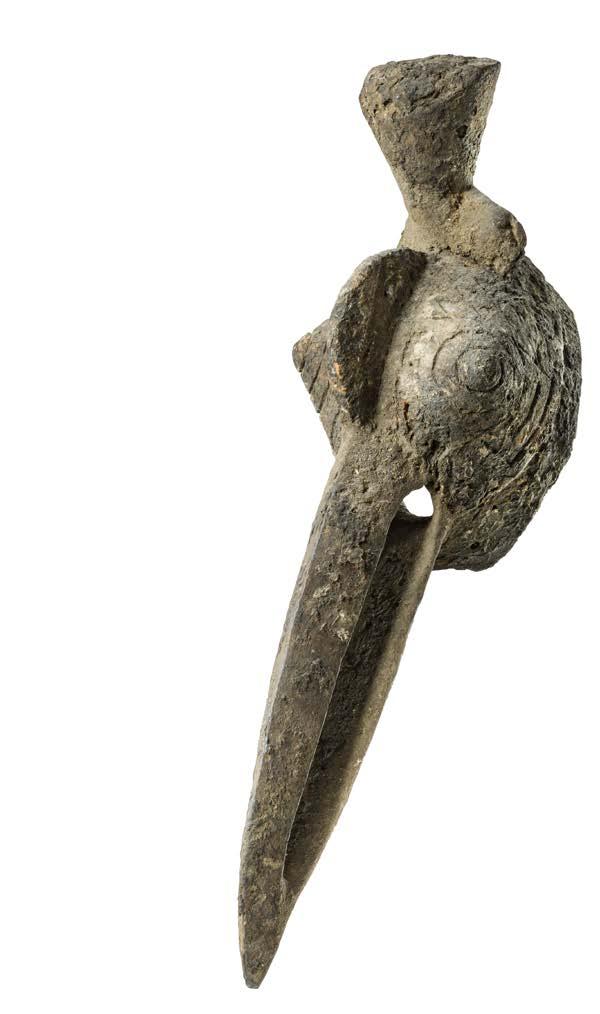
H: 21 cm
€ 250 - 500
BURKINA FASO, GURUNSI (WINIAMA / NUNA)
233 Nashornvogel-Maske
Holz, stark krustierte Patina, Beopfe rungsspuren, Sockel
Dies ist ein Beispiel für eine sehr alte Maske, die nicht mehr öffentlich auf trat, sondern zu einem Altar- oder Schreinobjekt wurde und Opfer für die Geister empfing.
Die Bezeichnung „Gurunsi“ wird als Überbegriff für mehrere ethnische Gruppen verwendet. Dazu gehören Nuna, Winiama, Nunuma, Sisala, Ka sena und Léla.
Hornbill mask wood, strongly encrusted patina, sac rificial traces, base
This is an example for a very old mask that was retired from performing and
became to an altar or shrine object on which sacrifices were offered to the spirits.
The designation „Gurunsi“ is used as a collective term for several ethnic groups: Nuna, Winiama, Nunuma, Sisala, Kasena und Léla.
H: 69 cm
Provenance Private Collection, Baden-Württem berg, Germany
€ 800 - 1.600
234 Weibliche Halbfigur Holz, Pigmente, leicht klebrige Patina, handschriftl. aufgebrachte Inventarnr. „4450“
Female half figure wood, pigments, slightly sticky patina, handwritten inventory no. „4450“

H: 21,5 cm
Provenance Thomas L. McNemar, Lexington, Vir ginia, USA
€ 2.500 - 5.000
235 Anthropomorphe Gesichts maske Holz, geschwärzt
Frühe Auftragsarbeit, vor 1920.
Anthropomorphic face mask wood, blackened Early commissioned work, before 1920.
H: 27 cm
Provenance
Belgian Private Collection
€ 1.200 - 2.400
234
236 Webrollenhalter „konantre“ Holz, Gelbguss, Pigment
Heddle pulley „konantre“ wood, brass, pigment
H: 14 cm
Provenance South German Private Collection
€ 450 - 900
236
237 Anhänger in Form einer Mini aturmaske
Gelbguss, Sockel
Solch kleine Masketten sollen die Ge sichter getöteter Feinde darstellen. Sie wurden als Glücksbringer geschätzt und entweder als Anhänger um den Hals getragen oder an Schwertern befestigt.
Pendant in the shape of a minia ture mask brass, base
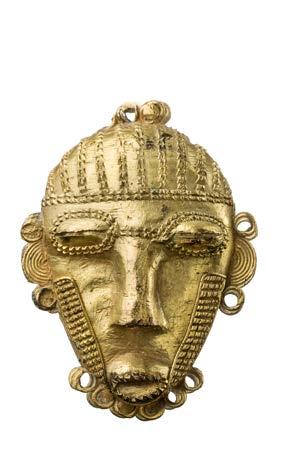
Such small masks were said to re present the faces of slain enemies. Valued as charms, they are either worn around the neck as pendants or attached to the top of swords.

H: 7,7 cm
Provenance Berry de Bruijn, Breda, The Netherlands
Vgl. Lit.: compare AHDRC 0053616
€ 450 - 900
238 Stehende männliche Figur „lü mä“ Holz, Sockel
Standing male figure „lü mä“ wood, base


Provenance American Private Collection H: 38
Am 17. November 2018 wurde bei Zemanek-Mün ster eine weibliche DanFigur angeboten, die mit der vorliegenden Figur große stilistische Gemein samkeiten aufweist.. Es könnte sich um Werke desselben Meisters / der selben Werkstatt handeln, die möglicherweise sogar ursprünglich ein Figuren paar gebildet haben.
On November 17, 2018 a female Dan figure was offered for sale at Zemanek-Münster, which shares great stylistic similarities with the present figure.
They could be works by the same master / the same workshop, which may even have originally formed a pair of figures.
Holzfiguren der Dan werden „lü mä“, „Person aus Holz“ genannt. Sie repräsentieren in der Regel Frauen, manchmal sind auch Männer dar gestellt, dann meist in Form eines männlich-weiblichen Paares.
Trotz traditionell stilisierter Dar stellungsweise können die Figuren gewisse porträthafte Züge zeigen, etwa bestimmte Skarifikationsma le, eine besondere Frisur oder ande re individuelle Merkmale.
Der Besitz von Figuren galt bei den Dan als Statussymbol, das sich nur wohlhabende Männer oder Häupt linge leisten konnten.
Wooden figures of the Dan are called „lü mä“, „wooden person“. They usually represent women, al though sometimes men are por trayed, and then frequently in male and female pairs.
Although the figures are stylized in the traditional manner, aspects of portraiture may exist in cicatriza tion patterns, coiffures, and other individual conditions.
The possession of figurines was considered a secular status symbol by the Dan, which only wealthy men or chiefs could afford.
239 Figurenpaar „lü mä“ Holz, rest.
Pair of figures „lü mä“ wood, rest.

H: 96 cm / 100 cm (male / female)
Provenance French Collection Vgl. Lit.: Johnson, Barbara C., Four Dan Sculptors, San Fran cisco 1987, p. 23 f.
240 Kopffüßer
Holz, Metall, Silberblech, Sockel
Wir vermuten, dass es sich bei diesem Schnitzwerk um einen Wächterkopf „kedie“ handelt.
Diese Kopfskulpturen wurden als mächtige spirituelle Objekte geschätzt und dienten als Heimstatt für schüt zende Geister „dü“.
wood, metal, silver sheet, base
We assume that this carving represents a guardian head „kedie“. These heads are valued as powerful spiritual objects, the receptacles for tutelary spirits, „dü“.
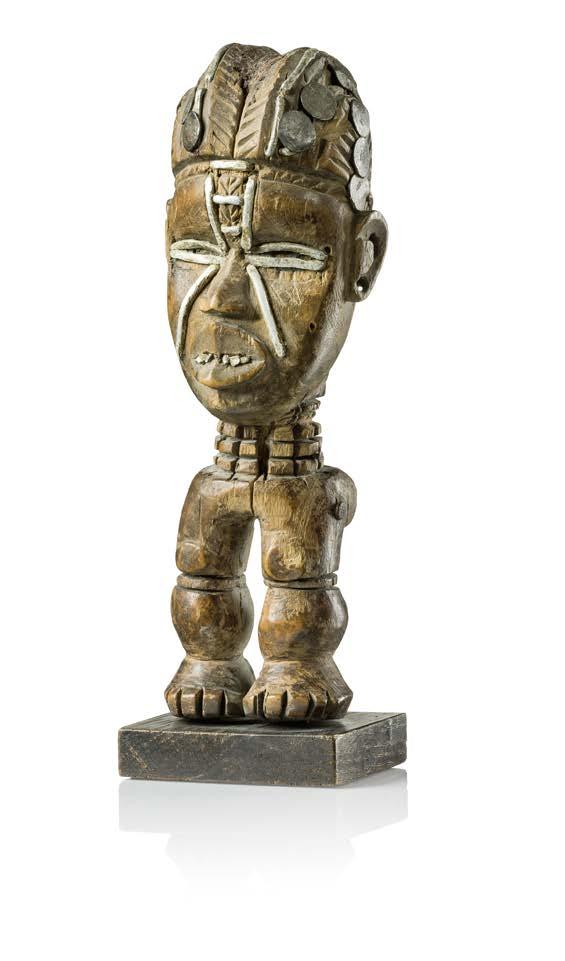
H: 21 cm € 900 - 1.800
Terrakotta, Federn, Kaurischnecken, Silberblech
Ein „gle“ Kopf war ein heiliger Gegen stand und wurde als eine Art Geist an gesehen, der insbesondere bei Wahrsa gepraktiken konsultiert wurde.
Der Kopf wurde aus Ton modelliert, dem allerlei magische Substanzen bei gemischt wurden und der zusätzlich mit kraftgebenden Substanzen bestri chen wurde, um seine Kräfte voll zu aktivieren.
H: 15,5 cm / 24 cm (with feathers)
J. F. C. Fagalde, collected in Liberia in 1957
Anthropomorphic head „gle“ terracotta, feathers, cowrie shells, sheet metal
A „gle“ head was a sacred object and was considered a kind of spirit that was consulted especially in divination practices.
The head was modelled from clay to which all kinds of magical substances
were added and which was also coated with power-giving substances to fully activate its powers.
Vgl. Lit.: Petridis, C. (ed.), „Frans M. Ol brechts 1899-1958, In search of Art in Africa“, Antwerp 2001, cat. 102
€ 1.000 - 2.000
Es wurde beobachtet, dass ein weib liches Medium auf einer Grasmatte sitzend, einen solchen Kopf auf ihrem Haupt trug. In einen Trance zustand versetzt, konnte sie den im „gle“ Kopf personifizierten Geist be fragen und das ihr vorgetragene Problem lösen. Auf ihrer Reise durch die Elfenbeinküste im Jahr 1938 wur den Frans Olbrechts und seine Reise gefährten Zeuge einer „gle“- Sit
zung. Dies ist auf einem Foto P. J. Vandenhoutes aus dem Jahr 1939 dokumentiert. Aufgrund seines Er folges verbreitete sich der „gle“- Kult bei mehreren Völkern im Gebiet des Oberen Cavally Rivers.
It has been observed that a female medium, sitting on a grass mat, car ried such a „gle“ head on her head. Placed in a trance state, she was
able to consult the spirit personified in the „gle“ head and solve the prob lem presented to her. On their jour ney through the Ivory Coast in 1938, Frans Olbrechts and his travelling companions witnessed a „gle“ ses sion. This is documented in a photo graph by P. J. Vandenhoute from 1939. As a result of its success the cult spread among several peoples in the Upper Cavally area.
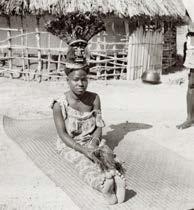

242 Anthropomorphe Gesichts maske Holz, schwarz grundiert, rote und weiße Farbakzente
Anthropomorphic face mask wood, primed black, red and white colour accents H: 43 cm
1.500 -

243 Anthropo-zoomorphe Gesichtsmaske „zuhu“ Holz, Pigmente, rest.
Formal vergleichbare Masken, die dem Prototyp der „kodal yehe“ oder „kpelie- Maske nachempfunden sind, wurden dem „Duonu-Meister“ oder seinem Umfeld zugeschrieben. Sie gelten als Unterhaltungsmasken des „zuhu“ - Genres.
Vorliegende Maske zeigt eine gewisse Nähe zu Werken dieses Meisters.
Anthropo-zoomorphic face mask „zuhu“ wood, pigments, rest.
Formally comparable masks, based on the prototype of the „kodal yehe“ or „kpelie“ mask, were attributed to the „Duonu Master“ or his entourage. They are considered entertainment masks of the „zuhu“ genre. This mask shows a certain proximity to works by this master.

H: 39 cm
Vgl. Lit.: Fischer, Eberhard & Lorenz Homberger, Afrikanische Meister, Kunst der Elfenbeinküste, Zürich 2014, p. 53 ff.
€ 2.000 - 4.000
Franck Robichez, Paris, France Private Collection, Baden-Württem berg, Germany (1980)
H: 36 cm & 40 cm
€ 800 - 1.500
245 Weibliche Figur „tugubele“ Holz, Sockel
Female figure „tugubele“ wood, base H: 23 cm
Provenance German Collection
€ 400 - 800
244 Männlich-weibliches Figurenpaar Holz, Kaolin, Kaurischnecken, Sockel
Das Volk der Kulango ist mit den Baule verwandt und lebt an der Grenze zu Ghana. Ihre Objekte sind selten und sehr begehrt.
Male-female pair of figures wood, kaolin, cowrie shells, base

The Kulango people are related to the Baule and live along the Ghanain bor der. Their objects are rare and highly sought after.
246 Weibliche Figur „tugubele“ Holz, Sockel
Female figure „tugubele“ wood, base H: 22 cm
Provenance German Collection
€ 400 - 800
247 Stehende männliche Figur Holz, Aluminium, schwarze klebrige Patina, Sockel
Standing male figure wood, aluminium, black sticky patina, base

33,5 cm
Provenance Collection de M. et Mme. M-O Cornette de Saint Cyr, Paris-Hoche, 9 March 2015, Lot 116
AHDRC: 0151492
2.000 -

248 Helmmaske „kponyugo“ („Kopf des poro“) Holz, Pigmente, rest.
Helmet mask „kponyugo“ („Head of the poro“) wood, pigments, rest.
H: 68,5 cm
Provenance French Collection, Alsace
Vgl. Lit.: Förster, Till, Die Kunst der Senufo aus Schweizer Sammlungen, Zürich 1988, p. 65
€ 1.000 - 2.000
249 Helmförmiger Kopfaufsatz „dagu“ für den „niyuo“ -Tanz Holz, Pigmente, Harz/ Wachs
Helmet „dagu“ for the „niyuo“ dance wood, pigments, resin/ wax
H: 38 cm
Provenance German Collection
Vgl. Lit.: Krieg, K.-H. & W. Lohse, „Kunst und Religion bei den Gbato-Senufo, El fenbeinküste“, Hamburg 1981, p. 90 ff.
€ 2.000 - 4.000
„Dagu“- Helme traten bei „niyuo“ Aufführungen auf, die sich aus einem umfangreichen Programm von Gesängen und Tänzen zusam mensetzten und mit Initiationsriten des „poro“- Bundes in Zusammen hang standen. Dabei mußten die Initianten Mutproben und Spottgesänge über sich ergehen lassen.
Auch Gesänge mit Anrufungen der Ahnengeister wurden bekannt.
Für ihren Auftritt wurden die „dagu“ Helme mit Kaurischnecken und roten Samen besetzt und hinten mit
einer langen kauriverzierten Schärpe versehen, die dem Tänzer über den Rücken herabhing. Bisweilen wurden sie auch mit Spiegeln oder Federn aufgeputzt. Vor dem Gesicht hingen Perlschnüre herab. Der Kopfputz wurden durch ein aufwändiges Kos tüm ergänzt, so dass die Tänzer ein prachtvolles Bild boten. Die Kauris hatten bei den Gbato noch Geldwert. Vor jeder „niyuo“-Saison wurde im Dorf Kaurigeld zum Besatz der Helme zusammengetragen. Nach der Aufführung bekam jeder seinen Anteil zurück und die Helme wurden unverziert aufbewahrt.
„Dagu“ helmets performed at „niyuo“ performances, which con sisted of an extensive programme of songs and dances and were related to initiation rites of the „poro“ socie

ty. The initiates had to endure tests of courage and mocking chants. Chants with invocations of the an cestral spirits also became known. For their performance, the „dagu“ helmets were decorated with cow ries and red seeds and had a long cowrie-ornamented sash hanging down the dancer‘s back. Sometimes they were also dressed up with mir rors or feathers. Strings of beads hung down in front of the face. The headdress was complemented by an elaborate costume, so that the danc ers presented a splendid image. The kauris still had monetary value among the Gbato. Before each „niyuo“ season, kauri money was collected in the village to trim the helmets. After the performance, everyone got their share back and the helmets were kept undecorated.

Für ein Werk desselben Künstlers siehe AHDRC 0074099.
For a work of the same artist see AHDRC 0074099.
250 Häuptlingsstuhl „kafwokonkolo“ Holz, Metall
Besonders aufwändig gestaltetes Exemplar mit eingeritztem und auf gemaltem Dekor. Ein schönes Detail sind die Stuhlbeine in Gestalt mensch licher Figuren.
H: 33 cm (seat); 60 cm (backrest); B: 52 cm x 52 cm

Especially elaborately designed chair with incised and painted decor. A special detail are the chair legs in the shape of human figures.

Vgl. Lit.: Dagan, Esther A., Man at Rest, Montreal 1985, ill. 117
€ 2.000 - 3.500
251 Weibliche Gesichtsmaske Holz, rotes Pigment
Die Maske zeigt die typischen Wan genskarifikationen, wie sie noch heu te an älteren Frauen zu sehen sind.
Die Augen sind schmal geschlitzt. Der Mund zeigt auffallend wulstige Lip pen mit angedeuteter Zungenspitze.
H: 22,5 cm
Vgl. Lit.: Homberger, Lorenz, Masken der Wè und Dan, Elfenbeinküste, Zü rich 1997, p. 20, ill. 9 and 10
Female face mask wood, red pigment

The mask shows the typical cheek sca rifications that can still be seen on older women today. The eyes are nar rowly slit. The mouth shows strikingly bulging lips with a suggested tip of the tongue.
Provenance Neumeister, Munich, 14 May 2009, Lot 37
Michael Schauer, Munich, Germany
€ 600 - 1.200
252 Anthropomorphe Gesichts maske Holz, rest.
Anthropomorphic face mask wood, rest.
H: 40,5 cm
€ 600 - 1.200
253 Familien- oder Klantopf „abu sua kuruwa“ schwarz geschlämmte Terrakotta „Abusua kuruwa“ finden sich gele gentlich an Hausschreinen, werden aber hauptsächlich bei einem nach der Beerdigung stattfindenden Ritus verwendet, der „sora“ genannt wird und bei dem die Seele des Verstor benen endgültig ins Jenseits geleitet wird.
Der Ritus endet am „asenie“, dem „Platz der Töpfe“, einem Ort im Wald,
der dem Clan gehört und der für diese Zwecke reserviert ist. In irdenen Ge fäßen wird eine Mahzeit serviert, die vor Ort für die Seele des Verstorbenen zubereitet wird.
Abrasierte Haare und abgeschnittene Fingernägel der lebenden Verwand ten und des Toten werden in den Be hälter gegeben, als Ausdruck für die Solidarität und Eintracht des Klans, der hiermit der destabilisierenden Wirkung des Todes entgegentritt.
Family or clan pot „abusua kuruwa“ terracotta with black slip „Abusua kuruwa“ may occasionally be found on household shrines but are used primarily in a post-burial fune rary rite, known as „sora“, when the deceased‘s soul is finally ushered into the afterlife. This rite ends at the „asenie“ or „place of the pots“, a clan-owned forest site set aside for this purpose. Earthenwa re pots are used to serve a ritual meal, prepared on site for the deceased‘s spirit.
Shaved hair and clipped fingernails of the living relatives and the deceased are put into the container as an ex pression of clan solidarity and unity to counter death‘s destabilizing effect.
Ketterer, Munich, 11 April 1992, Lot 103 German Private Collection
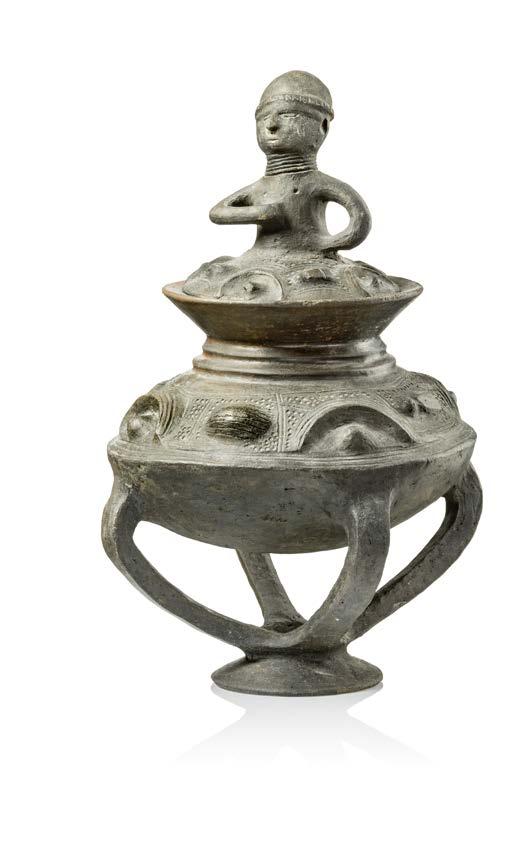
Vgl. Lit.: Nollert, Angelika (Hg.), Afri kanische Keramik aus der Sammlung Franz von Bayern, München 2019, p. 258
€ 800 - 1.600
Ein Krieger zu Pferd mit Schild und Lanze, ein getöteter Feind zu Füßen liegend. Ungewöhnlich bewegte Darstellung des sich aufbäumenden Pferdes.
A warior on horseback with shield and lance, a slain enemy lying at his feet.
Unusually moving depiction of the rearing horse.
H: 8,5 cm
€ 300 - 600
Holz, Silberdraht, Brandzier, mit Wachs behandelte Oberfläche, Sockel
Shrine figure or fertility doll wood, silver wire, pyro-engraved, sur face treated with wax, base

H: 31,5 cm
„Tropen Museum“, Amsterdam, The Netherlands
Louis Pieter Cornelis van Rijn, Amster dam, The Netherlands (Galerie Kephri) Marcelle Sieger, Amsterdam, The Netherlands
Italiaander Galleries, Amsterdam, The Netherlands
Sotheby‘s Amsterdam, 30 September 1987, Lot 201
Heiner Koch, Mönchengladbach, Germany
Lot 255
André Kirbach, Düsseldorf, Germany Private Collection, Potsdam, Germany
AHDRC: 0054771
€ 1.400 - 2.500
256 Schreinfigur
„sakap tchitcherik“ (pl. „tchitcheri“) Holz, Sockel
Mullen Kreamer teilte die Schreinfi guren der Moba in drei Kategorien ein: klein („yendu tchitcheri“), mittel („bawoong tchitcheri“) und groß („sa kap“ / „sakwa tchitcheri“), wobei jede Größe einer bestimmten Funktion entspricht.

According to Mullen Kreamer „tchit cheri“ fall into three distinct catego ries, small („yendu tchitcheri“), me dium („bawoong tchitcheri“), and large („sakap“ / „sakwa tchitcheri“), each size corresponding to a special function.
H: 88,5 cm
Jos Quodbach, Maastricht, The Netherlands
Ron Mansveld, Maassluis, The Netherlands
Vgl. Lit.: Christine Mullen Kreamer, „Moba shrine figures“, in: African Arts, February 1987, Vol. XX, No 2, p. 52-55
257 Pfostenfigur Holz, krustierte Patina, Sockel

Post figure wood, encrusted patina, base
H: 53 cm
Sjaak Spoorendonk, Rotterdam, The Netherlands
Srdjan Sremac, The Hague, The Netherlands
€ 2.000 - 4.000
258 Tierskulptur Frosch / Kröte Kupferlegierung (Bronze, Gelbguss)
Animal sculpture frog / toad copper alloy (bronze, brass)
L: 8,5 cm; H: 4,5 cm
€ 500 - 1.000
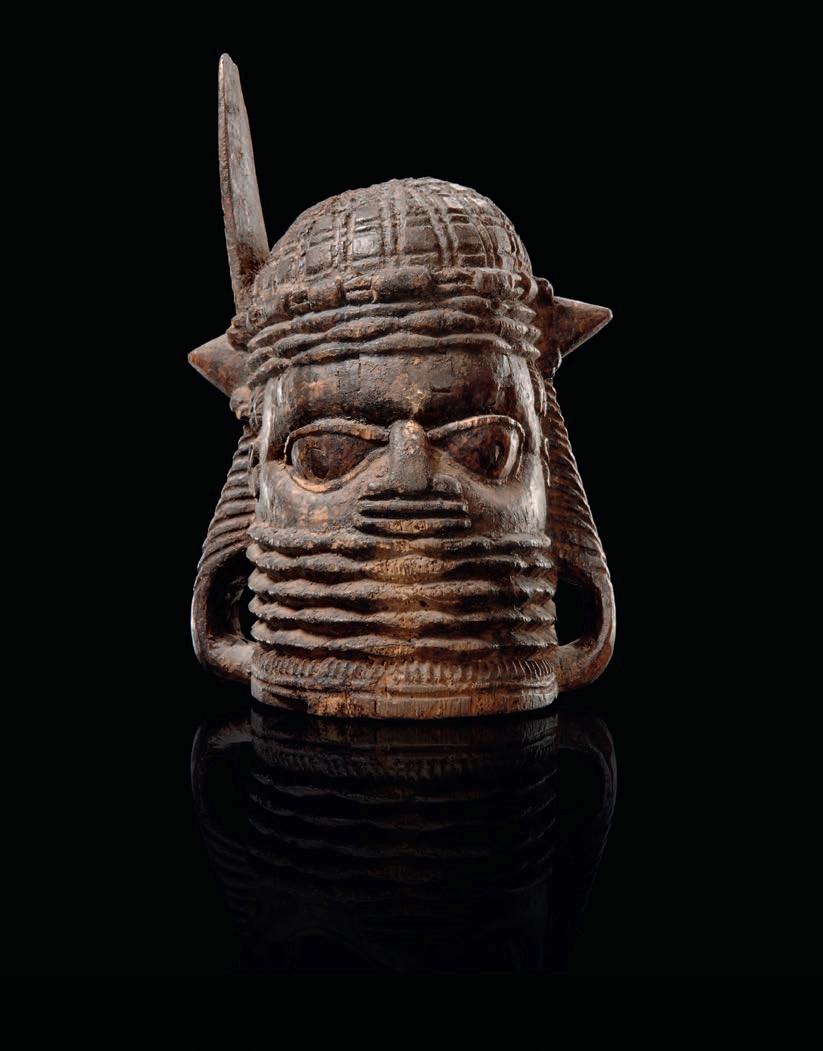
261 Anthropomorphe
Gesichtsmaske „mfon ekpo“ Holz
Anthropomorphic face mask

„mfon ekpo“ wood
H: 24 cm
Provenance
Srdjan Sremac, The Hague, The Netherlands
€ 1.500 - 3.000
259 Eisengeld
Diese schweren handgeschmiedeten Eisenplatten in Form einer überdi mensionierten flachen Schaufel dien ten als zeremonielle Zahlungsmittel.
These heavy hand-forged iron pla tes in the shape of an oversized flat shovel served as ceremonial means of payment.
H: 97 cm; B: 69 cm
Provenance
Peter Stoffers, Kiel, Germany
Vgl. Lit.: Bartolomucci, Adolfo, African Currency, Milan 2012, p. 58
€ 250 - 500
264 Anthropo-zoomorphe Maske Holz, Kaolin, Insektenfraß, Sockel Möglicherweise eine königliche Mas ke „agbanabo“, die als Vollstrecker von Recht und Gesetz beschrieben wird und die für ihre Gewaltausbrüche gefürchtet ist.
Anthropo-zoomorphic mask wood, kaolin, insect caused damage, base
Possibly a royal mask „agbanabo“, described as an enforcer of law and order, feared for its violent outbursts.
H: 54 cm
Private Collection, Baden-Württem berg, Germany
Vgl. Lit.: Berns, Marla C. et. al., Arts of the Benue River Valley, Los Angeles 2011, p. 170, ill. 5.4
€ 900 - 1.800
262 Figuraler Kopfaufsatz
Holz, Kaolin, rest., Sockel
Ein vergleichbarer figuraler Kopfauf satz wird von Fagg mit „ka elu“ Mas kenaufführungen der Ogoni in Ver bindung gebracht (AHDRC 0097095).
Kpone-Tonwe und Salmons berich ten von einer „ka-elu“ Aufführung aus dem Jahr 1992 in Eeke, bei der mehr als zwanzig Maskentänzer beobach tet wurden, von denen ein jeder eine bestimmte Familie der Stadt reprä sentierte. Sie zogen von einer Fami liengemeinschaft zur nächsten, um den Segen der Ahnen zu bringen und böse Geister zu vertreiben.Laut Fagg soll das „ka-elu“ - Maskenspiel bereits vor 1939 ausgestorben sein.
wood, kaolin, rest., base
A comparable figural headdress is as sociated by Fagg with „ka elu“ mask performances by the Ogoni (AHDRC 0097095).
Kpone-Tonwe and Salmons report a „ka-elu“ performance in July 1992 in Eeke, where more than twenty mask dancers were observed, each repre senting one particular family of the city. They moved from one family

compound to the next t in order to bring blessings from the ancestors and dispel evil spirits. According to Fagg, the „ka-elu“ masque should have died out already before 1939.
Vgl. Lit.: Anderson, Martha G., Ways of the Rivers, Los Angeles 2002, p. 283 f.
1.200 - 2.400

264 s. Seite/page 74 265 s. Seite/page 78
NIGERIA, IGBO, SOUTHWESTERN REGION, AHOADA
266 Schreinfigur „ikenga“ Holz, Opferpatina
Shrine figure „ikenga“ wood, sacrificial patina
H: 26,5 cm
Provenance American Private Collection
Vgl. Lit.: Cole, Herbert M. & Chike C. Aniakor, Igbo Arts, Los Angeles 1984, p. 29, ill. 49
€ 500 - 1.000
267 s. Seite/page 80
268 Deformationsmaske
„idiok ekpo“
Holz, Pigmente, Tierhaar, Blech, „Idiok ekpo“- Masken verkörpern bei den Maskenaufzügen der „ekpo“- Ge sellschaft Ahnen, die ein unmorali sches Leben geführt haben.
Deformation mask „idiok ekpo“ wood, pigments, animal hair, sheet metal,
During mask performances of the „ekpo“ society, reincarnated ancestors who were immoral, agitated and way ward are represented in masks called „idiok ekpo“.
H: 23 cm
Ursula Heijs-Voorhuis, Sint Agatha, The Netherlands Srdjan Sremac, The Hague, The Netherlands
€ 1.200 - 2.500
263 Beeindruckende anthropo morphe Gesichtsmaske
Holz, krustierte schwarze Farbe, Ka olin, Sockel
Impressive anthropomorphic face mask wood, encrusted black paint, kaolin, base
H: 35 cm
Provenance
René and Maud Garcia, Paris, France
AHDRC: 0196034
€ 3.000 - 5.000

Holz, rote und schwarze Farbe Laut Cole fertigten Schnitzer im Nord westen des Igbo-Landes neben tradi tionellen Kultobjekten auch weltliche Objekte zu Schau- und Prestigezwe cken an.
Dazu gehören große idealisierte Paar darstellungen, Figuren schöner Frau en „ugonachomma“ und aufwändig gestaltete „Tanzembleme“.
Diese Arbeiten wurden von den ver schiedenen Altersverbänden für Tanz wettbewerbe und festliche Tanzvor führungen in Auftrag gegeben. Nach einem Foto des Missionars Basden aus den frühen 1930er Jahren wur den sie durch die Tanzarena getragen. Sie dienten als Erkennungszeichen der Altersklassenverbände und als Prestigeobjekte.
H: 78,5 cm
According to Cole, some of the same sculptors who carved conventiona lized cult images in nothwestern areas of Igbo country also made se cular „dance emblems“ for display and prestige puposes.
These include large idealized coup les, figures of beautiful women „ugo nachomma,“ as well as elaborately designed „dance emblems“.
These works were commissioned by the various age-grades for competi tive and festive dance displays. Based on a photograph taken by Missionary Basden in the early 1930s, these ima ges were paraded through public dance arenas. They served as iden tifying emblems of the age-grades and as objects of prestige.
Vgl. Lit.: Cole, Herbert M. & Chike C. Aniakor, Igbo Arts, Los Angeles 1984, p. 107 ff.
€ 2.000 - 4.000
könnte aufgrund seiner kleine ren Abmessungen einst ein Tanzemblem bekrönt haben, wie dieses, das bei Cole, 1984, S. 110, ill. 208 publiziert ist.
Due to its smaller dimensions, this pair of figures could have once crowned a dance emblem, like the one published in Cole, 1984, p. 110, ill. 208.

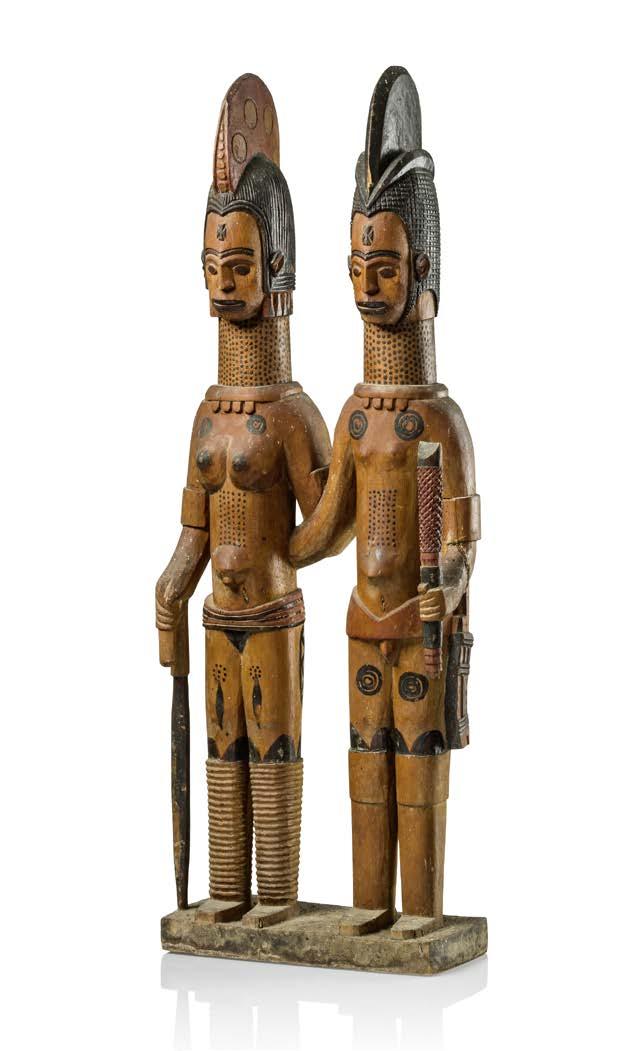
267 Pferdeschädel Knochen, Rohrgeflecht, Pigmen te, Sockel
Die Wertschätzung von Pferden als besonders kostbare und pres tigeträchtige Tiere hat bei den Igbo eine lange Tradition. Neben ihrer herkömmlichen Ver wendung als Reit- oder Lasttiere, dienten sie in jüngerer Zeit aus schließlich als besonders kost spielige Opfertiere, die sich nur wohlhabende Personen, sei es bei Bestattungen oder bei der Übernahme eines Titels, leisten konnten.
Horse skull bone, wickerwork, pigments, base

The appreciation of horses as particularly precious and pres tigious animals has a long tra dition among the Igbo. In addition to their traditional use as riding or pack animals, in more recent times they were used exclusively as particularly costly sacrificial animals, which only rich people could afford, even if for burial or for adoption of a title.
L: 50 cm
René and Maud Garcia, Paris, France
Vgl. Lit.: Eisenhofer, Stefan, Hah ner-Herzog, Iris u.a., Mein AfrikaDie Sammlung Fritz Koenig, Ausst. kat., München, London, New York 2000, p. 136
€ 1.500 - 3.000
Pferdeschädel wurden ebenso wie die Schädel von geopferten Büffeln, Ziegen und Schafen als Schmuck an den Außenwänden des Män nerhauses oder am Altar der Vorfahren angebracht
Horse skulls, as well as the skulls of sacrificed buffaloes, goats and sheep, were placed as ornaments on the outer walls of the men‘s house or on the altar of the ancestors.

Holz, bunte Pigmentreste, Schlange separat gearbeitet, mit Nagel fixiert
Water spirit mask pigment remains, snake worked se parately, fixed with nail H: 111 cm

Provenance
Morton (1925-2019) & Estelle (19252021) Sosland, Kansas City, USA Morton & Estelle Sosland Estate, Kan sas City, USA
AHDRC: 0191561 € 2.500 -
Werkstatt, ex Cornelis Pieter Meulendijk (19121979), Rotterdam, wurde 1986 bei Christie‘s Ams terdam verauktioniert (siehe AHDRC 0095824).
A mask by the same artist / workshop, ex Cornelis Pieter Meulendijk (19121979), Rotterdam, was sold at auction at Christie‘s Amsterdam in 1986 (see AHDRC 0095824).

270 Kopfaufsatz / Helmmaske „vakono“ Holz, rotes Pigment, Sockel
Headdress / helmet mask „vakono“ wood, red pigment, base
H: 26 cm; L: 31 cm
Private Collection, Baden-Württem berg, Germany (acquired in Dakar, Senegal in 1989/90)
Vgl. Lit.: Strybol, Jan, Art and the Sac red in Mumuyeland, Oostkamp 2018, p. 60 f.
Berns, Marla C. et. al., Arts of the Be nue River Valley, Los Angeles 2011, p. 326, ill. 10.20
Evers, Christophe, Art of the Upper Benue River, Brussels 2003, p. 19
€ 800 - 1.500
271 Anthropomorphe Figur „jagana“
Holz, rotes und weißes Pigment, Sockel
Anthropomorphic figure „jagana“ wood, red and white pigment, base H: 65 cm
El Hadj Yende Amadou Photo: Private Archive

El Hadj Yende Amadou, Foumban, Cameroon (1969)
German Private Collection
Zemanek-Münster, Würzburg, 29 June 2019, Lot 164
AHDRC: 0163118
€ 3.500 - 8.000

273 Männliche Aggressionsskulptur „iphri“ Holz, Pigmente, rest., Sockel
Statue for male aggression „iphri“ wood, pigments, rest., base
H: 64 cm
Provenance
Herbert Hamak, Hammelburg, Germany
€ 450 - 900
272 Sitzende männliche Figur „edjo re akare“ Holz, Kaolin, Sockel
Die Urhobo glauben, dass in der sie umgebenden Natur die „edjo“ Geister leben. Figuren namens „edjo re akare“ (d. h. „Geister in geschnitzter Form“) gelten als ihre physische Manifestati on. Sie werden in Gestalt mythischer Krieger und weiblicher Figuren dar gestellt und sind damit zugleich eine Hommage an die Ahnen und Grün derväter einer Gemeinschaft.
Um die Geister gewogen zu halten, werden den Figuren Opfer darge bracht. Bei großen jährlich stattfin denden Festen werden sie öffentlich zur Schau gestellt, begleitet von Tänzen, Masken-Darbietungen und großen Festessen. Im Vorfeld werden sie traditionell bemalt in Rot, Schwarz und Gelb und sie werden mit weißer Kreide („orhe“) überzogen. Es wird an genommen, dass die weiße Kreide die Figuren reinigt und die „edjo“-Geister mit dem spirituellen Reich der Toten „erivwi“ verbindet.
H: 100 cm
Martial Bronsin, Brussels, Belgium
Seated male figure „edjo re akare wood, kaolin, base
The Urhobo believe that „edjo“ spirits live in the surrounding nature. Figu res called „edjo re akare“ (i.e. „spirits in carved form“) are believed to be the physical manifestation of these „edjo“ spirits. They are depicted in the form of mythical warriors and female figures, and so they are a tribute to the ancestors and founding fathers of a community.
The figures receive sacrifices to keep the spirits well content. The commu nity stages large annual festivals in honour of the „edjo“, which include elaborate dances often accompa nied by masquerade performances, lavish meals and extensive displays of wealth. Beforehand, they are traditio nally painted in red, black and yellow and covered in white chalk („orhe“). It is believed that the white chalk puri fies the figures and links the „edjo“ spirits to the „erivwi“ spiritual realm.
AHDRC: 0100776
Vgl. Lit.: Foss, Perkins, An old Urhobo, Cologne 2011, p. 85, fig. 43
€ 5.000 - 10.000

Lot 275
276
NIGERIA, YORUBA, OYO, ILLORIN
275 Weibliches Zwillingsfiguren paar „ere ibeji“ Holz, Rotholzmehl, indigoblaues Pig ment, Glasperlen, Metall
Female pair of twin figures „ere ibeji“ wood, camwood powder, indigo blue pigment, glass beads, metal
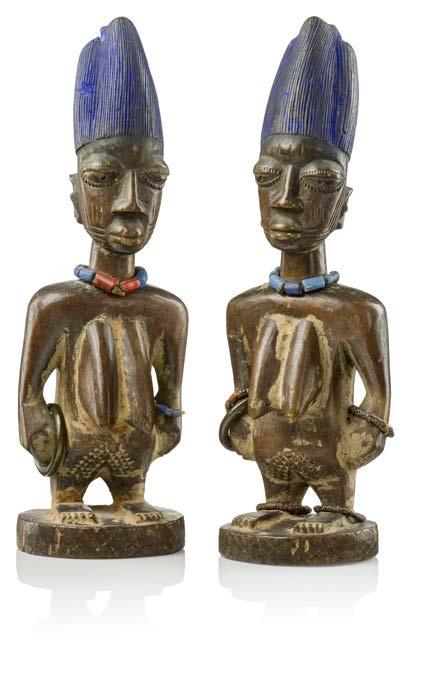
H: 29 cm
Nigerian Private Collection (before 1969) Galerie Schwarz-Weiß, Munich, Ger many (1989)
Vgl. Lit.: Stoll, Gert & Mareidi, Ibeji, Zwillingsfiguren der Yoruba, Mün chen 1980, p. 257, ill. 143
€ 1.000 - 2.000
NIGERIA, YORUBA, OYO, OKE IHO
276 Weibliche Zwillingsfigur „ere ibeji“ Holz, Pigmente, Kokosscheibchen
Female twin figure „ere ibeji“ wood, pigments, coconut discs

Alo Storz, Stuttgart, Germany (1981)
Landesgirokasse Bietigheim, BadenWürttemberg, Germany, 1981
H: 25 cm
Vgl. Lit.: Polo, Fausto, Enzyklopädie der Ibeji, 2008, ill. 423
€ 400 - 800
274 Ungewöhnlich großes Zwillingsfigurenpaar „ere ibeji“ Holz, Rotholzmehl, Glasperlen, Metall
Provenance
Robert Temple, Ghent, Belgium British Collection
Unusually large pair of „ere ibeji“ twin figures wood, camwood powder, glass beads, metal
cm

NIGERIA, YORUBA, KWARA STATE, EGBE
277 Weibliches Zwillingsfiguren paar „ere ibeji“ Holz, Pigmente, Glasperlen, Metall, Kaurischnecke, Schönes, besonders reich geschmück tes Figurenpaar, bei dem die Gesichts züge durch langjährige Behandlung im Kult kaum noch zu erkennen sind.
Female pair of twin figures „ere ibeji“ wood, pigments, glass beads, metal, cowrie shell, Beautiful pair of figures, particularly richly decorated. Long years of use in the cult have rendered the faci al contures of these figures barely recognizable.

H: 27,5 cm & 28,5 cm
Provenance Mama Adamou, Lomé, Togo (1981)
Vgl. Lit.: Stoll, Gert & Mareidi, Ibeji, Zwillingsfiguren der Yoruba, Mün chen 1980, p. 280, ill. 171 € 900 - 1.800
278 Ifa-Orakelköpfchen „olori(n) ifa“ oder „ikin ifa“ (*) Elfenbein, Sockel
„Ifa“ Priester verwenden sechzehn heilige Palmnüsse für ihre Weissa gungen. Viele von ihnen besitzen eine siebzehnte Nuß, die „olori(n) ikin“ („Chef der Palmnüsse“) genannt wird. Sie wird des öfteren durch solch einen kleinen menschlichen Kopf aus Elfen bein (oder Knochen) ersetzt.
Üblicherweise wird angenommen, dass die Köpfchen „eshu“ reprä sentieren, aber sie dürften eher auf „orunmila“, die oberste Gottheit des „ifa“-Orakels, anspielen.
Ifa divination head „olori(n) ifa“ or „ikin ifa“ (*) ivory, base „Ifa“ priests use sixteen sacred palm nuts for their divinations. Many of them have a seventeenth nut called „olori(n) ikin“ („chief of the palm nuts“). It is often replaced by such a small human head made of ivory (or bone).
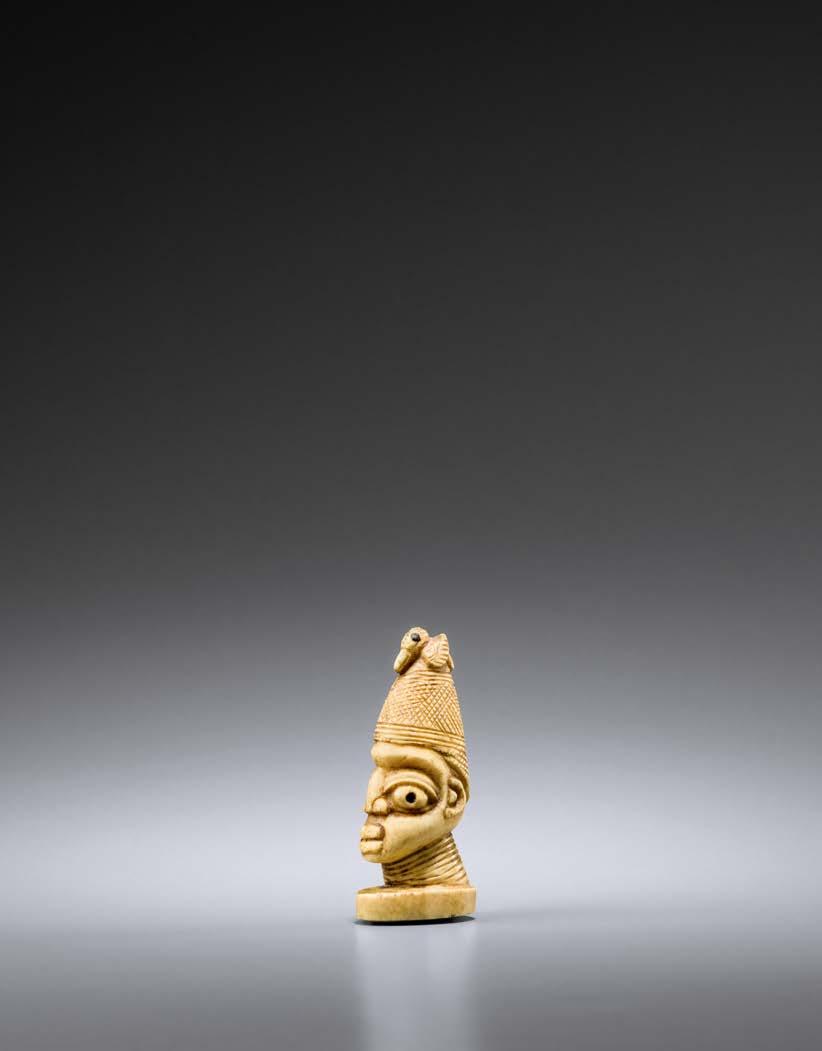
Usually it is believed that the heads represent „eshu“, but they are more likely to allude to „orunmila“, the su preme deity of the „ifa“ oracle.
8,5 cm
Provenance Werner Zintl, Worms, Germany (2002)
Matthias Streckfuß, Berlin, 20 July 2022 (No 2139-07-2022)
- 1.500
279 Anthropomorphe Öllampe Keramik / Terrakotta, Pigmentreste, krustierte Patina (Ölrückstände)
Anthropomorphic oil-lamp ceramic / terracotta, pigment resi dues, encrusted patina (oil residues)

H: 33 cm
Provenance Private Collection, Baden-Württem berg, Germany
Vgl. Lit.: compare AHDRC 0186584 € 500 - 1.500
280 Seltene Gesichtsmaske
„agbodogin“
Holz, geschwärzt, Inventarnr.“270“
Die Herkunft dieses Maskentyps gibt der Forschung bis heute Rätsel auf. Einigkeit besteht darin, dass die Form der Maske untypisch für die Maskent radition der Yoruba ist. Drewal (1989)
sieht diesbezüglich eine Herkunft aus Ishan und auch Poynor berichtet von einer ähnlichen Maske, die in Ishan nördlich von Benin gefunden wurde.
Laut Auskunft der dortigen Lokals sei die Maske aber auch hier ein Import, womit ihre Herkunft weiterhin ein Rätsel bleibt.
Rare face mask „agbodogin“ wood, blackened, inventory no. „270“
The origin of this mask type remains a mystery to researchers today.
There is agreement that the shape of the mask is atypical of the Yoruba mask tradition. Drewal (1989) sees in this respect an origin from Ishan and also Poynor reports of a similar mask, which was found in Ishan north of Benin. But local traditions maintain that the mask is an import there also, which means that its origin remains a mystery.
Irwin Hersey (1920-2010), New York, USA
Frederic („Frits“) Wallace (1914-2014), Sarasota, USA (1980s)
Private collection, Calm Ocean, USA (2014)
AHDRC: 0194210
Vgl. Lit.: Poynor, Robin, African Art at the Harn Museum, Florida 1995, p. 73, Fig. 17
€ 3.000 - 5.000
Poynor zufolge wurde die „agbodo gin“- Maske von den Owo Yoruba adaptiert und ist fest in den „egun gun“- Traditionen dieser Gruppe verwurzelt. Poynor publizierte zwei „agbodogin“ Masken der Owo Yoru ba. Bei der einen ist das Gesichts feld geschwärzt, wie bei vorliegen dem Exmplar, bei der anderen ge weißt und schwarz eingefasst. Letz
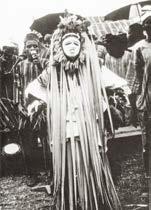
tere ist auf einem Feldfoto zu sehen, das Poynor 1973 aufnahm und das einen Maskentänzer in voller Mon tur zeigt (Poynor, 1995, S. 72).
According to Poynor the „agbodo gin“ mask has been adopted by the Owo Yoruba and is firmly rooted in the „egungun“ traditions of that group.
Poynor published two „agbodogin“ masks of the Owo Yoruba. One has the face blackened, as in the pre sent specimen, while the other is whitened and edged in black. The latter can be seen in a field photo graph taken by Poynor in 1973 showing a mask dancer in full rega lia (Poynor, 1995, p. 72).

281 Hockende männliche Figur Holz, stark krustierte Patina, Sockel Vorliegende Figur besticht durch ihre schön modellierten, annähernd naturalistisch anmutenden Gesichts züge, die einen eher gramvollen, nachdenklichen Ausdruck zeigen.
Die Arme sind auffallend muskulös, das männliche Geschlecht besonders hervorgehoben.
Die Noppenkappe / -frisur weist auf die Darstellung eines Würdenträgers. Weitere Statussymbole (Halsketten, Armbänder, Tabakspfeife etc.) fehlen.
Die auf einem kleinen Hocker sitzende Figur war vermutlich auf eine ringför mige Basis gearbeitet.
Im Graslandgebiet stellen großfiguri ge männliche und weibliche Statuen (von über 80 cm Höhe) meist Mitglie der des Königshauses oder besonders verdiente Würdenträger / innen dar. Diese Gedenkfiguren tragen den gleichen Namen wie eine bedeuten de Geheimgesellschaft der Bangwa, „lefem“. Ihre Verwendung variiert von Königreich zu Königreich, doch fast überall werden sie bei wichtigen Ereignissen am Hofe vor dem Palast gut sichtbar für die Öffentlichkeit ausgestellt.
Es finden sich auch kleinere Figuren im Stile der „lefem“- Gedenkfiguren die Tanzaufsätze bekrönen (vgl. Hom berger, Zürich 2008, S. 170, Kat. 55).
Daneben gibt es figurale Ritualstäbe, die den Eingang des heiligen Haines schützen sollten, in dem der Bund seine Initiationszeremonien abhielt.
Squatting male figure wood, heavily encrusted patina, base
The present figure particularly cap tivates with its beautifully modeled, almost naturalistic-looking facial fea tures, which show a rather sorrowful, thoughtful expression. The arms are strikingly muscular, and the male sex is particularly prominent.
The knobbed cap / hairstyle indica tes the depiction of a dignitary. Other status symbols (necklaces, bracelets, tobacco pipe etc.) are missing. The fi gure sitting on a small stool was pro bably worked on a ring-shaped base. In the grassland area, large-figure male and female statues (over 80 cm in height) usually represent members of the royal family or particularly de serving dignitaries. These commemo rative figures bear the same name as an important secret society of the Bangwa, „lefem“. Their use va ries from kingdom to kingdom, but almost everywhere they are displayed in front of the palace for the public to see during important events at court.
There are also smaller figures in the style of the „lefem“ commemorative fi gures crowning dance crests (cf. Hom
berger, Zurich 2008, p. 170, cat. 55).
In addition, there are figural ritual staffs that were intended to protect the entrance to the sacred grove whe re the „lefem“ society held its initiati on ceremonies. H: 53 cm
Rut Van Caelenbergh, Brussels, Belgium (2012)
Dalton - Somaré, Milan, Italy
Jeffrey Clifton, California, USA
Fernandez Leventhal Gallery, New York, USA (2021)
Brussels, Belgium: „BRUNEAF, Brussels Non European Art Fair“, Fernandez Le venthal Gallery, 16-20 June 2021
Expo cat.: „BRUNEAF, Brussels Non European Art Fair“, Brussels, 2021, p. 52
AHDRC: 0150708
Vgl. Lit.: Homberger, Lorenz (Hg.), Kamerun, Kunst der Könige, Zürich 2008, p. 170 f. € 9.000 - 12.000
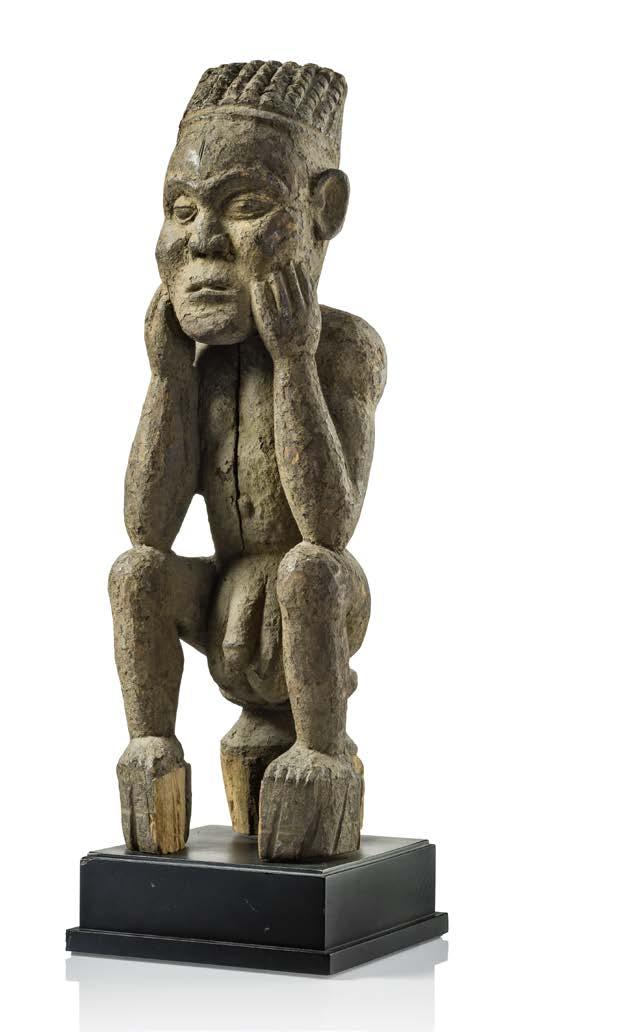
283 Zauberfigur „mu‘ po“ Holz, Pigmente, Sockel
Power figure „mu‘ po“ wood, pigments, base H: 18 cm
Provenance
Lucien Van de Velde, Antwerp, Belgium (1982)
Arie & Helga Cleeren, Stevoort, Belgium
Jo De Buck, Brussels, Belgium
Lucien Van de Velde, Antwerp, Belgium (2006)
Zemanek-Münster, Würzburg, 19 September 2009, Lot 305
Neumeister, Munich, 10 June 2010, Lot 205
South German Private Collection
AHDRC: 0010542
€ 1.000 - 2.000
282 Zwei Zauberfiguren „mu‘ po“ Holz, Pigmente, „Mu‘po“ - Statuetten wurden von den Völkern der Bamun und Bamileke im Kameruner Grasland zu Wahrsageund Heilungszwecken verwendet.
Ihre Rolle war vielfältig: sie wur den von den Maskenträgern der „ku‘n‘gan“- Gesellschaft bei rituellen Tänzen in Händen gehalten, als Jagd
zauber aufgehängt, an den Gürteln von Kriegern befestigt, um den Feind zu verwirren, auf den Feldern plat ziert, um die Ernte zu schützen, oder von schwangeren Frauen getragen, um den guten Verlauf der bevorste henden Geburt zu sichern...
Nach Harter kann die Position der Hände von einer Statuette zur ande ren variieren, wobei jede Geste ein Thema symbolisiert. Wenn die Hände zu den Schlüsselbeinen emporgreifen, beschwören sie Böses herauf.
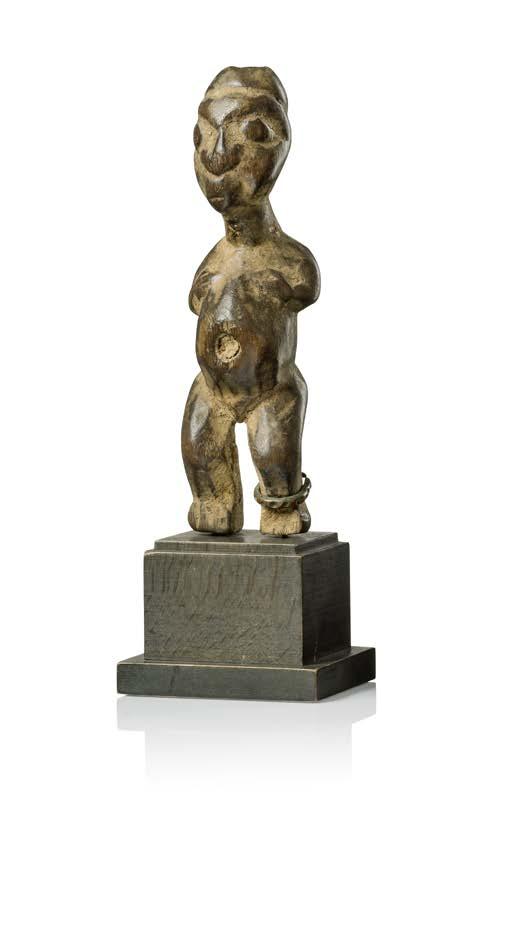
Two power figures „mu‘ po“ wood, pigments, „Mu‘po“ statuettes were used by the Bamun and Bamileke peoples of the Cameroon grassfields for divination and healing purposes.
Their role was varied: they were held by mask dancers of the „ku‘n‘gan“ society during ritual dances, used as hunting charms, attached to the belts of warriors to confuse the enemy, placed in the fields to protect the har vest, or worn by pregnant women to ensure successful birth...
According to Harter, the position of the hands may vary from one statue to another, each gesture symbolizing a special topic. When the hands reach up to the collarbones, they evoke evil.

H: 15,5 cm (both)
Lt. Col. Richard Hopp (born 1880), Kai serslautern / Germersheim, Germany Lempertz, Brussels, 2 September 2021, Lot 73

On August 12, 1914, Lieutenant Colonel Richard Hopp was drafted into the Imperial Protection Forces for Ca meroon. He was stationed in Duala,
where he was taken prisoner by the French at the end of September 1914.
Historical background: The German colony of Cameroon became the scene of hostilities shortly after the start of World War I in August 1914. Until the beginning of 1916, the Ger man „Schutztruppe“ carried out de fensive battles against the advance of British, French and Belgian units on the territory of the colony. Ger man resistance was crushed, and
the remnants of the German armed forces and civil administration even tually took refuge in adjacent neutral Spanish Equatorial Guinea. Camero on was divided between France and Great Britain.
Vgl. Lit.: Harter, Pierre, Arts anciens du Cameroun, Arnouville 1986, p. 269
4.000 - 8.000

Die Herstellung solch hautüberzoge ner Stülpmasken aus Holz ist einzig artig für die Region entlang des Cross River, der sich an der Grenze zwischen Nigeria und Kamerun erstreckt. Die Künstler verwendeten Antilopenhaut, die durch langes Einweichen in Was ser aufgeweicht wurde.
Die Aufsätze wurden von Maskenge sellschaften bei unterschiedlichsten Anlässen eingesetzt, etwa bei mili tärischen Siegesfeiern, Begräbnissen von Bundmitgliedern, Initiationsritua len oder jahreszeitlichen Festen.
Janiform helmet mask, before 1920 wood, hide, pigment, The technique of covering carved wooden helmet masks with skin is unique to the area along the Cross River, which straddles the border between Nigeria and Cameroon. Ar tists used antelope skin softened by a lengthy soaking in water.
The headdresses were used by mask societies on a wide variety of occasi
ons, such as military victories, burials of society members, initiation rituals or public seasonal festivals.
H: 44 cm
Provenance American Private Collection € 2.500 - 4.000
289 Zierbeil und Statussymbol Metall, Holz, Tierhaar
Ornamental hatchet and status symbol metal, wood, animal hair
L: 50 cm; 16 cm (blade)
Vgl. Lit.: Zirngibl, Manfred A., Alexan der Kubetz, Panga na visu, Riedlhütte 2009, p. 89, ill. 183 / 184
€ 900 - 1.800
285 Zoomorphe Figur Holz, krustierte Patina

Zoomorphic figure wood, encrusted patina
H: 16,5 cm
Provenance German Colonial Collection
Vgl. Lit.: Krieger, Kurt, Westafrikani sche Plastik, Bd. I, Berlin 1978, ill. 147
€ 2.000 - 5.000
Eine vergleichbare Figur ge langte 1901 in die Bestände des Ethnologischen Museums in Berlin. Im Museumskata log wird sie als „Fetischfigur mit Vogelkopf“ aufge führt (vgl. Krieger, Bd. I,1978, plate 147 / AHDRC 0011023).
A comparable figure entered the holdings of the Ethnologi cal Museum in Berlin in 1901. In the museum catalog it is listed as a „fetish figure with bird head“ (cf. Krieger, Vol. I,1978, plate 147 / AHDRC 0011023).

Die in die Frontseite der Lehne ein geschnitzten Figuren erinnern an kö nigliche Gedenkfiguren. Eine davon hält ein Trinkhorn in Händen, das als Prestigeobjekt gilt. Auch das Motiv des Leoparden als Karyatidenfigur ist Hinweis auf die einstige Verwendung des Hockers am Hofe eines Fon.
The figures carved on the front of the backrest are reminiscent of royal commemorative figures. One of them holds a drinking horn, which is consi dered to be a prestige object. The mo tif of the leopard as a caryatid figure is a reference to the former use of the stool at the court of a Fon.

H: 42 cm (seat); 78,5 cm (backrest) D: 42,5 cm
Gisela & Hartwig Dehmel, Lüchow, Germany
€ 1.000 - 2.000
CAMEROON, BANGWA / BAMILEKE
287 Tierskulptur Krokodil Holz, fragmentarisch, Öffnung zum Einfügen von magischer Ladung, Sockel
L: 51 cm; H: 10,5 cm
Crocodile sculpture wood, fragmentary, opening for insertion of magical charge, base
Provenance Merton Simpson, New York, USA € 1.000 - 2.000

290 Flechtschild „kor“
Palmfasern, Holz, Blech, mit traditio nellen Mustern und Stammeszeichen
Diese Schilde wurden früher zur Kriegsführung verwendet, als etwa im späten 19. Jahrhundert die Fula ni auf der Suche nach Sklaven das Mambila-Plateau überfielen.
Bereits im 19. Jahrhundert wurden sie von deutschen und englischen Ver waltern, Reisenden und Missionaren gesammelt, mit anderen Gruppen gehandelt oder von den Nachbarn als Kriegstrophäen mitgenommen.
Sie werden auch heute noch verwen det, bei den sogenannten „nggwun“Tänzen, die eng mit der Amtseinfüh
rung von Häuptlingen verbunden sind. Die Tänze werden aufgeführt, wenn der Häuptling seinen Amtseid erneuert und schwört, seine Position nicht zu missbrauchen.
Braided shield „kor“ palm fibres, wood, sheet metal, with traditional patterns and tribal symbols

These shields were once used for war fare when, around the late 19th cen tury, the Fulani raided the Mambila Plateau in search of slaves
As early as the 19th century, they were collected by German and English ad ministrators, travellers and missio naries, traded with other groups or
taken as war trophies by neighbours.
They are still used today in the „ngg wun“ dances, which are closely asso ciated with the investiture of chiefs. The dance is performed when the chief restates his oath of office and swears not to abuse his position.
H: 125 cm; B: 106,5 cm

Vgl. Lit.: Barbier, Jean Paul & Purissima
Benitez-Johannot, Shields, Munich, London, New York 2000, p. 40 f.
€ 2.500 - 5.000
zweitlg., Holz, rote Farbe, rest. Frühe Kontakte und Handelsbeziehun gen mit den Europäern in vorkolonialer Zeit hinterließen unübersehbare Spuren in der Kultur der Duala. Ein merkwür diger Mischstil entstand. Die Schnitzer übernahmen u. a. europäische Schrei nertechniken und die Bemalung ihrer Objekte mit bunten Ölfarben. In der Formensprache kam es zu einer Ver schmelzung fremder und traditioneller Elemente.
Manche Kunstgattungen (Masken und Ahnenfiguren) verfielen. Dafür blühte die Ausschmückung der Boote auf, die nun nicht mehr allein zum Fischfang, sondern auch zum Warentransport und als Prestigezeichen dienten. Zu festli chen Anlässen fanden Bootsparaden und Regatten statt. Zu solchen Festen wurden die Schiffe an den Vordersteven - nach Vorbild europäischer Galionsfigu ren mit langen, kunstvoll geschnitzten „Schnäbeln“ („tange“) geschmückt.
Von den Werken der Duala-Küstenkultur sind einige alte, aus der Zeit vor dem ersten Weltkrieg stammende Stücke erhalten. Sie schmückten vor allem die Boote von Königen und ihren Familien.
Die jüngeren, für einzelne RegattaMannschaften hergestellten Exemp lare setzen im Großen und Ganzen die Tradition dieser ersten „tanges“ fort (vgl. Kecskési,1999, S. 90).
Das vorliegende Stück zeigt Details, die auf europäischen Einfluß hinweisen. So zum Beispiel den heraldisch anmuten den Aufbau der beiden Elemente mit spiegelbildlich angebrachten Löwen, bzw. Vögeln und affenartigen Halbfi guren, die eine Krone tragen. Andere Elemente, wie das Vogel-SchlangenMotiv, das auf den Kampf zwischen Le ben und Tod, bzw. Licht und Finsternis hinweist, sind dagegen der traditionel len Ikonographie entnommen.
Ship‘s beak „tange“ („tangué“) two-part, wood, red paint, rest. Early contacts and trade relations with

the Europeans in pre-colonial times left unmistakable traces in the culture of the Duala. A stran ge mixed style emerged. European carpentry techniques and bright paint were adopted, and the iconography became a fusion of traditions and foreign styles. Some art genres (masks and ancestral figures) fell into dispair, but the decoration of boats flourished, which were no longer used only for fishing but also for trans porting goods and as a sign of prestige. Boat parades and regattas took place on festive occasions. At such festivals, the ships were decorated with long, elaborately carved „beaks“ („tange“) on the stems - modeled on European figureheads.
Of the works of Duala coastal culture, some old pieces dating from before the First World War have been preser ved. They mainly decorated the boats of kings and their families. The more recent examples made for individual regatta teams widely continue the tradition of these first „tanges“ (cf. Kecskési,1999, p. 90).
The present piece shows details that indicate European influence. For example, the heraldic structure of the two elements with lions attached in mirror image, or birds, and ape-like half-figures carrying a crown. Other elements, such as the bird-snake motif, which refers to the struggle between life and death, or light and darkness, are taken from traditional iconography.
René and Maud Garcia, Paris, France
Vgl. Lit.: Leuzinger, Elsy, Die Kunst von Schwarz-Afrika, Recklinghausen 1972, p. 231, ill. O 8
Kecskési, Maria, Kunst aus Afrika, München, London, New York 1999, p. 90 f.



 Photo: G. Kubik
Photo: G. Kubik
Die Harfe „ngombi“ wurde bei Zere monien der „bwiti“- Gesellschaft verwendet. Sie war Eigentum eines Priesters der Kultgemeinschaft und wurde bei religiösen Zusammen künften gespielt.
Der bekrönende Kopf stellt die zent rale Figur der „bwiti“- Religion, die Mutterfigur „Nyingwan Mbege“ dar.
The harp „ngombi“ was used in cere monies of the „bwiti“ society. It was the property of a priest of the cult community and was played at reli gious gatherings.


The crowning head represents the central figure of the „bwiti“ religion, the mother figure „Nyingwan Mbege“.
NORTH GABON / SOUTH CAMEROON, FANG291 Anthropomorphe Bogenharfe „ngombi“ (Cordophon)
Holz, Tierhaut und -sehnen, Pflanzen faser, sechs (von ursprünglich acht) Saiten, zwei Schalllöcher, handschrift lich aufgebrachte Inventarnr. „5741“, Sockel
Anthropomorphic bow harp „ngombi“ (cordophone) wood, animal skin and sinews, plant fiber, six (of originally eight) strings, two sound holes, handwritten inven tory no. „5741“, base H: 77 cm; L: 76 cm

Provenance Private Collection, Baden-Württem berg, Germany (1973)

Publ. in Schädler, Karl-Ferdinand, Afrikanische Kunst in Deutschen Privatsammlun gen, München 1973, p. 325, cat.466
AHDRC: 0050454
Vgl. Lit.: Kubik, Gerhard et. al., Afrika nische Musikinstrumente, Berlin 2014, p. 242, p. 242 f.
€ 4.500 - 9.000
Diese Maske gehört zu den sogenann ten „Weißen Masken vom Ogooué“, auch wenn die Kaolinschicht, die das Gesicht typischerweise überzieht, nur noch in Resten vorhanden ist.
Diese Masken stellen weibliche Ahnen aus dem Jenseits dar und traten in erster Linie bei Trauerfeierlichkeiten auf.
Female face mask „okuyi“ wood, pigments
This mask belongs to the so-called „White Masks of Ogooué“, even though the kaolin layer that typi cally covers the face is only present in remnants.
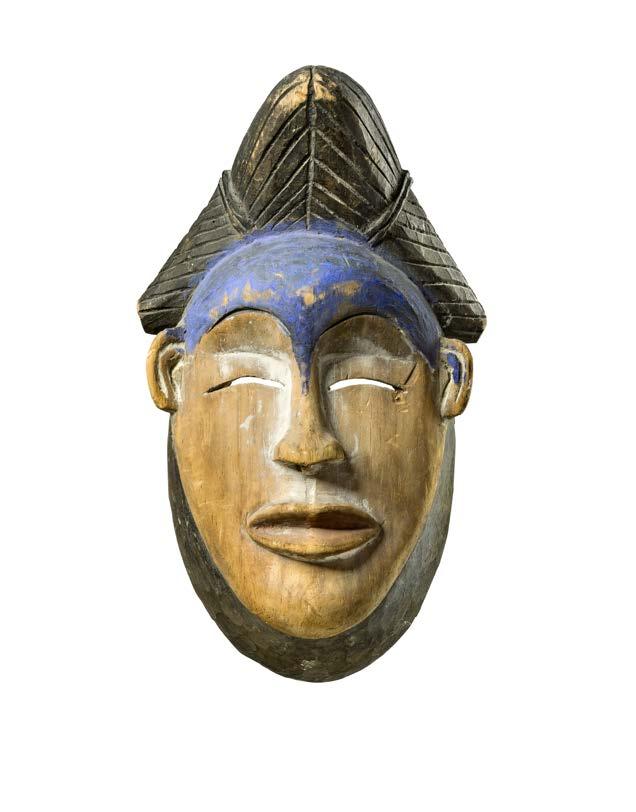
These masks represent female enti ties from the spirit world and were especially performed during mour ning rites.
H: 29 cm
€ 900 - 1.500
295 Stehende weibliche Figur Holz, rest., Sockel
Standing female figure wood, rest., base
H: 42 cm
Bruno Frey, Arnay le Duc, France
€ 1.000 - 2.000
296 Weibliche Miniaturfigur Holz, Kaolin
Female miniature figure wood, kaolin
H: 19,5 cm
€ 800 - 1.600
292 Männliche Reliquiar-Wäch terfigur „éyéma-o-byéri“ („Bild des Ahnen“) Holz, Sockel
Male reliquary guardian figure „éyéma-o-byéri“ („Image of the ancestor“) wood, base
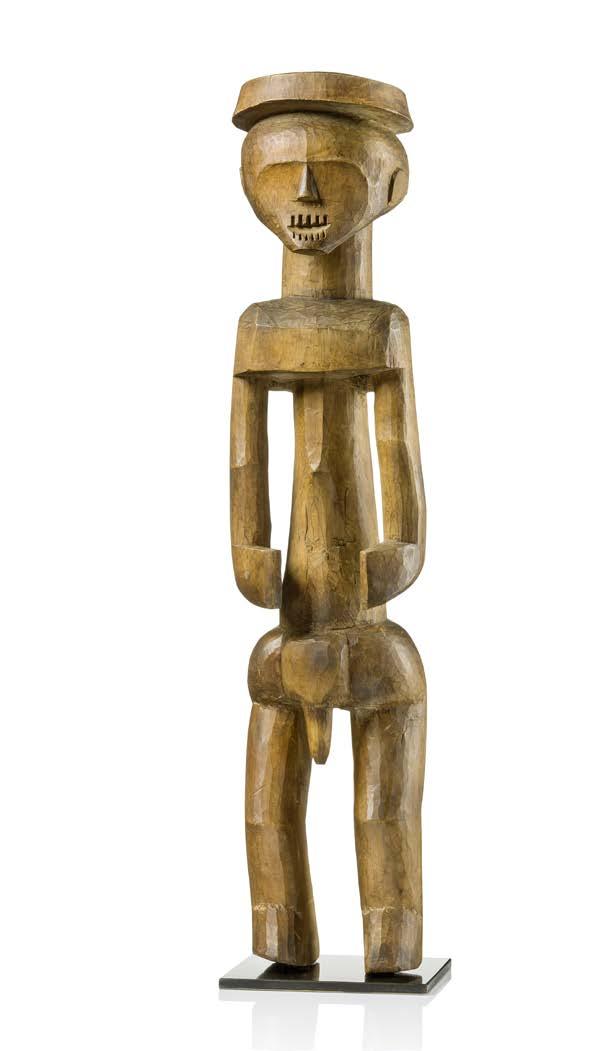
50
German Colonial Collection, pre 1918
Die Kota haben den Brauch, Knochen, Schädel und andere Reliquien verstor bener Häuptlinge und wichtiger Mit glieder der Gemeinschaft (zusammen mit magischen Substanzen) in ge flochtenen Rattankörben aufzube wahren. Diese Behälter „bwete“, wer den von figürlichen Skulpturen aus Holz und Messing bekrönt, von denen man glaubt, dass sie die Schutzgeister der Ahnen verkörpern, die sich in den Behältern befinden. Ensembles aus Ahnenschrein und Wächterfigur sind als „mbulu ngulu“ „mboy“ oder „bwiti“ bekannt. Diese Schreine sollten es den Lebenden er möglichen durch Opfergaben mit den Ahnen im Geisterreich zu kommuni zieren. Die Praxis der Ahnenverehrung (auch „bwete“ genannt) gewährleistet den Schutz und das Überleben der Fa miliengruppe. Über „bwete“ - Schreine werden die Ahnen auch um Hilfe bei Unglück oder Krankheit gebeten.
The Kota have the custom of gather ing the bones, skulls and other relics of deceased chiefs and important community members (together with magical substances) into woven rat tan baskets. These containers, „bwete“, are topped by figurative sculptures made of wood and brass, which are believed to embody the ancestral guardian spirits that re side in the containers.

Ensembles of ancestor shrine and guardian figure are known as „mbulu ngulu“, „mboy“ or „bwiti“. These shrines were meant to enable the living to communicate with the ancestors of the spirit realm through offerings. The practice of ancestor worship (also called „bwete“) ensures the protection and survival of the family group. Ances tors are also prayed to, through their „bwete“ shrines, to help allevi ate misfortune or sickness.

293 Reliquiarwächterfigur „mbulu-ngulu“
Holz, Kupferblech, Kaolin, Ergänzung unterhalb des rautenförmigen Griffs
Reliquary guardian figure „mbulu-ngulu“ wood, copper sheet, kaolin, addition below the diamond-shaped handle H: 51 cm € 8.000 - 15.000

297 Grabfigur „ntadi“ (pl. „mintadi“) Steatit (Speckstein)
Bei den „ntadi“ soll es sich um Gedenkfi guren hoch angesehener Persönlichkei ten handeln, die auf Gräbern platziert wurden. Daher auch die Bezeichnung der Figuren als „bitumba“ (sing. „tum ba“). Wobei die Figuren keine lebensech ten Porträts sind, sondern Spiegelungen dessen, wie ihre Auftraggeber in der Er innerung weiterleben wollten. Ungewöhnlich ist, dass hier eine weib liche Figur in Denkerpose „fumani“ dargestellt ist, was sonst üblicherwei se männlichen Figuren vorbehalten ist.
Grave figure „ntadi“ (pl. „mintadi“) steatit (soapstone)

The „ntadi“ are said to be commemora tive figures of highly respected persons that were placed on graves. Hence the designation of the figures as „bitum ba“ (sing. „tumba“). The figures are not lifelike portraits, but reflections of how their patrons wanted them to live on in memory.
It is unusual that here a female figure is represented in reflective posture „fumani“, which is usually reserved for male figures.
50,5 cm
Vgl. Lit.: Allison, Philip, African Stone Sculpture, New York 1968 € 800 - 1.500
D. R. CONGO, KONGO - VILI / YOMBE
298 Figurale Gruppe leichtes Holz, polychrome Pigmen te, rest.
Figural group light wood, polychrome pigments, rest. H: 51 cm Provenance Belgian Private Collection € 2.000 - 4.000
D. R. CONGO, BAKONGO
299 Magische Miniaturfigur „nkisi“ Holz
Miniature power figure „nkisi“ wood H: 8,5 cm € 600 - 1.200
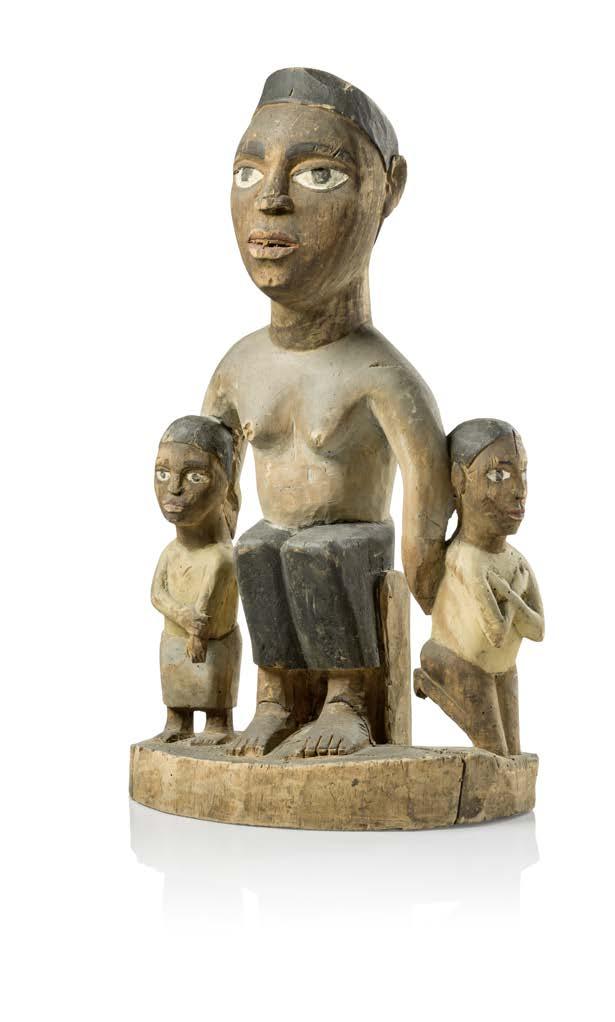
300 Magische Figur „nkisi“ Holz, schwarze Masse, Stoff, rest. Diese Figur besticht durch ein beson ders schönes Gesicht. Der nach vorn geneigte Körper und die in die Hüften gestemmten Hände erwecken den Ein druck von geballter Kraft.

Eintiefungen an Kopf und Brust, sowie Massereste ebenda und am Rücken weisen darauf hin, dass die Figur ur sprünglich reich mit magischen Subs tanzen „bilongo“ ausgestattet war, die ihr einst große Kräfte verliehen haben müssen.
Funktion und Wirkung jeder Figur wa ren immer zweckgerichtet. Sie dienten zur Abwehr von Schadenszauber, Die ben oder Krankheiten, zur Neutralisie rung drohenden Unheils, zur Kranken heilung, zur Bekräftigung eines Eides und vor allem der Wahrsagerei. Obwohl die Figuren auch auf einem Hausaltar stehen konnten, erfuhren sie keine besondere Verehrung. Es zählte allein ihre magische Wirksamkeit. Hat te die Figur diese verloren, wurde sie dem „nganga“ zurückgegeben, der sie nach „Reaktivierung“ an andere Kun den weiterveräußern durfte.
Kleinere Figuren wie die vorliegende (ca. 30-60 cm), befanden sich vermut lich im Besitz von Medizinmännern, Dorfoberhäuptern oder Einzelperso nen, die in der Gemeinschaft beson deres Ansehen genossen.
Gaetan Schoonbroodt, Verviers, Belgium
Magical figure „nkisi“ wood, blackish mass, fabric, rest. This figure captivates with a parti cularly beautiful face. The forward leaning body and the hands on the hips give the impression of concen trated power.
The depressions on the head and chest, as well as the remains of masses there and on the back indicate that the figu re was originally richly loaded with ma gical substances „bilongo“, that must once have given her great powers.
The function and effect of each figure was always purposeful. They served to ward off harmful spells, thieves or illnesses, to neutralise impending disaster, to heal the sick, to confirm an oath and above all to tell fortunes. Although the figures could also be placed on a house altar, they were not particularly revered. The only thing that counted was their magical effica cy. If the figure had lost this abilities, it was returned to the „nganga“, who was allowed to resell it to other cus tomers after „reactivation“.
Smaller figurines like the present one (about 30-60 cm), were probably ow ned by medicine men, village chiefs or individuals who enjoyed special prestige in the community.
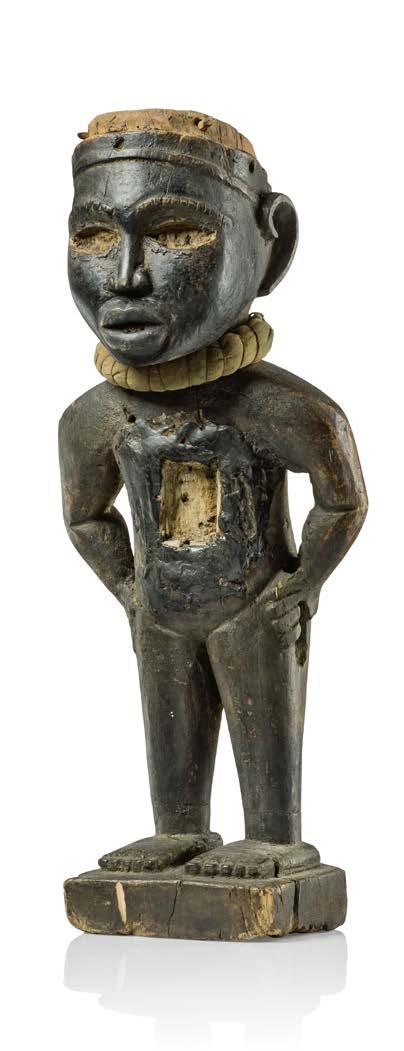
H: 42,5 cm
Vgl. Lit.: Kecskési, Maria, Afrikanische Kunst, München 1976, p. 143 € 4.500 - 8.000
Das lange Gewand mit KreuzOrnamentik am Saum, als auch die Anordnung des Kindes auf dem rechten Arm, lassen an christliche Madonnenfiguren denken.

The long robe with cross orna mentation at the hem, as well as the arrangement of the child on the right arm remind of Christian Madonna figures.
H: 76 cm
€ 1.000 - 2.000
301
301 Kniende weibliche Miniaturfigur Holz, Kaolin, Brandzier
Kneeling female miniature figure wood, kaolin, pokerwork
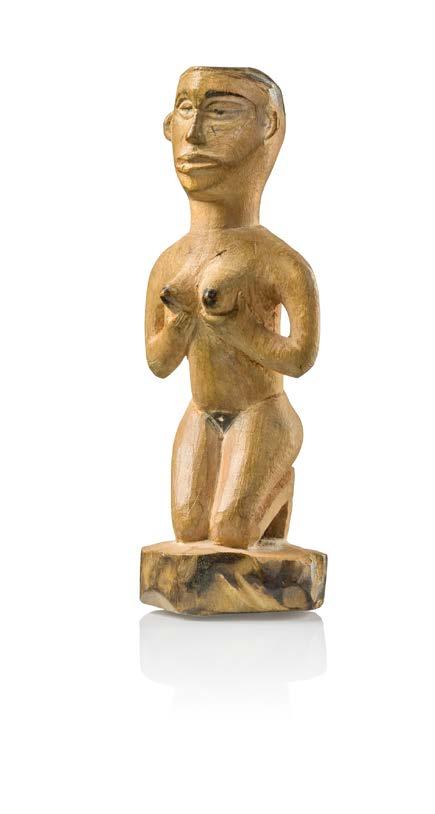
H: 13,5 cm
€ 800 - 1.500
Diese Stäbe waren Symbol für hohen Status und Autorität und befanden sich im Besitz von wichtigen Amtsinhabern, Häuptlingen und Königen.
Titleholder‘s staff „mvwala“ wood, glass, kaolin, remains of magical mass
These staffs were symbols of high status and authority and were owned by im portant office holders, chiefs and kings.

H: 139 cm
Provenance Belgian Private Collection
€ 1.600 - 2.500
Reich beschnitzt mit symbolhaften Mo tiven, wie Schlangen, als Hinweis auf den Schöpfungsmythos der Bakongo. Bekrönt von einer knienden weiblichen Figur und einer Hand, als Symbol der Macht.
Titleholder‘s staff „mvwala“ wood
Richly carved with symbolic motifs, such as snakes, as an indication of the creati on myth of the Bakongo. Crowned by a kneeling female figure and a hand as a symbol of power.

H: 107 cm
Provenance Robert Temple, Ghent, Belgium
Belgian Private Collection
AHDRC: 0160793
€ 1.200 - 2.400
308 Anthropomorphes Reibeorakel „itombwa“ Holz
Anthropomorphic friction oracle „itombwa“ wood
L: 39 cm
Provenance Belgian Private Collection
€ 1.000 - 2.000
309 Figuraler Untersatz / Ständer Holz, Beschriftung in erhabenen Lettern „Madene a Misiel a Bakuba a Bolo“, rest., Sockel
Figuren mit markanten Gesichtszü gen. Besonders auffallend, die jeweils linke Hand der Figuren, die übergroß und in flachem Relief gearbeitet ist.
Figural base / stand wood, inscription in raised letters „Madene a Misiel a Bakuba a Bolo“, rest., base
Figures with distinctive facial fea tures. Particularly striking is the left hand of each figure, which is over sized and worked in flat relief.
H: 41,5 cm
Provenance
Belgian Private Collection € 1.400 - 2.800
310 Aufbewahrungsbox mit Deckel Holz, Rattan
Lidded storage box wood, rattan
M: 15,5 cm x 24 cm x 16,5 cm
Vgl. Lit.: Sieber, Roy, African Furniture & Household Objects, Bloomington 1980, p. 185
€ 500 - 1.000
D. R. CONGO, KUBA-SHOOWA
311 Raphiagewebe „mbal“ Raphiapalmfaser („raphia vinife ra“), Stielstich und Florstickerei („Kasaiplüsch“)
Woven raffia fabric „mbal“ raffia palm fibre („raphia vinifera“), stem stitch and cut-pile embroidery („kasai plush“)
M: 50 cm x 53 cm
Provenance Banque Belgolaise, Brussels, Belgium
€ 800 - 1.500
312 Stehende weibliche Figur Holz, Farbpigmente, rest., Sockel
Standing female figure wood, colour pigments, rest., base H: 53 cm
Provenance Robert van der Heijden, Amsterdam, The Netherlands
Vgl. Lit.: Anne-Marie Bénézech, „Socalled Kuyu Carvings“, in: African Arts, November 1988, Vol. XXII, No 1, p. 52-59
Anne-Marie Bénézech, „The deferred Discovery of Kuyu Art, in: Tribal Art Magazine, No 83, Spring 2017, p. 92-107
€ 1.000 - 2.000
305 Vorderlader Gewehr Holz, Metall, Leder, Steinschloss mit Feuerstein, Gravur am Schaft „LO III 73“
Muzzleloading rifle wood, metal, leather, flintlock with flintstone, engraving on the shaft „LO III 73“
L: 136,5 cm
Vgl. Lit.: Tirri, Anthony C., Islamic and Native Weapons of Colonial Africa 1800 - 1960, Indiana 2007, p. 478, Fig. 6-63 € 300 - 600
306 Figurales Objekt Holz, Pigmentreste, krustierte Patina
Figural object wood, pigment residues, encrusted patina H: 23 cm
Provenance Belgian Private Collection € 1.200 - 2.400
307 Trinkbecher für Palmwein Holz
Palm wine drinking cup wood H: 19 cm € 300 - 600

313 Kopfskulptur des Schlangen kultes
Holz, Kaolin, menschliches Haar, Pflanzenfasern, altes Sammlungs etikett „a 22 164/10 206/1“, Sockel Diese Kopfskulpturen werden von den Kuyu bei Zeremonien zu Ehren des Schlangengottes verwendet. Verschiedene Akteure treten nachei nander auf. Zu ihnen gehören u. a. die „eouya“ (die „Schlangenmenschen“) und das Urahnenpaar („djokou“, der Vater und „ebotita“, die Mutter). Am Ende der Darbietung erscheint „ebon go“, die „große Schlange“ und Vater der „eouya“.
Head sculpture of the snake cult wood, kaolin, human hair, plant fib res, old collection label „a 22 164/10 206/1“, base
These head sculptures are used in Kuyu ceremonies honoring the sna ke god. Different actors appear one after the other. Among them are the „eouya“ (the „snake people“) and the primordial couple („djokou“, the father and „ebotita“, the mother). At the end of the performance, the chief initatior reveals „ebongo“, „the great serpent“ and father of the „eouya“.

314 Anthropomorphe Maske Schildkrötenpanzer, Pflanzenfaser, rotes Pigment
Die Lega verehren Schildkröten, die sie aufgrund ihrer langsamen Bewe gungen für besonders bedächtig und klug halten.
Die Verwendung ihrer Panzer für Initiationsornamente der „bwami“Gesellschaft soll die Weisheit der al terwürdigen Mitglieder des Bundes symbolisieren.
Anthropomorphic mask turtle shell, plant fibre, red pigment
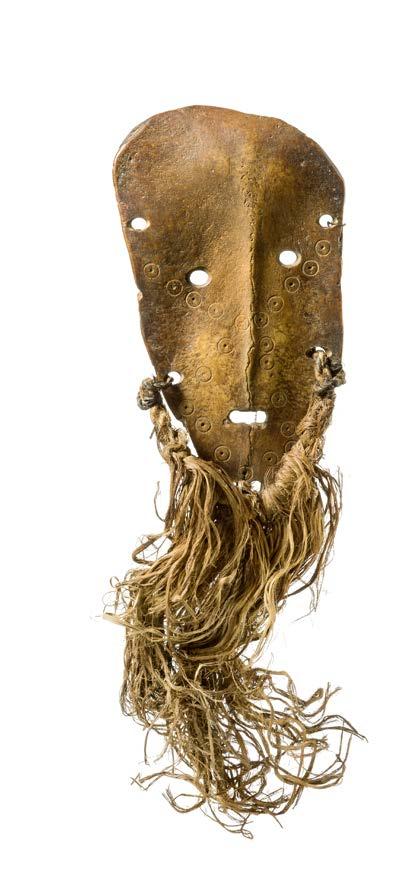
The Lega adore turtles, which they consider to be particularly cautious and wise because of their slow movements.
The use of their shells for initiation ornaments of the „bwami“ society is meant to symbolize the wisdom of the older senior members of the society.
H: 14,7 cm; ca. 25 cm (with beard)
€ 3.500 - 5.000
315 Anthropomorphe Gesichts maske Holz, Federn, Grasfaser, Kaolin, Sockel
Anthropomorphic face mask wood, feathers, grass fibres, kaolin, base
H: 27 cm
Provenance
Frank Elgar (1899-1978) Collection, France
Tessier & Sarrou, Paris-Drouot, „Coll ection d‘un critique d‘art Frank Elgar, Fernand Leger“, 2 July 2020, Lot 51
Belgian Private Collection
€ 1.000 - 2.000
Lot 316
316 Anthropomorphe Maske „idimu“ Holz, Kaolin
Anthropomorphic mask „idimu“ wood, kaolin

H: 31 cm
Provenance Belgian Private Collection
€ 1.500 - 3.000
Masken der Lega gehören zur Katego rie der Initiationsobjekte des „bwami“- Bundes. Es werden fünf Typen unterschieden: „lukwakongo“, „kayamba“, „idimu“, „muminia“ und „lukungu“. Die Masken dienen als wichtige Rangzeichen, die ihren Besitzer als Mitglied einer bestimmten „bwami“- Initiationsstufe ausweisen. „Idimu“- Masken werden von Ange hörigen des „yananio“ oder „kindi“Initiationsgrades verwendet.
Alle Masken der Lega dienen als didaktische Unterstützung bei den Tänzen, Liedern und erzählten Sprich wörtern, die den Initianten den idealen Verhaltenskodex der LegaGesellschaft vermitteln sollen.
Lega masks fall into the category of „bwami“ initiation objects. The Lega divide them into five types: „lukwakongo“, „kayamba“, „idimu“, „muminia“ und „lukungu“. The masks serve as an important mark of rank, identifying the owners as members of specific „bwami“ levels. „Idimu“ masks are used by members of the „yananio“ or „kindi“ initiation level. All masks of the Lega are used as didactic supports during the dances, songs and narrated proverbs that transmit the Lega code of ideal con duct to the new initiates.
D. R. CONGO, LEGA
317 Anthropomorphe Maske „idimu“ oder „lukwakongo“ Holz, rotes Pigment
Anthropomorphic mask „idimu“ or „lukwakongo“ wood, red pigment
H: 23,5 cm
Provenance Belgian Private Collection € 1.000 - 2.000
D. R. CONGO, LEGA
318 Anthropomorphe Maske „lukwakongo“ Holz, Pflanzenfaser
Anthropomorphic mask „lukwakongo“ wood, plant fibre
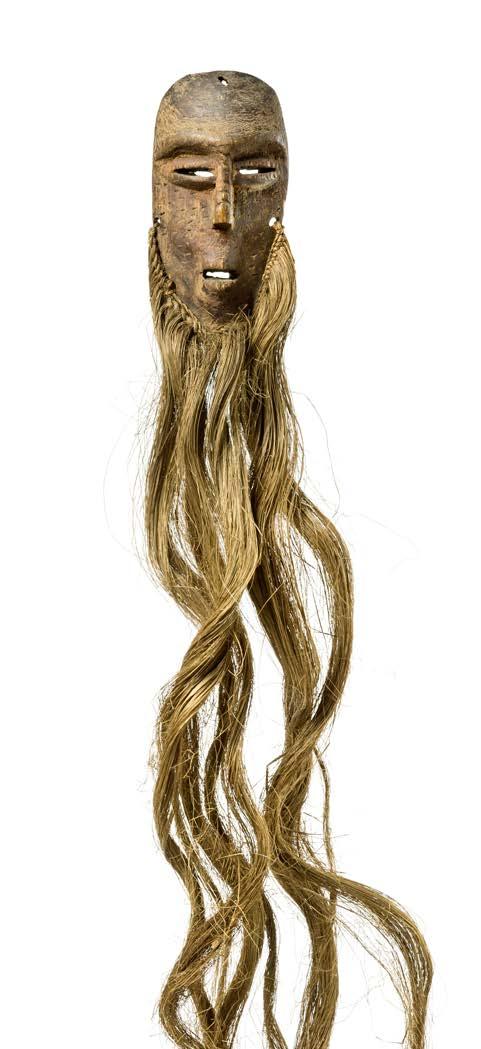
H: 12,5 cm / 55 cm (with beard)
€ 1.000 - 2.500

322Lot 320 Lot 321
320 Anthropomorphe Figur „iginga“ (pl. „maginga“) (*) Knochen, Pigment
Anthropomorphic figure „iginga“ (pl. „maginga“) (*) bone, pigment
H: 13,5 cm
Provenance Belgian Private Collection € 1.000 - 2.000
321 Anthropomorphe Figur „iginga“ (pl. „maginga“) (*) Knochen, schwarze Masse, Bruchstelle
Anthropomorphic figure „iginga“ (pl. „maginga“) (*) bone, blackish mass, breakage


H: 19,5 cm
Provenance Belgian Private Collection Vgl. Lit.: Cameron, Elisabeth L., Art of the Lega, Los Angeles 2001, p. 120 f. € 1.500 - 2.500
322 Anthropomorphe Figur „iginga“ (pl. „maginga“) (*)
Knochen
Anthropomorphic figure „iginga“ (pl. „maginga“) (*) bone

H: 13 cm
Provenance Belgian Private Collection € 600 - 1.200
323 Weibliche Figur „wayinda“ Holz, Sockel
Vorliegende Figur stellt weder eine Fruchtbarkeitsfigur noch eine „nor male“ schwangere Frau dar, sondern eine schwangere Ehebrecherin, auf der wegen ihres unerlaubten Verhal tens ein Fluch lastet.
Die Figur gehört zu den „isengo“ (pl. „masengo“) genannten Skulpturen, die zur Vermittlung der Lehren und moralischen Vorstellungen des „bwa mi“- Initiations-Bundes dienen.
Female figure „wayinda“ wood, base

Present figure does not portray a fer tility figure nor a „normally“ pregnant woman, but a pregnant adulteress on whom weighs a curse because of her illicit behaviour.
The figure belongs to the sculptu res called „isengo“ (pl. „masengo“), which serve to convey the teachings and moral concepts of the „bwami“ initiation society.
H: 31 cm
Provenance
American Private Collection
Janus figure „kabeja“ wood, base
H: 26,5 cm
Vgl. Lit.: Roberts, Mary Nooter, Memory, Luba Art and the Ma king of History, New York 1996, p. 201
€ 500 - 1.000
325 Kopf auf Kalebasse Kürbis, Holz, Quartzkristall
Objekte wie dieses, die komplett mit Kalebasse und magischer Füllung er halten sind, sind sehr selten. Selten ist auch die Beifügung von Quartzkristall.
Ein vergleichbares Objekt publiziert bei Roberts & Maurer, 1985, S. 28, ill. 18 (AHDRC 0029772).
Halbfiguren in Kalebassen, „kabwe lulu“ genannt, wurden laut Biebuyck von der „bugabo“- Gesellschaft ver wendet. Neue Mitglieder mussten hohe Geldbeiträge leisten und wur den einer komplexen und körperlich zermürbenden Initiation unterzogen. Während der Einweihung legten die Novizen bestimmte geheime Gegen stände in den Kürbis, die sich im Laufe der Zeit anhäuften und der Skulptur
im Zusammenwirken größte magi sche Kräfte verliehen.
„Kabwelulu“ wurden zur Heilung und zur Wahrsagerei eingesetzt.
Head on gourd pumpkin, wood, quartz crystal
Objects like this, complete with cala bash and added magical elements, are very rare. Rare is also the addition of quartz crystal. A comparable object published in Roberts & Maurer, 1985, p. 28, ill. 18 (AHDRC 0029772).
According to Biebuyck half figures in calabashes, called „kabwelulu“, were used by the „bugabo“ society. New members were required to make lar ge monetary contributions and were subjected to a complex and physically grueling initiation. During initiations,
novices would place in the gourd certain secret items that would accu mulate over time until the sculpture acquired a power far greater than any of its parts. „Kabwelulu“ were used for healing and divination.
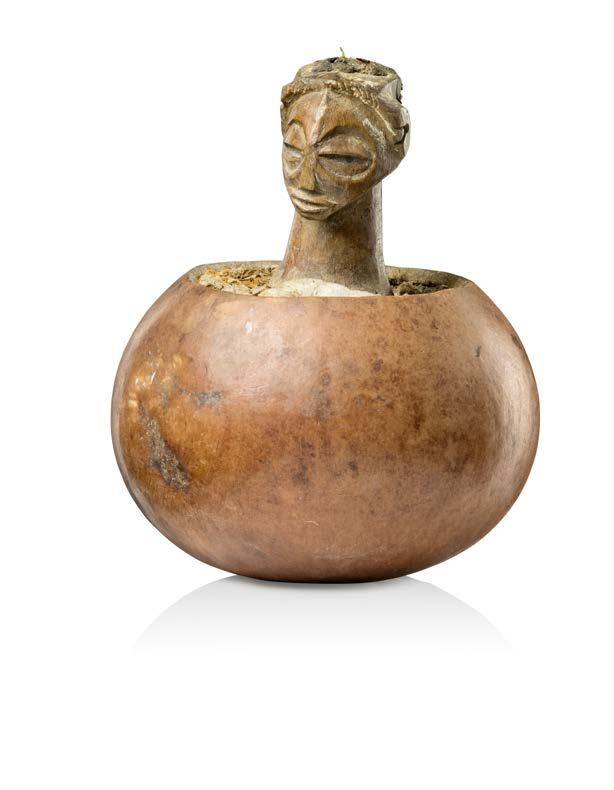
H: 15,5 cm
Vgl. Lit.: Roberts, Allen F. & Evan M. Maurer (ed.), Tabwa, Washington D.C. 1985, p. 28, Ill. 18
Vogel, Susan, For spirits and kings, Af rican Art from the Paul and Ruth Tish man Collection, New York 1981, p. 223 f. € 1.000 - 2.000
327 Reibeorakel „kakishi“ für Wahrsagerituale
„kashekesheke“
Holz, Sockel
„Kashekesheke“ ist eine der ältesten Formen der Wahrsa gerei bei den Luba, eine Tech nik zur Rekonstruktion von Er innerungen und persönlichen Geschichten zum Zwecke der Problembewältigung.
Friction oracle „kakishi“ for divination rituals
„kashekesheke“ wood, base

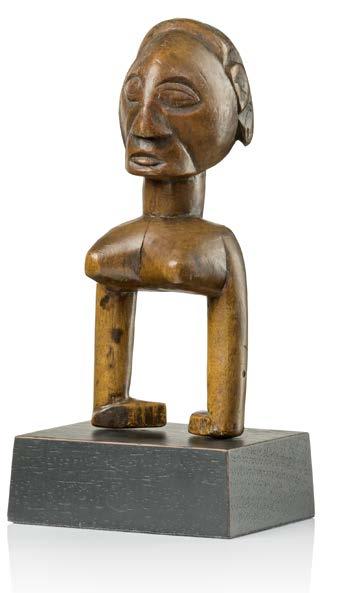
„Kashekesheke“ is one of the oldest Luba forms of divina tion, a technique to reconst ruct memories and personal histories for purposes of problem-solving.
H: 10 cm
€ 1.600 - 2.500
326 Wahrsage-Implement (Stößel) Holz
Divination implement (pestle) wood
H: 30 cm AHDRC: 0160793
Peter Biesmans, Bilzen, Belgium Belgian Private Collection
Vgl. Lit.: Herreman, Frank, To cure and protect, New York 1999, p. 31, fig. 45
€ 800 - 1.600
328 Reibeorakel „kakishi“ für Wahrsagerituale „kashekesheke“ Holz, Sockel
Friction oracle „kakishi“ for divina tion rituals „kashekesheke“ wood, base
H: 14 cm
Provenance Belgian Private Collection
Vgl. Lit.: Roberts, Mary Nooter, Memo ry, Luba Art and the Making of History, New York 1996, p. 183
€ 1.500 - 2.500
Staff of office „kibango“ wood, rest.
„Kibango“ are emblems of status. They belong to members of the ru ling classes such as kings and chiefs and other titleholders of high status such as village leaders and female spirit mediums.
Shapes, figural accessories and carved patterns provide information about the history of the respective owner and the lineage, which is why each „kibango“ is unique.
Provenance Old Colonial Collection Dries, Brussels, Belgium
€ 3.000 - 6.000
329 Amtsinhaber-Stab „kibango“ Holz, rest.
„Kibango“ sind Statussymbole von großer Macht, die Mitgliedern der herrschenden Klassen, wie Königen und Häuptlingen, sowie hohen Wür denträgern vorbehalten sind. Formen, figurales Beiwerk und auf geschnitzte Muster geben Auskunft über die Historie des jeweiligen Besit zers und der Lineage, weshalb jeder „kibango“ ein Unikat ist.
H: 138 cm
Lot 329
330 Amtsinhaber-Stab „kibango“ Holz, Sockel
Staff of office „kibango“ wood, base

H: 105 cm
Provenance Lempertz Brussels, 5 April 2017, Lot 175 Belgian Private Collection
€ 1.200 - 2.400
332 Weibliche Figur „mbulenga“ oder „lupingu“ Holz, Sockel
Female figure „mbulenga“ or „lupingu“ wood, base
H: 12 cm
Provenance Martien Coppens, Eindhoven, The Netherlands Publ. in Coppens, Martien, Negro sculpture, Eindhoven, 1975, ill. 253
€ 1.000 - 2.000
333 Anthropomorphes Gefäß „sundu“ Keramik / Terrakotta, helle Engobe
Anthropomorphic vessel „sundu“ ceramic / terracotta, light engobe
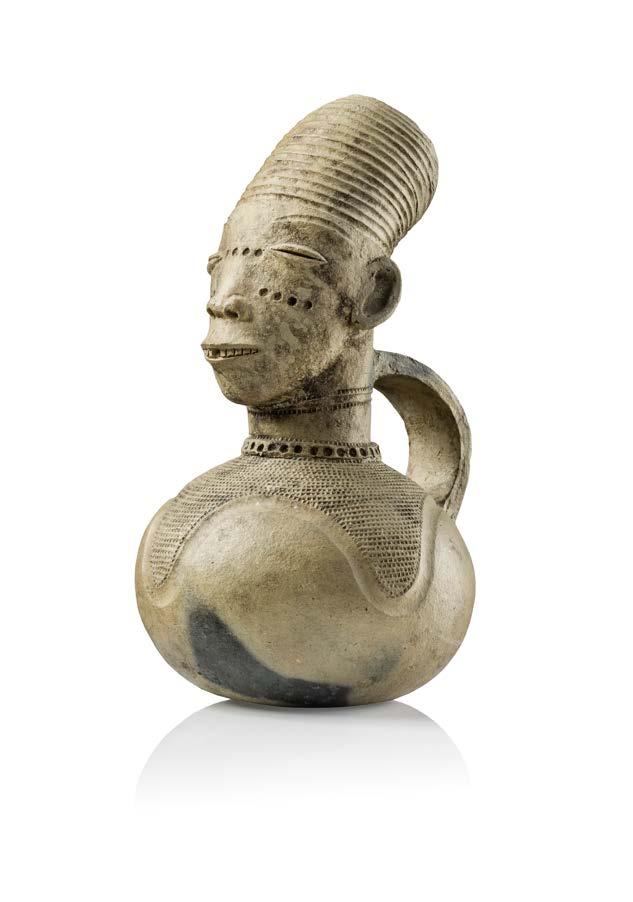
H: 23,5 cm
Vgl. Lit.: Morin, Floriane & Wastiau, Boris (ed.), African Terra Cottas, Ge neva 2008, p. 312 ff. € 2.700 - 4.000
331 Weibliche Figur „mbulenga“ oder „lupingu“ Holz, Brandzier
Diese Figuren von besonders schöner weiblicher Gestalt werden von einem Kult namens „bwanga bwa bwimpe“ verwendet, dessen vorrangige Aufga be es ist, die Fruchtbarkeit der Frauen zu fördern und die Gesundheit von Neugeborenen zu schützen.
Der Begriff „bwimpe“, der manchmal durch „(m)bulenga“ ersetzt wird, be zeichnet körperliche Schönheit als Zeichen moralischer Integrität - ver bindet die Vorstellung von schön und gut.
Nach Vorstellung der Lulua ist die Kombination aus körperlicher Schön heit und moralischer Tugend der bes te Schutz gegen Zauberei.
D. R. CONGO, LULUA (LULUWA)
Female figure „mbulenga“ or „lupingu“ wood, pokerwork These figures of particularly beautiful female form are used by a cult called „bwanga bwa bwimpe“, whose prima ry task is to promote female fertility and protect the health of newborns.

The term „bwimpe“, sometimes repla ced by „(m)bulenga“, denotes physical beauty as a sign of moral integrity, combining the idea of beautiful and good.
For the Lulua, the ideal combination of physical beauty and moral virtue con stitutes the best protection against sorcery.
H: 26 cm
Vgl. Lit.: Fagaly, William, Ancestors of Congo Square, New Orleans 2011, p. 326 f.
€ 5.000 - 10.000
334 Horn / Trompete „oliphant“(*)
Elfenbein, poliert, schwarzes Pigment, Pflanzenfaser
Die Außenwandung dieses Horns ist aufwändig verziert mit figuralen Gravuren, die Motive und Szenen aus dem häuslichen und gesellschaftli chen Leben, als auch kriegerische Handlungen zeigen.
Horn / trumpet „oliphant“ (*) ivory, polished, black pigment, plant fibre

The outer wall of this horn is elabora tely decorated with figural engravings showing motifs and scenes from do mestic and social life, as well as mar tial actions.

L: 42 cm
Joseph Christiaens, Brussels, Belgium Sotheby‘s Brussels / New York (prop. no. H 442 940)
André Vanhecke, Brussels, Belgium Zemanek-Münster, Würzburg, 15 November 2008, Lot 454
Werner Zintl, Worms, Germany
Expertise, Matthias Streckfuß, Berlin, 20 July 2022 (No 2138-07-2022)
Brussels, Belgium: „Mangbetu. Afri kaanse Hofkunst uit Belgische privéverzamelingen“, 22 October- 20 De cember 1992
AHDRC: 0034519
Vgl. Lit.: Billen Jacques & Bruno Cla essens, UNÛ - Pestigious African We apons, 2021, p. 104 ff. Felix, Marc L. (ed.), White gold, black hands, Vol. 7, Brussels 2014, p. 212 ff.
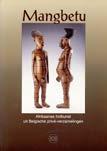
Publ. in Herman Burssens & A. Guisson, „Mangbetu, Afrikaanse Hofkunst uit Belgische privé-verzamelingen“, Brus sels 1992, p. 82, ill. 72
€ 2.000 - 4.000
Motivik, markanter Figu renstil und die flächig eingesetzten linearen Gravuren erinnern an Werke der Meister „Chief Songo Assali“ und „Zaza“ (vom Avungura Klan) aus dem Dorf Poko am Pomo kandi River, einem südli chen Nebenfluß des Uele Rivers (vgl. Billen & Claes sens, 2021, S. 104 ff. und Felix, Vol. 7, 2014, S. 212 ff.)
The motifs, the striking figural style and the linear engravings are reminis cent of works by the mas ters „Chief Songo Assali“ and „Zaza“ (of the Avun gura clan) from the village of Poko on the Pomokandi River, a southern tributary of the Uele River (cf. Billen & Claessens, 2021, p. 104 ff. and Felix, Vol. 7, 2014, p. 212 ff.).

335 Zauberfigur „nkisi“ / „nkishi“ Holz, Farbreste, Glas, magische Ladung
Power figure „nkisi“ / „nkishi“ wood, paint residues, glass, magical charge
H: 50 cm
€ 1.000 - 2.000
336 Stehende weibliche Figur / Mörser
Holz, rest.
Die Figur weist diverse Öffnungen zum Einfügen magischer Ladung auf. Durch die angeschnitzte Schale auf dem Kopf konnte sie als Mörser verwendet werden. Mörser zählen bei den Mbala zu Prestigeobjekten. Figürliche Skulptur generell war meist Teil des Häuptlingsschatzes.
Standing female figure / mortar wood, rest. The figure has various openings for inserting magical charge. Due to the carved bowl on the head, it could be used as a mortar. Mortars are presti gious objects among the Mbala. Figu ral sculpture in general was usually part of the chief‘s treasure.
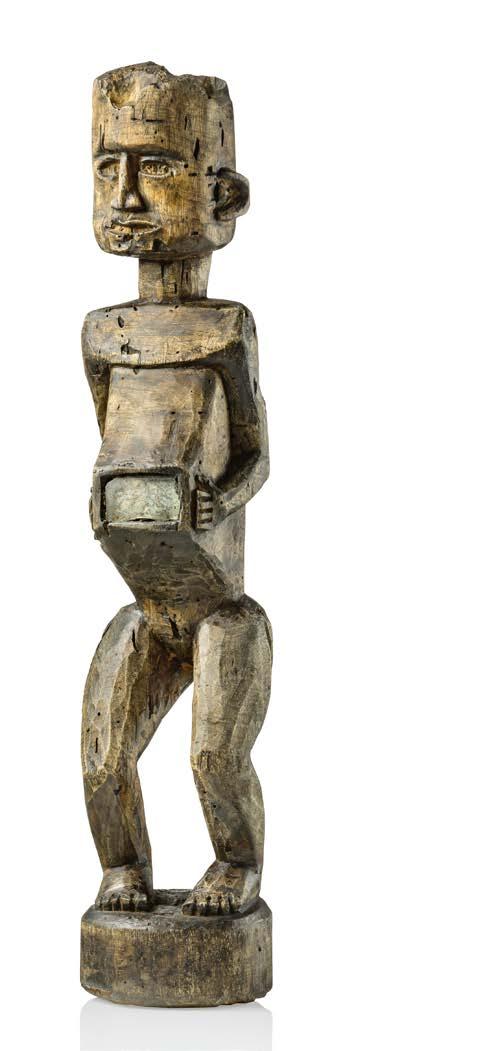
H: 22 cm
Provenance Belgian Collection
€ 5.000 - 10.000
Für Figuren desselben Künstlers siehe AHDRC 0017203, 0017319 und 0017324. Es liegen stilistische Gemeinsamkeiten bezüglich Körperbildung und Physig nomie vor. Man betrachte die schma len länglichen Augen, den Mund mit „gefletschten“ Zähnen, die fein gestri chelten Augenbrauen, ebenso die Form der Ohren oder die Frisur.
For figures by the same artist, see AHDRC 0017203, 0017319, and 0017324. There are stylistic similarities in terms of body formation and physiognomy. Consider the narrow elongated eyes, the mouth with „bared“ teeth, the fine ly dotted eyebrows, as well as the shape of the ears or the hairstyle.



337 Flechtschild
Rattan, Holz, altes Transportlabel („Compagnie générale transatlantique“)
Plaited shield rattan, wood, old transport label („Compagnie générale transatlantique“)
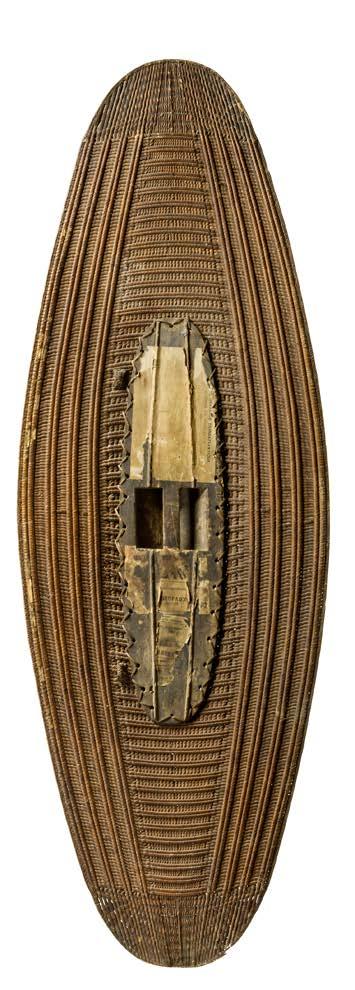
H: 144,5 cm; B: 50 cm
Provenance Rossini, Paris, 1 December 2021, Lot 236
AHDRC: 0191784
Vgl. Lit.: Baur, Ivan & Jan Elsen, Guba, Brussels 2002, p. 106 f.
€ 1.500 - 2.800
Squatting figure wood H: 16 cm
Provenance Belgian Private Collection € 1.000 - 2.000
„mbuya ya mbangu“ Holz, Farbpigmente, Pflanzenfaser, Sockel
Die Maske stellt ein durch Lähmung des Gesichtsnervs verzerrtes Gesicht dar.
Die Pende glauben, dass der Betreffen de ein Opfer von Zauberei ist, verhext von einem Rivalen, der ihn aus Eifer sucht mit einer Krankheit / Missbildung belegt hat.
„mbuya ya mbangu“
wood, light green dyed kaolin, black colour, plant fibre, base
The mask represents a face distorted by a paralysis of the facial nerve.
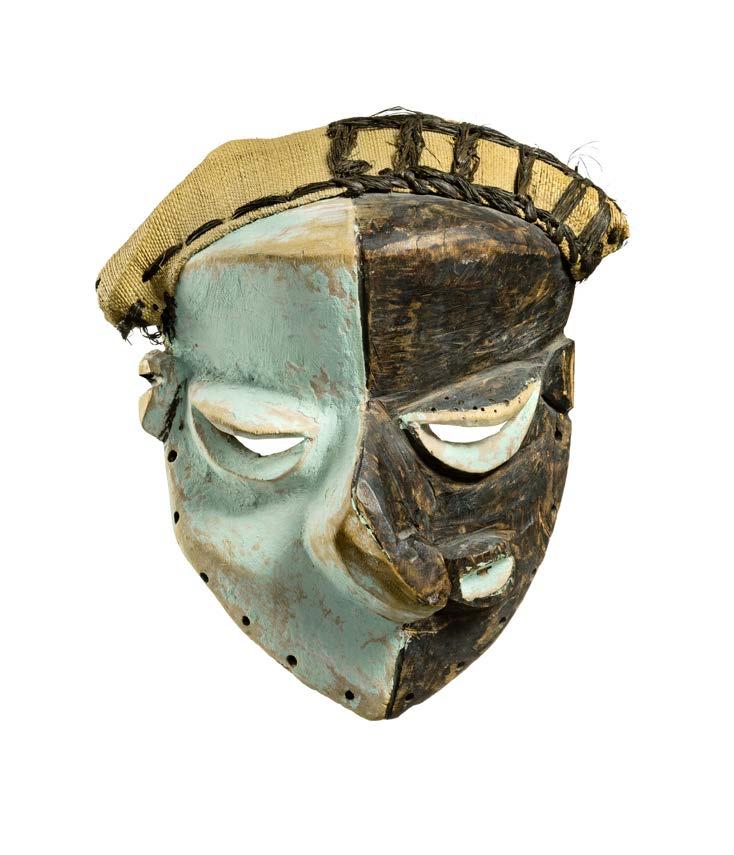
The Pende believe that the person in question is a victim of sorcery, bewit ched by a rival who, out of jealousy, has inflicted a disease / deformity on him.
1999,
cure and
341 Sitzende weibliche Figur Holz
Sitting female figure wood
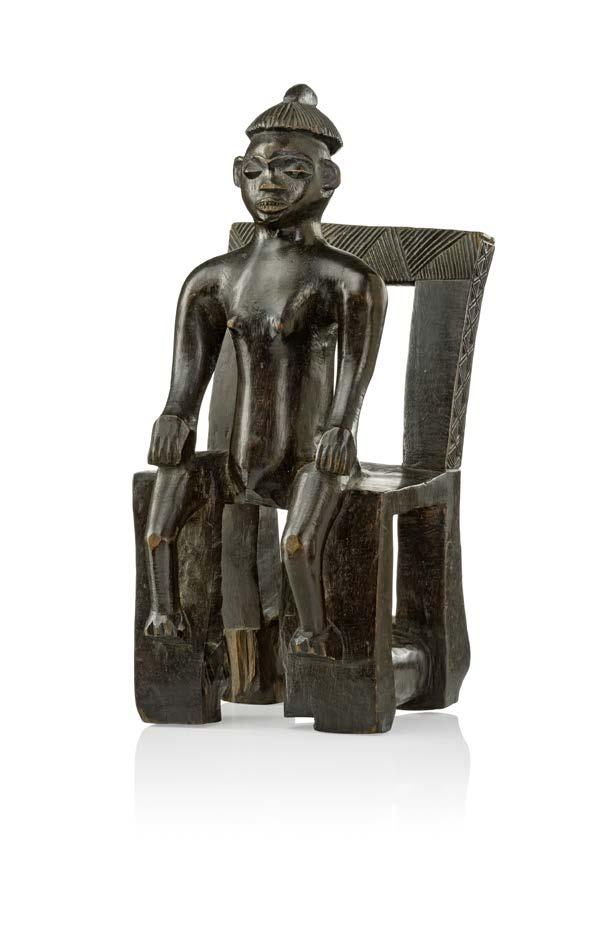
Provenance Jean-Marc Desaive, Soumagne, Belgium Belgian Private Collection H: 35,5 cm; B: 14,5 cm € 2.000 - 4.000
342 Anthropomorpher Doppelbecher Fig. s. Seite/page 115 Holz
Anthropomorphic double cup wood H: 20,5 cm € 450 - 800
340 Weibliche Figur „kangulungu“
Holz, handschriftl. aufgebrachte In ventarnr. „C28“, Sockel
Laut Strother wurden freistehende Figuren im Ritualhaus „kibulu“ des Häuptlings aufbewahrt, wo sie als Machtobjekte gleichermaßen zum Schutz und zur Disziplinierung des Häuptlings dienten.
Female figure „kangulungu“ wood, handwritten inventory no. „C28“, base
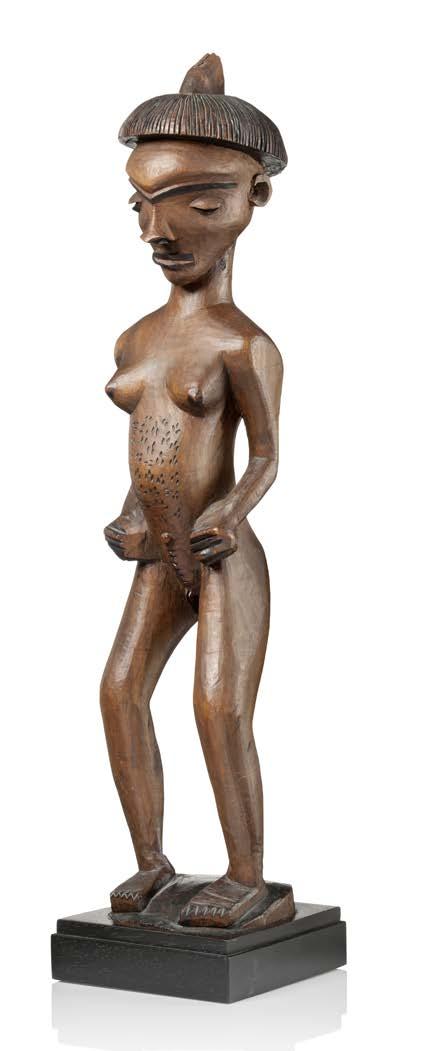
According to Strother, free-standing figures in the round were kept in the inner chamber of the chief‘s ritual house „kibulu“, where they served as power objects used both to protect and discipline the chief.
Jean-Marc Desaive, Soumagne, Belgium Belgian Private Collection
Vgl. Lit.: Strother, Z.S., Pende, Mailand 2008, p. 108, pl. 40
€ 3.000 - 5.000
344 Weibliche Zauberfigur „nkisi“ Holz
Female power figure „nkisi“ wood
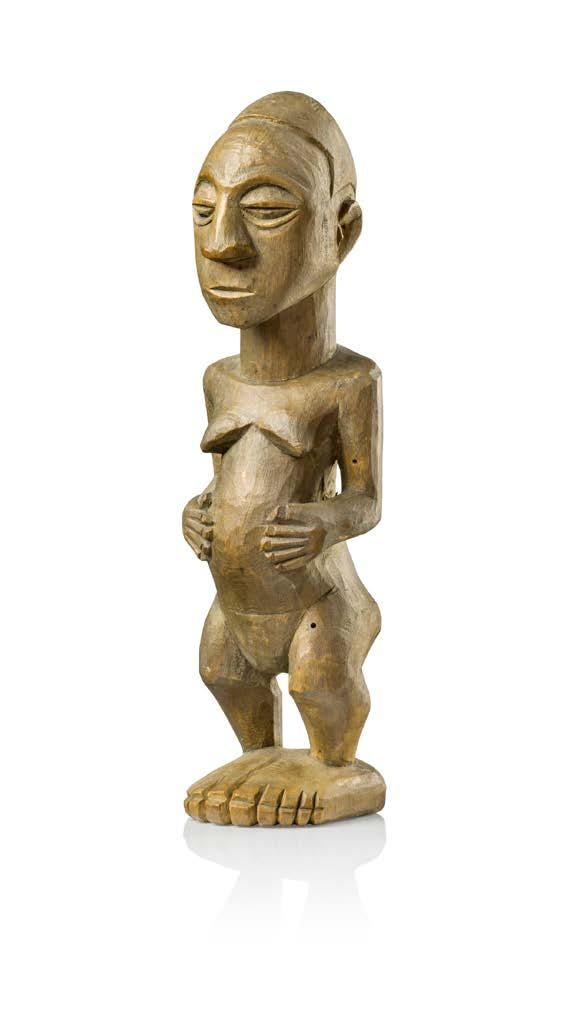
H: 20 cm
€ 1.000 - 2.000
345ff s. Seite/page 138ff
D. R. CONGO, UBANGI / NGATA
350 Stab / Spazierstock
Holz, Brandzier
Stick / walking stick wood, pokerwork
L: 89,5 cm
€ 500 - 1.000
Lot 344
351 Janusförmiger Kopfbecher Fig. s. Seite/page 115 Holz, stellenweise ölige Patina
Janus-shaped anthropomorphic cup wood, oily patina in places
H: 17 cm; B: 14 cm
€ 900 - 1.800
343 Stehende Figur, eine zweite auf den Schultern tragend Holz, Miniaturglasperlen, rest., Sockel Sehr schön gearbeitete Figur mit klar definierten Körperformen und fein ausgeschnitzten Gesichtszügen.
Standing figure carrying a second on his shoulders wood, miniature glass beads, rest., base
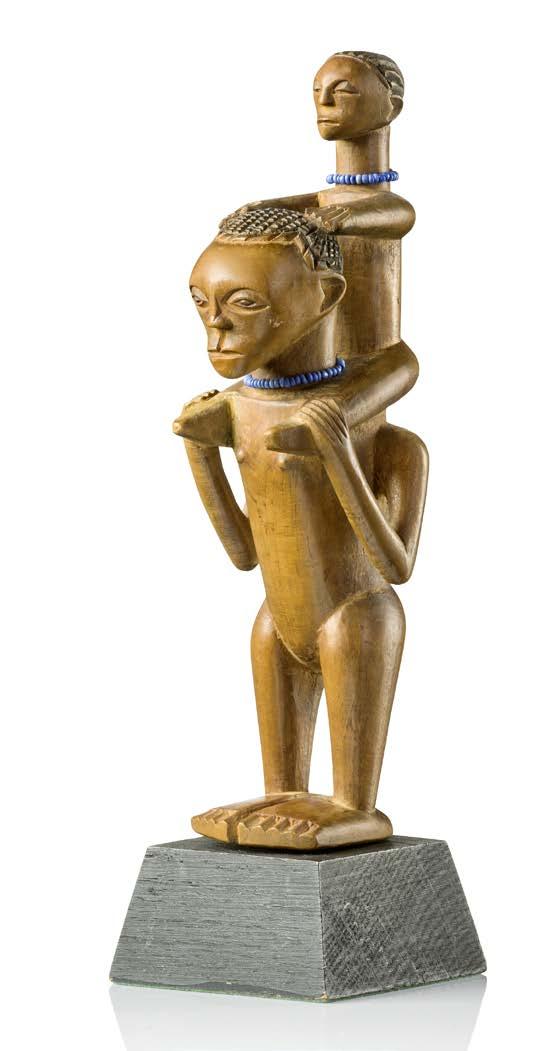
Very nicely crafted figure with clearly defined body forms and finely carved facial features.
Alain Guisson, Brussels, Belgium
Jean-Marc Desaive, Soumagne, Belgium Belgian Private Collection
Vgl. Lit.: cf. AHDRC 0040869 € 3.000 - 5.000
345 Stehende männliche Figur mit Stab Holz, geschwärzt, auf hockerartiger Basis, rest.
Standing figure with staff wood, blackened, on stool-like base, rest. H: 41 cm


American Private Collection
Vgl. Lit.: Roberts, Allen F. & Evan M. Mau rer (ed.), Tabwa, Washington D.C. 1985, S. 79, ill. 55
Plankensteiner, Barbara, Austausch. Kunst aus dem südlichen Afrika um 1900, Wien 1998, p. 125, ill. 84-88 € 8.000 - 16.000
Roberts & Maurer odne ten eine stilistisch ver gleichbare Figur einer Tabwa Werkstatt zu, die sie nach Tansania, auf die Ostseite des Tanganjika sees, in die Gegend von Ujiji verorteten (vgl. Ro berts & Maurer, 1985, S. 79, ill. 55). Hier siedelte sich eine Untergruppe der Tabwa an, die als Ijiji bekannt wurde.
Roberts & Maurer attributed a stylisti cally comparable figure to a Tabwa workshop, which they located in Tan zania, on the east side of Lake Tanga nyika, in the area of Ujiji (cf. Roberts & Maurer, 1985, p. 79, ill. 55). A subgroup of the Tabwa, who became known as the Ijiji, settled here.
Photo: RMCA TervurenIm Weltmuseum in Wien findet sich eine Gruppe von Figuren, die zwi schen 1914 und 1916 von dem deut schen Marineoberleutnant Wunder lich gesammelt wurden, der in der Region Lake Tanganjika / Lake Kivu stationiert war. Auch sie wurden bei den Tabwa oder Ijij verortet (AHDRC 0165985).
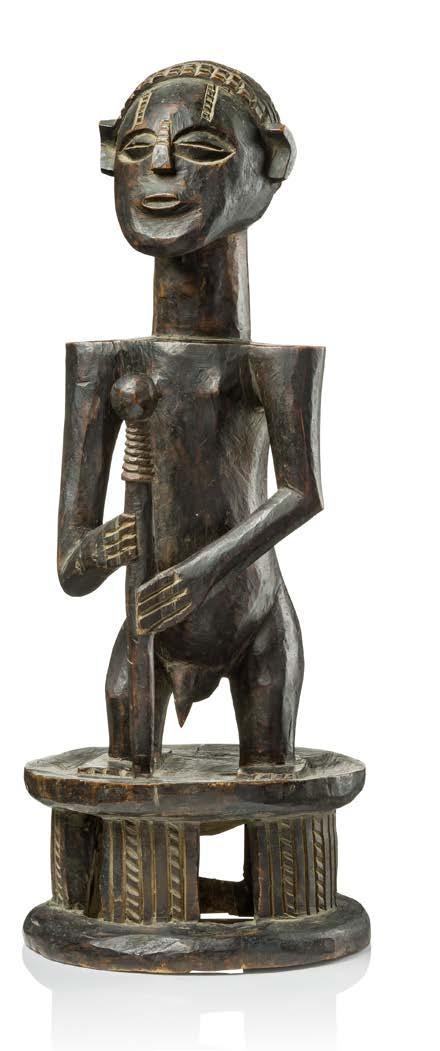
In the Weltmuseum in Vienna there is a group of figures collected by the German Navy First Lieutenant Wunderlich, who was stationed in the Lake Tanganyika/ Lake Kivu re gion between 1914 and 1916. They were also located among the Tabwa or Ijij (AHDRC 0165985).
 Photo: Weltmuseum Wien
Photo: Weltmuseum Wien
Zauberfigur „buti“ Holz, Pigmente
Power figure „buti“ wood, pigments
Lit.: Felix, Marc L., 100 Peoples of Zaire and their Sculpture, Brus sels 1987, p. 172 f.

348 Zauberfigur „buti“ Holz, magische Masse, Sockel
Power figure „buti“ wood, power charge, base
H: 25,5 cm
Provenance Belgian Private Collection € 1.200 - 2.000
349 Männlich-weibliches Figuren paar Holz, Fehlstellen, jeweils gesockelt
Male-female figural couple wood, missing parts, on bases

H: 55 cm (each)
Provenance Italian Collection
Belgian Private Collection
€ 3.000 - 6.000
350f s. Seite/page 136
D. R. CONGO, YAKA / SUKU
352 Zauberfigur „buti“ Holz, Sockel
Power figure „buti“ wood, base
H: 13,5 cm
€ 700 - 1.400
D. R. CONGO, YANZI
353 Stehende anthropomorphe Figur „mbem“ Holz
Standing anthropomorphic figure „mbem“ wood
H: 16 cm
Vgl. Lit.: Felix, Marc L., 100 Peoples of Zaire and their Sculpture, Brüssel 1987, p. 196 f.
€ 700 - 1.400
354 Nagelfetisch Fig. s. Seite/page 140 Holz, Metall
Nail fetish wood, metal H: 25,5 cm
€ 600 - 1.200
ANGOLA, CHOKWE
355 Stehende Figur Holz, Brandzier, rest.
Standing figure wood, pokerwork, rest. H: 27,5 cm
€ 250 - 500
ANGOLA, CHOKWE OR LUNDA
356 Schmuck-Kamm „cisakulo“ Holz, zwölf Zinken, Sockel
Ornamental comb „cisakulo“ wood, twelve teeth, base
H: 20 cm
Provenance German Collection
€ 400 - 800
358 Vier Kopf- / Nackenstützen „ocihaylo“
Holz, a) H: 15,5 cm; B: 14 cm (Auflage); b) H: 14,5 cm; B: 12,3 cm (Auflage) c) H: 12 cm; B: 11 cm (Auflage); d) H: 16 cm; B: 12,5 cm (Auflage)
Die Mucubal sind eine Untergruppe der Herero im Süden Angolas (Provinz Namibe), die als Halbnomaden von Viehzucht und Ackerbau leben.
Foru head- / neckrests „ocihaylo“ wood, a) h: 15,5 cm; w: 14 cm (pillow); b) h: 14,5 cm; w: 12,3 cm (pillow) c) h: 12 cm; w: 11 cm (pillow); d) h: 16 cm; w: 12,5 cm (pillow)
The Mucubal people are a subgroup of the Herero people in southern An gola (province Namibe), who live as semi-nomads from cattle breeding and agriculture.
€ 800 - 1.200
359 Zwei weibliche Figuren Holz, a) Figur mit Kammfrisur, Mes singblech, Nägel, H: 34 cm; b) Figur mit bauchigem Gefäß, H: 32,5 cm, rest.
Two female figures wood, brass sheet, nails, a) figure with crested coiffure, brass sheet, nails, h: 34 cm; b) figure with bulbous vessel, h: 32,5 cm, rest.
€ 1.000 - 2.000
Weibliche Karyatidenfigur mit besonders schönen Gesichts zügen und fein gearbeiteten Skarifikationen.
Female caryatid figure with parti cularly beautiful facial features and finely worked scarifications. H: 24,5 cm; D: 20 cm € 3.500 - 6.000
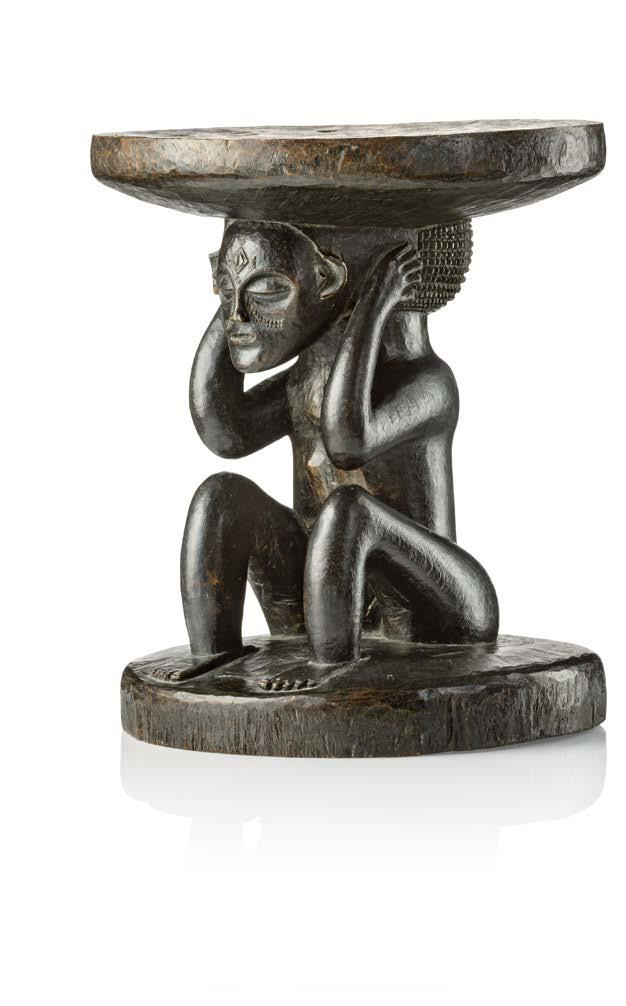
360 Colonfigur eines „Askari“ Holz, Metall
Colon figure of an „askari“ wood, metal

H: 43 cm
Jim Lennon, Northern Ireland Bonhams, Edinburgh, 26 Janu ary 2022, Lot 440
€ 800 - 1.500
361 Fein gearbeiteter
Perlenhut „ogut tigo“ Stoff, bunte Miniaturglasperlen
Fine beaded hat „ogut tigo“ cloth, colourful miniature glass beads

H: 8 cm; D: 17 cm
Provenance
Adam Prout, Worcestershire, Great Britain
€ 1.500 - 3.000
362 Deckelkorb Pflanzenfaser
Lidded basket plant fibre H: 18 cm; D: 26 cm € 600 - 1.200
REGION / NGURU MOUNTAINS, KAGURU / SAGARA / LUGURU
Holz, Spuren von Verwitterung, Sockel

Diese Pfähle waren im Zentrum von Initiationshütten junger Mädchen angebracht.
Meurant berichtet von ungefähr vier zig dieser Pfähle, die in der Umgebung von Morogoro gesammelt wurden. Bei Jahn ist eine Auswahl davon in Form von Skizzen wiedergeben, von denen einer dem vorliegenden weitgehend entspricht (Jahn, 1994, S. 223 V / 7).
Die Pfähle, die mehr oder weniger stilisiert Brüste und einen Kopf er kennen lassen, stellen laut Meurant die Mutter dar, mit der sich die jungen Mädchen identifizieren sollen.
Jens Jahn, Munich, Germany
South German Private Collection
Vgl. Lit.: Jahn, Jens (Hg.), Tanzania, München 1994, p. 223 V/7
Initiation post wood, traces of weathering, base These posts formed the center pole in initiation huts for young girls.
Meurant reports about forty of these posts collected in the vicinity of Mo rogoro. Jahn reproduces a selection of them in the form of sketches, one of which largely corresponds to the present one (Jahn, 1994, S. 223 V / 7).
According to Meurant, the posts, which show more or less stylized breasts and a head, represent the mother with whom the young girls are supposed to identify.
185 cm
- 1.800
363 364 s. Seite/page 148
366 Große Standtrommel Holz, Tierhaut, Pigment
Large drum wood, hide, pigment H: 52 cm; D: 54,5 cm

Provenance Luise Harders, Hamburg / Sylt, Germany
€ 400 - 800
365 Seltene Trommel und Lamellophon Holz, a) Trommel, intakte Bespannung mit Tierhaut, H: 48,5 cm; D: 21 cm, rest.; b) Lamellophon „sanza“, neun Metall-Lamellen, L: 15,5 cm
Rare drum and lamellophone wood, a) drum, intact covering with hide, h: 48,5 cm; d: 21 cm, rest.; b) la mellophone „sanza“, nine metal la mellas, l: 15,5 cm

Luise Harders, Hamburg / Sylt, Germany
Harders was a wellknown master wea ver who devoted sixty-five years of her life to her belo ved profession. She first ran a workshop in Hamburg-Wandsbek and after 1934 on Sylt. In collaboration with artists such as Herbert Pohris, Rudolf Niklau and Prof. Albert Aereboe, she created valuable wall hangings. The design for a mask carpet comes from Pohris.
800 - 1.500

367 Ovale Schale mit figural be schnitztem Deckel (Jagdszene) Holz, geschwärzt, rest. Solch aufwändig geschnitzte Schalen mit figural verzierten Deckeln wur den von den Lozi traditionell als Ge schenke an besonders verehrte Gäste übergeben.
Oval bowl with figurally carved lid (hunting scene) blackened wood, rest. Such elaborately carved bowls with figuratively decorated lids were tradi tionally given to particularly honoured guests.

H: 15,5 cm; B: 35 cm
Christie‘s Amsterdam, 6 December 1999, Lot 294
€ 1.000 - 2.000
364 Seltene janusförmige Kale bassenmaske
Kürbis, Holz, rotes Pigment, Grasfaser, Zähne, Metall, Sockel
Rare janus-shaped calabash mask pumpkin, wood, red pigment, grass fibre, teeth, metal, base
H: 33 cm; B: 44 cm
René and Maud Garcia, Paris, France
€ 2.500 - 5.000
365f s. Seite/page 146f
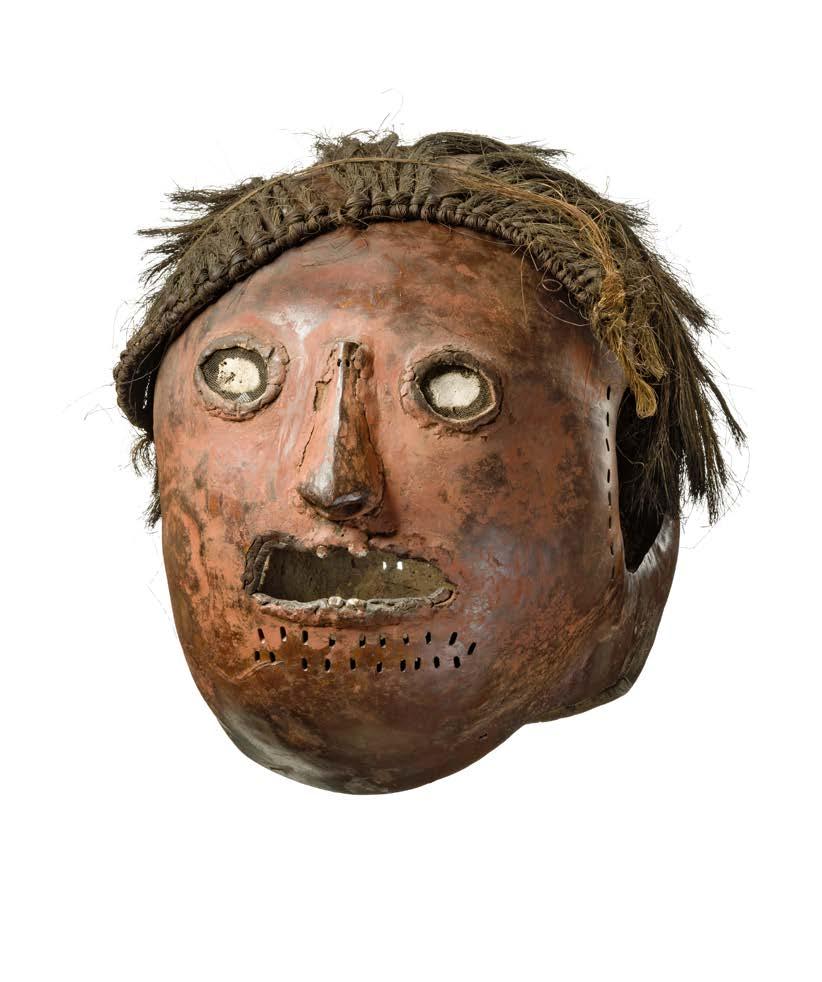
368 Männliche Helmmaske „lipiko“ (pl. „mapiko“)
Holz, schwarze Farbreste, menschli ches Haar, Inventarnr. „3285“, Sockel
Die Anfertigung und der Auftritt der „mapiko“-Stülpmasken nehmen eine bedeutende Rolle im sozialen und re ligiösen Leben der Makonde ein.
„Mapiko“ - Masken traten bei Initi ationsfesten auf, die kurz nach der Rückkehr der Knaben und Mädchen ins Dorf stattfanden.
Male helmet mask „lipiko“ (pl. „mapiko“) wood, black paint residues, human hair, inventory no. „3285“, base

The making and performance of the „mapiko“ helmet masks play a signi ficant role in the social and religious life of the Makonde. „Mapiko“ masks performed at initiation festivals that took place shortly after the boys and girls return to the village.
H: 22 cm
Merton Simpson, New York, USA
Vgl. Lit.: Fenzl, Kristian, Makonde, Linz 1997, p. 41 ff.
€ 2.500 - 4.500
369 Karyatidenhocker mit drei Figuren Holz, Pigmente, Reste eines alten Sammlungsetiketts, rest., kleine Fehlstelle
Dieser Hocker ist Beispiel für eine be sonders qualitätvolle Schnitzarbeit der Makonde.
Man betrachte vor allem die Physio gnomie der weiblichen Figuren, die unterschnittenen mandelförmigen Augen und aufwändig gestalteten Ohren. Die Figuren zeigen individu elle Frisuren, die eine ist ausgestat tet mit Oberlippenscheibe „pelele“, die andere mit Nasenpflock. Bei der männlichen Figur dürften sowohl die
Kleidung als auch die betont lange spit ze Nase auf Vorbilder der europäischen Kolonialherren zurückzuführen sein.
Caryatid stool with three figures wood, pigments, remains of an old coll ection label, rest., small missing part This stool is an example of a particu larly high quality Makonde carving.
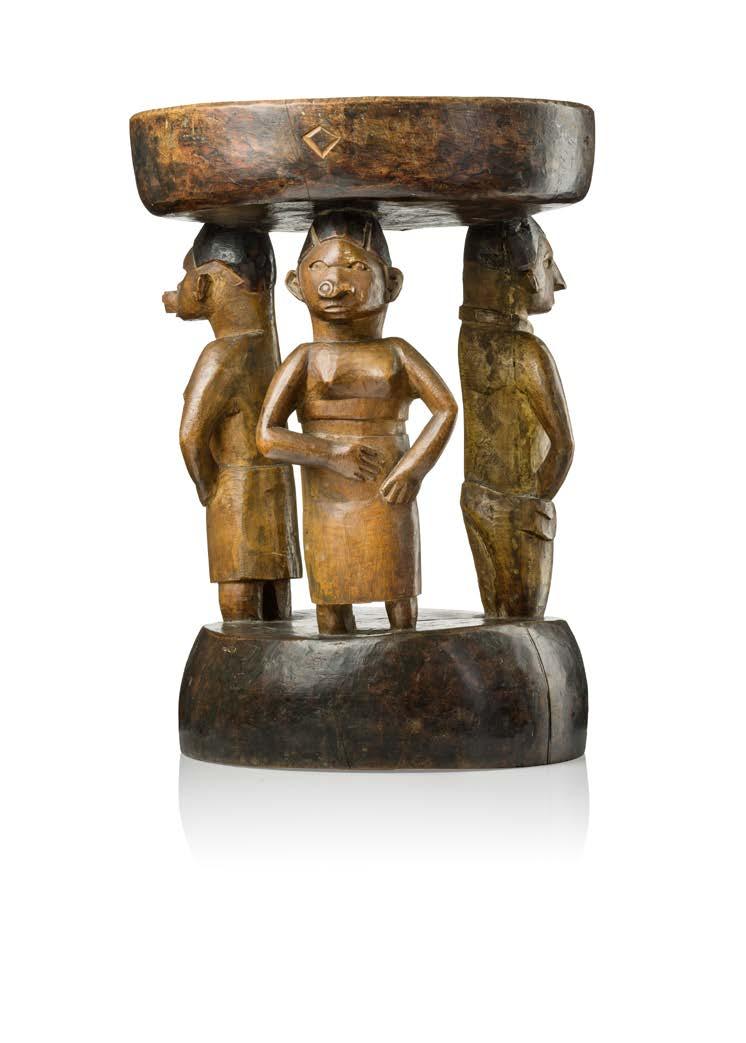
In particular, note the physiognomy of the female figures, the undercut almond-shaped eyes and intricately designed ears. The figures show indi vidual hairstyles, one is equipped with an upper lip disc „pelele“, the other with a nose plug. In the case of the male figure, both the clothing and the deliberately long, pointed nose can
be traced back to models from the European colonial rulers.
Provenance Old UK Collection H: 39,8 cm
4.000 - 8.000
370 Traditionelle Frauenkopfbedeckung „ekori“
Tierhaut (Schaf- oder Ziege), Eisenperlen
Typische Form, bestehend aus Le derhaube „ocipa“ mit drei spitz zu laufenden Leder-Hörnern „ozonya“ und Schmuckband „ombeta“.
Die Kappe wurde am Hinterkopf ge tragen. Zur Vorderseite hin wurde ein Schleier aus weicher Tierhaut befes tigt, der eingerollt, das Gesicht der Frau umrahmte. Das Schmuckband wurde an der Nahtstelle von Haube und Schleier um den Hinterkopf ge legt. Eisenperlen, die sich an Haube und Schmuckband finden, waren Symbol für Reichtum.
Dieser Typus von Kopfbedeckung stammt aus dem 19. Jahrhundert oder aus früherer Zeit. Der „ekori“ wird heute nicht mehr getragen. Im späten 19. Jahrhundert, im Zuge der Christianisierung, wurde er von einer Kopfbedeckung aus Stoff, „otjikaiva“ genannt, ersetzt.
„ekori“
hide (sheep or goatskin), iron beads
Typical form, consisting of leather bonnet „ocipa“ with three pointed le ather horns „ozonya“ and ornamental leather band „ombeta“.
The bonnet was worn on the back of the head. Towards the front, a veil made of soft animal skin was at tached, which, rolled up, framed the woman‘s face. The ornamental band was placed around the back of the head at the seam of cap and veil. Iron beads found on the bonnet and orna mental band were symbols of wealth.
This type of headdress dates from the 19th century or earlier. The „ekori“ is no longer worn today. In the late 19th century, in the course of Christianisa tion, it was replaced by a headdress made of cloth called „otjikaiva“.
Vgl. Lit.: Arnoldi, Mary Jo & Christine Mullen Kreamer, Crowning achieve ments, Los Angeles 1995, p. 37
€ 3.000 - 6.000

Mit der Teilnahme an der Versteigerung werden folgende Bedingungen anerkannt (Stand 10/2022):
1. Das Auktionshaus handelt als Kommissionär im eigenen Namen und für Rechnung seiner Auftraggeber (Kommittenten), die unbe nannt bleiben. Die Versteigerung ist öffentlich i.S.d. §§ 383 Abs. 3 und 474 Abs. 1 BGB.
2. Der Auktionator kann Nummern vereinigen, trennen, außerhalb der Reihenfolge ausbieten und zurückziehen.
3. Das Versteigerungsgut kann vor der Auktion besichtigt werden. Die Objekte sind gebraucht, sie können daher entsprechend ihres Alters und ihrer Nutzung Gebrauchsspuren und Abnutzungser scheinungen, ggf. auch Restaurierungen, aufweisen, ohne dabei die Wahrnehmung, Wertschätzung und das Verständnis für das Objekt zu schmälern. Authentizität und Echtheit eines Objektes bleiben davon ebenfalls unberührt. Der Erhaltungszustand wird im Katalog nicht durchgängig erwähnt, so dass fehlende Angaben keine Beschaffenheitsvereinbarung begründen.
4. Der Versteigerer behält sich vor, Katalogangaben zu berichtigen. Berichtigungen werden schriftlich resp. mündlich bekannt gegeben und treten anstelle der Katalogbeschreibung. Objekte werden in dem Zustand verkauft, in dem sie sich zum Zeitpunkt des Zuschlags befinden. Nach bestem Wissen und Gewissen vorgenommenen Katalog- und Maßangaben sind keine vertraglichen Beschaffenheits angaben oder Garantien im kaufrechtlichen Sinne. Auf Wunsch der Interessenten abgegebene Zustandsberichte (Condition Reports) enthalten keine vertraglich vereinbarten Beschaffenheitsangaben, sondern dienen nur der näheren Orientierung über den äußeren Zustand des Objekts nach Einschätzung des Versteigerers. Die im Katalog und auf der Homepage befindlichen Abbildungen dienen dem Zweck, dem Interessenten eine Vorstellung von dem Kunstwerk zu geben; sie sind weder Bestandteil der Beschaffenheitsvereinba rung noch eine Garantie für die Beschaffenheit.
5. Die Vorschriften des Verbrauchsgüterkaufes gelten nicht in einer öffentlich zugänglichen Versteigerung (§ 474 Absatz 2 BGB).
5.a. Der Versteigerer übernimmt keine Haftung für Mängel, soweit er die ihm obliegenden Sorgfaltspflichten erfüllt hat. Er verpflichtet sich jedoch, wegen rechtzeitig vorgetragener, begründeter Mängel rügen seine Gewährleistungsansprüche gegenüber dem Einlieferer geltend zu machen; dabei beträgt die Verjährungsfrist zwölf Monate vom Zeitpunkt des Zuschlags an. Im Falle erfolgreicher Inanspruch nahme des Einlieferers erstattet der Versteigerer dem Käufer den gezahlten Kaufpreis (einschließlich Aufgeld) zurück; ein darüber hinaus gehender Anspruch ist ausgeschlossen. Eine Rücknahme des ersteigerten Gegenstandes setzt aber jedenfalls voraus, dass dieser sich in unverändertem Zustand seit der Versteigerung befindet. Der Versteigerer übernimmt keine Haftung für fehlerhafte Über setzungen der Katalogtexte vom Deutschen in andere Sprachen.
6. Der Versteigerer übernimmt keine Gewähr für das Zustandekommen oder die Aufrechterhaltung von Telekommunikations-Verbindungen.
7. Der Versteigerer übernimmt keine Garantie für die technische Möglichkeit des Aufbaus einer Internetverbindung oder der recht zeitigen Übermittlung von Geboten über das Internet-Live-Mit bieten-System während einer Auktion. Um sicher in der Auktion berücksichtigt zu werden empfiehlt sich daher eine frühzeitige schriftliche Gebotsabgabe.
8. Gemäß Geldwäschegesetz (GwG) ist der Versteigerer verpflichtet, den Erwerber bzw. den an einem Erwerb Interessierten sowie ggf. einen für diese auftretenden Vertreter und den „wirtschaftlich Berechtigten“ i.S.v. § 3 GwG zum Zwecke der Auftragsdurchführung zu identifizieren sowie die erhobenen Angaben und eingeholten
Informationen aufzuzeichnen und aufzubewahren. Der Erwerber ist hierbei zur Mitwirkung verpflichtet, insbesondere zur Vorlage der erforderlichen Legitimationspapiere, insbesondere anhand ei nes inländischen oder nach ausländerrechtlichen Bestimmungen anerkannten oder zugelassenen Passes, Personalausweises oder Pass- oder Ausweisersatzes. Der Versteigerer ist berechtigt, sich hiervon eine Kopie unter Beachtung der datenschutzrechtlichen Bestimmungen zu fertigen. Bei juristischen Personen oder Perso nengesellschaften ist der Auszug aus dem Handels- oder Genossen schaftsregister oder einem vergleichbaren amtlichen Register oder Verzeichnis anzufordern. Der Erwerber versichert, dass die von ihm zu diesem Zweck vorgelegten Legitimationspapiere und erteilten Auskünfte zutreffend sind und er, bzw. der von ihm Vertretene „wirtschaftlich Berechtigter“ nach § 3 GwG ist.
9. Nicht genauer bekannte Bieter werden gebeten, bis zum Beginn der Auktion eine ausreichende Sicherheit zu leisten, da sonst die Ausführung des Auftrages unterbleiben kann. Als Sicherheitsleis tung ist eine auf den Namen des Bieters ausgestellte Bankgarantie vorzulegen oder eine gültige Kreditkarte anzugeben. Bitte beachten Sie deren Deckungssumme.
10. Schriftliche Bieteraufträge werden auf das Gewissenhafteste er ledigt. Hierfür ist das entsprechende Gebotsformular zu verwenden. Es muss genaue Angaben enthalten und spätestens drei Arbeitstage vor Versteigerungstermin in schriftlicher Form (Brief, Fax, E-Mail, Scan) vorliegen. Schriftliche Gebote werden vom Versteigerer nur in dem Umfang ausgeschöpft, der erforderlich ist, um anderweitige Gebote zu überbieten.
Schriftliche Gebote, die mehr als 10 % unter dem Aufrufpreis liegen, können nicht berücksichtigt werden. Für die Berücksichtigung von Geboten per e-Mail kann aufgrund der Unsicherheiten keine Haftung übernommen werden.
Bei schriftlichen Bieteraufträgen ist telefonisches Mitbieten nur bei Losen mit einem Aufrufpreis ab 300 Euro möglich. Für Telefonbie ter ist der Aufrufpreis das Mindestgebot. Bieter, welche über das Telefon Gebote abgeben, werden darauf hingewiesen, dass diese Telefongespräche aufgezeichnet und mitgehört werden. Jeder Bieter erklärt sich hiermit ausdrücklich einverstanden. Sollten Einwände bestehen, so sind diese durch den Bieter im Vorfeld schriftlich zu erheben. Das Auktionshaus behält sich vor, solche Bieter von der Teilnahme auszuschließen. Nach Abschluss der Transaktion werden die Aufnahmen umgehend gelöscht.
11. Die im Katalog aufgeführten Preise sind Aufruf- und Schätzpreise. Gesteigert wird um ca. 10 % (Für Internetbieter gelten die gelis teten Gebotsschritte auf der jeweiligen Plattform). Der Zuschlag wird erteilt, wenn nach dreimaliger Wiederholung des höchsten Gebotes ein Übergebot nicht gegeben ist, und der vom Einlieferer vorgeschriebene Mindestzuschlagspreis erreicht ist.
12. Bei einem Zuschlag unter Vorbehalt ist ein Bieter drei Wochen an sein Gebot gebunden. Wird ein Vorbehalt ausgerufen, kann die Katalognummer ohne Rückfrage an einen Limitbieter abgegeben werden. Lehnt der Auktionator ein Gebot ab, so bleibt das vorher gehende weiterhin verbindlich. Bei gleichen Geboten entscheidet das Los. Der Versteigerer kann den Zuschlag zurücknehmen und den Gegenstand erneut ausbieten, wenn irrtümlich ein rechtzeitig abgegebenes höheres Gebot übersehen worden ist, oder wenn der Höchstbietende sein Gebot nicht gelten lassen will, oder sonst Zweifel über den Zuschlag bestehen.
13. Der Versteigerer darf für den Einlieferer bis zum vereinbarten Mindestverkaufspreis (Limit) auf das Los bieten ohne dies anzuzeigen und unabhängig davon, ob andere Gebote abgegeben werden oder
nicht. Zum Schutz des eingelieferten Objekts kann der Versteigerer den Zuschlag unterhalb des Limits an den Einlieferer erteilen; in diesem Fall handelt es sich um einen Rückgang.
14. Jeder Bieter kauft in eigenem Namen und auf seine eigene Rechnung. Der Vertrag kommt erst durch Zuschlag zustande. Das zugeschlagene Höchstgebot ist der Nettopreis.
15. Auf den Zuschlag wird ein Aufgeld von 21 % (andere InternetAuktionsplattformen können davon abweichen), plus der aus dem Aufgeld resultierenden Mehrwertsteuer erhoben. Im Nachverkauf wird ein Aufgeld von 23 % erhoben, plus der aus dem Aufgeld re sultierenden Mehrwertsteuer.
16. Das Widerrufsrecht findet keine Anwendung. Fernabsatzverträge, die in Form von Versteigerungen (§ 156 BGB) geschlossen werden, finden auf Internet-Gebote im Rahmen des Internet-Live-MitbietenSystems (Ziff. 7) und auf Telefon-Gebote (Ziff. 9) keine Anwendung.
17. Besteht die Notwendigkeit zur Einholung von CITES-Beschei nigungen zwecks Erteilung von Ausnahmegenehmigungen vom Vermarktungsverbot von Gegenständen, die dem Artenschutzab kommen unterliegen, so gehen hierfür anfallende Kosten zu Lasten des Käufers (100 Euro je CITES). Gleiches gilt für Genehmigungen zur Ausfuhr von Kulturgut (100 Euro je Genehmigung).
18. Zahlungen erfolgen in EURO (€) und sind unverzüglich nach Rechnungsstellung zu leisten. Zahlungen des Käufers sind grund sätzlich nur durch Überweisung an den Versteigerer auf das von ihm angegebene Konto zu leisten. Die Erfüllungswirkung der Zahlung tritt erst mit endgültiger Gutschrift auf dem Konto des Versteigerers ein. Zahlungen per Kreditkarte (Visa, Master, Amex) sind nur bis zu einem Betrag in Höhe von 1.000 Euro möglich. Alle Kosten und Gebühren der Überweisung (inkl. der dem Versteigerer abgezoge nen Bankspesen) gehen zu Lasten des Käufers, soweit gesetzlich zulässig und nicht unter das Verbot des § 270a BGB fallend. Das Eigentum geht erst nach erfolgter Zahlung auf den Käufer über, und das Auktionsgut wird erst danach ausgeliefert bzw. übergeben. Für rechtzeitige Vorlegung, Protestierung, Benachrichtigung oder Zurückleitung nicht eingelöster Zahlungen / Zahlungsmittel haftet der Versteigerer nicht.
19. Bei Zahlungsverzug werden Verzugszinsen in Höhe des bank üblichen Zinssatzes, mindestens jedoch in Höhe des gesetzlichen Verzugszinses nach §§ 288, 247 berechnet. Außerdem kann der Ver steigerer den Käufer auf Schadensersatz wegen schuldhafter Pflicht verletzung in Anspruch nehmen. Dazu kann er nach der zweiten Mahnung als Schadenspauschale einen Säumniszuschlag von 3% der Gesamtforderung erheben, es sei denn der Käufer weist nach, dass ein Schaden nicht oder in wesentlich geringerer Höhe entstanden ist. Statt der Schadenspauschale kann der Versteigerer Ersatz des konkret entstandenen Schadens verlangen. Dieser ist hierbei auch so zu berechnen, dass der Gegenstand in einer weiteren Auktion mit einem nach pflichtgemäßem Ermessen des Versteigerers be stimmten Limit erneut versteigert wird und der säumige Käufer für einen Mindererlös gegenüber der vorangegangenen Versteigerung und für die Kosten der wiederholten Versteigerung einschließlich Provision und Auslagen des Versteigerers aufzukommen hat; auf einen Mehrerlös hat er in diesem Falle keinen Anspruch, und seine Rechte aus dem ihm vorher erteilten Zuschlag erlöschen mit dem neuen Zuschlag. Der säumige Käufer wird zu künftigen Geboten nicht zugelassen Mit Eintritt des Verzuges werden sämtliche For derungen des Versteigerers gegen den Käufer sofort fällig.
20. Der Ersteigerer ist verpflichtet, die Sachen sofort nach der Auk tion in Empfang zu nehmen. Mit der Übergabe geht die Gefahr für nicht zu vertretende Verluste und Beschädigungen auf den Käufer
über. Gegenstände, die nicht abgeholt werden, können ohne Mah nung im Namen sowie auf Kosten und Gefahr des Käufers bei einer Spedition eingelagert werden.
21. Ansprüche auf Schadensersatz aufgrund eines Mangels, eines Verlustes oder einer Beschädigung des versteigerten Objektes, gleich aus welchem Rechtsgrund, oder wegen Abweichungen von Katalo gangaben oder anderweitig erteilten Auskünften sind ausgeschlos sen, sofern Zemanek-Münster oder seine Erfüllungsgehilfen nicht vorsätzlich oder grob fahrlässig gehandelt oder vertragswesentliche Pflichten verletzt hat; die Haftung für Schäden aus der Verletzung des Lebens, des Körpers oder der Gesundheit bleibt unberührt. Im Übrigen gilt Ziffer 4. 22.a. Verpackung und Versand Verpackung und Versand Ihrer Objekte sind ein unverbindlicher Service unseres Hauses, und betragen innerhalb Deutschlands pauschal 50 Euro / europaweit 80 Euro bei Standardformaten. Für alle übrigen Länder erheben wir eine Pauschale von 50 Euro zuzügl. gewichts- und volumenabhängigen Versandkosten. Gesonderte Speditionsaufträge sowie Sperrgut und internationale Transporte richten sich nach dem wirtschaftlichsten Anbieter und werden extra berechnet. Für gerahmte Bilder, Möbelstücke und Keramiken kontaktieren Sie bitte Mail Boxes Etc. Aschaffenburg (mbe0020@ mbe.de Tel: +49 (0)6021 625 9090). Die Versendung ersteigerter Sachen auf Wunsch des Käufers geschieht auf dessen Kosten und Gefahr. Bei CITES-pflichtigen Objekten bitten wir Sie zu beachten, dass ein uneingeschränkter Handel nur innerhalb der Europäischen Gemeinschaft erlaubt ist. Ein Versand in Drittländer ist zur Zeit nicht möglich.
22.b. Transportversicherung
Eine obligatorische Transportversicherung deckt Risiken, die mit dem regulären Transport verbunden sind. Die Kosten für die Trans portversicherung und Schadensregulierung trägt der Käufer. Nach Anlieferung hat der Käufer die Sachen unverzüglich auf Schäden zu untersuchen und diese dem Transportunternehmen anzuzei gen; spätere Reklamationen wegen nicht verdeckter Schäden sind ausgeschlossen.
22.c. Zollerklärung
Den Service einer Zollerklärung bieten wir ab einem Warenwert von mehr als 1.000 Euro für nur 100 Euro an, bei geringeren Beträgen ist eine Voranmeldung nicht notwendig.
23. Bei der Besichtigung ist größte Vorsicht zu empfehlen, da jeder Besucher für den von ihm verursachten Schaden in vollem Umfang haftet.
24. Die vorstehenden Bedingungen gelten sinngemäß auch für den Nachverkauf oder Freiverkauf von Auktionsgut.
25. Erfüllungsort und Gerichtsstand für beide Teile ist, soweit ge setzlich zulässig, Würzburg.
26. Die Rechtsbeziehungen richten sich nach deutschem Recht; das UN-Abkommen über Verträge des internationalen Warenkaufs (CISG) findet keine Anwendung.
27. Sollte eine Bestimmung dieser Bedingungen unwirksam sein, so bleiben die übrigen Bestimmungen gültig. Es gilt § 306 Abs. 2 BGB.
28. Diese Allgemeinen Geschäftsbedingungen sind auf Deutsch, Englisch und Französisch verfügbar. Maßgebend ist stets die deut sche Fassung, wobei es für Bedeutung und Auslegung der in diesen Geschäftsbedingungen verwendeten Begriffe ausschließlich auf deutsches Recht ankommt.
The following conditions apply (updated 10/2022):
1. Auctions are held by the auctioneer as commissioning agent on behalf of third parties, whose names are not disclosed. They are arranged at public in accordance with §§ 383 (3) and 474 (1) of the German Civil Code (BGB).
2. The auctioneer has the right to combine and separate items or auction them in a different order or withdraw them altogether.
3. All items lots to be put up for sale may be viewed and inspected prior to the auction. They are second hand and according to their age and their use they can therefore show traces of usage and wear marks and, if necessary, they also can have restorations without detracting from the perception, the value and the meaning of these objects. Their authenticity and originality also remain untouched of this.The state of preservation is not continuously mentioned in the catalogue so that any missing information shall also not constitute an agreement as to quality.
4. The auctioneer reserves the right to make corrections to catalogue information. These corrections take the form of written notices resp. verbal notifications made by the auctioneer. The corrected infor mation takes the place of the catalogue descriptions. Objects will be sold in the condition they are in at the point in time of the knock down. The information (incl. measures) is shown in the catalogue to the best of one’s knowledge and does not represent any contractual information regarding characteristics or warranties within the sense of commercial law. Any condition reports submitted at the request of the interested parties do not contain any contractually agreed information regarding characteristics; they serve solely as an aid to more exact orientation regarding the external condition of the item in the auctioneer’s estimation. All reproductions contained in the catalogue and on the website is to give potential buyers an idea of the work of art; they are neither an integral part of the agreement on the condition nor a guarantee with regards to the condition.
5. The provisions of the purchase of consumer goods do not apply in a public auction (§ 474 Paragraph 2 BGB).
5.a. The auctioneer does not assume any liability for defects, provi ded that he has exercised the due diligence required of him. However, he undertakes to assert his warranty claims against the consignor in the event of legitimate complaints of defects which are raised in good time; the limitation period for such complaints is twelve months from the point in time of the knock down. In the event that the assertion of the complaint against the consignor is successful, the auctioneer will reimburse the paid purchase price (including any premium) to the buyer; any more extensive claims are excluded. However, the acceptance of the return of the auctioned item is subject to the condition that its condition has not changed since the auction. The auctioneer assumes no liability for faulty translations of the catalogue texts from German into other languages.
6. For all kinds of telecommunication no guarantee can be given.
7. The auctioneer does not guarantee an internet connection or the timely transmission of bids via the internet live bidding system during an auction. To ensure that your bid is validated it is advisable that you submit an early written bid.
8. In accordance with the GwG (Money Laundering Act) the auc tioneer is obliged to identify the purchaser and those interested in making a purchase as well as, if necessary, one acting as represen tative for them and the beneficial owner within the meaning of § 3 GwG (Money Laundering Act) for the purpose of the execution of the order. The auctioneer is also obliged to register and retain compiled data and obtained information. In this connection the purchaser is
obliged to cooperate, in particular to submit required identification papers, in particular in form of a passport, identification card or respective replacement document recognized and authorized by domestic authorities or in line with laws concerning aliens. The auctioneer is authorized to make a copy there of by observing data protection regulations. Legal persons or private companies must provide the respective extract from the Commercial Register or from the Register of Cooperatives or an extract from a comparable official register. The purchaser assures that all identification papers and information provided for this purpose are correct and that he or the one represented by him is the beneficial owner within the meaning of § 3 GwG (Money Laundering Act).
9. Unknown bidders are required to provide proof of adequate secu rity before the start of the auction. Otherwise the commission might not be carried out. At the time competitive bid an authorisation is obtained on your credit card based on the reserve. There must be sufficient credit on your card to cover all charges.
10. Written bids are handled with the utmost care; for this purpose the corresponding bid form should be used. It should contain precise instructions, communicated in writing (letter, fax, e-mail, scan) and should arrive least three business days before the auction. They will be utilised by the auctioneer solely in the scope and to the extent that is required to surpass any other bids. Written bids more than 10 % under the starting price will not be considered. On account of the legal uncertainty no liability shall be assumed with regard to e-mail bids.
Telephone bidding is only possible for lots with a starting price in excess of 300 Euro. It will be only accepted on condition that the start price is the minimum bid. Those, who bid by phone are reminded that these phone conversations are recorded and listened. Everybody bidders expressly declare to agree with it. If there are objections, these are to collect by the bidder in advance in writing. The auction house reserves the right to exclude such bidders from participation. Upon completion of the transaction the records will be deleted immediately.
11. The prices listed in the catalogue shall be start prices and estima ted prices. During bidding items are increased by approximately 10 % (for internet bidders see listed bid increments at their respective platforms). A lot is knocked down if no higher bid is made after three calls and the vendor’s minimum specified price has been reached.
12. In the event of a knock down under reserve, the bidder will be held to his or her bid for three weeks. Once a reserve is declared, the catalogue item may be sold to a limit bidder without further consultation. Where the auctioneer rejects a bid, the previous bid will remain binding. Where there are two bids at the same amount, lots shall be drawn. The auctioneer may revoke the knock down and offer the item again if and when a higher bid submitted in good time has mistakenly been overlooked or if and when the highest bidder does not wish for his or her bid to stand or if and when there is otherwise doubt regarding the knock down.
13. The auctioneer may bid on the lot on behalf of the consignor up to the agreed minimum specified price (reserve) without giving notice that he is doing so and independently of whether other bids are submitted or not. The auction may knock the item down to the consignor if the bid is below the limit as protection for the consigned item; such a case is a return.
14. All bidders are to purchase under their own name and on their own account. The hammer price (purchase price) is the net price. The legal provisions regarding revocation and return for distance selling contracts do not apply to telephone and Internet bids.
15. An additional premium of 21 % (other internet auction platforms may vary) will be added to the knock down, as well as VAT resulting from the premium. During the aftersale a surcharge of 23 % will be added, as well as VAT resulting from the premium.
16. The right of revocation does not apply. Distance contracts con cluded in the form of auctions (section 156 of the German Civil Code) do not apply to internet bids within the framework of the internet live bidding system (see point 7) and to telephone bids (see point 9).
17. If it should be necessary to obtain CITES certificates for the purpo se of granting special exemption from the prohibition of marketing objects covered by this Convention, then the cost thereof shall be borne by the purchaser (100 Euro each). This also extends to certi ficates to export cultural property (100 Euro each).
18. Payments shall be made in EUR (€) immediately after invoicing. Payments by the buyer are generally only made by transfer to the auctioneer to an account specified by him. The fulfillment effect of the payment only occurs with the final credit to the auctioneer‘s account. Payments by credit card (Visa, Master, Amex) are only possible up to an amount of EUR 1,000. All costs and fees for the transfer (including the bank charges deducted from the auctioneer) are borne by the buyer, insofar as this is legally permissible and does not fall under the prohibition of § 270a BGB. Ownership only passes to the Purchaser once payment has been made. The auction item will be delivered once this has been arranged.
The auctioneer is not liable for due presentation, protestations, notifications or return of uncashed payments / means of payment.
19. Default interest is charged in the event of payment delay, with the amount of interest rate usually charged by banks, but in any case no lower than the amount of the statutory default interest in accordance with §§ 288 und 247 of the German Civil Code (BGB).
The Auctioneer is also entitled to lodge claims against the buyer for culpable neglect of duties. After the second formal reminder, the Auctioneer is entitled to levy a default surcharge equivalent to 3 % of its total claim as compensation for damages incurred unless the buyer is able to prove that no damage or a much lower level of damages has been incurred. Instead of the flat-rate damage com pensation amount, the Auctioneer may demand reimbursement of its specific damages incurred. These damages may also be calculated in such a way that the property item in question will be re-auctioned in another auction with a limit determined at the dutiful discretion of the Auctioneer and the defaulting buyer will be liable for any reduced proceeds in comparison with the previous auction and also for the costs of the repeat auction and including the commission and disbursements of the Auctioneer; the defaulting buyer will not be entitled to any additional proceeds in this case and his rights in connection with the previous knockdown will lapse concurrently with the new knockdown. The defaulting buyer will not be permitted to place further bids. All claims of the Auctioneer against the buyer will be due immediately in the event of delay.
20. The buyer is obligated to accept surrender of the items imme diately after the auction. The risk of accidental loss and damage transfers to the buyer upon the surrender of the items. Items that have not been collected may be stored by a freight forwarding company without reminder in the name of and at the expense of the Purchaser.
21. Claims for compensation as the result of a fault or defect in the object auctioned or damage to it or its loss, regardless of the legal grounds, or as the result of variances from the catalogue descrip tion or statements made elsewhere are excluded unless ZemanekMünster acted with wilful intent or gross negligence; the liability for
bodily injury or damages caused to health or life remains unaffected. In other regards, point 4 applies.
Packing and shipping of your objects is a non-binding service we offer for a lump-sum of 50 Euro within Germany / 80 Euro with standard formats throughout Europe. Delivery to all other countries and overseas includes handling (50 Euro) plus shipping depending on weight or volume. Any bulky goods and international transports will be calculated on request and charged separately. For framed paintings, furniture and ceramics please contact Mail Boxes Etc. Aschaffenburg (mbe0020@mbe.de Tel: +49 (0)6021 625 9090). The transport of any items purchased at the auction will be carried out at the buyer’s request, expense and risk. Please note that all objects that are subject to CITES can only be sent within the European Com munity. At the present time export in third countries is prohibited.
An obligatory insurance covers risks associated with transportation. The buyer shall bear the expenses for transportation insurance and claims regulation. A buyer shall inspect the items for damage immediately after delivery and notify the freight forwarding com pany of any damage; later complaints based on damage which is not hidden are excluded.
We offer a customs declaration for only 100 Euro for all amounts abo ve 1,000 Euro. For all smaller amounts, we don’t need any declaration.
23. Bidders should take care when inspecting items, as all they will be fully liable for any damages.
24. These terms and conditions apply correspondingly to the post auction sale or open sales of auction items at the auctioneer’s own discretion.
25. Place of performance and jurisdiction for both is Wurzburg.
26. These terms and conditions are governed by German law. The UN Convention on the International Sale of Goods (CISG) shall not apply.
27. Should any clause in these terms and conditions prove to be void, the other clauses will remain in force.
28. These general terms and conditions are available in German, English and French. The German version always takes preference, whereby only German law is valid for the meaning and interpretation of the terms used in these terms and conditions.
According to the German Auction Law we inform about measures:
L = length, H = height, B = width, D = diameter, M = measure 1 cm = 0,39 inch
